
B S C E E
Review
2005
Group of Banking Supervisors from Central and Eastern Europe
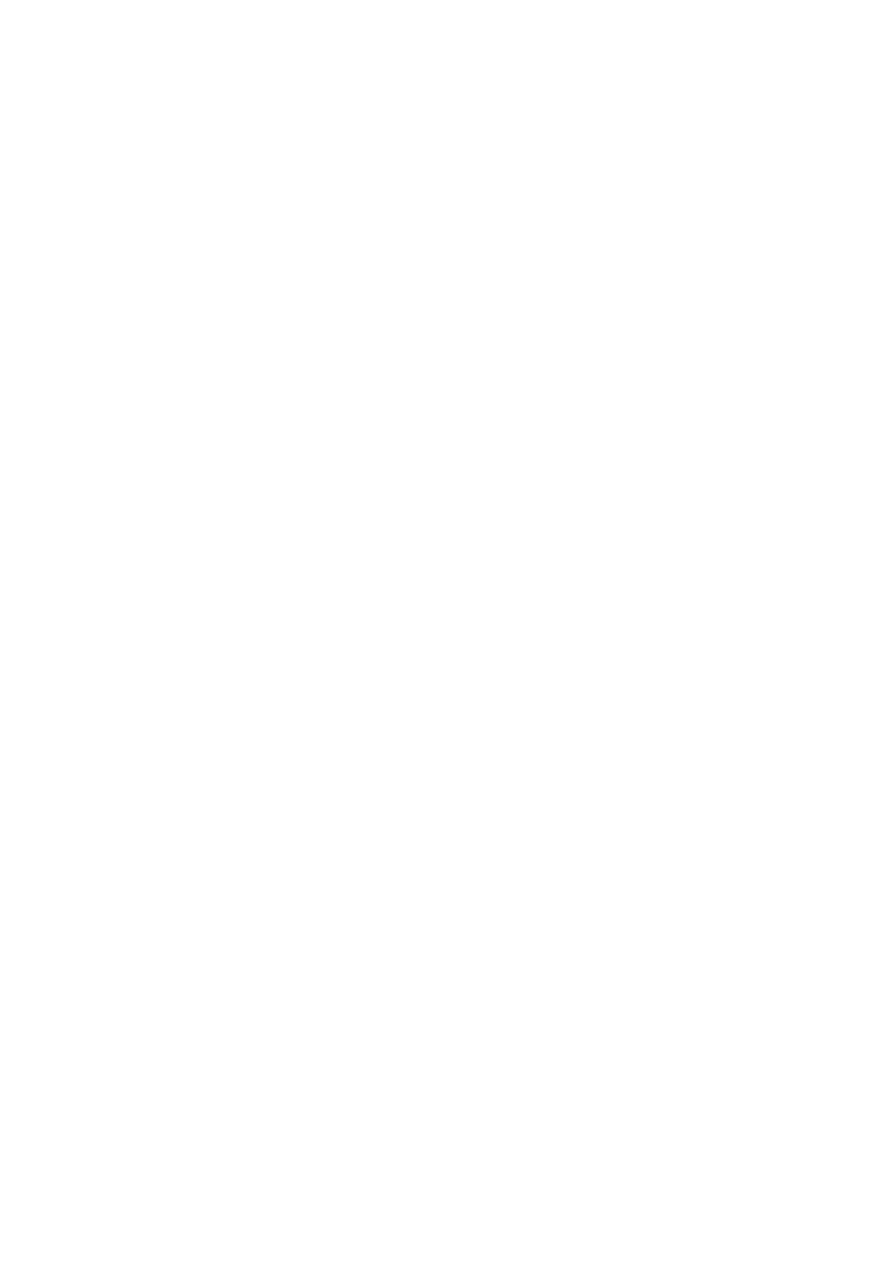
Published by the Secretariat of BSCEE
Address: H-1013 Budapest, Krisztina krt. 39.
Edited by Andrea Deák
Designed by Tibor Rencsényi

3
INTRODUCTION
The Group of Banking Supervisors from Central and Eastern Europe (the BSCEE
Group) was established in 1990. The Agreement of the BSCEE Group was signed
during the Stockholm International Conference of Banking Supervisors (ICBS)
in 1996. The BSCEE Group is operating according to its Agreement that de-
termines its organizational structure and the rules governing its operations.
As of today the Agreement is signed by nineteen member countries: Albania,
Republic of Belarus, Federation of Bosnia and Herzegovina (2002), Bulgaria,
Croatia (1996), Czech Republic, Estonia, Hungary, Latvia, Lithuania, Macedonia,
Moldova, Poland, Romania, Russia, Serbia and Montenegro (Central Bank of
Montenegro – 2004), Slovakia, Slovenia and Ukraine. The Chairmanship of the
BSCEE Group rotates on annual basis. In 2004 Mr.
Čedo Maletić, Vicegovernor
of the Croatian National Bank, chaired the Group.
The function of the Secretariat of the BSCEE Group also rotated on an an-
nual basis until 1996. In 1996 the BSCEE Group entered into an agreement set-
ting out a framework for cooperation and coordination in organizing common
events. The primary role of the Secretariat is to provide technical assistance in
organizing conferences, leaders’ meetings, workshops, and training seminars.
The Secretariat also facilitates cooperation among the member countries as
well as provides documents for their work. The permanent Secretariat of the
Group is located in Budapest, at the Hungarian Financial Supervisory Authority
(HFSA).
According to the previous years practice the Annual Review of the BSCEE
Group summarizes the developments of the member countries in 2004. This
publication gives an overview of the macroeconomic circumstances in the 19
member states, and it describes the banking sector as well as the supervisory
activities. It was prepared on the basis of the information given by the mem-
ber countries. The Annual Review also summarizes the main events of the
BSCEE Group, including two regional workshops co-organized by the Bank of
International Settlement (BIS) and the Financial Stability Institute (FSI) and by
the BSCEE Group. The 17
th
Annual Conference was organized by the Croatian
National Bank in Dubrovnik, Croatia on the 27-28
th
of May 2004.
This Annual Report intends to provide in-depth information reflecting the
mission of the BSCEE Group in a detailed and accurate manner regarding the
banking sector of the member countries.
I hope that you find the publication of the BSCEE Group informative and use-
ful. I am sure that this will help you to become acquainted with our supervisory
job in the Central and Eastern European region, the cooperation among the su-
pervisory authorities of the member countries and with the Basle Committee.
Senior Coordinator
of the Secretariat

4
CONTENTS
2004 DEVELOPMENTS IN THE BANKING SYSTEM
OF THE MEMBER COUNTRIES
Bosnia and Herzegovina (Federation of)

5
2004 DEVELOPMENTS IN THE BANKING
SYSTEM OF THE MEMBER COUNTRIES

6
2004 DEVELOPMENTS IN THE
ALBANIAN BANKING SYSTEM
STATISTICAL TABLES
Number of financial institutions
(at year-ends)
Type of financial institutions
2002
2003
2004
Bank
13
15
16
Nonbanking financial institution
5
7
7
Savings and credit association
127
136
132
Financial institution, total
145
158
155
Ownership structure of financial institutions ( banks)
on the basis of registered capital (%)
(at year-ends)
Item
2002
2003
2004
Public sector ownership
13.5
10.0
7.0
Private domestic ownership
4.0
8.0
Domestic ownership total
13.5
14.0
15.0
Foreign ownership (private banks)
73.6
76.0
77.0
Other foreign ownership (joint-venture)
12.9
10.0
8.0
Foreign ownership total
86.5
86.0
85.0
Banks, total
100.0
100.0
100.0

7
Ownership structure of financial institutions ( banks)
on the basis of total assets (%)
(at year-ends)
tem
2002
2003
2004
Public sector ownership (100%)
54.0
52.0
3.0
Private domestic ownership
1.0
3.0
Domestic ownership total
54.0
53.0
6.0
Foreign ownership (private banks) 100%
40.0
42.0
91.0
Other foreign ownership (joint-venture)
6.0
5.0
3.0
Foreign ownership total
46.0
47.0
94.0
Banks, total
100.0
100.0
100.0
Concentration of assets by the type of financial institutions (%)
Type of financial institutions
The first 3 largest
The first 5 largest
Bank
69
83
Return on Assets (ROA) by type of financial institutions (%)
Type of financial institutions
2002
2003
2004
Bank
1.20
1.24
1.28
Return on Equity (ROE) by type of financial institutions (%)
Type of financial institutions
2002
2003
2004
Bank
19.20
19.50
21.10
Distribution of market shares in balance sheet total (%)
Type of banks
2002
2003
2004
G1 (< 2 % of total banks assets)
3.8
4.6
6.4
G2 ( 2 % - 7% of total banks assets)
10.4
10.6
10.4
G3 ( > 7% of total banks assets)
85.8
84.8
83.2
Banks, total
100.0
100.0
100.0
*basetd on assets
2004 DEVELOPMENTS IN THE ALBANIAN BANKING SYSTEM
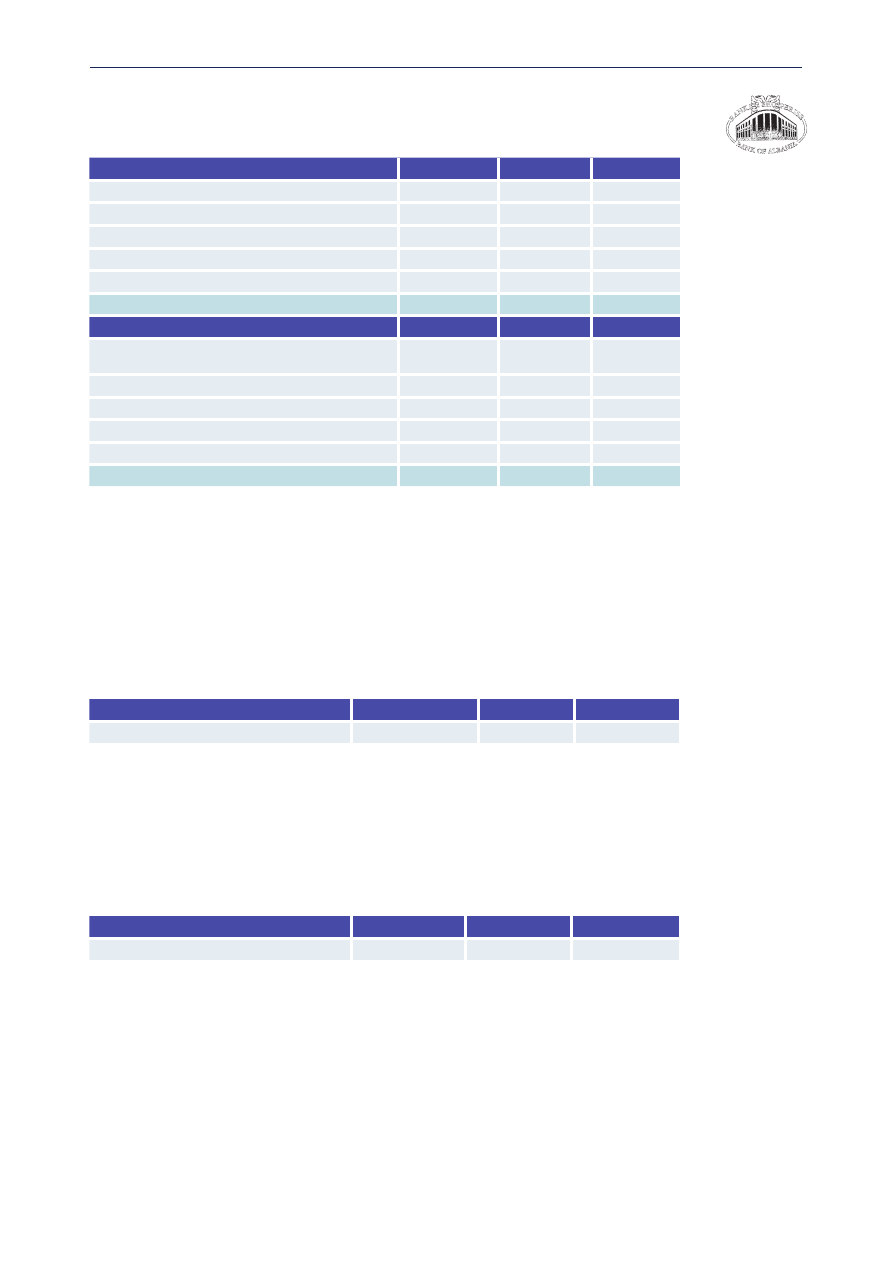
8
The structure of assets and liabilities of the banking system (%)
(at year-ends)
Assets
2002
2003
2004
1. Treasury operations and interbank
80.6
76.5
72.4
2. Operations with customers (net)*
11.4
13.5
16.4
3. Securities transactions (net)
4.9
5.4
7.0
4. Other assets
0.9
0.8
0.9
5. Fixed assets
1.8
1.5
1.7
Total accrued interest
0.5
2.6
2.1
Liabilities and shareholders’ equity
2002
2003
2004
1. Treasury operations and interbank
transactions
5.3
4.4
4.5
2. Operations with customers
84.0
87.5
87.0
3. Securities transactions
0.0
0.0
0.0
4. Other liabilities
2.9
0.7
1.0
5. Permanent resources
6.7
6.2
6.3
Total accrued interest
1.2
1.2
1.1
* Since 2002 this class on the balance sheet has been expressed on the gross basis (without deduction of the
provisions )
Develepment of off-balance sheet activities (%)
(off balance sheet items / balance sheet total)
Type of financial institutions
2002
2003
2004
Bank
13.8
7.4
15.0
Solvency ratio of banks
Type of financial institutions
2002
2003
2004
Bank
31.6
28.5
21.6
2004 DEVELOPMENTS IN THE ALBANIAN BANKING SYSTEM

9
Asset portfolio quality of the banking system (%)
Asset classification
2002
2003
2004
Standard
89.9
92.3
92.7
Special mentioned
4.6
3.1
3.2
Substandard
3.0
1.9
1.0
Doubtful
0.7
0.5
1.0
Loss
1.8
2.1
2.1
Overdue loans/total of loans
5.6
4.6
4.2
Classified total
100.0
100.0
100.0
Provisions
4.2
4.3
4.0
The structure of deposits and loans at year-end 2004 (%)
Type of deposits
as a % of total
deposists
Loans
as a % of
total loans
Current accounts
12.7
Short term loans
26.7
Demand deposits
6.2
Medium term loans
35.3
Time deposits
78.8
Long term loans
15.7
Other deposits
2.1
Real estate loans
15.1
Certificates of deposits
0.1
Leasing contracts
0.0
Other loans
7.1
Classified total
100.0
100.0
Public sector deposits
4.9
Public sector loans
0.2
Private sector deposits
8.3
Private sector loans
68.8
Households and others
86.8
Households and others
31.0
Classified total
100.0
100.0
Deposits in leks
68.6
Loans extended in leks
19.5
Deposits in foreign currency
31.4
Loans extended in
foreign currency
80.5
Classified total
100.0
100.0
The structure of deposits by final maturity at year-end 2004 (%)
Maturity of Deposits
as a % of total deposists
At sight
36.0
Within one year
61.9
Over one year
2.0
Total
100.0
2004 DEVELOPMENTS IN THE ALBANIAN BANKING SYSTEM
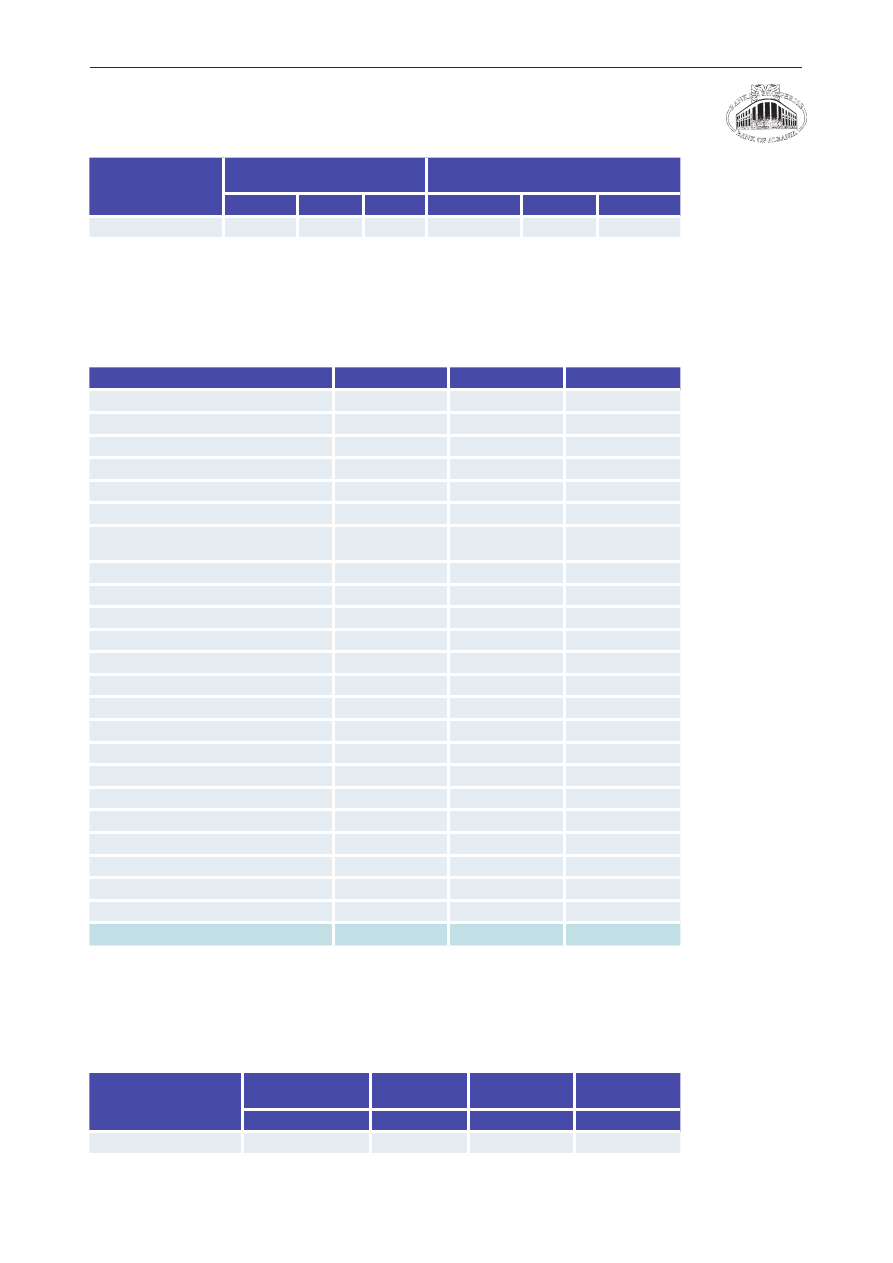
10
Proportion of foreign exchange assets and liabilities
(at year ends)
Type of financial
institutions
FOREX assets/Total assets
FOREX Liabilities/
Total liab&equity capital
2002
2003
2004
2002
2003
2004
Bank
37.5
36.3
37.4
36.9
35.9
37.0
Structure of Incomes and Expenses of Banks
in million of Lek
Items
2002
2003
2004
I. Total interest income
23,538.1
27,838.0
26,394.5
Treasury and interbank transactions
2,581.5
2,203.5
2,329.8
Interest received from customers
2,981.6
3,885.1
5,177.5
Interest received from securities
17,957.4
20,980.7
18,700.3
Other interest received
17.6
768.7
186.9
II. Total interest expenses
14,690.8
16,687.8
14,731.2
Interest expenses on treasury and
interbank transactions
508.8
173.8
171.3
Interest paid to customers
13,915.4
16,150.8
14,406.1
Interest expenses on securities
126.0
230.7
13.8
Other interest expenses
140.5
132.5
140.0
Net interest income (I-II)
8,847.3
11,150.2
11,663.3
Noninterest income
3,361.7
3,277.1
5,871.1
Noninterest expenses
971.3
1,078.9
1,973.1
Net noninterest income
2,390.5
2,198.1
3,898.0
Provisioning expenses
1,062.9
907.9
1,039.5
Gross operating income
10,174.9
12,440.5
14,521.8
Overhead expenses
5,562.0
6,066.5
7,643.1
of which: personnel expenses
2,328.9
2,423.2
3,045.0
Net operating income
4,612.8
6,373.9
6,878.7
Net extraordinary income (loss)
423.4
(116.5)
38.8
Taxes other than income taxes
47.6
41.1
53.9
Net income (loss) before tax
4,988.6
6,216.3
6,863.6
Income tax
1,094.7
1,761.3
1,757.5
Net income (loss) after tax
3,894.0
4,454.9
5,106.1
Structure of registered capital and own funds of banks in 2004
in mio of EUR
Type of financial
institutions
Registered
capital
/Total
assets
Own funds
/Total
liabilities
EUR
%
EUR
%
Bank
186.7
5.5
205.4
6.1
Note: Rate of exchange EUR/Lek =126.35
2004 DEVELOPMENTS IN THE ALBANIAN BANKING SYSTEM

11
2004 DEVELOPMENTS IN THE BANKING
SYSTEM OF THE REPUBLIC OF BELARUS
MACROECONOMIC ENVIRONMENT IN THE COUNTRY
Social and economic development of the Republic of Belarus in 2004 was
characterized by positive dynamics of the main macroeconomic indicators.
As a result of dynamic and sustainable performance of the principal sections
of the economy, GDP grew by 111% relative to 2003, the 2004 forecast being
109-110%.
The rate of growth of investment in the fixed capital in 2004 amounted to
120,4% compared with 2003.
Economic growth in 2004 is accompanied by better financial performance
of the economy’s real sector organizations.
Profitability of sold products, works, and services grew up with 10% in 2003
to 13,4% in 2004. The share of loss making enterprises dropped from 36,2%
to 21%.
Households’ real monetary income grew by 13,6% compared with 2003.
Higher incomes facilitated the expansion of consumer demand which boosted
retail trade and paid services to the general public.
Foreign trade turnover in 2004 was $29.9 billion, a 39.7% increase. CIS
countries accounted for $19.0 billion (64% of foreign trade turnover), includ-
ing Russia’s $17.5 billion (58%) and the rest of the world $10.9 billion (36%),
including EU’s $7.4 billion (25%). Trade balance was negative in the amount
of $2.1 billion (9% of GDP).
Accelerated economic growth in this country creates favorable environment
forenhancing stability of banks and the banking system as a whole.
DEVELOPMENT OF THE BANKING SYSTEM
As at January 1, 2005, there were 32 Belarusian banks operating under normal
conditions. Of these, 7 were residents of free economic zones.
The number of banks’ affiliates reduced during the previous year by 10
affiliates amounting by the end of 2004 to 463. The bulk of banks’ branches are
also located in Minsk and Minsk region.
As at January 1, 2005, 12 representative offices of foreign banks were operat-
ing in the Republic of Belarus (Russian, Lithuanian, Latvian, Kazakh, German,
and Polish banks).
In 2004, the assets increased by Br4`835,9 billion, or by 45,7%, and amount-
ed to Br15`421,5 billion. By the end of 2004, the assets of the national bank-

12
ing system amounted to the equivalent of USD7,1 billion, «assets/GDP ratio»
macroeconomic indicator increased from 29,5% to 31,2%.
As mentioned above, in 2004 the banks’ aggregate authorized capital in-
creased in nominal terms by 49,4% (in 2003, by 77,3 times). The increase in
real terms (adjusted for inflation) amounted to 30,6%. As of January 1, 2005,
aggregate authorized capital of the banking system amounted to Br2`161,3
billion, or the equivalent of USD995,96 million.
In the previous year, the volume of the banking system’s own capital in-
creased by 41,4% and as of January 1, 2005, amounted to Br2`895,6 billion
(or the equivalent of EUR979,7 million). Investments in the banks’ authorized
capital and profits were the main source of capital build-up in the banking
system as a whole.
Authorized capital of 27 banks was formed with participation of foreign in-
vestments. In 2004, their total share in the aggregate authorized capital ranged
from 7,5% to 11,8%. In 2004, the share of foreign investors in the aggregate
authorized capital rose from 7.5 to 11.8%.
The banks’ profits in 2004 amounted to Br180,7 billion (in 2003, to Br131,5
billion). All banks except two enjoyed profit at the end of the year.
As at January 1, 2005, problem (extended, overdue, and doubtful) credits
accounted for 2.77% of the credit portfolio. Nine banks had no problem debts
on credit operations.
THE LEGAL AND INSTITUTIONAL FRAMEWORK
OF OPERATION AND SUPERVISION OF FINANCIAL
INSTITUTIONS, NEW DEVELOPMENTS
To streamline the economic standards system, the National Bank has reworded
the regulatory legal act prescribing standards for banks which came into effect
in 2005. The Instructions on economic standards for banks and non-bank credit
and financial institutions approved by Resolution of the Board of the National
Bank No.92 dated June 26, 2004, provides for the following:
• Capital adequacy computation includes market and operational risks
coverage requirements. A modified assessment of credit risks based on the
standardized approach stipulated by Basle-2 accord is used.
• Credit risk assessment is based on information about potential losses re-
sulting from assets operations with different counterparties (countries,
banks, and other legal persons) depending on the external credit rating
assigned to them. This information is derived from outside rating agen-
cies.
• The minimal capital adequacy requirement is 8%.
• For the purpose of obtaining by the National Bank of more efficient and
adequate information about the state of risks, the new Instruction provides
for a daily compliance by banks with the major economic standards, such
as liquidity, maximum size of major risks, and others.
2004 DEVELOPMENTS IN THE BANKING SYSTEM OF THE REPUBLIC OF BELARUS

13
Legal competence of the Banking
Supervisory Authority
In the Republic of Belarus the function of supervision is assigned to the central
bank of the country – the National Bank, which incorporates a division special-
izing in said issues, i.e. the Banking Supervision Directorate.
In carrying out banking supervision in the Republic of Belarus, the National
Bank carries out the following functions:
• State registration of banks, licensing of banking activity,
• Development of prescribed economic standards for maintaining stability
and soundness of the banking system,
• Development of rules and procedures for banking operations,
• on-site bank inspection, evaluation of risks arising from its operation;
• Identification of infringements of banking legislation and application of
sanctions therefor,
• Establishment and exercise of currency control,
• Determination of publication rules and contents of information being
published used for assessing the degree of reliability of banks and non-
bank financial institutions,
• Review of bank reports,
• Regulation of foreign capital admission to the banking system of the
country,
• Regulation of banks’ reorganization and liquidation,
• Involvement in ensuring the return of funds attracted by banks to natural
persons.
MAIN STRATEGIC OBJECTIVES OF THE SUPERVISORY
AUTHORITY IN 2004
In 2004, the main strategic objectives of the Banking Supervision Directorate
were the maintenance of stability of the banking system of the Republic of
Belarus and protection of the banks’ depositors and creditors. The above-
mentioned objectives were achieved through:
• ensuring that the banks’ top managers had adequate professional skills
and reputation;
• setting up prudential restrictions regarding banking risks and capital and
reserves adequacy requirements which comply with the international
practice and take into account economic situation in the country;
• execution of the effective day-to-day supervision of banks’ activities by
analyzing official reports and carrying out inspections in banks;
• timely application of corrective measures which ensure solvency, liquidity
and reliability of banks; and
• timely removal of banks whose condition cannot be improved from the
market, as well as minimization of consequences related to the banks’
bankruptcies for the banking system and creditors.
2004 DEVELOPMENTS IN THE BANKING SYSTEM OF THE REPUBLIC OF BELARUS

14
THE ACTIVITIES OF THE BANKING SUPERVISORY
AUTHORITY IN 2004
A self-assessment of Belarusian banking supervision conformity to the Core
Principles for Effective Banking Supervision laid down by the Basel Committee
was made.
The National Bank has devised and submitted to the National Assembly
draft amendments to the Banking Code pertaining to control over the legality
of capital coming to the banking system and over qualifications of managers of
banks’ executive bodies, as well as to consolidated supervision over banks hav-
ing regard to their subsidiaries, parent entities, and also legal entities that could
otherwise materially affect banks’ operation and financial standing.
The National Bank focused in 2004 on abandoning, beginning in 2005, the
practice of granting to banks privileges and preferences regarding compliance
with the economic standards and other requirements of the Belarusian bank-
ing legislation.
The Banking Supervision Directorate continued its work on the establishment
and automation of an integrated system of collection, processing and analyses if
information about operation of each bank registered in the Republic of Belarus
which is required to determine banks’ real financial standing and to identify
and evaluate the level of existing risks.
In 2004, specialists of the National Bank of the Republic of Belarus carried
out 17 comprehensive inspections of Belarusian banks.
New methods regarding evaluation of the banks’ financial condition on the
basis of their reports and accounting of inspections findings, which are based
on the international experience, were developed and implemented.
During the year, for breach of banking legislation banks were fined in the
amount of Br177,5 million.
INTERNATIONAL COOPERATION OF THE SUPERVISORY
AUTHORITY
The National Bank is endeavoring to establish and develop contacts and ex-
change of information with foreign banking supervision agencies. Of particular
interest is cooperation with those countries which have representative offices
of Belarusian banks and whose banks have set up subsidiaries and represen-
tative offices in the Republic of Belarus. Nine bilateral agreements with for-
eign banking supervision agencies had been concluded, chiefly from the CIS
member-states and Baltic countries.
An international seminar “New Basel Capital Accord: Rules, Implementation,
and Building Internal Ratings-based Systems for Measuring Credit Risk” was
held on May 10—14, 2004, at the Training Center of the National Bank of the
Republic of Belarus. Its attendants discussed the key elements of the new Basle
capital accord (Basle-2). The seminar was attended by 31 participant from 16
member-states of the Group.
2004 DEVELOPMENTS IN THE BANKING SYSTEM OF THE REPUBLIC OF BELARUS

15
2004 DEVELOPMENTS IN THE BANKING SYSTEM OF THE REPUBLIC OF BELARUS
In November 2004, representatives of the International Monetary Fund and
the World Bank assessed the financial sector of the Republic of Belarus under the
FSAP program. In particular, they assessed compliance of Belarusian banking
supervision with the Core Principles for Effective Banking Supervision. Following
examination of the draft of detailed assessment of compliance with the Basel
Principles by the Republic of Belarus submitted by the IMF and World Bank
experts, the National Bank specialists prepared their comments and opinions
which will be communicated to the experts. Final conclusions and assessments
of the mission will be made in 2005.
In June 2004, the IMF’s technical assistance mission on anti-money launder-
ing and combating the financing of terrorism visited the Republic of Belarus.
The mission analyzed current Belarusian legislation pertaining to these issues
and came up with recommendations and proposals which will be considered
and taken into account while redrafting the Law of the Republic of Belarus “On
Measures Designed to Prevent Legitimization of Illegal Income”.
COOPERATION WITH OTHER SUPERVISORY BODIES IN
THE COUNTRY
In carrying out its functions of banking supervision, the National Bank cooper-
ates on a regular basis with the Ministry of Internal Affairs, the Office of Public
Prosecutor, the Committee of State Control, financial investigation bodies, and
tax authorities.
OTHER RELEVANT INFORMATION AND DEVELOPMENTS
IN THE COURSE OF THE LAST YEAR
More detailed information about banking system and banking supervision in
the Republic of Belarus is published on the National Bank’s website at www.
nbrb.by/engl/publications/regulrep/.

16
2004 DEVELOPMENTS IN THE BANKING SYSTEM OF THE REPUBLIC OF BELARUS
Banking Supervision Directorate
62 persons
Licensing and
Registration Division
Irina A . Kazakevich
4 persons
Head
Sergei V. Dubkov
Inspector
Information
and
Analytical
Department
Andrei M.
Baiko
7 persons
Methodology
of Prudential
Supervision
Department
Youry A.
Lipnitsky
10 persons
Division of Personal
Supervision over
Authorized Banks
Vladimir V. Avlasevich
6 persons
Assets Quality
Assessement and
Profitability Division
Ruslan N. Pantyuk
7 persons
Division of Personal
Supervision over Non-
authorized Banks
Vladimir N. Mudragelev
7 persons
Capital Adequacy and
Liquidity Inspection
Division
Irina M. Andrushkevich
5 persons
Division of Personal
Supervision over
Crisis Banks
Svetlana L. Mikholap
4 persons
Administration and
Risk Management
Assessement Division
Elena G. Lazerko
5 persons
Deputy Head
Olga A.
Kramarenko
Supervision Organization
Department
Dennis V. Shkurinsky
19 persons
ORGANIZATIONAL CHART OF THE BANKING
SUPERVISION DIRECTORATE
Inspection
Department
Emilia V.
Shkatula
19 persons

17
STATISTICAL TABLES
Number of financial institutions *
(at year-ends)
Type of financial institution
2002
2003
2004
Commercial banks
28
30
32
*) Number of acting financial institutions
Ownership structure of financial institutions
on the basis of registered capital (%)
(at year-ends)
Item
2002
2003
2004
State ownership
80.12
85.04
81.90
Other domestic ownership
11.15
7.44
6.31
Domestic ownership total
91.27
92.48
88.21
Foreign ownership
8.73
7.52
11.79
Financial institution, total
100.00
100.00
100.00
Ownership structure of financial institutions
on the basis of assets total (%)
(at year-ends)
Item
2002
2003
2004
Public sector ownership
58.91
56.96
75.16
Other domestic ownership
35.59
23.75
6.50
Domestic ownership total
94.50
80.71
81.66
Foreign ownership
5.50
19.29
18.34
Financial institution, total
100.00
100.00
100.00
Concentration of asset by the type of financial institutions (%)
Type of institutions
The first three largest
The first five largest
2003
2004
2003
2004
Bank
69.12
69.2
83.87
84.92
Return on asset (ROA) by type of financial institutions *
Type of institution
2002
2003
2004
Bank
0.99
1.56
1.45
*) In previous reviews of banking system development, the average value of assets exclusive of the amount of
assets at the start of the period under review was used for computing ROA. In this review, the average value
of assets calculated on the basis of the amount of assets at the start of the period under review was used for
computing ROA.
2004 DEVELOPMENTS IN THE BANKING SYSTEM OF THE REPUBLIC OF BELARUS

18
Return on equity (ROE) by type of financial institutions *
Type of institution
2002
2003
2004
Bank
6.53
8.40
7.75
*) In previous reviews of banking system development, ROE was computed as the ratio of profit in the year
under review to own capital at the end of the year under review. In the 2004 review, the average value of own
capital in the year under review was used for computing ROE.
Distribution of market shares in balance sheet total (%)
(groupage of acting banks according to capital)
Type of financial
institution
2002
2003
2004
Quantity
of banks
market
share
(%)
Quantity
of banks
market
share
(%)
Quantity
of banks
market
share
(%)
Bank’s capital
28
100.00
30
100.00
31
100.00
incl.
negativ capital
1
3.57
1
3.33
1
3.23
to 1 bln. roubles
2
7.14
0
0.00
0
0.00
from 1 to 10 bln. roubles
7
25.00
7
23.33
7
22.58
from 10 to 40 bln.
roubles
13
46.43
16
53.33
15
48.39
more than 40 bln.
roubles
5
17.86
6
20.00
8
25.81
The structure of assets and liabilities of the banking system (%)
(at year-ends)
Assets
2002
2003
2004
1
Cash assets, gold, precious metals
2.3
2.5
2.7
2
Assets in the National Bank of the Republic of
Belarus
1.4
2.1
2.0
3
Correspondent accounts in other banks
11.5
11.4
9.8
4
Required reserves
4.6
4.4
4.4
5
Securities
9.1
8.5
6.9
6
Credit to individuals and enterprises
63.0
63.9
67.8
7
Permanent assets and intangibles
6.3
5.5
5.0
8
Other assets
1.8
1.7
1.4
Total
100.0
100.0
100.0
Liabilities
1
Settlement and current accounts
20.0
22.3
18.1
2
Correspondent accounts of other banks
2.1
2.0
1.5
3
Deposits of other banks
1.0
1.8
1.7
4
Deposits of individuals and enterprises
51.2
50.9
54.7
5
Interbank credits
18.0
15.5
14.8
6
Other liabilities
7.7
7.5
9.2
Total
100.0
100.0
100.0
2004 DEVELOPMENTS IN THE BANKING SYSTEM OF THE REPUBLIC OF BELARUS

19
Development of off-balance sheet activities (%)
(off balance sheet liabilities / balance sheet total)
Type of financial institution
2002
2003
2004
Commercial banks
197.71
175.74
152.60
Solvency ratio of financial institutions (%)
Type of financial institution
2002
2003
2004
Commercial banks
24.2
27.3
25.2
Asset portfolio quality of the banking system
mln.Br
Asset classification
2002
2003
2004
Loans, total
4,286,479.8
6,959,087.8
10,439,430.8
Extended loans
64,518.7
30,394.2
23,303.4
Past due loans
76,672.9
58,182.6
37,336.2
Doubtful loans
214,643.3
165,927.5
228,263.5
Past due interest
up to 30 days
8,552.5
7,286.0
15,178.6
more than 30 days
167,565.5
180,738.9
169,312.2
Special reserves
66,208.5
109,201.9
150,272.0
The structure of deposits and loans (%)
(at year-ends)
2004
Deposits
Loans
Commercial organizations
14.2
29.3
Households
52.6
21.2
Noncommercial organizations
31.6
49.0
Nonbank financial institutions
1.6
0.5
Total
100.0
100.0
Time structure of deposits and loans (%)
(at year-end in 2004)
Types of deposits
Types of loans
Demand deposits
44.64
Long-term lending
47.94
Time deposits
55.36
Short-term lending
52.06
Total
100.00
Total
100.00
2004 DEVELOPMENTS IN THE BANKING SYSTEM OF THE REPUBLIC OF BELARUS
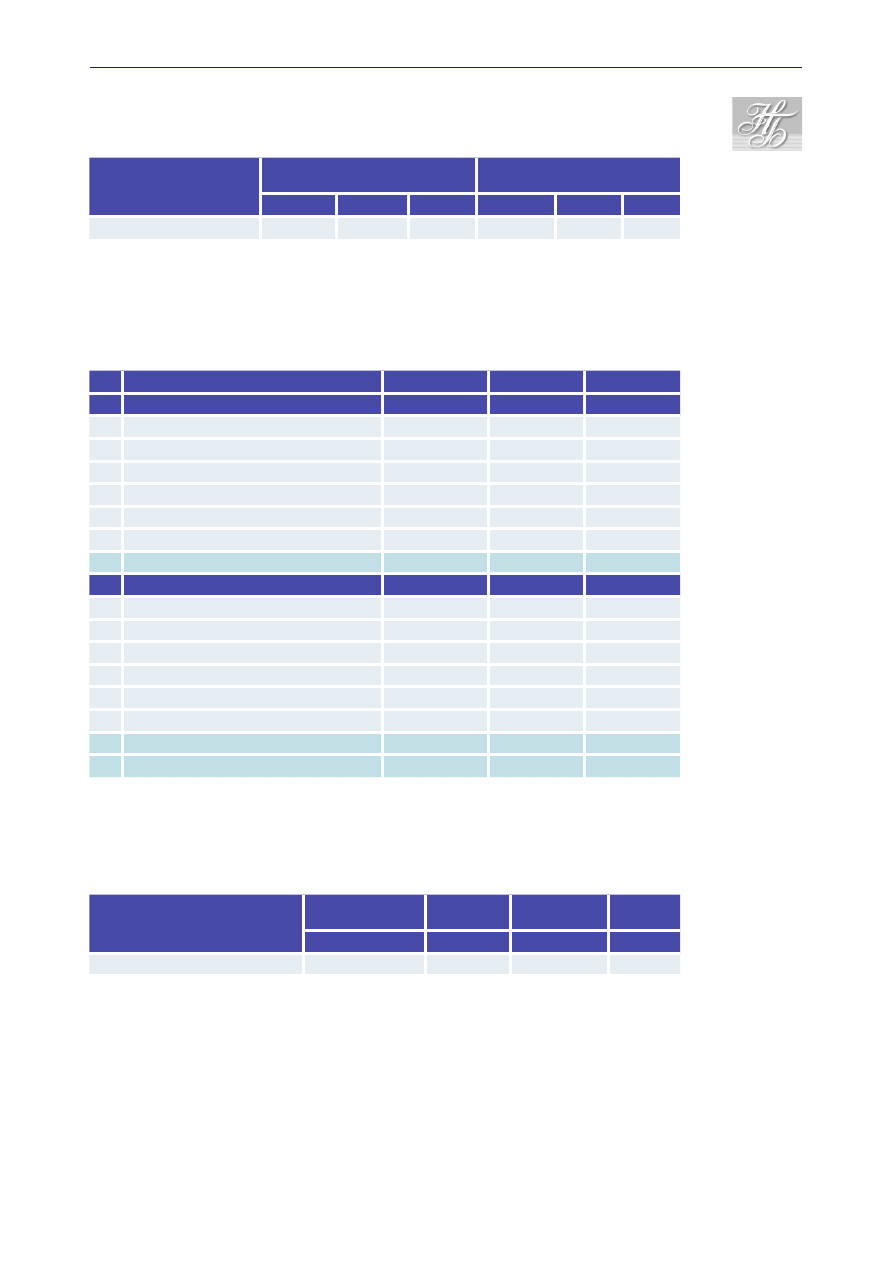
20
Proportion of foreign exchange assets and liabilities
(at year-ends)
Type of financial
institutions
Forex assets / Total assets
Forex liabilities / Total
liabilities
2002
2003
2004
2002
2003
2004
Commercial banks
45.57
42.87
40.66
44.59
42.08
40.45
Structure of revenues and expenditures of financial institutes
(at year-end)
bln.Br
2002
2003
2004
Revenues
1
Interest revenues
901.4
1,120.1
1,338.0
2
Commission
250.0
354.9
501.7
3
Other revenues
102.3
189.0
208.6
4
Other operational revenues
23.6
41.3
143.6
5
Reserve settlement
19.5
29.3
69.7
6
Unanticipated revenues
0.2
0.5
0.1
Total revenues
1,297.0
1,735.1
2,261.7
Expenses
1
Interest expenses
524.6
617.0
742.1
2
Commission
25.4
31.9
42.8
3
Other expenses
29.0
34.5
48.6
4
Other operational expenses
608.7
805.0
1 127.7
5
Allocation to reserve
59.4
115.2
119.9
6
Unanticipated expenses
0.0
0.0
0.0
Total expenses
1,247.1
1,603.6
2,081.1
Economic revenue
49.9
131.5
180.6
Excluding banks under liqiudation
Structure of registered capital and own funds of financial institutes in 2004
Type of the
financial institutions
Registered
capital
/Total
assets
Own funds
/ Total
liab.
EUR mln.
%
EUR mln.
%
Commercial banks
731.2
8.64
979.7
11.57
2004 DEVELOPMENTS IN THE BANKING SYSTEM OF THE REPUBLIC OF BELARUS

21
2004 DEVELOPMENTS IN THE BANKING
SYSTEM OF THE FEDERATION OF
BOSNIA AND HERZEGOVINA
MACROECOMIC ENVIRONMENT
Recent macro trends reflect this issue. The momentum of economic growth
appears strong. Assuming that the CPI is accurately gauging price trends, evi-
dence from the velocity of money, tax ratios, and sectoral output indicators
suggest that real output expanded in the upper end of the 5-6 percent range in
2004, buoyed by some 20 percent export growth and a continued expansion of
credit to the private sector of somewhat 25 percent, with mining in the RS, and
manufacturing and electricity in the Federation growing quickest. But, partly
as a result of the buoyancy of demand, imports – including consumption goods
– have surged. In this context, the external current account deficit strenghtened
by just ½ a percent of GDP in 2004. Given structural constraints on supply,
demand is growing as fast as it can consistent with avoiding a deterioration in
the external balance.
DEVELOPMENT IN THE BANKING SYSTEM
(INCLUDING THE ASSETS TOTAL/GDP)
Banking sector in the Federation of BiH has maintained and improved existing
trends and situation characteristic for past five years, especially during last two
years. The growth trend continued; business indicators improved; capital base
of the whole system became stronger; new foreign investments were attracted;
deposits increased; credit portfolios enlarged; risks were controlled and re-
duced; stability of the whole sector was improved; network was expanded; new
products were introduced; competition was fortified; higher level of working
quality was achieved; international operational and examinational standards
were applied.
In 2003 and 2004, the most significant changes could be summarized as
growth of large banks, growth in general, positioning in the market and inten-
sified competition.
Growth of larger banks and decreasing number of small banks:
Raiffeisen Bank started its operations in BiH. At the same time, LT Gospodarska
Bank Sarajevo was set up by merging Gospodarska Bank Sarajevo and LT
Komercijalna Bank from Livno. Another “family” arrangement was created into
UniCredit Zagrebačka Bank. Finally, HVB Central Profit Bank was “born” from
merging HVB and Central Profit Bank, both owned by Bank Austria. We already
received notice about merging of two Hypo Alpe Adria Bank-s in BiH.

22
Growth in general: At the end of 2000, 37 banks had banking license in
F BiH, and there were 24 banks at the end of 2004. Inverted to this reduction,
all other indicators increased in the observed period. By the analysis given by
respectable London financial magazine, The Banker, among 50 banks from
Central Europe two banks from F BiH have recorded the fastest growth of capi-
tal, assets and income in period 2001, 2002 and 2003.
Positioning: Taking better positions and taking up larger part of the mar-
ket is process which lasts for several years. Participation of foreign share capital
was about 2/3 of total share capital in banks in F BiH.
Competition: Strengthening and stabilization of the sector and its parts,
solution of internal weaknesses and staff and organizational improvement re-
sulted in more competition in market. Although opinion that interest rates are
(too) high is not uncommon, the fact is that the rates are slowly, but definitely,
getting lower and getting closer to lowest possible level. At the end of 2004 they
were (IMF methodology: 8,23 – 9,92). On the other hand, the battle for attrac-
tion of deposits is visible, especially if we speak of long-term deposits by offer-
ing lucrative interest rates and other advantages offered by banks. The ratio
between passive and active interest rates is getting close to the acceptable level.
In the contest for clients, banks use new products such as issuance of cards or
approving loans without guarantors, introduction of earmarked savings, housing
loans, etc. Banks encourage more popular use of debit and credit cards as non-
cash payment possibility. Banks invest significant effort and assets to increase
this type of products. Only during last year they installed 97 new ATM and there
are total 222 ATMs. AT the same time, number of POS terminals increased by
1,635 so it is possible to make payment of for goods in 5,587 POS.
Total balance sheet in banks in the Federation of BiH was KM 7.6 billion as
of 12/31/04. In comparison to previous year it represents growth of 32% or KM
1.8 million.
In last five years, that is, in period from beginning of 2000 to end of 2004,
balance sheet assets in banks increased by three times! Thanks to this growth,
for the first time one of our banks took 41
st
position among 100 biggest banks
in Central and Eastern Europe.
Balance Sheet, that is, assets in Balance Sheet are getting close to common
European standard. Commonly used indicator of banks’ strength is assets against
GDP. In developed countries bank assets are twice or more times larger then
GDP. In countries in transition the results are more modest. So, total assets in
banks in Bulgaria are 50% of GDP, in Poland are 66% of, in Hungary 78%, in
Croatia and Czech Republic little bit over 100%. By these criteria, banking sec-
tor in the Federation of BiH has decent results because assets were
90,9% of GDP in 2004.
The growth of balance sheet resulted from growth of deposits by KM 1.3
million or 31%, borrowings of KM 262 million which represents growth of 44%
in comparison to the previous year and growth of capital by KM 193 million or
27%.
2004 DEVELOPMENTS IN THE BANKING SYSTEM OF THE FEDERATION OF BOSNIA AND HERZEGOVINA

23
Total deposits, as major source of financial potential, reached KM 5.6
billion, and that is over 60% of estimated GDP. In other countries that ratio
was: 40% in Poland and Hungary, 60% in Croatia and Czech Republic and 67%
in Slovakia.
Total net income was KM 490.6 million in 2004 or 6% more than in 2003.
In the income structure, the participation of net interest income from 51.8%
in 2003 to 54.4% in 2004. It was obvious that growth of interest income (11%)
was not followed by credit placements (28%). Main reasons for these trends
were decreased interest rates, that is, credit margins, written off receivables and
significant amount of suspended interest.
THE LEGAL AND INSTITUTIONAL FRAMEWORK OF
THE OPERATION AND SUPERVISION OF FINANCIAL
INSTITUTIONS, NEW DEVELOPMENTS
LEGAL COMPETENCE OF THE BANKING SUPERVISORY
AUTHORITY
A) Laws
1. Law on Banking Agency of the Federation of BiH (“Official Gazette of the
F BiH”, No 9/96, 27/98, 20/00, 45/00, 58/02, 13/03 and 19/03),
2. Law on Central Bank of BiH (“Official Gazette of BiH”, No 1/97, 29/02
and 13/03),
3. Law on Banks (“Official Gazette of the F BiH”, No 39/98,32/00, 48/01,
27/02, 41/02 and 58/02, 13/03, 19/03 and 28/03),
4. Law on Financial Operations (“Official Gazette of the F BiH”, No 2/95,
13/00 and 29/00),
5. Law on Internal Payment System (“Official Gazette of the F BiH”, No
15/00-cleared text, 54/01),
6. Law on Foreign Exchange Operations (“Official Gazette of the F BiH”,
No 35/98),
7. Law on Securities (“Official Gazette of the F BiH”, No 39/98 and 36/
99),
8. Law on Securities Registry (“Official Gazette of the F BiH”, No 39/98 and
36/99),
9. Law on Securities Commission (“Official Gazette of the F BiH”, No 39/98
and 36/99),
10. Law on Prevention of Money Laundering (“Official Gazette of the F BiH”,
No 8/00),
11. Law on Bill of Exchange (“Official Gazette of the F BiH”, No 32/00 and
28/03),
12. Law on Check (“Official Gazette of the F BiH”, No 32/00),
2004 DEVELOPMENTS IN THE BANKING SYSTEM OF THE FEDERATION OF BOSNIA AND HERZEGOVINA

24
13. Law on Payment Transactions (“Official Gazette of the F BiH”, No 32/00
and 28/03),
14. Law on Obligations (“Official Gazette of R BiH”, No 2/92, 13/93 and
13/94 and “Official Gazette of the F BiH”, No 29/03),
15. Law on Enterprises (“Official Gazette of the F BiH”, No 23/99, 45/00,
2/02, 6/02-correction and 29/03),
16. Law on Bankruptcy Procedure (“Official Gazette of the F BiH”, No 29/
03),
17. Law on Liquidation Procedure (“Official Gazette of the F BiH”, No 29/
03),
18. Law on Labor (“Official Gazette of the F BiH”, No 43/99, 32/00 and
29/03),
19. Law on Executive Procedure (“Official Gazette of the F BiH”, No 32/
03),
20. Law on Registration of Legal Entities into Court Registry (“Official Ga-
zette of the F BiH”, No 4/00, 19/00, 49/00, 32/02, 58/01, 13/03, 19/03
and 50/03),
21. Law on Administrative Procedure (“Official Gazette of the F BiH”, No
2/98 and 48/99),
22. Law on Violations of Federal Regulations (“Official Gazette of the F BiH”,
No 9/96 and 29/00),
23. Law on Treasury in the F BiH (“Official Gazette of the F BiH”, No 19/
03),
24. Law on Bank Privatization (“Official Gazette of the F BiH”, No 12/98,
29/00 and 37/01),
26. Law on Accounting (“Official Gazette of the F BiH”, No 2/95, 14/97 and
12/98).
B) Prudential regulations issued by our Agency
1. Decision on Bank Supervision and Actions by the Banking Agency of the
Federation of BiH (“Official Gazette of the F BiH”, No 3/03),
2. Decision on Minimum Standards for Capital management in Banks (“Of-
ficial Gazette of the F BiH”, No 3/03 and 18/03),
3. Decision on Minimum Standards for Loan Risk and Assets Classification
Management in Banks (“Official Gazette of the F BiH”, No 3/03),
4. Decision on Minimum Standards for Risk Concentration Management
in Banks (“Official Gazette of the F BiH”, No 3/03, correction 6/03,
18/03),
5. Decision on Minimum Standards for Internal and External Audit in Banks
(“Official Gazette of the F BiH”, No 3/03),
6. Decision on Minimum Standards for Internal Control System in Banks
(“Official Gazette of the F BiH”, No 3/03),
7. Decision on Minimum Standards for Liquidity Risk Management in Banks
(“Official Gazette of the F BiH”, No 3/03),
2004 DEVELOPMENTS IN THE BANKING SYSTEM OF THE FEDERATION OF BOSNIA AND HERZEGOVINA

25
8. Decision on Minimum Standards for Foreign Exchange Risk Manage-
ment in Banks (“Official Gazette of the F BiH”, No 3/03 and 31/03),
9. Decision on Minimum Standards for Operations with Related Entities
in Banks (“Official Gazette of the F BiH”, No 3/03),
10. Decision on Minimum Standards for Documenting Loan Activities in
Banks (“Official Gazette of the F BiH”, No 3/03),
11. Decision on Reporting about Non-performing Customers Considered a
Special Loan Risk (“Official Gazette of the F BiH”, No 3/03),
12. Decision on Minimum Scope in Form and Content of Program and
Reporting about Economic-Financial Audit in Banks (“Official Gazette
of the F BiH”, No 3/03),
13. Decision on Reporting Forms Submitted by Banks to the Banking Agency
of the Federation of BiH (“Official Gazette of the F BiH”, No 3/03, 18/03
and 52/03),
14. Decision on Conditions when Bank is Considered Insolvent (“Official
Gazette of the F BiH”, No 3/03),
15. Decision on Minimum Conditions Banks have to Fulfill to Perform
Internal Payment System (“Official Gazette of the F BiH”, No 46/01),
16. Decision on Procedure for Determination of Claims and Distribution of
Assets and Liabilities in Liquidation of Banks (“Official Gazette of the F
BiH”, No 3/03),
17. Criteria for Internal Rating of Banks by the Banking Agency of the
Federation of F BiH (“Official Gazette of the F BiH”, No 3/03, correc-
tion 6/03),
18. Decision on Minimum Requirements for Issuance of License to Perform
Internal Payment System to Bank Branches Located in Republic Srpska
(“Official Gazette of the F BiH”, No 50/01),
19. Decision on Minimum Standards for Activities of Banks in Prevention
of Money Laundering and Terrorism Financing (“Official Gazette of the
F BiH”, No 3/03),
20. Decision on Financial Disclaimer (“Official Gazette of the F BiH”, No
3/03),
21. Decision on Interest and Fee Accrual for Dormant Accounts (“Official
Gazette of the F BiH”, No 7/03),
22. Decision on Amount and Conditions for Origination of Loans to Bank
Employees (“Official Gazette of the F BiH”, No 7/03 ),
23. Guidelines for Licensing and Other Approvals Issued by the Banking
Agency of the Federation of the F BiH (“Official Gazette of the F BiH”,
No 46/02 and 18/03).
Legal competences of our Agency are as follow:
a) Issuing licenses for establishment of banks, licenses for changes of the
organization and type of activities, and approvals for appointment of their
managing staff;
2004 DEVELOPMENTS IN THE BANKING SYSTEM OF THE FEDERATION OF BOSNIA AND HERZEGOVINA

26
b) Supervising banking operations, undertaking appropriate measures in
accordance with law;
c) Revoking banking licenses in accordance with law;
d) Managing or supervising the procedure of rehabilitation or liquidation of
banks, and starting the procedure of banks bankruptcy;
e) Declaring sub-legal acts regulating banks work;
f) Performing evaluation of conditions and issues approval to banks for next
issue of shares;
g) Performing actions in the support of anti-terrorist measures related to
banks;
h) Taking all such actions as may be appropriate, which may include the
blocking of customer accounts in any bank or banks within the ju-
risdiction of the Federation Banking Agency, in order to prevent the
funding of activities which are, or which threaten to be, obstructive of
the peace implementation process as pursued under the aegis of the
General Framework Agreement for Peace in Bosnia and Herzegovina
and requiring the Central Bank of Bosnia and Herzegovina to open a
special reserve account; requiring the bank of banks in which accounts
are blocked under item h aforesaid and transfer criminal funds to the
safe keeping of the Central Bank of Bosnia and Herzegovina, or one of
its main units and undertake numerous actions related to above men-
tioned issues including revocation of banking liceses and other kinds
of authorizations.
MAIN STRATEGIC OBJECTIVES OF THE SUPERVISORY
AUTHORITY
a) To make new steps to continue process to amend and develop the Laws,
regulations and procedures in accordance with Core Basel principles and
EU directives;
b) To start preparation of regulations for consolidated supervision of finan-
cial conglomerates;
c) To improve our precedures for dealing with week banks and banks under
our Agency administration and liquidation;
d) To on-site examine more banks than previous year;
e) To improve our IT system and make iz 100% useable for off-site examina-
tion of banks and improve reporting system;
f) To make our banking industry more stable and more atractive for foreign
capital; and so on.
2004 DEVELOPMENTS IN THE BANKING SYSTEM OF THE FEDERATION OF BOSNIA AND HERZEGOVINA

27
THE ACTIVITIES OF THE BANKING SUPERVISORY
AUTHORITY
a) Numerous activities related to improvement of our prudential regula-
tions;
b) Comprihensive on-site examinations in 12 banks;
c) 65 targeted on-site examinations;
d) Colection and analysis of about 30 reports, per bank, per quater, plus
monthly balance-sheets, dayly reports on FX position by 24 banks and so
on;
e) 4 regular (quaterly) informations about banking system and a number ad
hoc informations for internal and external needs;
f) Participation in the work of BSCEE;
g) Participation of our empyees in 7 seminars outside our Agency including
outside our country and 3 internal seminars; and so on.
INTERNATIONAL ACTIVITIES OF THE AUTHORITY
Our Agency has already signed MoU with supervisory authorities of 3 countries,
and currently we are in negotiations with another 3 authorized authorities.
COOPERATION WITH OTHER SUPERVISORY BODIES IN
THE COUNTRY
Our Agency strongly cooperates with Central banka of Bosnia and Herzegovina
(MoU); banking Agency of Republic Srpska; Deposit Insurance Agency in Bosnia
and Herzegovina (MoU); Insurance supervision Agency (MoU); and with all
other institutions including issues of prevention of money laundering and com-
bat finance terrorism.
OTHER RELEVANT INFORMATION AND DEVELOPMENTS
IN THE COURSE OF 2004
We were strongly working on bilding of unique banking supoervision author-
ity under «ambrela» of Central bank of Bosnia and Herzegovina. It was not
finished.
2004 DEVELOPMENTS IN THE BANKING SYSTEM OF THE FEDERATION OF BOSNIA AND HERZEGOVINA
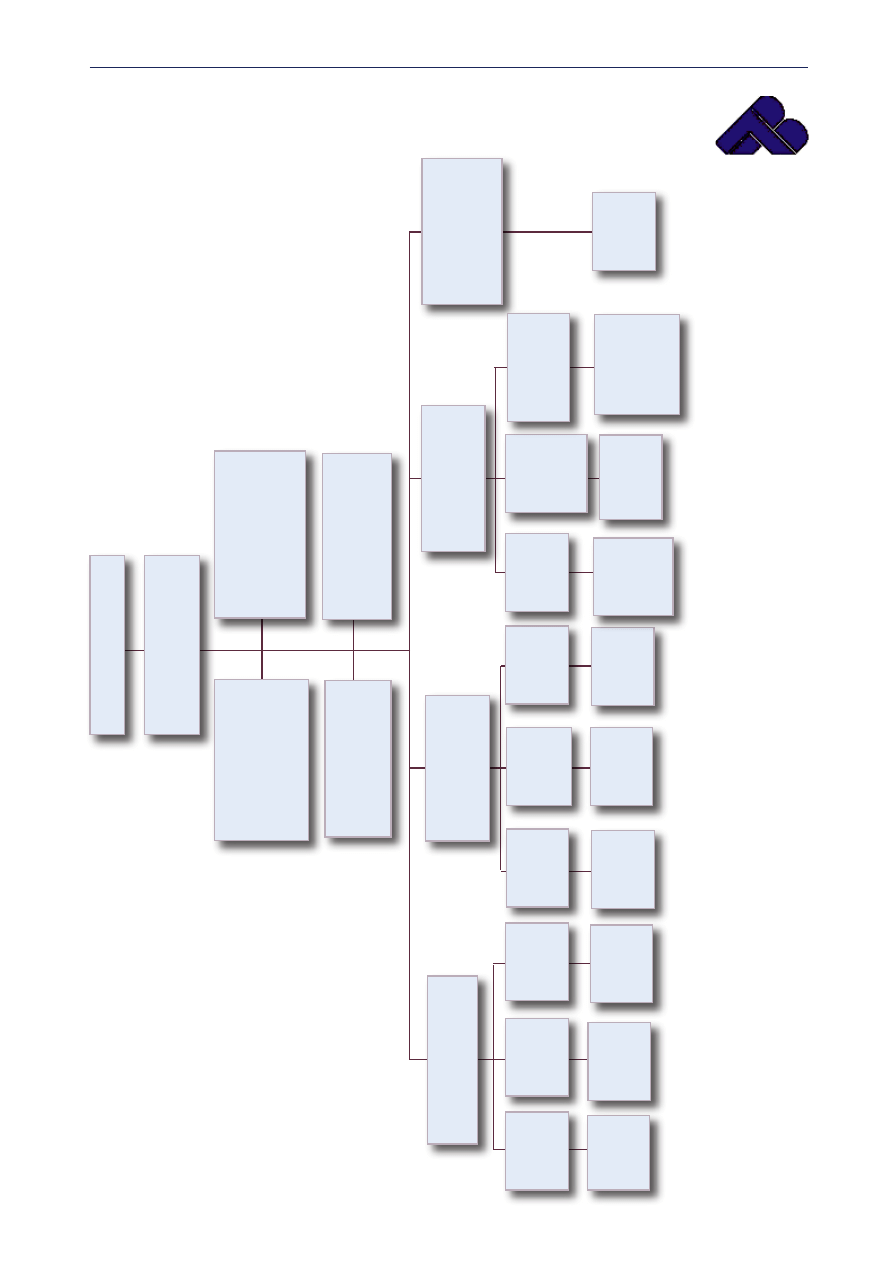
28
BANKING AGENCY OF THE FEDERATION BIH
2004 DEVELOPMENTS IN THE BANKING SYSTEM OF THE FEDERATION OF BOSNIA AND HERZEGOVINA
Managing Board
Management
Director
Deputy Director
Director's Office
Office
Head
Secretary
Driver Driver
Office
of
Advisor
to
the Director
Advisor to the Director
Development Office
Office
Head
Technical
Associate for
Development Issues
PR Office
Senior T
echnical
Associate
– PR
Translator
Supervision Department
Assistant Director
Legal and Licensing
Department
Assistant Director
Department for Banks under FBA
Administration
Director
On-site
Supervison
Head
Off-site
Supervison
Head
AML
and
ATF Unit
Head
R
eg
ul
at
io
ns
Unit Head
Legal
Repr
. Unit
Head
Licensing
Unit Head
IT
Department
Head
Accounting
and
Financial
Unit Head
General and Staffing
Unit
Head
On-site
16
examiners
Off-site
6
examiners
2
examiners
Senior
Technical Associate
Senior
Technical Associate
Senior
Technical Associate
Technical Associate Technical Associate
Independent
Officer Officer
Officer
Receptionist Receptionist Maintenance/ Security Clerk
5
Examiners
General
Administration
Department
Director

29
STATISTICAL TABLES
Number of financial institutions
(at year-ends)
Type of financial institution
2002
2003
2004
Banks
29
27
24
Financial institutions, total
29
27
24
Ownership structure of the financial institutions
on the basis of registered capital (%)
(at year-ends)
BANKS
Item
2002
2003
2004
Public sector ownership
12.8
12.6
17.8
Other domestic ownership
20.5
19.2
17.4
Domestic ownership total
33.3
31.8
35.2
Foreign ownership
66.7
68.2
64.8
Financial institutions, total
100.0
100.0
100.0
Ownership structure of financial institutions on the basis of assets total (%)
BANKS
Item
2002
2003
2004
Public sector ownership
7.9
6.4
4.9
Other domestic ownership
16.4
14.7
15.8
Domestic ownership total
24.3
21.1
20.7
Foreign ownership
75.7
78.9
79.3
Financial institutions, total
100
100
100
Concentration of asset by type of financial institutions (%)
Type of financial institution
The first three
largest
The first three
largest
Bank
58.1
72.9
Financial institutions, total
100.0
100.0
Return on asset (ROA) by type of financial institutions
Type of financial institution
2002
2003
2004
Bank
0.36
0.88
0.72
2004 DEVELOPMENTS IN THE BANKING SYSTEM OF THE FEDERATION OF BOSNIA AND HERZEGOVINA

30
Return on equity (ROE) by type of financial institutions
Type of financial institution
2002
2003
2004
Bank
3.00
8.17
6.89
The structure of assets and liabilities of the banking system (%)
(at year-end)
Assets
2002
2003
2004
Cash and securities
36.4
36.1
37.8
Placements to other banks
0.4
0.6
1.1
Loans – net value
54.6
56.1
55.0
Premises and oth. fixed ass.
6.4
5.3
3.9
Other assets
2.2
1.9
2.2
Liabilities
2002
2003
2004
Deposits
76.8
74.4
73.6
Borrow. from banks
0.1
0.1
0.1
Loans payables
6.8
10.2
11.2
Other liabilities
2.7
2.9
3.2
Capital
13.6
12.4
11.9
Development of off-balance sheet activities (%)
(off balance sheet items / balance sheet total)
Type of financial institution
2002
2003
2004
Banks
15.11
12.96
16.1
Solvency ratio of financial institutions liab./assets (%)
Type of the financial institution
2002
2003
2004
Banks
86.4
87.6
88.1
Asset portfolio quality of the banking system %
Asset classification
2002
2003
2004
A
85.9
87.2
88.4
B
8.8
8.4
8.2
C
2.7
2.3
1.6
D
2.5
2.0
1.8
E
0.1
0.1
-
Classified total
100.0
100.0
100.0
Specific reserves
21.8
20.4
18.1
* % of classified asset (B,C,D,E)
2004 DEVELOPMENTS IN THE BANKING SYSTEM OF THE FEDERATION OF BOSNIA AND HERZEGOVINA

31
The structure of deposits and loans in 2004 (%)
(at year-end)
Deposits
Loans
Households
38.8
48.4
Government sector
10.7
0.8
Corporate
29.7
48.3
Foreign
-
-
Other
20.8
2.5
Total
100.0
100.0
The structure of deposits and loans in 2004 (%)
(at year-end)
Maturity of deposits
Loans
At sight
47.5
Long term loans
72.8
Within one year
15.8
Medium-term loans
-
Over one year
36.7
Short-term loans
27.2
Total
100.0
Total
100.0
Proportion of foreign exchange assets and liabilities
(at year-ends) %
Type of the
financial
institutions
FOREX assets / Total assets
FOREX liabilities / Total liab.
2002
2003
2004
2002
2003
2004
Banks
32.8
26.8
27.8
59.7
52.6
54.2
Structure of registered capital and own funds
of financial institutions in 2004
Type of the
financial
institutions
Registered
capital
/Total assets
Own funds
/Total liab.
000 EUR
%
000 EUR
%
Banks
389,278
10.0
74,288
1.9
2004 DEVELOPMENTS IN THE BANKING SYSTEM OF THE FEDERATION OF BOSNIA AND HERZEGOVINA

32
2004 DEVELOPMENTS IN THE
BULGARIAN BANKING SYSTEM
MACROECONOMIC ENVIRONMENT
In 2004 Bulgaria’s economy managed 5.6% growth. The past year was the
seventh in a row to see Bulgaria attaining relatively high growth. The greatest
contribution to Gross domestic product came from households’ consumption
and investment in fixed assets. Growth in goods and service imports outstripped
that of exports, with the balance of payments contributing negatively to GDP
growth. This negative contribution was much smaller, however, due to accelera-
tion of export growth. Final household expenditure grew by 5.5% in real terms.
A trend towards more favourable consumer expenditure patterns has emerged
over the past few years, indicating gradual lifestyle improvements. Consumer
demand growth boosted retail trade, which grew by 13.8% in real terms year
on year. Dynamic trade boosted budget revenues from indirect taxes, as well
as the demand for cash. Fixed capital investment grew by 12% in real terms.
The increase in non-government sector lending (by a nominal 74.8% to house-
holds and 38.3% to non-financial corporations) provided additional funds for
consumer spending and investment.
The rate of export growth was an important driver for the high rates of in-
dustrial increase in 2004. Goods and services exports in euro grew by 20.1%
over the previous year. The contribution of exports to GDP growth exceeded
almost twofold that of household consumption. Increased domestic demand
was the main driver of imports growth. Balance of payments data shows goods
and services imports in euro growing by 19.9%.
Increasing employment was an important factor in household income growth
and hence consumption. Employment growth was pronounced in sectors with
prevailing private ownership and is a reflection of increased economic activ-
ity. The registered unemployment rate fell to 12.2% or 1.3% lower than in late
2003.
Average annual inflation in 2004 was 6.2%, and is largely a reflection of price
developments in 2003. End of period inflation was 4%. International crude oil
prices were an inflationary factor, which had a direct effect on fuel prices and,
with a lag, on transportation, other services and commodities. The declining
unit labour costs in industrial production, as well as stable international prices
of imported consumer goods helped keep CPI inflation down.
Growth rates of monetary aggregates in 2004 remained high due to the
increased amount of cash transactions, increased banking system deposits, and
a continuing credit expansion. Monetary aggregate M3 rose by 23.1%. Quasi-
money, including deposits with maturities of up to two years and deposits
redeemable at notice of up to three months, grew by 18.6%.
Gross international foreign exchange reserves reached EUR 6.770 billion in
end-2004, growing by EUR 1461 million over the end of 2003.

33
DEVELOPMENT IN THE BANKING SYSTEM
In 2004 the Bulgarian banking sector was made up of 35 banks, incl. 29 local
banks or subsidiaries of foreign banks and 6 foreign bank branches. Banking
privatization was finished with the deal for Bank DSK in 2003 (his new owner
is the Hungarian OTP Bank). Only Nasarchitelna Banka (Encouraging Bank)
remains in state ownership. In 2004 Hebros Bank was absorbed by Bank
Austria subdivision in Bulgaria HVB Bank Biochim. The share of bank assets
controlled by foreign banks and other foreign investors was 82%. Most of the
large Bulgarian banks belong to international banks and financial groups.
Commercial banks behaviour over 2004 was characterized by greater lending,
with the quality of assets remaining high. Earnings were high, ensuring adequate
returns on assets and equity. The higher 2004 result (421 mio BGN against 319 mio
BGN in 2003) predetermined a 2.06 % return on assets (ROA) against 2.04 % in
2003, and 20.02 % return on equity (ROE) against 18.73 % in 2003.
The total amount of commercial bank assets grew by 7.5 bn BGN to 24.9 bn
BGN, a 43.57 % growth. Lending increased by 47.15 %, showing the most
dynamic development. Deposits grew by 5.9 bn BGN or 43.58 %. The banks’
capital base rose by 7.78 %.
Transactions throughout 2004 continued to sharpen banking system risk
profile. Credit risk remained the major risk for most banks despite various
supervisory and financial measures initiated to curb lending growth. During
the last 12 months foreign financing attracted by banks increased as a result of
significant bank innovations and banks ambition for extending market niches.
This meant enhanced competition between commercial banks. New bank product
prices tended to fall, especially in the consumer and mortgage segments.
Sensitivity to currency risk remained low. Major banks kept US dollar posi-
tions short and euro ones long. The system position was short, accounting for
4.39 % of equity.
Price risk played an insignificant role in the banking system balance sheet.
Despite some banks pursuit for increasing trading activities with investment
instruments up to quite high level of market speculation, sensitivity to changes
in securities prices and interest rate levels was low.
Enhanced lending was the leading idea of 2004 commercial bank behaviour.
Despite significant lending growth the quality of assets remained good. Most
banks had to devote more and more financial and human resources to manag-
ing their sizable credit volumes. By the end of 2004 classified assets accounted
for 3.86% of total banking assets against 4.26 % at the end of 2003. Classified
loans comprised 7.06 % of total bank credit (against 7.97 % at the end of the
previous year).
Intensive 2004 credit growth, coupled with a steady increase in interest in-
come and income from fees and commissions allowed banks to counterbalance
the effect of the funding price rise to some extent and narrowed interest rate
spreads. With the greater number of new products and services in both lend-
ing and deposits, fee and commission earnings became more significant. On the
other hand, the change in the makeup of the sources of financing (as regards
funds borrowed from abroad to make up insufficient domestic resource) slowly
pushed up asset funding rates. The increase in non-interest expenditures did
2004 DEVELOPMENTS IN THE BULGARIAN BANKING SYSTEM

34
not exert serious pressure on banks’ profitability due to the ability to generate
economies of scale. The extraordinary profit remained an income component
in only a few banks, and the effect of foreign exchange operations was insignifi-
cant. In most banks, credit and market risk levels did not worsen the quality
and quantity of earnings due to additionally allocated provisions and did not
imply significant interest rate fluctuations on earnings.
A gradual worsening of commercial banks capital positions characterized
the last 12 months. This involved both the structure and volume of asset risk
components and capital base growth. Against 43.57 % asset growth and 47.15
% credit growth in 2003, the capital base grew by 7.78 % to 2.3 bn BGN, a
major factor behind falling capital indicators. Regulatory ratios were also
affected by the amendments to Regulation No. 8 of the BNB establishing the
mechanism for including current profit into banks’ capital bases. Despite the
capital adequacy ratio falling from 22.20 % at the end of 2003 to 16.58 % at the
end of 2004, banking system excess capital was 641 mio BGN against 989 mio
BGN at the end of 2003.
Banking liquidity in 2004 remained high. Liquidity was among the bank-
ing system financial indicators which have sustained their basic characteristics
for over 12 months. Most banks’ indicators were good, allowing more flexible
asset management. There were no signs of depositor nerves, this ensuring
stable funds and conditions for longer-term investment decisions (including
increased lending). In 2004 banks succeeded in maintaining asset and financing
structures, ensuring adequate liquidity.
LEGAL AND INSTITUTIONAL FRAMEWORK FOR
OPERATION AND SUPERVISION OF FINANCIAL
INSTITUTIONS
NEW DEVELOPMENTS; LEGAL COMPETENCE OF THE
BANKING SUPERVISORY AUTHORITY IN BULGARIA
The Law on Banks is the primary law on banking. Together with other laws such
as the Commercial Law, the Law on Securities, Stock Exchanges and Investment
Companies, the Law on Accounting and the Law on Measures against Money
Laundering, it creates the legal base for banking in Bulgaria.
The Law on the BNB defines its supervisory task as regulation and supervi-
sion over activities of other banks in the country for the purpose of ensuring
the stability of the banking system and protecting depositors‘ interests. The
laws and a number of prescribed, in forms of detailed Regulations, issued by
the Management Board of BNB, provide minimum prudential standards that
banks must meet.
New developments
Bulgarian bank legislation is harmonized to a high degree with EU law. In 2004
the BNB helped prepare amendments to the legal framework regarding the cen-
2004 DEVELOPMENTS IN THE BULGARIAN BANKING SYSTEM

35
tral bank, the banking sector, and payment systems aimed at further harmoni-
zation with acquis communautaire. BNB goals were to adopt the amendments
in the shortest time, thus enabling the banking sector to prepare for participa-
tion in the EU internal market. The prepared amendments were discussed with
representatives of the banking sector. With a view to full harmonization with
EU law, legislation was drafted, the main foci being central bank independence,
banks’ capital adequacy, fund transfers, electronic payment instruments, and
payment systems.
By the final adoption of the Amendments to the Law on the Bulgarian National
Bank in early 2005, the Bank’s legal framework was brought into line with acquis
and with commitments negotiated on the Economic and Monetary Union Chapter,
while retaining the currency board conditions and principles. According to the
amendments, the primary objective of the Bulgarian National Bank is “to maintain
price stability through ensuring the stability of the national currency.” Additional
guarantees related to institutional, personal, financial and functional central bank
independence were introduced in compliance with the Treaty Establishing the
European Community and with the Statutes of the European System of Central
Banks (ESCB) and the European Central Bank (ECB). Other amendments pertain
to payment systems oversight, protection of banknotes and coins against counter-
feiting, and central bank internal audit. The amendments to the Law introduced
complete prohibition of government financing by the central bank.
The BNB amended its Regulation No. 9 on the evaluation and classification
of risk exposures of banks and the allocation of provisions to cover impairment
losses. The former Doubtful and Loss Exposures have been merged into a Non-
performing Exposures group on which not less than 100 % provision is required.
The maximum default term for an obligation classified under this group has
been cut from 180 to 90 days. Conditions under which banks restore restruc-
tured exposures to more favourable groups have been tightened.
In April 2004 Regulation No. 8 on the capital adequacy of banks was amended
by setting out terms under which banks may include current profits into primary
capital. The amendments provide for applying risk weights which correspond
to the guarantor’s risk weight on the guaranteed portions of bank exposures
partially covered by zero-risk or low-risk assets.
In 2004 seminars and consultations with experts from the French and Dutch
central banks were organized under their Twinning Covenants with the BNB.
They addressed the introduction of capital requirements on market risk in
determining banks’ capital adequacy ratios according to the specific Bulgarian
conditions and in compliance with EU directives.
In fulfillment of pre-accession commitments by the close of the year, a new
Regulation No. 8 on the capital adequacy of banks was adopted to include market
risk capital requirements. The changes addressed the banks forming significant
trading portfolios of financial instruments. Banks may apply two approaches to
measuring and reporting market risk (a function of capital requirement from
the second half of 2005): a standard one, or one based on value-at-risk (VaR)
internal models. The standard approach will be mandatory for initial measuring
of market risk, while the internal models applied by banks will be recognized for
supervisory purposes where sufficient expertise is demonstrated and a number
of qualitative criteria is met.
2004 DEVELOPMENTS IN THE BULGARIAN BANKING SYSTEM

36
The new Regulation on bank capital adequacy provides for greater precision
in reporting risks faced by the banks and ensures the relevant capital coverage
under existing credit risk requirements. Credit risk weights are retained and
include an additional requirement to mortgages loans risk-weighted at 50 %
that the amount of loan may not exceed 70 % of property value. Where this
ratio is violated, exposures have to be assigned a 100 % risk weight. The new
requirements are expected to help restrain excessive credit risk in mortgage
lending.
In line with the above, amendments to Regulation No. 7 on the large expo-
sures of banks provide for an equal approach by recognizing partial guaran-
tees in computing regulatory limits. The scope of exceptions for certain cases
was widened to include banks’ exposures to parent banks or subsidiary credit
institutions within local or foreign bank groups. The range of related entities
covered by constraints for related entities lending has been extended. An addi-
tional provision on measuring and reporting large trading portfolio exposures
was included.
Supervisory report forms were changed to reflect amendments to the above
regulations. New capital adequacy report forms accounting for market risk are
pending.
Legal competence of the Banking Supervisory Authority
According to the laws, the Governor of the central bank is empowered to grant
or revoke a bank license, taken on a motion by the Deputy Governor in charge
of Banking Supervision. The head of BNB has also a central role in the orderly
resolution of a problem bank case, as powers independent to appoint a conser-
vator, to approve a merger or take-over, to sell a liquidated bank, and to peti-
tion the court to institute bankruptcy proceedings. Finally, to draw all levels of
competence, the Deputy Governor of BNB in charge of Bank Supervision carries
out the tasks of running supervisory enforcement and measures. In this rela-
tion, she may require any accountings and other records, as well as any informa-
tion on banks’ activities to be submitted, and may appoint on-site inspections
fulfilled by officers and other persons authorised by her.
MAIN STRATEGIC OBJECTIVES OF THE SUPERVISORY
AUTHORITY IN 2004
By the end of June 2004 the Basle Committee on Banking Supervision adopted
the new International Convergence of Capital Measurement and Capital
Standards: a Revised Framework. The new capital adequacy framework known
as Capital Accord II, and Bulgaria’s pending accession to the European Union in
2007, predetermined Bulgaria’s banking supervision strategy. It complies with
EU Commission views on establishing a common financial services market, and
with the European supervisory framework on financial services.
2004 DEVELOPMENTS IN THE BULGARIAN BANKING SYSTEM

37
To accomplish these goals and cope with the ensuing challenges, the Banking
Supervision Department announced to the banking community its plan for pre-
paring and applying the new capital requirements consistent with the expected
amendments to Directive 2000/12/EC on credit institution activity. A special
working group aims to organize an efficient and timely implementation of the
Banking Supervision Department’s major task. Specialized subgroups within
it shall design a new national framework for measuring and reporting risk and
capital requirements to banks.
ACTIVITY OF THE BANKING SUPERVISION AUTHORITY
Following a cycle of surveys on the development of the Bulgarian economy and
consultations with the International Monetary Fund, a new review under the
Financial Sector Assessment Program (FSAP) was prepared in 2004. It included
financial market developments in the context of macroeconomic growth and
the need to maintain stability. Along with a positive assessment on the BNB’s
enhanced institutional capacity and on regulatory framework progress, the bank-
ing sector and banking supervision section also included possible measures to
curb lending and balance banks’ lending policy.
Supervisory on-site inspections primarily aimed to identify risk zones
and levels, and determine managements’ capability to measure, control and
manage risks effectively. Also checked were: capital adequacy, shareholder
quality (support), credit risk (extent and management), management actions,
internal rule and procedure quality, observance of banking legislation, earnings
adequacy and trends, liquidity management, market risk (extent and manage-
ment), off-balance sheet commitment risks, the scope and quality of internal
control, and information technology reliability. Given enhanced lending, more
than 70% of on-site inspection time was spent reviewing and assessing asset
quality. Breaches found involved mostly incorrect classification of risk expo-
sures, credit concentrations exceeding statutory limits, insufficient methodology
for reporting credits through the method of net current value based on the
effective interest rate and impairment of risk exposures under International
Accounting Standard 39.
In 2004 major emphases in off-site supervision involved:
• Analysis of commercial banks’ current performance based on financial
reports submitted for supervisory purposes;
• Assigning three-month CAMELS ratings by four components: capital
adequacy, asset quality, earnings, and liquidity, and identifying the respec-
tive trend in the risk profile of each commercial bank (steady, downward,
or upward);
• Preparing three-month analyses of banking system performance, includ-
ing reviewing major trends and risk zones and modeling the direction and
sharpness of future risks based on stress tests;
• Analyzing the financial performance of foreign institutions with subsidi-
aries in Bulgaria with regard to financial backing where necessary.
2004 DEVELOPMENTS IN THE BULGARIAN BANKING SYSTEM

38
Dynamic credit institution development through 2004 entailed a number of
changes to update market profiles and improve service quality. Organizational
structures, information and management information systems, and control
mechanisms in banks changed, key personnel to drive the changes through were
recruited, flexible staff training was introduced, and closer interdependence
between performance and personal responsibility was brought in. Remarks ad-
dressed to banks’ senior management were associated mostly with supervisory
violations, the lack of comprehensive strategies, the need to improve market
and operational risk assessment, imprudent dividend policies, and insufficient
shareholder support.
ORGANIZATIONAL CHART OF THE BANKING
SUPERVISION AUTHORITY
In parallel with the work on the regulative framework, the Banking Supervision
Department has been working on its institutional set-up. Banking supervision
performs its functions with a staff of 76 persons, divided into five directorates.
The overall structure of Banking Supervision is developed according to the
internationally accepted norms and practices.
Banking Supervision Department
2004 DEVELOPMENTS IN THE BULGARIAN BANKING SYSTEM
Deputy Governor
Chief Director
Supervision
Policy &
Methodology
Directorate
Off-site
Supervision
& Analyses
Directorate
On Site
Supervision
Directorate
Special
Supervision
Directorate
Supervisory
Legal
Directorate
Supervision
Policy Division
Accounting
Methodology
Division

39
INTERNATIONAL ACTIVITIES OF AUTHORITY
The two-year PHARE 2001 program financed project on cooperation between
the BNB and the French and Dutch central banks was completed in September
2004. Its essential purposes were to improve BNB administrative capacity, to
adopt and apply European Community law, and to introduce best European
practice to the BNB in the process of preparing for membership in the European
System of Central Banks and the financial system of the European Union.
The project was implemented in two stages. In the first year specialists from
the BNB and the French and Dutch central banks analyzed BNB organization,
functions and activities with a view to identifying divergences from EU and
ESCB requirements and to defining specific action for the 11 components of
the agreement. During the second stage BNB specialists and their French and
Dutch partners conducted various actions in order to improve BNB organiza-
tion and operations, and raise staff qualifications.
The Strategy for Bulgarian National Bank Development between 2004 and
2009 was prepared with the help of partners from the French central bank.
Based on it, a Road Map of measures and terms for their implementation was
designed with a view to preparing the BNB for its full ESCB and Eurosystem
membership.
Two bilateral cooperation agreements were signed with the French and
Dutch central banks. One of the main foci is banking supervision along with
other areas such as accountancy, foreign exchange reserve management,
statistics, cash operations, and BNB preparations for participation in ESCB
monetary operations.
As part of the Bank’s preparation for the forthcoming BNB membership in
the ESCB and in relation with its 125th anniversary, in June 2004 a seminar was
held on challenges facing the BNB on its way. Lecturers from the central banks
of France, the Netherlands, and Poland presented the ESCB and Eurosystem’s
institutional organization, the role of national central banks, the changes
stemming from EU accession, and the challenges to central banks associated
with European System of Central Banks membership.
In 2004 the BNB signed a new memorandum with The Commission Bancaire
of France. The memorandum aims to regulate and facilitate the exchange of
bank information and supervisory cooperation. Signing of a similar memoran-
dum between the BNB and the Turkish supervisory body is pending. Thereafter,
countries which own banks in Bulgaria and countries where Bulgarian banks
operate through branches or subsidiaries will be fully covered.
COOPERATION WITH OTHER SUPERVISORY BODIES IN
BULGARIA
After the Memorandum for Cooperation between BSD and the Deposit Insurance
Fund concluded in 1999 cooperation already started between BSD and the other
financial sector supervisors. This became reality after the newly adopted Law on
the Commission on Financial Supervision (CFS). The law on the Commission
2004 DEVELOPMENTS IN THE BULGARIAN BANKING SYSTEM

40
also constitutes the so-called Financial Stability Council (FSC), which enlist the
heads of the Commission, the Bank Supervision and the Secretary of Finance
of Bulgaria. The Council activity covers several areas: financial stability tasks
and strategic development issues, regulation rules and methodology harmoni-
sation, sharing and exchange of information and supervisory expertise, joint
examinations and actions, etc.
STATISTICAL TABLES
Number of financial institutions
(operating at year -ends)
Type of financial institution
2002
2003
2004
Commercial Banks
34
35
35
of which:
Large banks*
3
3
5
Small and medium-sized banks
25
26
24
Foreign bank branches
6
6
6
Nonbanking financial institutions
72
83
84
Leasing companies
39
45
60
Fianancial institutions, total
145
163
144
* Banks with total assets over 1 milliard EUR in 2004
Ownership structure of the banks on the basis of registered capital (%)
Item
2002
2003
2004
Public sector ownership
13.0
3.4
3.1
Other domestic ownership
20.4
20.3
22.6
Domestic ownership total
33.4
23.7
25.7
Foreign ownership
66.6
76.3
74.3
Banks, total
100.0
100.0
100.0
Ownership structure of the banks on the basis of assets total (%)
Item
2002
2003
2004
Public sector ownership
14.23
0.42
0.38
Other domestic ownership
12.25
16.91
18.01
Domestic ownership total
26.48
17.33
18.39
Foreign ownership
73.52
82.67
81.61
Banks, total
100.00
100.00
100.00
2004 DEVELOPMENTS IN THE BULGARIAN BANKING SYSTEM

41
Concentration of assets by the type of financial institutions (%)
Type of institutions
The first 3 largest
The first 5 largest
Commercial banks
36.26
52.19
Nonbanking financial institutions
72.00
80.19
Return on assets (ROA) by the type of financial institutions (%)
Type of institutions
2002
2003
2004
Commercial banks
2.05
2.04
2.06
Nonbanking financial institutions
1.37
0.69
2.57
Return on equity (ROE) by the type of financial institutions (%)
Type of institutions
2002
2003
2004
Commercial banks
16.20
18.73
20.02
Nonbanking financial institutions
5.82
4.79
20.38
Distribution of market shares in balance sheet total (%)
Type of institutions
2002
2003
2004
Commercial banks
99.15
98.85
98.73
Nonbanking financial institutions
0.85
1.15
1.27
Development of off-balance sheet activities (%)
(off-balance sheet items / balance sheet total)
Type of bank
2002
2003
2004
Large banks
5.0
8.8
13.9
Small and medium-sized banks
20.6
19.6
15.6
Banks, total
13.8
14.6
14.8
2004 DEVELOPMENTS IN THE BULGARIAN BANKING SYSTEM
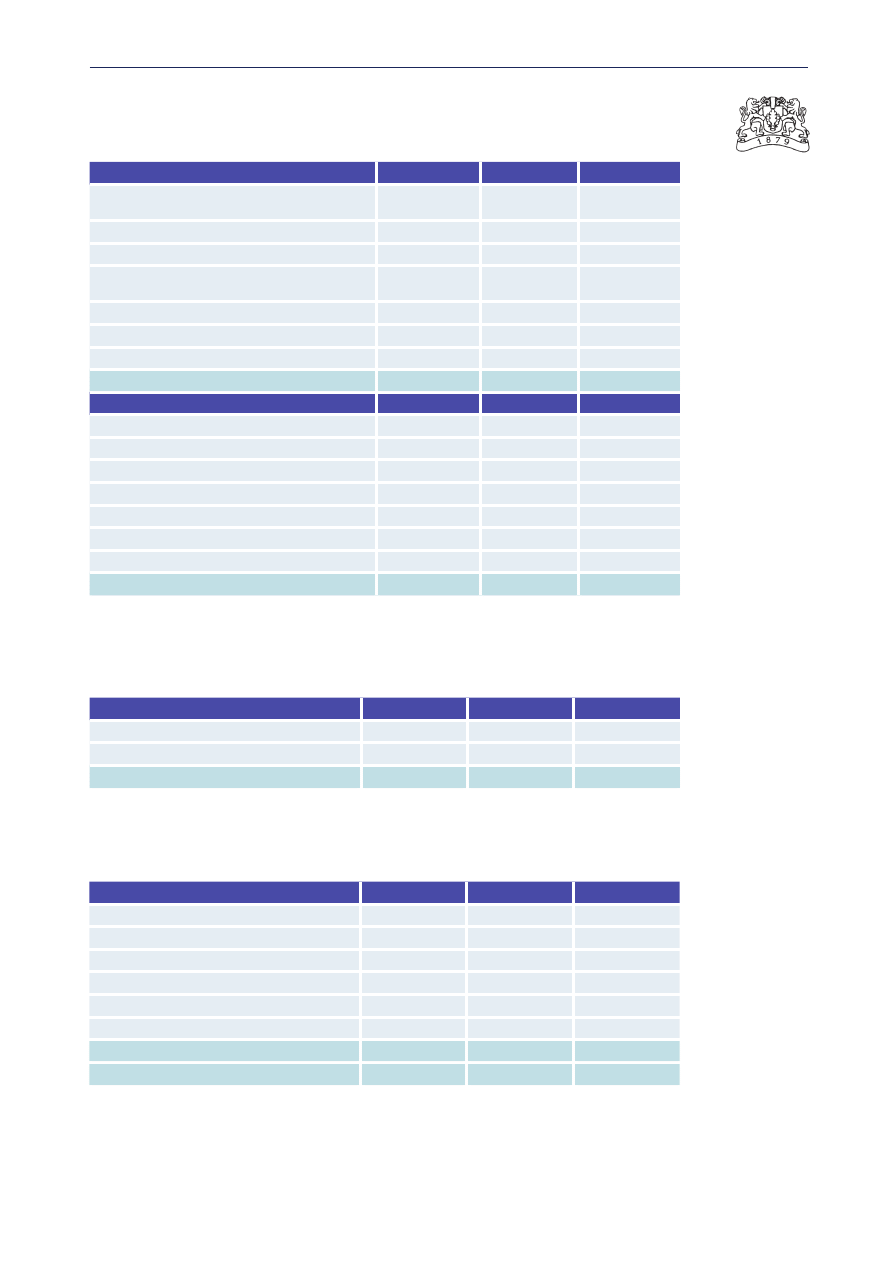
42
Structure of assets and liabilities of the banking system (%)
(at year-end)
Assets
2002
2003
2004
Cash in vault & funds in current account
with BNB
8.6
9.4
10.7
Due from banks & other financial institutions
24.2
14.9
15.8
Securities in trading portfolio
11.8
8.6
8.7
Loans extended to non-financial institutions
and other clients
41.2
52.0
53.6
Securities in investment portfolio
7.6
10.0
7.3
Fixed assets
4.6
4.6
3.4
Other assets
2.1
0.6
0.5
Total assets
100.0
100.0
100.0
Liabilities and capital
2002
2003
2004
Deposits by banks and other fin. institutions
8.4
8.6
11.2
Deposits by NFIs and other clients
68.6
70.0
67.3
Total deposits
77.0
78.5
78.5
Other liabilities
9.4
8.0
10.0
Subordinated debt
0.0
0.4
0.5
Capital
6.4
5.4
4.1
Reserves
7.2
7.8
6.9
Total liabilities & own funds
100.0
100.0
100.0
Solvency ratio of banks
Type of banks
2002
2003
2004
Large banks
28.7
27.7
15.9
Small and medium-sized banks
23.3
18.8
21.9
Banks, average
25.2
22.2
16.6
Asset portfolio quality of the banking system
Assets classification
2002
2003
2004
Amount in BGN Millions
10,067,439
11,568,572
17,725,769
Standard %
93.5
93.5
94.5
Watch %
2.9
3.1
2.7
Substandard %
1.0
0.8
1.2
Doubtful* %
0.5
0.6
1.6
Loss* %
2.1
2.0
Classified total %
100.0
100.0
100.0
Specific reserves %
4.9
3.7
2.7
* The BNB amended its Regulation N 9 on the evaluation and classification of risk exposures of banks and the
allocation of provisions to cover impairment loss. The former Doubtful and Loss Exposures have been merged
into a Non-performing Exposures group on which not less than 100 per cent provision is required.
2004 DEVELOPMENTS IN THE BULGARIAN BANKING SYSTEM
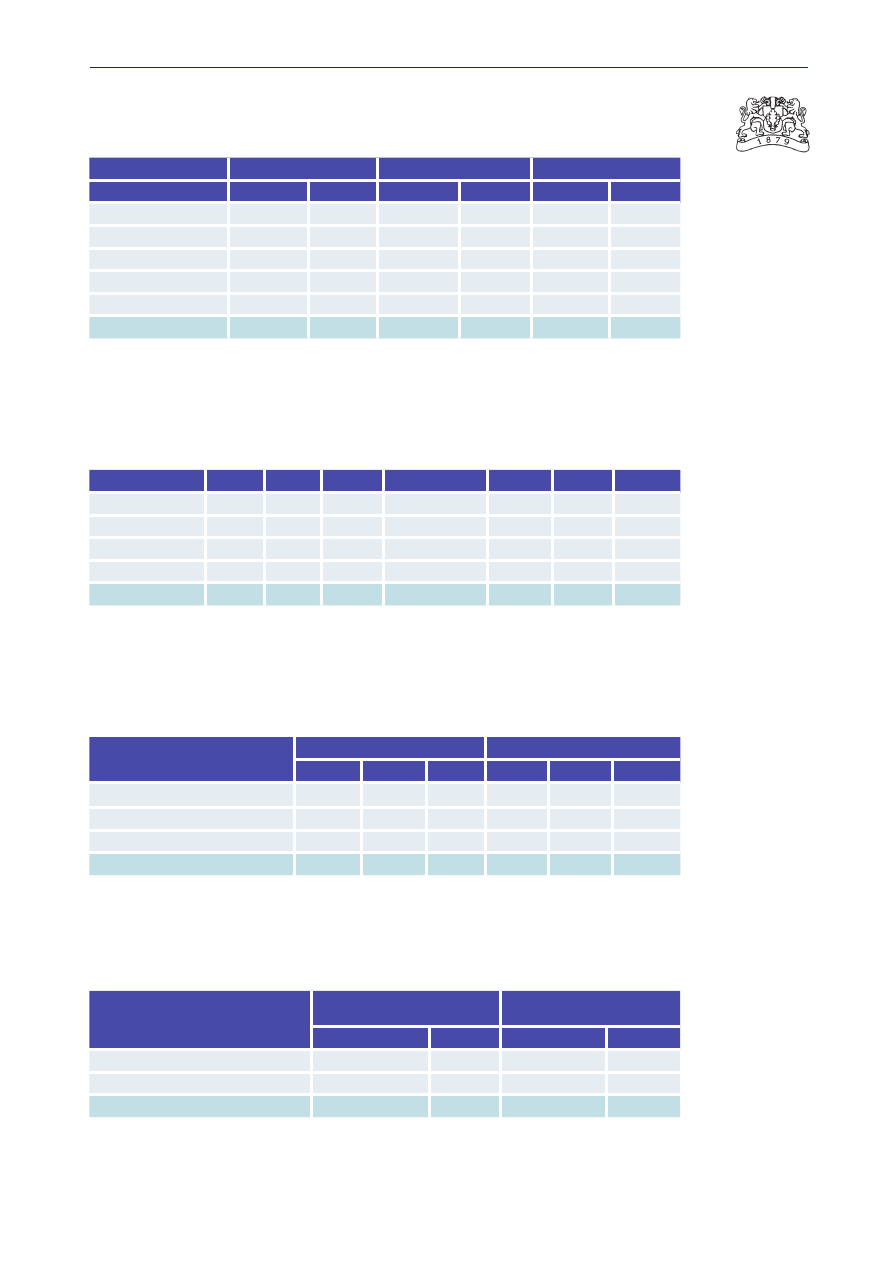
43
The structure of deposits and claims on sectors (%)
(at year-ends)
Item
2002
2003
2004
Deposits
Claims
Deposits
Claims
Deposits
Claims
Households
47.7
9.2
47.3
19.1
41.2
22.2
Government sector
3.5
13.8
6.6
0.2
4.7
0.1
Corporate
38.8
44.8
35.8
56.9
32.1
51.8
Foreign
8.7
26.4
10.3
16.1
22.0
15.8
Other
1.3
5.8
0.0
7.7
0.0
10.1
Total
100.0
100.0
100.0
100.0
100.0
100.0
The structure of deposits and loans by maturity (%)
(at year-ends)
Deposits
2002
2003
2004
Claims
2002
2003
2004
At sight
47.1
47.0
46.5
Short term
65.7
52.0
52.6
Within one year
48.5
44.0
42.6
Medium term
30.3
35.7
30.5
Over one year
4.4
8.9
10.9
Long term
3.8
12.2
16.8
Other
0.2
0.1
0.1
Total
100.0
100.0
100.0
Total
100.0
100.0
100.0
Proportion of foreign exchange assets and liabilities of banks (%)
(at year-ends)
Type of banks
FOREX assets/total assets
FOREX liabilities/total liab.
2002
2003
2004
2002
2003
2004
Large banks
51.5
45.8
50.8
53.4
47.8
56.4
Small and medium-sized banks
56.5
51.7
54.6
57.8
56.1
58.6
Foreign bank branches
65.6
53.9
40.4
67.2
36.8
41.2
Banks, average
54.9
49.4
51.6
56.6
51.7
56.0
Structure of registered capital and own funds of banks in 2004
Type of Banks
Registered capital /
Total assets
Own funds / Total liab.
EUR in thous.
%
EUR in thous.
%
Large banks
224,332
3.4
805,573
13.8
Small and medium-sized banks
301,488
5.0
591,368
10.8
Banks, average
525,820
4.1
1,396,940
12.3
2004 DEVELOPMENTS IN THE BULGARIAN BANKING SYSTEM
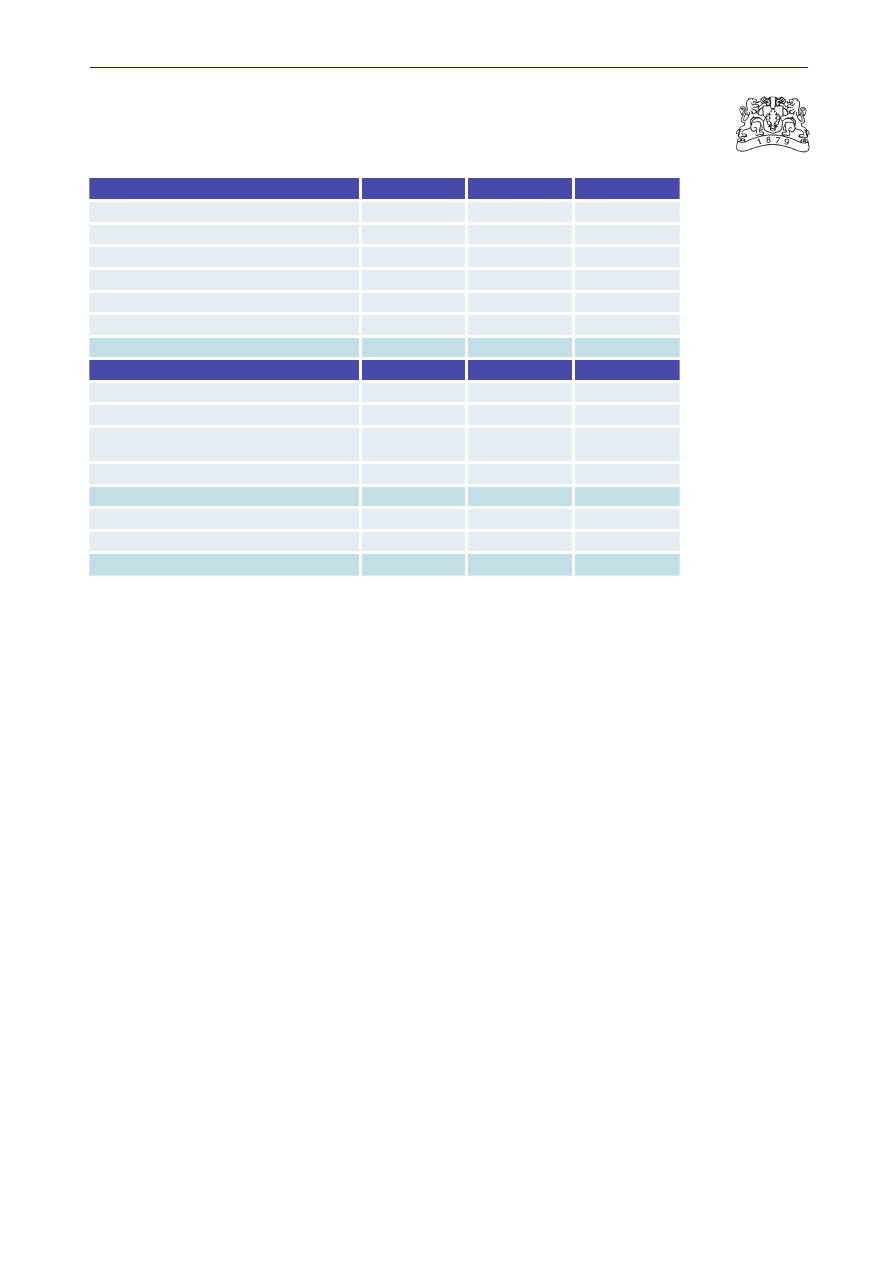
44
Structure of revenues and expenditure of banks
(at year-ends)
BGN millions
Revenues
2002
2003
2004
Interest earned
740
1,015
1,408
Net income from fees and commissions
238
264
332
Securities income/loss (net)
148
60
89
Forex operations income/loss ( net)
41
34
40
Other banking operations revenues
0
60
44
Extraordinary revenues/expenses ( net)
11
8
10
Total revenues
1,178
1,441
1,923
Expenses
Interest paid
218
261
365
General operating costs
602
721
892
Reserve and provisions creation/
reintegration (net)
12
43
143
Other operating costs
Total expenses
820
982
1,257
Pre-tax profit
346
416
523
Taxes
84
97
102
Net profit
262
319
421
2004 DEVELOPMENTS IN THE BULGARIAN BANKING SYSTEM

45
2004 DEVELOPMENTS IN THE
CROATIAN BANKING SYSTEM
MACROECONOMIC ENVIRONMENT
In Croatia, the year 2004 saw economic growth and low inflation. Real GDP
grew at a rate of 3.8%, which was a relatively lower growth rate than the 4.3%
GDP growth rate registered in 2003. The average inflation rate went up from
1.8% in 2003 to 2.1% in 2004. In addition to a slowdown in the growth of invest-
ments this lower growth rate of real GDP was influenced by a mild slowdown in
the growth of personal and government consumption. Fixed capital formation
slowed down in 2004, while capital investments grew by 4.4% in real terms,
down 12.4 percentage points as compared to 2003. Despite stronger growth of
foreign sources of finance private investments also slowed down. The slowdown
in the growth of investments also contributed to the slowdown in the growth
of total imports in 2004. Exports of goods and services also grew at a slower
rate, however, still faster than imports, which contributed towards redressing
the imbalance in international trade. The average rate of administrative un-
employment totalled 18.5%, i.e. 0.2 percentage points less than at the end of
2003, while the average real salary grew by 3.8% in 2004. The average daily ex-
change rate of the kuna against the euro grew nominally by 0.9% as compared
to 2003. The long-term appreciation trend of the nominal kuna exchange rate
against the dollar continued through 2004, when the the kuna strengthened
7.9% against the dollar. At the end of 2004, external debt totalled 82.1% of GDP,
largely due to the inflow of foreign capital. As a result, in 2004 the CNB policy
was directed at limiting external debt growth by discouraging the borrowing of
domestic commercial banks abroad. Banks’ external debt amounted to 33.7% of
the total external debt of the overall economy. The balance of payments deficit
reduced by 1.2 percentage points as compared to 2003 and in 2004 amounted
to 4.6% of GDP. In 2004, exports of goods totalled EUR 6.5bn and imports of
goods EUR 13.3 bn.
BANKING SYSTEM
At the end of 2004, the banking system of the Republic of Croatia comprised
37 banking institutions and 4 housing savings banks, which is 4 less than at the
end of 2003. The total number of banks in 2004 reduced as a consequence of
the decrease in the number of banks in majority foreign ownership. The reason
for this is to be found in the continuation of the consolidation process in the
banking system and merger of banks with their parent banks. The number of
banks in total or majority private ownership of domestic shareholders did not
change in 2004. At the end of the year, total assets of banks and housing savings
banks stood at HRK 234.7bn or 110.7% of GDP. As a result of the rise in assets

46
of individual banks in majority or total foreign ownership their share in total
bank assets went up in 2004 to 91.3% as compared to 2003. The remaining 8.7%
of total bank assets were made up by the assets of two banks in domestic state
ownership and the assets of 20 banks in domestic private ownership. In 2004,
the largest number of banks was owned by Italian shareholders (7 banks), six
banks were owned by Austrian shareholders, while one was owned by German
shareholders and one by shareholders from Great Britain.
The banking system was dominated by six largest banks in majority foreign
ownership, including the two largest banks, which at group level account for
43.9% of total banking system assets.
Total bank assets increased by 12.3% on 2003. This was largely influenced
by the growth of net loans, up 14.2% on 2003. Loans accounted for the largest
share (54,6%) in the asset structure at end-2003, up 0.8 percentage points on
a year earlier. As over the previous years, in 2004 banks continued intensify-
ing their activities in the segment of household lending, which led to household
loans accounting for one half of the loans in the structure of total approved
loans, while all other sectors together accounted for the remaining half. To fi-
nance this growth banks used funds collected through an increase in deposits
and received loans. Deposits predominated in the bank liability structure at
the end of 2004 with a share of 67.7%, rising at a rate of 8.1% as compared to
2003. As over the previous years, the majority of deposits were denominated
in foreign currency (67.2%). The share of loans received from financial institu-
tions and other loans increased from 15.8% at the end of 2003 to 17.4% at the
end of 2004. The lion’s share of total loans was received from foreign financial
institutions (75.5%), largely from parent banks.
At end-2004, banks’ regulatory capital totalled HRK 21.1bn, up 9.6% as
compared to end-2003 when it stood at HRK 19.3bn. Bank capital adequacy
ratio reduced from 16.2% at end-2003 to 15.3% at end-2004. All banks posted
capital adequacy ratios at levels exceeding the minimum statutory limit of 10%.
The reason for the reduction of capital adequacy ratio is the faster growth of
risk weighted assets over regulatory capital. In addition, the decline in capital
adequacy ratio was also influenced by the implementation of the Decision on
the Capital Adequacy of Banks, as a result of which exposure to currency risk,
position risk, settlement/counterparty risk and risk of exceeding the permissible
exposure limit are included in the calculation of the capital adequacy ratio.
Total placements and contingent liabilities went up 14.8% as compared to
2003. Increase in borrowing combined with quality new debtors and adequate
instruments of collateral contributed to the increase of fully recoverable place-
ments (group A), which increased by 19.33% as compared to 2003 and accounted
fro 95.4% of total placements. The share of total bad placements (groups B and
C) in total gross placements amounted to 4.6%, the lowest ratio in the past three
years. Total value impairments and provisions for contingent liabilities, which
include provisions for unidentified losses, went up 3.5% on 2003. However,
resulting from the increased rate of growth of placements and contingent
liabilities and better quality of positions exposed to credit risk, their share in
total placements fell from 4.1% in 2003 to 3.7% in 2004.
In 2004, banks generated profits 21.2% higher than in 2003, which pushed up
the profitability indicators, that is, the rate of return on average assets (ROAA)
2004 DEVELOPMENTS IN THE CROATIAN BANKING SYSTEM

47
and the rate of return on average equity (ROAE). ROAA went up from 1.6%
at the end of 2003 to 1.7% at the end of 2004, while ROAE rose from 14.5%
to 16.1%. The largest contribution to the increase in profits came from net
non-interest income which went up 31.3% on 2003, while net interest income
increased by 2%.
The banking system was liquid in 2004, with banks having no problems in
servicing their obligations. The ratio of total deposits to approved loans increased
from 76.6% at the end of 2003 to 80.7% at the end of 2004. Total received loans
increased by 23.7% in 2004 as compared to 2003. Since their growth outstripped
the growth of assets, the ratio of received loans to total assets increased from
15.8% at end-2003 to 17.4% at end-2004.
THE LEGAL AND INSTITUTIONAL FRAMEWORKS OF
THE OPERATION AND SUPERVISION OF FINANCIAL
INSTITUTIONS AND
LEGAL COMPETENCE OF THE
BANKING SUPERVISORY AUTHORITY
The financial sector of the Republic of Croatia consists of banks, housing savings
banks, insurance companies, investment funds, leasing companies and savings
and loan associations. The Croatian National Bank is authorised to supervise
the operations of banks and housing savings banks. The Croatian Securities
Commission is authorised to supervise the operations of the securities market,
while the operations of insurance companies are supervised by the Directorate
for Supervision of Insurance Companies. The Agency for Supervision of Pension
Funds and Insurance supervises the operations of pension funds, while the
Ministry of Finance of the Republic of Croatia supervises the operations of
savings and loans associations.
The Croatian National Bank supervises the operations of banks and hous-
ing savings banks pursuant to the Croatian National Bank Act and the Banking
Act. In accordance with the Banking Act, in force since 2002, bank supervi-
sion encompasses the entry of banks into the market, their operations and exit
from the market, definition of responsibilities of their owners for banks’ opera-
tions, definition of ways to manage risks as well as consolidated supervision
of banks, consumer protection, protection of the employees of the Croatian
National Bank who carry out the supervision of banks as well as cooperation with
other supervisory bodies in the country and abroad. New subordinate legislation
has been issued in line with the Banking Act and has been applied as from the
beginning of 2004. It is aimed at regulating the exposure of banks to different
types of risk, bank reporting requirements as well as regulating terms and con-
ditions for providing banking and other financial services. The starting point
for the creation of this regulation was to harmonise Croatian regulation with EU
guidelines, Basel Committee Recommendations and International Accounting
Standards (IAS 32 and IAS 39).
2004 DEVELOPMENTS IN THE CROATIAN BANKING SYSTEM

48
MAIN STRATEGIC OBJECTIVES OF THE BANKING
SUPERVISORY AUTHORITY
The most important strategic objective of the Prudential Regulation and Bank
Supervision Area in the forthcoming period is the implementation of Basel II
into Croatian regulations. To this aim a special working group has been formed
within the Area. In addition, new subordinate legislation is to be passed, aimed
at regulating the work of institutions issuing electronic money. Regulations are
to be harmonised with EU guidelines as regards the winding-up proceedings
of banks and work is expected to start on the passing of legislation which will
regulate the supervision of financial conglomerates.
THE ACTIVITIES OF THE BANKING SUPERVISORY
AUTHORITY IN 2004
The Republic of Croatia adopted the National Programme for the Integration
of the Republic of Croatia into the European Union. The Prudential Regulation
and Bank Supervision Area of the Croatian National Bank has participated in
the creation of the part relating to harmonisation of Croatian legislation with
acquis communautaire in the segment of banking since the programme’s incep-
tion in 2002. The tasks of the CNB in this part of the National programme were
related to adoption of EU’s legal norms and harmonisation of regulation. As a
result, in addition to the Banking Act subordinate legislation was passed and has
been applied as of 1 January 2004. In accordance with the need to strengthen
the supervision function of the Croatian National Bank in line with the Basel
principles for effective banking supervision and EU requirements, in the first
quarter of 2004 efforts were invested in implementing the new organisation of
the Prudential Regulation and Bank Supervision Area.
ORGANISATIONAL CHART OF THE BANKING
SUPERVISORY AUTHORITY
Prudential Regulation and Bank Supervision Area of the Croatian National
Bank is responsible for enactment and harmonisation of prudential regulation
international supervisory standards, for analysis of financial reports and data
of individual banks, on-site supervision of the operations of banks, subsidiar-
ies and representative offices of foreign banks in the Republic of Croatia, data
and indicator analysis and preparation of standard reports at banking system
level. In addition, Prudential Regulation and Bank Supervision Area of the
Croatian National Bank is responsible for licensing and protection of market
competition. The new organisation of the Area entered into force on 1 April 2004
and is aimed at intensifying its business activity, increasing the efficiency and
quality of performed tasks as well as increasing the level of specialist knowledge
of its employees.
2004 DEVELOPMENTS IN THE CROATIAN BANKING SYSTEM

49
The organisational chart of the Prudential Regulation and Bank Supervision
Area of the Croatian National Bank is as follows:
Prudential Regulation and Banking System Analysis Department
is responsible for drafting legislative documents and subordinate legislation,
harmonising the existing legislation in accordance with international standards
and monitoring EU regulations on an on-going basis and giving proposals for
harmonisation of Croatian legislation with EU legislation in the area of bank-
ing. It is also responsible for analysing banking system data in the Republic of
Croatia and preparing the Banks’ Bulletin, a regular CNB publication, as well
as other reports for central bank needs.
In addition to its on-site bank supervision function, the Off-Site Supervision
Department is also responsible for on-going supervision of banks on the
basis of supervisory reports submitted by banks to the Croatian National Bank
pursuant to the Banking Act and relevant subordinate legislation.
On-site supervision is the responsibility of the Risk Management On-
Site Supervision Department and Specialised On-Site Supervision
Department. The Risk Management On-Site Supervision Department pro-
vides for strict specialization of employees in terms of specific risks: market
2004 DEVELOPMENTS IN THE CROATIAN BANKING SYSTEM
PRUDENTIAL REGULATION AND BANK SUPERVISION AREA
Off-Site
Supervision
Department
Prudential
Regulation
and Banking
System Analysis
Department
On-Site Risk
Management
Supervision
Department
Licensing
and Market
Competition
Department
Specialised
On-Site
Supervision
Department
Vicegovernor
Prudential
Regulation
Division
Banking
System
Analysis
Division
Market and
Liquidity Risk
Management
Supervision
Division
Credit Risk
Management
Supervision
Division
Internal
Control
Systems
Supervision
Division
Information
Systems
Supervision
Division
Licensing
Division
Market
Competition
Division
Monetary and
Foreign Exchange
Policy Measures
Implementation
Supervision
Division

50
risk, liquidity risk, interest rate risk, currency risk, operational risk and other
risks. The Specialised On-Site Supervision Department performs on-site super-
vision of IT systems in banks, internal control systems, regulatory compliance,
in particular supervision of the implementation of measures of monetary and
foreign exchange policies and observance of legislative and other provisions,
internal procedures and payment system procedures.
The Licensing and Market Competition Department is responsi-
ble for the preparation and processing of applications for authorisations and
approvals as prescribed by the Banking Act, The Building Societies and Relevant
Government Incentives Act and the National Payment System Act. Since 2002
Banking Act, the CNB’s functions and activities also include the protection of
free market competition in the banking sector, the responsibility for which has
been entrusted to the Licensing and Market Competition Department. Original
competence of the Croatian National Bank in this area covers the prevention of
illicit agreements, anti-cartel action, prevention of misuse of dominant market
position and concentrations control.
INTERNATIONAL ACTIVITIES OF THE BANKING
SUPERVISORY AUTHORITY AND CO-OPERATION WITH
OTHER SUPERVISORY BODIES
In October 2004, the Government of the Republic of Croatia adopted the
Decision on the procedure of integration of supervisory institutions in the non-
banking financial sector into one unique independent institution accountable
to the Government and the Parliament of the Republic of Croatia. All super-
visory authorities in the Republic of Croatia (the CNB, the Croatian Securities
Commission, the Directorate for Supervision of Insurance Companies, the
Agency for Supervision of Pension Funds and Insurance) agreed on and adopt-
ed the Programme for Supervision of Financial Institutions and the Financial
Market on the Consolidated Basis, so initial efforts towards their integration
have been made. However, this does not include bank supervision which will
remain within the responsibility of the CNB. The Government intends to issue
draft legislation aimed at integrating non-banking supervisory institutions,
which falls within the scope of the responsibility of the Ministry of Finance.
In 2004, the CNB continued efforts directed at establishing co-operation with
supervisory authorities of banks owning Croatian banks as well as banks owned
by Croatian banks. In addition to the Memorandum of Understanding and
Co-operation in Banking Supervision being signed with the agency responsible
for bank supervision in Bosnia and Herzegovina in 2003, positions on future
co-operation with authorities responsible for bank supervision in Austria and
Italy were harmonised in 2004.
2004 DEVELOPMENTS IN THE CROATIAN BANKING SYSTEM

51
STATISTICAL TABLES
Number of financial institutions
(at year-ends)
Type of financial institution
2002
2003
2004
Banks
46
41
37
Housing savings banks
4
4
4
Financial institutions, total
50
45
41
Ownership structure of the financial institutions
on the basis of registered capital (%)
(at year-ends)
Item
2002
2003
2004
Public sector ownership
8.0
7.7
7.6
Other domestic ownership
13.7
13.5
13.6
Domestic ownership total
21.7
21.2
21.2
Foreign ownership
78.3
78.8
78.8
Financial institutions, total
100.0
100.0
100.0
Ownership structure of financial institutions on the basis of assets total (%)
(at year end)
Item
2002
2003
2004
Public sector ownership
4.0
3.3
3.0
Other domestic ownership
5.8
5.5
5.5
Domestic ownership total
9.7
8.8
8.5
Foreign ownership
90.3
91.2
91.5
Financial Institutions, total
100.0
100.0
100.0
Concentration of asset by the type of financial institution (%)
Type of institution
The first three largest
The first five largest
Banks
54.3
74.3
Housing savings banks
92.6
100.0
Return on asset (ROA) by type of financial institution*
Type of institution
2002
2003
2004
Banks
1.58
1.59
1.68
Housing savings banks
1.55
-0.32
0.32
* ROAA
2004 DEVELOPMENTS IN THE CROATIAN BANKING SYSTEM

52
Return on equity (ROE) by type of financial institutions*
Type of institution
2002
2003
2004
Banks
13.74
14.46
16.05
Housing savings banks
21.55
-6.39
7.37
* ROAE
Distribution of market shares in balance sheet total (%)
Type of institution
2002
2003
2004
Banks
98.76
98.30
97.72
Housing savings banks
1.2
1.7
2.3
Financial institutions, total
100.0
100.0
100.0
Development of off-balance sheet activities (%)
(off balance sheet items/ balance sheet total)
Type of financial institution
2002
2003
2004
Banks
14.6
12.8
13.7
Savings banks
0.2
0.3
0.2
Financial institutions, total
14.4
12.6
13.4
Solvency ratio of financial institutions*
Type of the financial institution
2002
2003
2004
Banks
17.2
16.2
15.3
Savings banks
34.2
31.0
27.7
Financial institutions, average
17.2
16.3
15.4
* Capital adequacy ratio
Asset portfolio quality of the banking system
Asset Classification
2002
2003
2004
1. Fully recoverable placements (category A)
94.1
94.1
94.9
2. Partly recoverable placements (category B)
3.5
3.5
3.5
3. Irrecoverable placements (category C)
2.3
2.3
1.6
Classified total
100.0
100.0
100.0
Specific Reserves*
5.0
4.1
3.7
*specific reserves / classified total
2004 DEVELOPMENTS IN THE CROATIAN BANKING SYSTEM
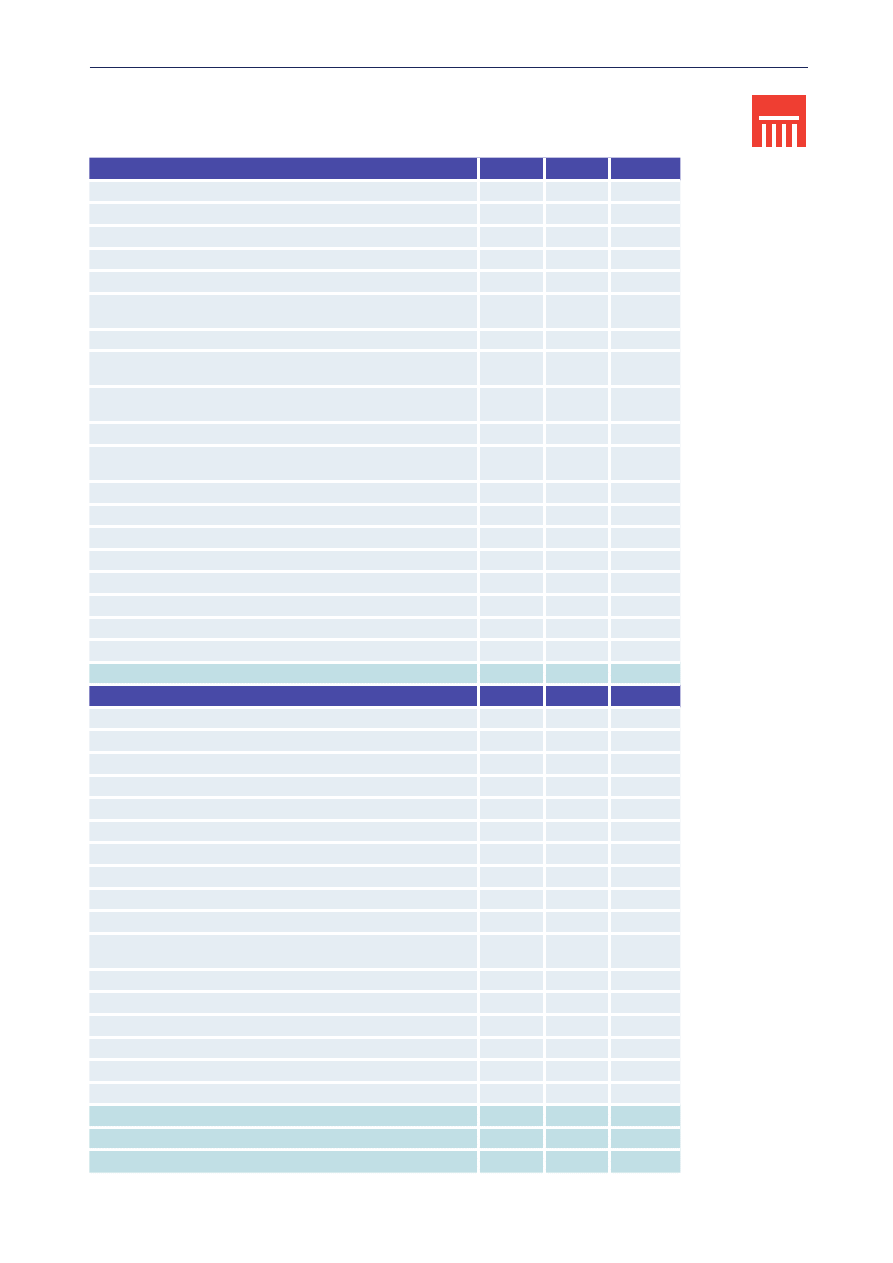
53
The structure of assets and liabilities of the banking system (%)
(at year end)
ASSETS
2002
2003
2004
1. Money assets and deposits with the CNB
12.3
13.7
15.2
1.1. Money assets
1.3
1.4
1.3
1.2. Deposits with the CNB
11.0
12.3
13.9
2. Deposits with banking institutions
11.6
15.3
14.5
3. MoF treasury bills and CNB bills
5.8
3.8
1.6
4. Securities and other financial instruments held for trading
and available for sale
5.2
3.8
7.2
4.1. Securities and other financial instruments held for trading
0.0
0.0
2.9
4.2. Securities and other financial instruments available for
sale
0.0
0.0
4.3
5. Securities and other financial instruments held to maturity
and bought on issue directly from the issuer
7.2
5.3
3.3
5.1. Securities and other financial instruments held to maturity
0.0
0.0
2.9
5.2. Securities and other financial instruments bought on
issue directly from the issuer
0.0
0.0
0.4
6. Derivative financial assets
0.0
0.0
0.1
7. Loans to financial institutions
1.2
1.5
1.4
8. Loans to other clients
51.5
52.3
53.2
9. Investments in subsidiaries and associates
1.4
1.2
0.7
10. Foreclosed and repossessed assets
0.2
0.2
0.2
11. Tangible assets (net of depreciation)
2.2
2.0
1.7
12. Interest, fees and other assets
2.3
1.8
1.9
13. Net of: Specific reserves for unidentified losses
-0.9
-0.9
-0.9
Total assets
100.0
100.0
100.0
LIABILITIES
2002
2003
2004
1. Loans from financial institutions
2.3
3.5
3.7
1.1. Short-term loans
0.7
1.8
1.6
1.2. Long-term loans
1.7
1.7
2.1
2. Deposits
71.5
70.4
67.7
2.1. Giro account and current account deposits
13.4
12.4
11.1
2.2. Savings deposits
13.8
12.1
11.0
2.3. Time deposits
44.3
45.9
45.6
3. Other loans
11.2
12.3
13.7
3.1. Short-term loans
2.6
1.7
2.3
3.2. Long-term loans
8.6
10.6
11.4
4. Derivative financial liabilities and other financial liabilities
held for trading
0.0
0.0
0.1
5. Debt securities issued
0.0
0.0
1.5
5.1. Short-term debt securities issued
0.0
0.0
0.0
5.2. Long-term debt securities issued
0.0
0.0
1.5
6. Subordinated instruments issued
0.4
0.4
0.4
7. Hybrid instruments issued
1.3
1.1
0.7
8. Interest, fees and other liabilities
3.8
3.4
3.6
Total liabilities
90.5
91.1
91.4
Total capital
9.5
8.9
8.6
Total liabilities and capital
100.0
100.0
100.0
2004 DEVELOPMENTS IN THE CROATIAN BANKING SYSTEM

54
2004 DEVELOPMENTS IN THE CROATIAN BANKING SYSTEM
The Structure of Deposits and Loans in 2004 (%)
(at year-end)
Deposits
Loans
Households
56.0
50.0
Government sector
2.4
7.2
Corporate
21.3
39.6
Foreign
15.9
0.2
Other*
4.4
2.9
Total
100.0
100.0
* Financial sector is included
The structure of deposits and loans in 2004 (%)
(at year-end)
Maturity of deposits
Loans
At sight
16.5
Long term loans
68.4
Within one year*
58.3
Medium-term loans
19.9
Over one year
25.2
Short-term loans
11.6
Total
100.0
Total
100.0
* Total savings deposits are included
Proportion of foreign exchange assets and liabilities
(at year-ends)
Type of the financial
institutions
FOREX assets /
Total assets
FOREX liabilities /
Total liabilities
2002
2003
2004
2002
2003
2004
Banks
28.8
30.4
31.3
64.8
61.8
61.9
* fx off balance sheet items /
total liabilities
6.0
6.6
4.1
Housing savings banks
1.6
4.5
3.6
6.5
0.0
0.1
* fx off balance sheet items /
total liabilities
0.0
0.0
0.0
Financial institutions, average
28.5
30.0
30.6
64.1
60.7
60.5
Structure of registered capital and own funds of financial institutions in 2004
Type of the financial
institutions
Registered
capital
/Total
assets
Own
funds
/Total liab.
EUR*
%
EUR*
%
Banks
2,566
8.6
27,326
91.4
Housing savings banks
20
2.9
677
97.1
Financial institutions, average
2,586
8.5
28,003
91.5
* in millions of EUR

55
Structure of revenues and expenditures of financial institutions (%)
(at year-ends)
Revenues
2002
2003
2004
Interest income
70.8
71.1
70.5
Non-interest income
29.2
28.9
29.5
Expenditures
2002
2003
2004
Interest expense
40.5
38.2
41.0
Non-interest expense
16.8
18.5
15.7
General and administrative expenses
38.5
38.6
38.6
Provisions for identified and unidentified losses
4.2
4.7
4.7
2004 DEVELOPMENTS IN THE CROATIAN BANKING SYSTEM

56
2004 DEVELOPMENTS IN THE CZECH
BANKING SYSTEM
MACROECONOMIC ENVIRONMENT IN THE CZECH
REPUBLIC
The year 2004 saw continuing economic growth. The rate of growth of gross
domestic product was 4.0% in 2004 at constant prices. As at December 2004
gross domestic product totalled CZK 2,751.1 billion at nominal prices. Economic
growth was driven mainly by investment, whereas the influence of consumer
demand, which dominated in the previous year, declined. In the second half of
2004, growth was also supported by buoyant exports.
The inflation rate (the increase in the average annual CPI) reached 2.8% at
the end of 2004 compared to the very low level of 0.1% one year earlier.
The nominal exchange rate of the koruna continued to appreciate against
the dollar, from an annual average of CZK 28.23 in 2003 to CZK 25.70 in 2004.
The koruna’s annual average exchange rate against the euro in 2004 was CZK
31.90, which is roughly the same as in 2003. The stronger koruna made imports
cheaper, especially in the case of goods paid for in dollars (most notably energy-
producing materials). It thus helped to dampen the effects of high raw material
prices on world markets and maintain a low level of inflation.
The average unemployment rate was 10.3% in 2004, which is the same fig-
ure as in 2003. The unemployment rate according to Eurostat methodology
was 8.3% at the end of December 2004. The average nominal wage increased
by 6.6% in 2004 and the average real wage by 3.7% in the same period.
DEVELOPMENTS IN THE BANKING SYSTEM
As of 31 December 2004, 35 banks and foreign bank branches were active in the
Czech Republic, the same number as at the end of 2003. All nine foreign bank
branches active in the Czech Republic automatically switched to the single licence
regime. In addition, many foreign banks registered for cross-border provision of
services in the Czech Republic under the single licence (i.e. without establishing
a branch). As of 31 December 2004, there were 63 such entities.
As of 31 December 2004, foreign entities held an 83.1% share in the total
equity capital of the sector, a decrease of 1.8 points from a year earlier, and
controlled 96.1% of the total assets of the sector. In only four banks, two of which
are state-owned banks supporting government policies, do Czech owners have
a majority share in the equity capital now.
During 2004, the number of bank employees continued to decline. At the
end of 2004, there were 38,160 people working in the Czech banking sector,
2.2% less than a year earlier. The number of banking units was 1,785, a 6.9%

57
increase compared with a year earlier (mainly due to the opening of small
kiosks providing basic services).
As of 31 December 2004, banking assets stood at CZK 2,635.6 billion, 4.3%
more than a year before. This was due mainly to an annual increase in loans
provided (of CZK 77 billion) and higher receivables from banks. The increase
in loans provided was due to continuing growth in loans to households, which
increased by 34.4% in 2004, as well as to an expansion of loans to corporations
of 7.5%. The share of loans in banks’ assets reached almost 41% at the end of
2004. The ratio of total assets to GDP at current prices was 0.96 at the year
end. The group of four large banks accounted for 59.8% of the banking sector’s
assets, 2.3 points less than a year before.
The year 2004 saw a continuing reduction in the volume of non-performing
loans, which dropped by CZK 5.1 billion to CZK 44.5 billion, or 4% of total loans
provided (compared to 4.9% a year before). The coverage of classified loans by
provisions and high-quality collateral is sufficient.
The regulatory capital used to calculate capital adequacy grew by CZK 4.3
billion to CZK 148 billion. However, there was an increase in the volume of
risk-weighted assets and capital charges, connected with the growth in loans
provided, which resulted in the capital ratio falling from 14.5% to 12.6% year
on year. The banking sector recorded a net profit of CZK 32.9 billion in 2004,
up by CZK 2.7 billion on 2003. Return on Tier 1 capital reached 23.35% and
return on assets was 1.26%.
Detailed information on developments in the banking sector and supervisory
activities is published in the CNB’s annual Banking Supervision publications,
which are available, together with other analytical publications and the latest
banking sector indicators, at http://www.cnb.cz/en/bd_bsindex.php.
THE LEGAL AND INSTITUTIONAL FRAMEWORK OF
THE OPERATION AND SUPERVISION OF BANKING
INSTITUTIONS
LEGAL COMPETENCE OF THE BANKING SUPERVISORY
AUTHORITY IN THE CZECH REPUBLIC
There are four regulatory bodies in the Czech Republic. The Czech National
Bank’s banking supervisory authority (CNB Banking Supervision) is responsible
for the stability of the banking sector, including building societies. The Czech
Securities Commission supervises investment companies and investment funds.
The Ministry of Finance of the Czech Republic is the surveillance body for in-
surance companies and pension funds. The Credit Union Supervisory Authority
regulates credit unions. In accordance with a government decision, a two-step
process will take place to integrate the supervisory authorities within the next
five years (see below).
The harmonisation of five pieces of legislation governing and/or related to
banking business with EU legislation came into effect in 2004 (the Act on Banks,
the Capital Market Undertakings Act, the Act on Bonds, the Act on Collective
Investment and the Anti-Money Laundering Act):
2004
DEVELOPMENTS IN THE CZECH BANKING SYSTEM

58
• in the Act on Banks, provisions on the single licence and on the duty of
banks to introduce effective systems for discharging clients’ claims came
into effect;
• in the Act on Collective Investment, certain provisions were introduced
with the aim of reducing the regulatory burden on banks that are simul-
taneously securities brokers/dealers. Under the Act, banks that are bro-
ker/dealers are obliged to contribute to the Guarantee Fund for securities
brokers/dealers;
• the most important change in the Act on Bonds was that real estate in
pledge covering a mortgage credit may be situated not only on the terri-
tory of the Czech Republic, but also in any EU Member State. The law also
sets out principles for real estate pricing;
• a new provision was inserted into the Act on Collective Investment setting
rules for banks with a depository function;
• on 1 September 2004 a broad harmonisation amendment to the Anti-
Money Laundering Act came into effect, introducing an amended defini-
tion of suspicious transactions with regard to terrorist financing and the
duty of the regulated institutions to set “know your customer” rules.
In addition to the above changes the Czech National Bank issued the follow-
ing new provisions (N) and amended some existing provisions (A):
• on the internal control system of a bank, which specifies requirements for
the management of credit risk, market risk, operational risk and liquidity
risk; most of the requirements were transferred from previous provisions.
The requirements for internal audit, management of operational risk and
information systems, which are new, came into effect on 3 February 2004
(A);
• stipulating rules for assessment of financial receivables and creation of
provisions and reserves, and rules for the acquisition of certain types of
assets; this was amended to reflect the introduction of IFRS in banks and
introduce the new option of asset portfolio provisioning (A);
• stipulating the content, method of keeping and requisites of the records
of coverage of mortgage bonds in circulation (N).
A survey of the valid provisions, degrees and official announcements in the
field of prudential supervision can be found at http://www.cnb.cz/en/leg_
bd.php.
MAIN STRATEGIC OBJECTIVES OF THE SUPERVISORY
AUTHORITY IN 2004
In 2004, the CNB continued implementing its medium-term banking supervi-
sion plan for the period 2002–2004. This was based on the principles set by the
Basel Committee on Banking Supervision and the recommendations ensuing
from the assessment programmes of international institutions (e.g. the IMF and
WB Financial Sector Assessment Program and the missions of the European
Commission). The main tasks of this plan for 2004 were as follows:
2004
DEVELOPMENTS IN THE CZECH BANKING SYSTEM

59
• to intensify supervision on a consolidated basis,
• to intensify on-site inspections and to concentrate on the risks generated
by new banking products,
• to enhance the knowledge of supervisory staff in order to supervise indi-
vidual banks and consolidated groups more effectively according to their
risk profiles,
• to enhance the transparency of supervisory activities,
• to ensure a fast and efficient supervisory response to the deficiencies
identified,
• to enhance co-operation with domestic regulators and to eliminate
duplications in supervision,
• to complete regulatory provisions stipulating the requirements for the
management of banking risks,
• to determine regulatory requirements for anti-money-laundering and
anti-terrorism-financing procedures in banks,
• to enhance co-operation with foreign supervisory authorities.
Besides the realisation of these strategic objectives, many of which are long
term in nature, measures were undertaken relating to accession to the EU
(especially implementation of the single licence concept) and the New Basel
Capital Accord.
In 2004, a new medium-term banking supervision plan for the period 2005–
2010 was approved. This emphasises preparation for the New Basel Capital
Accord, enhancement of co-operation with domestic and foreign supervisory
bodies, preparation for the integration of the domestic supervisory authorities,
and greater transparency of supervisory activities.
THE ACTIVITIES OF THE BANKING SUPERVISORY
AUTHORITY IN 2004
In May 2004, when the Czech Republic entered EU, the single licence came into
force. The responsibilities of home and host supervisor were newly defined. The
CNB’s banking supervision competences have been reduced. Nine foreign bank
branches have been under supervision by the supervisors of their country of
origin since May. From this point of view the CNB has been responsible for the
issue of liquidity and some duties arising under the Act on Banks. Notification
of monitoring of foreign banking institutions providing cross-border banking
activities under the single licence principle started to be a part of supervision.
In 2004, 63 foreign banks from EU member states announced their intention
to provide banking activities in the Czech Republic under the single licence.
Intensified co-operation with EU member state regulators is expected as a
result of the single licence principle.
The re-licensing of banks, launched at the end of 2002 in connection with the
process of harmonisation of the Act on Banks with the European banking direc-
tive, was completed in the first half of 2004 with the granting of banking licences
to the remaining 15 banks. In addition, 16 administrative decisions were issued
in the area of licensing and authorisation relating to banks’ applications for the
2004
DEVELOPMENTS IN THE CZECH BANKING SYSTEM

60
extension of licences, consent to acquire qualifying holdings in banks, prior
approvals for mergers, plans to establish a branch in an EU Member State, etc.
In 2004, CNB Banking Supervision undertook 15 on-site inspections in 15
banks. Four of them were full-scope inspections and 11 partial monitoring of
selected types of risks. The supervisors focused primarily on the systems used for
credit risk and market risk management, the prevention of money laundering,
the functionality and effectiveness of internal management and control systems
and the area of risks connected with information systems and technology.
INTERNATIONAL ACTIVITIES OF THE CZECH NATIONAL
BANK IN THE FIELD OF BANKING SUPERVISION
CNB Banking Supervision is involved in international co-operation in dif-
ferent ways, ranging from bilateral co-operation based on Memoranda of
Understanding (MoUs) with foreign regulators through to active participa-
tion in the work of international organisations. Collaboration with the work-
ing groups of the Bank for International Settlements and the committees and
working groups of the European Union, including the European Central Bank
and the European Commission, was extended in 2004.
Co-operation with regulators from six countries based on MoUs (with Austria,
Germany,
France, Belgium, Slovakia and the USA) continued successfully. New
MoUs with Italy and Netherlands were signed in 2004. The bilateral co-opera-
tion is closely linked with supervision on a consolidated basis and preparation
for the implementation of the future Capital Requirements Directive.
Czech National Bank representatives are members of the Committee of
European Banking Supervisors (CEBS) and the Banking Supervisory Committee
(BSC). A representative of the CNB has been working as a technical expert in
the European Banking Committee (EBC). Banking supervision employees have
been working actively in four expert groups/task forces established by the CEBS.
They have also contributed to the preparation of recommendations and stan-
dards developed by other expert groups by means of written comments. Czech
National Bank experts are members of the Working Group on Macro-pruden-
tial Analysis (WGMA) and the Working Group on Developments in Banking
(WGDB). Membership in the Credit Register Working Group is also envisaged
in the future.
The Czech Republic was involved in the preparation and implementation
of the New Basel Capital Accord in the Core Principles Liaison Group (CPLG)
and Working Group on Capital (WGC). This enabled us to share information
and express our opinions on the process. In 2004, the meetings focused on
several core aspects of the New Capital Concept, mainly national discretions
and home/host issues.
Co-operation with EU banking supervisory authorities continued in 2004.
This focused mainly on exchange of information about the financial situation
of parent banks and subsidiaries and experience with preparing for the imple-
mentation of the Capital Requirements Directive. The Czech National Bank’s
interest in co-operation is driven by the fact that it is almost exclusively in the
position of host supervisor. That is why we are striving for early establishment
2004
DEVELOPMENTS IN THE CZECH BANKING SYSTEM

61
of clear principles with home supervisors regarding our participation in model
approvals, validation and on-going supervision of the banks of EU groups with
a presence on the Czech banking market.
CO-OPERATION WITH OTHER SUPERVISORY BODIES IN
THE CZECH REPUBLIC
The three main supervisory bodies of the Czech financial sector, i.e. the Czech
National Bank, the Ministry of Finance of the Czech Republic and the Czech
Securities Commission, signed a tripartite Co-operation Agreement in 1998.
This was amended in 2003 with a view to promoting the smooth development
of supervision on a consolidated basis.
The purpose of the Agreement is to provide for more detailed specification,
harmonisation and greater efficiency with regard to the procedures applied
in the field of banking supervision and state supervision of the financial mar-
ket, so as to fulfil the statutory aims and duties in this field. The fundamental
aim of this Agreement is to ensure the implementation of analogous criteria
and procedures for supervision of the financial market, including licensing
procedures etc.
The parties to the Memorandum co-operate in carrying out supervision on a
solo and consolidated basis, particularly in the areas of licensing and granting
approvals, inspections, imposing remedial measures and sanctions, exchange
of information, regulation of the Czech financial market and procedures vis-à-
vis foreign entities supervising the financial market and international institu-
tions.
The committee of senior representatives of the parties involved met several
times during 2004. The core topic of the discussions was the issue of integra-
tion of supervisory institutions. First, the draft of the two-step government plan
for the establishment of a single regulator was discussed. After government
approval in May 2004, concrete steps were discussed for the unification of
supervision of banks and credit unions in the Czech National Bank on the one
hand, and supervision of insurance companies, pension funds and the securi-
ties market in the Czech Securities Commission (in future to be known as the
Financial Market Commission) on the other hand. After the first step of the in-
tegration process has been completed (1 January 2006), there will be two super-
visory authorities on the Czech financial market. Full integration of supervision
within a single institution is planned for about 2010. What kind of institution
it will be is still an open issue.
The plan of work in the five joint working groups established under the
Agreement (licensing, ongoing supervision, accounting and disclosure,
conglomerates and data exchange) was revised. The youngest joint working
group – that on exchange of information on financial sector indicators – focused
on developing the definitions and scope of the financial indicators needed for
evaluating financial stability.
Co-operation also continues with professional organisations active in the
domestic banking sector. At present the Czech National Bank is working with
the Czech Banking Association and the Czech Chamber of Auditors. At the
2004
DEVELOPMENTS IN THE CZECH BANKING SYSTEM

62
moment, close attention is being paid to the New Basel Capital Accord, which
is expected to be introduced in 2006.
OTHER RELEVANT INFORMATION AND DEVELOPMENTS
IN THE COURSE OF LAST YEAR
Consultations with experts from the World Bank and IMF and the Czech
National Bank took place in 2004 as part of two assessment projects: Corporate
Governance in Banking and Insolvency of Banks. In the first project, the Czech
Republic offered to test the World Bank’s new assessment methodology. Both
assessments were completed in April 2005.
An update of the FSAP assessment was performed in 2004. The results
showed that CNB Banking Supervision is largely compliant with all the relevant
criteria. There were only minor recommendations for improvement.
The Central Register of Credits, run by the Czech National Bank, has been
offering its services to banks and branches of foreign banks operating in the
Czech Republic for three years. In all, 241,000 clients and 260,000 claims were
registered in the database as at the end of 2004. A total of 1,916 users work with
the data in banks. Information on the credit exposure and debt repayments of
clients from the business sector has become an important component of credit
risk management in banks. In 2004, banks sent a total of 2,423,661 enquiries
regarding the total credit exposure of present and future clients. At the same
time, 85 extracts were issued during the year at clients’ request.
Organisational chart
The structure of the Banking Regulation and Supervision Department was
changed on 1 February 2005 (new organisational chart: http://www.cnb.cz/
en/pdf/bd_orgsch_2005_en). The number of off-site and on-site divisions
was reduced. The responsibilities of some divisions were modified accordingly
(Supervisory Support, Regulation).
2004
DEVELOPMENTS IN THE CZECH BANKING SYSTEM

63
governor
vice-
governor
chief
executive
director
Bank Board
vice-
governor
chief
executive
director
chief
executive
director
530
Banking Regulation and Supervision
Department
executive director,
two deputy executive directors
531
Banking Methodology Division
director
chief
executive
director
532
Banking Analyses Division
director
533
Off-site Banking Supervision Division 1
director
536
On-site Banking Supervision Division 2
director
537
Licensing and Enforcement Division
director
534
Off-site Banking Supervision Division 2
director
535
On-site Banking Supervision Division 1
director
ORGANIZATIONAL CHART OF THE CNB BANKING
REGULATION AND SUPERVISION
(AS OF 31 DECEMBER 2004)
2004
DEVELOPMENTS IN THE CZECH BANKING SYSTEM
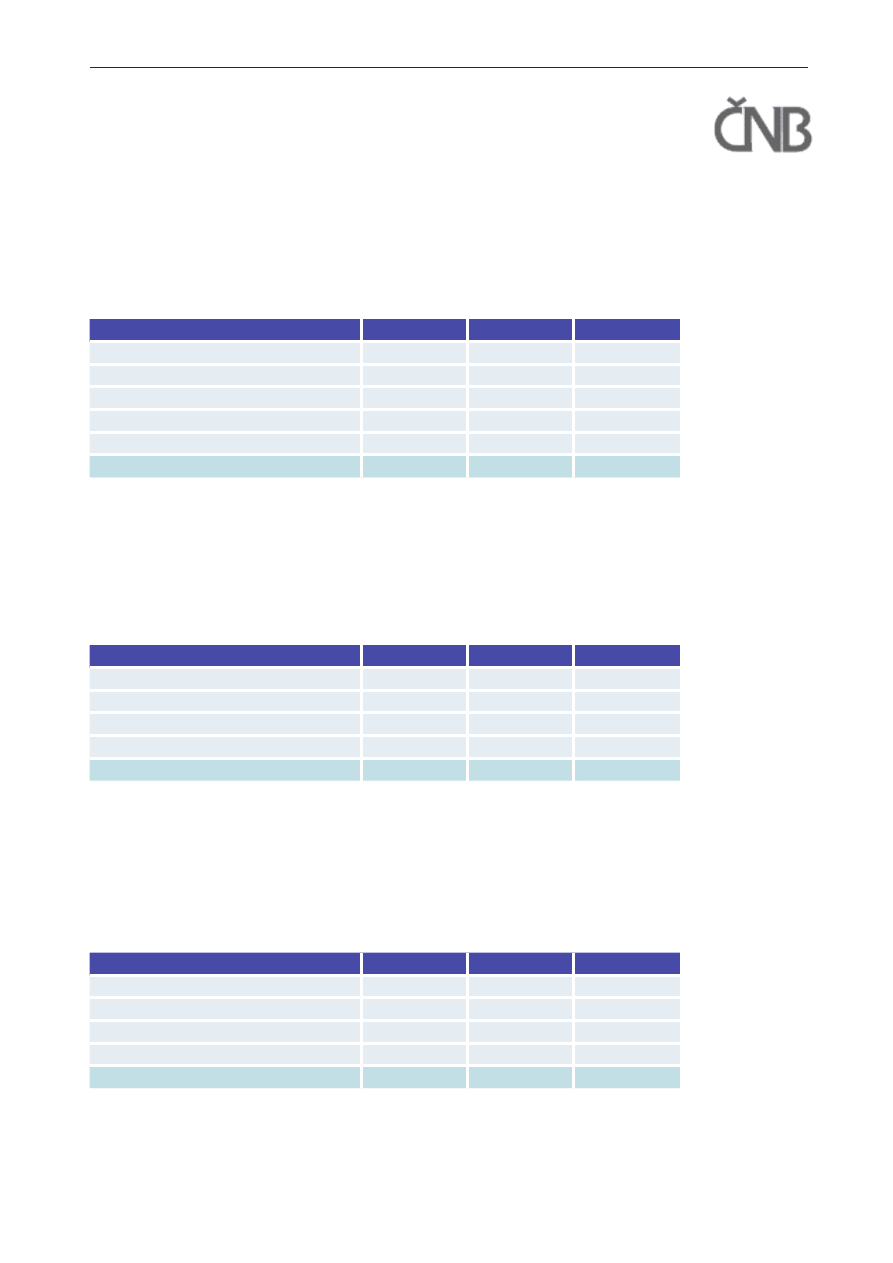
64
STATISTICAL TABLES
Number of banking institutions
(at year-ends, banks carrying on activities as of
31 December of the given year, excl. central bank)
Type of banks
2002
2003
2004
Large banks
4
4
4
Medium-sized banks
9
10
10
Small banks
9
6
6
Foreign bank branches
9
9
9
Building societies
6
6
6
Banks, total
37
35
35
Ownership structure of banks on the basis of registered capital (%)
(at year-ends, banks with licences as of 31 December of the given year)
Item
2002
2003
2004
State ownership
4.1
4.4
4.4
Other domestic ownership
14.0
10.7
12.5
Domestic ownership total
18.1
15.1
16.9
Foreign ownership
81.9
84.9
83.1
Banks, total
100.0
100.0
100.0
Ownership structure of banks on the basis of total assets (%)
(at year-ends, banks with licences as of 31 December of the given year)
Item
2002
2003
2004
State ownership
4.6
3.1
2.9
Other domestic ownership
2.1
1.0
1.0
Domestic ownership total
6.7
4.1
3.9
Foreign ownership
93.3
95.9
96.1
Banks, total
100.0
100.0
100.0
2004
DEVELOPMENTS IN THE CZECH BANKING SYSTEM
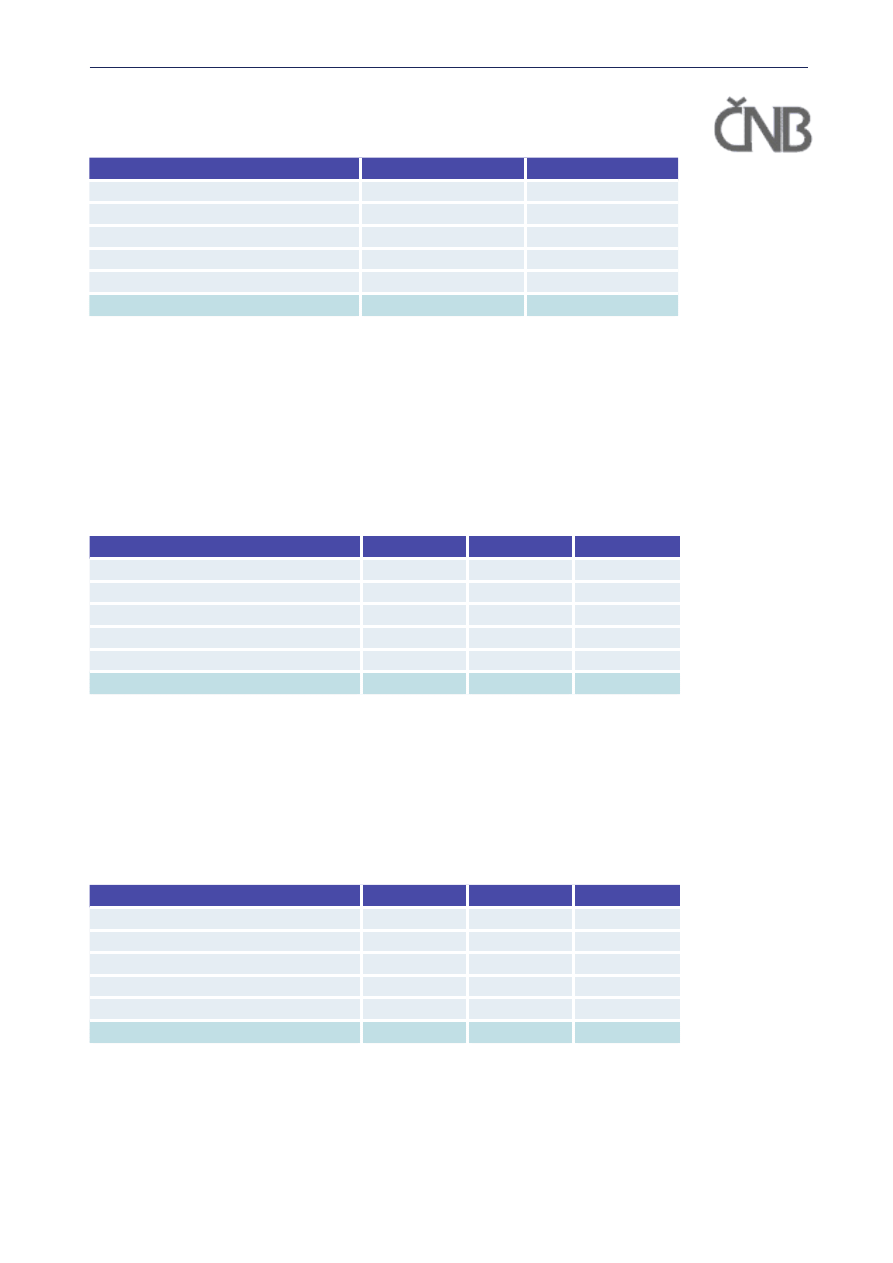
65
Concentration of asset by the type of banks (%)
(at year-ends, banks with licences as of 31 December 2004)
Type of financial institution
The first three largest
The first five largest
Large banks
-
-
Medium-sized banks
47.5
70.2
Small banks
77.1
-
Foreign bank branches
72.2
94.1
Building societies
74.6
-
Banks, total
54.4
64.0
Note: Information on less than three banks cannot be released. This applies when the remaining number of
banks not being included into calculation is less than three, too.
Return on asset (ROA) by type of banks (%)
(banks with licences as of 31 December 2004)
Type of banks
2002
2003
2004
Large banks
1.44
1.37
1.58
Medium-sized banks
0.79
1.14
1.09
Small banks
0.16
1.32
-0.06
Foreign bank branches
1.00
0.86
0.61
Building societies
0.92
0.50
0.39
Banks, total
1.24
1.21
1.26
Return on equity (ROE) by type of banks (%)
(banks with licences as of 31 December 2004)
Type of banks
2002
2003
2004
Large banks
30.99
25.80
27.78
Medium-sized banks
12.86
16.78
13.83
Small banks
1.49
11.50
-0.59
Foreign bank branches
-
-
x
Building societies
20.31
13.38
12.37
Banks, total
27.4
23.8
23.4
Note: For equity Tier 1 is used.
2004
DEVELOPMENTS IN THE CZECH BANKING SYSTEM
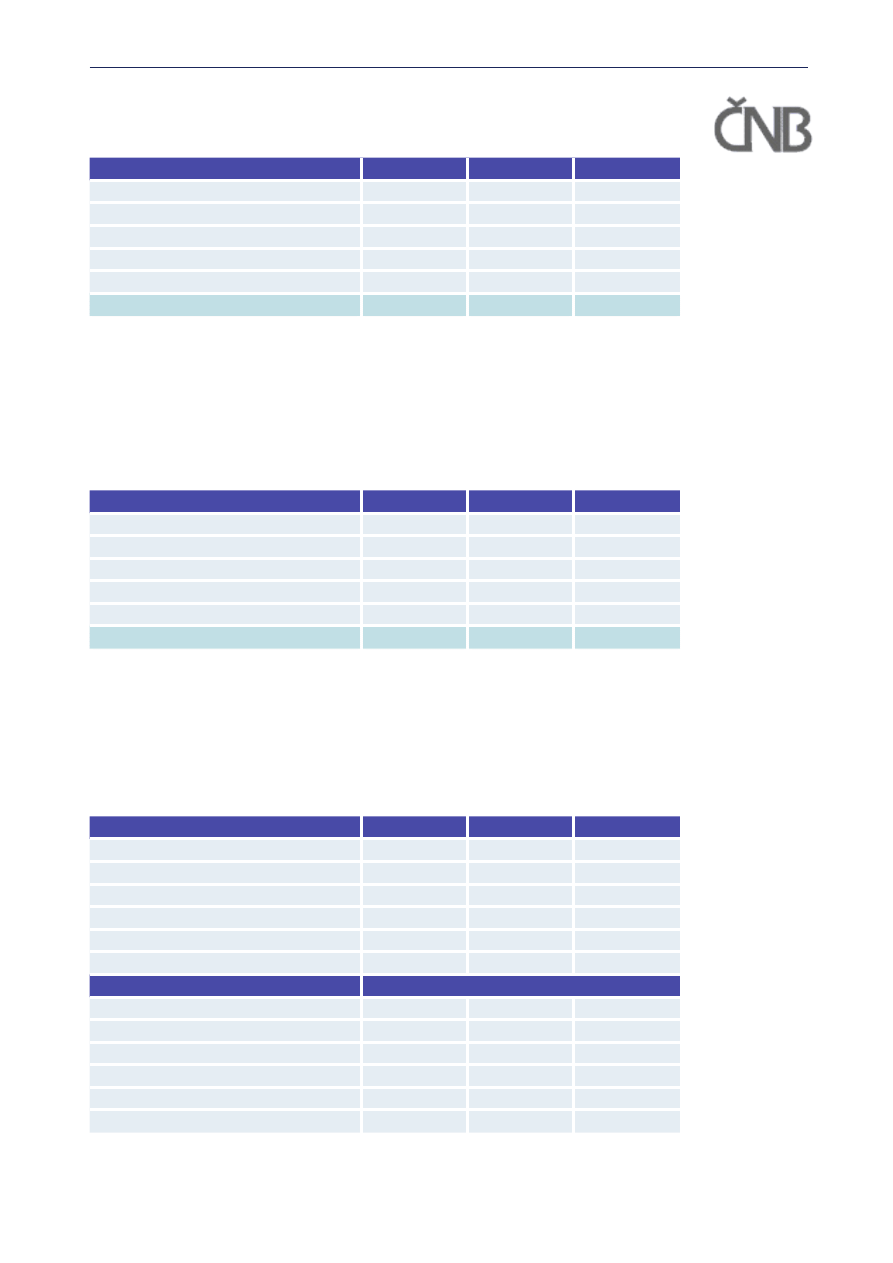
66
Distribution of market shares in balance sheet total (%)
(at year-ends, banks with licences as of 31 December 2004)
Type of banks
2002
2003
2004
Large banks
62.7
62.1
59.8
Medium-sized banks
17.3
15.8
15.9
Small banks
1.9
2.0
2.3
Foreign bank branches
9.7
9.6
10.0
Building societies
8.3
10.5
12.0
Banks, total
100.0
100.0
100.0
Development of off-balance sheet activities (%)
(off balance sheet items-receivables / balance sheet total)
(at year-ends, banks with licences as of 31 December 2004)
Type of banks
2002
2003
2004
Large banks
127.7
146.7
165.9
Medium-sized banks
195.0
207.8
227.0
Small banks
16.4
39.7
43.5
Foreign bank branches
326.9
306.2
346.0
Building societies
4.4
3.4
3.7
Banks, total
146.4
154.4
171.3
The structure of assets and liabilities of the banking system (%)
(at year-ends, banks with licences as of 31 December 2004)
Assets
2002
2003
2004
Deposits with CNB
20.0
19.2
17.1
Deposits with banks
15.9
11.8
15.2
Credits
35.9
39.4
40.7
Securities
18.5
21.2
20.1
Fixed assets
2.2
2.2
2.0
Other assets
7.4
6.2
4.9
Liabilities
Clients´ deposits
64.8
65.9
65.7
Banks´ deposits
12.2
11.3
13.7
Sources from central bank
0.1
0.0
0.0
Bond issues
6.5
7.8
7.6
Equity capital
6.4
7.0
7.2
Other liabilities
10.0
8.1
5.8
2004
DEVELOPMENTS IN THE CZECH BANKING SYSTEM

67
Solvency ratio (%)
(at year-ends, banks with licences as of 31 December 2004)
Type of banks
2002
2003
2004
Large banks
13.41
13.56
11.04
Medium-sized banks
15.98
16.29
17.1
Small banks
37.19
29.02
19.42
Building societies
13.59
13.28
10.81
Banks, total
14.34
14.48
12.55
Asset portfolio quality of the banking system
(banks with licences as of 31 December 2004)
CZK in mil.
Asset classification
2002
2003
2004
Standard
785,348
908,074
981,375
Watch
71,332
64,404
74,320
Substandard
27,515
19,299
19,344
Doubtful
11,689
6,913
5,306
Loss
36,566
23,398
19,857
Non-performing total
75,770
49,610
44,506
Classified total
147,102
114 014
118,826
Reserves and provisions
58,689
38,265
30,877
The structure of deposits and loans in 2003 (%)
(at year-end, banks with licences as of 31 December 2004)
Deposits
Loans
Non-financial
23.0
45.5
Financial
4.7
8.0
Government sector
7.5
11.4
Small business
4.0
2.8
Households
57.1
28.0
Other
3.7
4.3
Total
100.0
100.0
The structure of deposits and loans by time in 2004 (%)
(at year-end, banks with licences as of 31 December 2004)
Maturity of deposits
Loans
At sight
49.9
Short term loans
25.6
Within one year
33.2
Medium term loans
25.6
Over one year
16.9
Long term loans
48.8
Total
100.0
Total
100.0
2004
DEVELOPMENTS IN THE CZECH BANKING SYSTEM
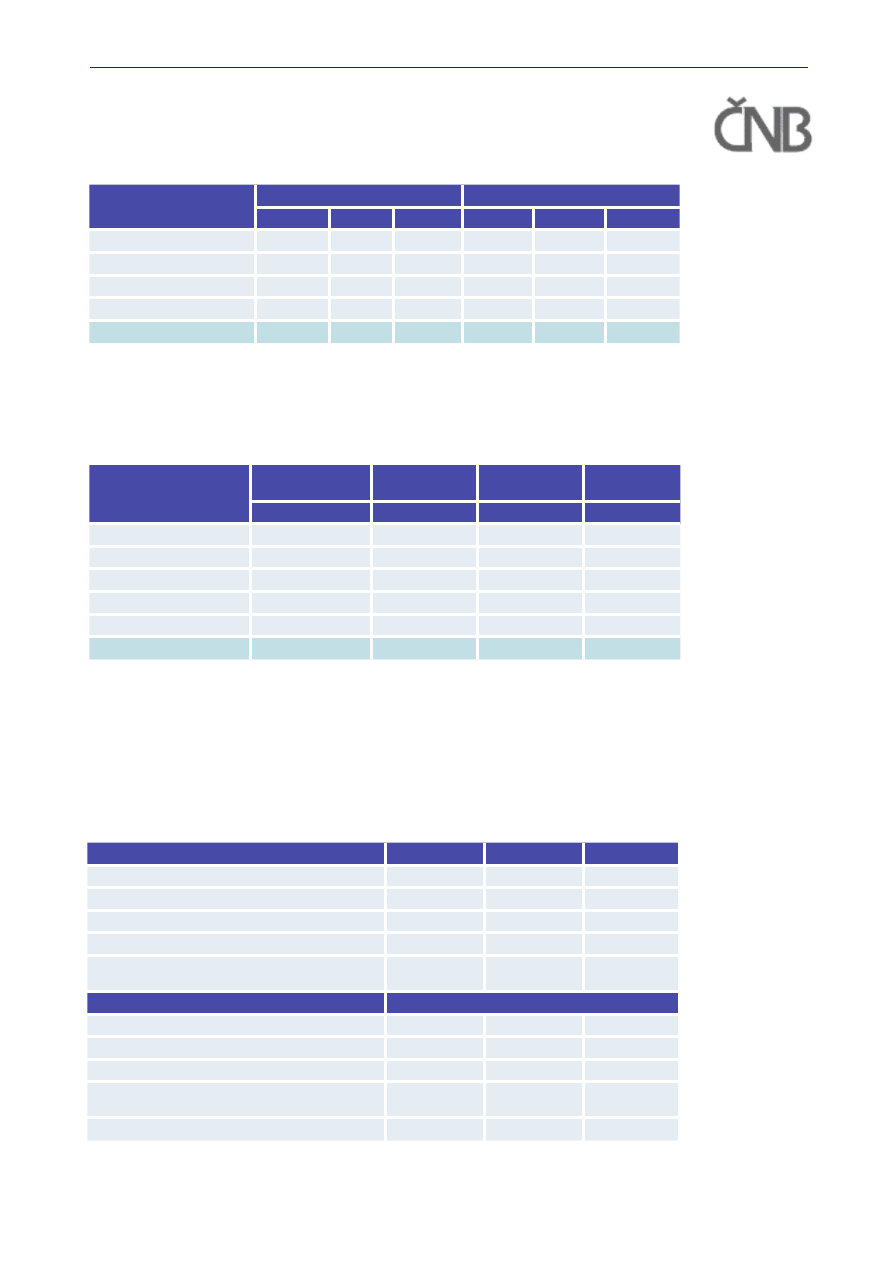
68
Proportion of foreign exchange assets and liabilities (%)
(at year-ends, banks with licences as of 31 December 2004)
Type of the banks
FOREX assets/Total assets
FOREX liabilities/Total liabilities
2002
2003
2004
2002
2003
2004
Large banks
15.8
16.5
20.0
13.4
13.3
15.1
Medium-sized banks
20.1
21.2
21.3
22.7
24.9
24.3
Small banks
13.7
17.3
17.3
13.1
19.4
17.0
Foreign bank branches
36.5
24.7
26.0
40.3
49.7
47.1
Banks, total
17.2
16.3
18.4
16.5
17.4
18.0
Structure of registered capital and own funds of banks in 2004
(at year-end, banks with licences as of 31 December 2004)
Type of the banks
Registered
capital
/Total assets
Own funds
/Total liab
EUR in mil.*
%
EUR in mil.*
%
Large banks
1,458.5
2.8
4,141.2
8.0
Medium-sized banks
530.5
3.9
1,401.7
8.9
Small banks
163.0
8.0
212.7
10.5
Foreign bank branches
13.3
0.2
90.5
1.0
Building societies
146.1
1.4
337.8
3.3
Banks, total
2,311.4
2.7
6,183.9
7.1
* Rate of exchange of 31 December 2004 CZK/EUR = 30,465
Structure of revenues and expenditures of banks
(banks with licences as of 31 December 2004)
CZK in mil.
Revenues
2002
2003
2004
Interest income
121,162
99,773
102,644
Fees and commissions income
29,647
35,657
38,085
Profit from shares and units
1,122
824
1,369
Profit from foreign exchange activities
5,441
6,347
9,567
Profit from other financial operations (incl.
derivatives)
6,088
2,436
1,464
Expenditures
Interest expenses
65,962
45,470
42,885
Fees and commissions expenses
6,133
9,314
6,760
Administrative expenses
46,975
47,513
48,819
Net creation of reserves and provisions, write-
offs and receivables-transfer expenses
8,537
744
10,256
Taxes
11,223
11,074
12,490
2004
DEVELOPMENTS IN THE CZECH BANKING SYSTEM

69
2004 DEVELOPMENTS IN THE
ESTONIAN BANKING SYSTEM
MACROECONOMIC ENVIRONMENT
The Estonian economic growth maintained its pace in 2004 as well resulting
in 6.2% compared to the previous year. The structure of economic growth im-
proved significantly as the share of domestic demand, which had meanwhile
expanded too quickly, decreased and that of net exports increased. Inflation has
sped up during 2004 – prices for goods and services increased by 3%, mainly
due to higher prices for motor fuel and groceries. The upturn of the Estonian
economy encourages the people’s optimistic attitude towards the future that
along with low base interest rates and favourable lending conditions offered by
banks resulted in the growth of borrowing.
DEVELOPMENT IN THE BANKING SYSTEM
(INCLUDING THE ASSETS TOTAL / GDP)
At the end of 2004, there were six licensed credit institutions, three branches
and six representative offices of foreign credit institutions operating in Estonia.
The ratio of banking sector’s total assets to GDP was 96%.
In 2004, the banking sector could be characterized by strong competition in
the lending market. At the end of 2004, two leading Estonian banks captured
79.8% of the lending market.
In 2004, the volume of banks’ assets increased 36% or approximately 35 bn
kroons and they totalled 133.6 bn kroons as of December 31, 2004. The increase
in assets resulted mainly from the increased loan portfolio, constituting 34% or
23.4 bn kroons. By the end of 2004, the banks’ gross loan portfolio reached to
92.6 bn kroons, or 69.3% of total assets. Of the gross loan portfolio, 35% were
business loans and 31% household loans. In 2004, lending by both customer
groups increased. The household loan portfolio grew by 51% or 9.8 bn kroons in
2004. The growth was mainly backed by the increase in housing loans, reach-
ing to 56% or 8.4 bn kroons. The business loan portfolio grew by 38% or 8.8
bn kroons, mostly due to the significant growth in the real estate, leasing and
business activities sector – 59% or 4.5 bn kroons.
Banks were able to maintain the sound quality of loan portfolio in 2004. The
share of loans overdue more than 60 days among the loans to the non-financial sec-
tor was 0.6% at the end of 2004, having decreased by 0.3% compared to 2003.
The volume of deposits experienced accelerated growth in 2004. As of
December 31, 2004, banking sector’s deposits amounted in 64.8 bn kroons – 21%
or 11.3 bn kroons more than last year. At the end of 2004, household deposits
constituted 40% and business deposits 42% of the overall volume. Compared

70
to the previous year, 2004 meant faster annual growth in household as well as
in business deposits, respectively constituting 16% or 3.6 bn kroons and 23%
or 5.2 bn kroons.
Regardless of the growth rate in depositing, it was still outpaced by the lend-
ing growth. The loan-deposit ratio has reached up to 143% by the end of 2004,
compared to 129% a year ago. The increased loan-deposit ratio is a proof that
traditional financing of lending by deposits depositing growth is gradually
being replaced by foreign institutional funding.
In 2004, the banking sector maintained a high level of profitability. Similarly
to 2003, the banks received their main revenue from the traditional banking
activity, lending. By the end of 2004, the interest revenue constituted 54% of
total revenue – 60% in 2003. The net income from fees and commissions con-
stituted 18.9% of the total revenue at the end of 2004, decreasing 0.3% com-
pared to the previous year. During the year, both the return on equity and on
assets have gone up, respectively constituting by 20% and 2.1% as of December
31, 2004.
Despite the accelerated growth of loan volumes, the banks retained their
capitalization on a high level, in 2004 down from 14.5% to 13.4% on a solo
basis due to the growth of risk-weighted assets.
THE LEGAL AND INSTITUTIONAL FRAMEWORK OF
THE OPERATION AND SUPERVISION OF FINANCIAL
INSTITUTIONS, NEW DEVELOPMENTS
LEGAL COMPETENCE OF THE BANKING SUPERVISORY
AUTHORITY
For the Estonian Financial Supervision Authority (FSA), the last year was a
year of fast development characterized by full integration with the EU super-
vision network, and our financial market joining the single EU financial mar-
ket. All this resulted in a broader access to financial services for consumers. In
2004, the FSA became a full member in the network of EU financial supervision
authorities. Already for years, the leading Estonian financial institutions have been
controlled by foreign investors; hence, their strategy and sustainable growth are
affected by developments and decisions outside Estonia. In this respect, the FSA
has been seen as not only having the opportunity but direct responsibility to be
involved in the development of the regulatory framework for a single European
financial market and to strengthen cooperation with foreign supervision authori-
ties. In the longer run, this will create premises for continuous, fast and stable
growth of our financial sector.
FSA operation is managed and organized by the Management Board, which is
simultaneously both an administrative and management body. The Management
Board is authorized to organize the entire FSA operation and make all deci-
sions concerning financial supervision. Among issues concerning financial
supervision, the Management Board has the authority to issue or revoke activ-
ity licenses; to grant consent, approval or permissions; to pass resolutions re-
lating to performance of the registration obligation and maintaining respective
2004 DEVELOPMENTS IN THE ESTONIAN BANKING SYSTEM

71
persons in official lists; to apply administrative enforcement measures and
impose administrative penalties; to order extraordinary audits or expert evalu-
ations; to establish moratorium or a special regime, file bankruptcy petitions
and perform other acts relating to bankruptcy proceedings.
MAIN STRATEGIC OBJECTIVES OF THE SUPERVISORY
AUTHORITY
In the spring of 2004, the FSA drafted a new strategy laying out priorities for
the next three years. The strategy is focused on effective performance of tasks
provided by the Financial Supervision Authority Act. The goal of the FSA is to
create competitive financial services supervision in an expanded European
Union. The strategy of the FSA is based on four main pillars: first, to ensure sta-
bility of financial services providers; second, to protect the interests of consum-
ers by increasing transparency of financial services; third, active involvement in
the development of financial market regulation by considering possible effects
to the market; and fourth, professional, open and efficient operations.
THE ACTIVITIES OF THE BANKING SUPERVISORY
AUTHORITY LAST YEAR
In 2004, the FSA issued a license to open a branch of foreign credit institution
in Estonia on two occasions. In the second half of the year, we issued a license to
open a branch in Estonia to one non-life insurer. Five companies were granted
license to acquire qualifying holding. Additional activity licenses were issued
to two insurance companies. We also granted one fund management company
a license to open a branch in Lithuania. The FSA registered in 2004 two new
investment funds. Due to the new Investment Funds Act in force since May 1,
2004, the FSA registered amendments to 35 investment fund rules.
To improve the assessment of operation by supervised entities and accom-
panying risks, the FSA has designed regular, monthly and quarterly monitor-
ing cycles to determine main risk areas. We monitor and analyse regularly the
status of banks based on the reporting to us, information from public sources,
information obtained by our on-site inspections and other supervisory activi-
ties. In 2004, the FSA focused on the credit risk, operational risks due to lending
activities and assessment of internal control mechanisms used in the credit area.
As for assessment of operational risks, our major project in 2004 was mapping
out credit institutions’ operational continuity process. We based our evalua-
tion of operational continuity on the principles of COBIT – standard of good IT
management and control practices – and other international good practices.
In banking sector’s on-site inspections, we prioritised evaluation of risks
accompanying lending activities. In 2004, three credit institutions were in-
spected. Due to the rapid growth in e-banking and importance of information
technology, we had on-site inspections at credit institutions to assess the risks
accompanying these areas. As of 2004, the FSA forwards information obtained
during on-site inspections based on cooperation agreements to the home
country financial supervision agency of the company’s parent undertaking.
2004 DEVELOPMENTS IN THE ESTONIAN BANKING SYSTEM

72
ORGANIZATIONAL CHART OF THE BANKING
SUPERVISORY AUTHORITY
Organizational structure of the Estonian Financial Supervision Authority as on 31 December 2004
Andres T
rink
Chairman of the Management Board
• Strategies and policies • Institutional development and collaboration • Organizational development • Executive tasks • Foreign and public relations • Internal audit
Kaido T
ropp
Member of the
Management Board
• Insurance sector supervision • Legal environment of insurance sector and services • Budgeting • Internal services
Kilvar Kessler
Member of the Management Board
• Securities market supervision • Code of Conduct • Information disclosure and market transparency • Legal environment of the financial sector • Licensing • Quality and development of FSA
legal authority
Andres Kurgpõld
Member of the Management Board
• Supervision of credit and investment companies and other financial
institutions
belonging
to
their holding group • Capital regulation of supervised entities • External risks • Financial sector
’s IT risks,
e-services supervision • Reporting to FSA
Angelika Koha
Member of the Management
Board
• Supervision and legal environment of investment funds, management companies, and depositories • Internal communications • T
raining
Internal
Audit
Raivo Linnas
Public Relations
Livia Kulm
Auditing Department
Leiu Einberg
Analysis and Reporting
Internal Services
General Supervision
Margus Normak
Market Supervision Kristjan-Erik Suurväli
Institutional Supervision Priit Kiilmaa
Risk Monitoring and
Analysis Priit Kask
Methodology and
Reporting
Helene T
rušina
Investment and Pension Funds Supervision Andre Nõmm
2004 DEVELOPMENTS IN THE ESTONIAN BANKING SYSTEM

73
By its resolution, the FSA Supervisory Board decided to reduce the
number of Management Board members from five to three in 2005. Likewise,
the Supervisory Board gave approval in principle to separate prudential and
market conduct supervision functions within the FSA organizational structure.
The relevant changes have entered into force since 1 June 2005.
Supervisory Board
Management Board
Business Conduct
Supervision Divison
Legal Department
Public Relations
Adminsitrative
Services Deparment
Internal Audit
Market Supervision
& Enforcement
Division
Prudential Policy &
Financial Reporting
Division
Prudential
Supervision Division
INTERNATIONAL ACTIVITIES OF THE AUTHORITY
As of May 1, 2004, the Estonian financial market opened up to service providers
from other EU Member States. This increases opportunities for more efficient
partnership between group undertakings of EU financial groups. In 2004, we
started to exchange information on cross-border services as required by EU leg-
islation and advanced activities set forth by the Memoranda of Understanding
(MoU) with other financial supervision agencies. We focused mainly on the co-
operation with home country financial supervision agencies of parent compa-
nies of Estonian financial institutions. Our cooperation with Finnish, Latvian,
Lithuanian and Swedish supervision agencies has become increasingly closer
and more meaningful. Since the FSA sees harmonization of supervisory practices
as one of its priorities, we also emphasized last year our extended involvement
in working groups of EU committees of supervisors (so-called Level 3) in our
2004 DEVELOPMENTS IN THE ESTONIAN BANKING SYSTEM
Organizational structure of the Estonian Financial Supervision Authority
from 1 June 2005

74
international collaboration. We were most active in the working groups related
to the practical supervisory collaboration and information exchange (CESR-
Pol; Groupe de Contact, etc.), financial reporting (EGAA; CESR-Fin, etc.) and
implementation of Basel 2 and Solvency 2.
COOPERATION WITH OTHER SUPERVISORY BODIES
Being a uniform financial supervision authority, in 2004 the FSA was actively
involved in shaping financial policy and legal environment with the Ministry of
Finance, Bank of Estonia, other state agencies and financial market participants.
Legislative activities were primarily focused on sound and effective adaptation
of EU acquis communautaire relating to financial services.
STATISTICAL TABLES
Number of financial institutions
(at year-ends)
Type of financial institution
2002
2003
2004
Banks
6
6
6
Foreign bank’s branch
1
1
3
Financial institutions, total
7
7
9
Ownership structure of the financial institutions
on the basis of registered capital (%)
(at year-ends)
Item
2002
2003
2004
Public sector ownership
0.0
0.0
0.0
Other domestic ownership
13.3
14.3
10.2
Domestic ownership total
13.3
14.3
10.2
Foreign ownership
86.7
85.7
89.8
Financial institutions, total
100.0
100.0
100.0
2004 DEVELOPMENTS IN THE ESTONIAN BANKING SYSTEM

75
Ownership structure of the financial institutions on the basis of assets total
Item
2002
2003
2004
Public sector ownership
0.0
0.0
0.0
Other domestic ownership
79.3
82.1
79.2
Domestic ownership total
79.3
82.1
79.2
Foreign ownership
20.7
17.9
20.8
Financial institutions, total
100.0
100.0
100.0
Concentration of asset by the type of financial institutions (%)
Type of institutions
The first three largest
The first five largest
Bank
89.87
98.55
Return on asset (ROA) by type of financial institutions
Type of institution
2002
2003
2004
Bank
1.6
1.7
2.1
Return on equity (ROE) by type of financial institutions
Type of institution
2002
2003
2004
Bank
14.7
14.2
20.0
Distribution of market shares in balance sheet total (%)
Type of financial institution
2002
2003
2004
Bank
100.0
100.0
100.0
2004 DEVELOPMENTS IN THE ESTONIAN BANKING SYSTEM

76
The structure of assets and liabilities of the banking system (%)
(at year-end)
Assets
2002
2003
2004
Cash
1.71
1.44
1.08
Claims on central bank
4.36
5.12
5.76
Claims on credit institutions
12.38
11.68
14.37
Claims on customers
61.18
70.02
69.29
Allowance for uncollectible claims
-0.64
-0.56
-0.50
Securities
17.27
9.71
8.01
Intangible assets
0.59
0.44
0.29
Tangible assets
1.27
0.82
0.59
Other assets
1.89
1.33
1.04
Total assets
100.00
100.00
100.00
Liabilities
2002
2003
2004
Amounts owed to credit institutions and
central bank
14.54
16.83
20.28
Amounts owed to customers
59.74
54.17
48.52
Government lending funds and
counterpart funds
0.29
0.21
0.10
Issued debt securities
8.47
13.90
18.71
Other liabilities
3.19
2.32
1.81
Subordinated liabilities
1.54
1.19
0.43
Provisions
0.08
0.08
0.07
Equity capital
12.14
11.30
9.81
Total
100.00
100.00
100.0
Development of off-balance sheet activities (%)
(off balance sheet items / balance sheet total)
Type of financial institution
2002
2003
2004
Banks
23.99
28.25
17.70
Solvency ratio of financial institutions
Type of the financial institution
2002
2003
2004
Banks
15.26
14.51
13.37
2004 DEVELOPMENTS IN THE ESTONIAN BANKING SYSTEM

77
Asset portfolio quality of the banking system
Asset classification
2002
2003
2004
Standard loans
84.49
85.73
88.58
Watch loans
9.81
10.19
8.53
Doubtful loans
2.56
2.29
1.86
Insecure loans
2.07
0.99
0.40
Uncollectible loans
1.08
0.80
0.63
Classified total
100.00
100.00
100.00
Specific reserves (mln EEK)
364
395
464
The structure of deposits and loans in 2004 (%)
(at year-end)
Deposits
Loans
Households
42.1
31.7
Government sector
7.9
3.0
Corporate
44.5
35.3
Foreign*
13.0
1.9
Other
5.5
30.0
Total
100.0
100.0
*Deposits and loans of total amounts
The structure of deposits and loans in 2004 (%)
(at year-end)
Maturity of deposits
Loans
At sight
64.9
Long term loans
67.2
Within one year
31.5
Medium-term loans
24.3
Over one year
3.6
Short-term loans
8.5
Total
100.0
Total
100.0
Proportion of foreign exchange assets and liabilities
(at year-ends)
Type of the
financial institutions
FOREX assets / Total
assets
FOREX liabilities / Total liab.
2002
2003
2004
2002
2003
2004
Banks (only balance sheet
items)
70.3
73.7
73.8
41.2
45.6
52.1
2004 DEVELOPMENTS IN THE ESTONIAN BANKING SYSTEM

78
Structure of revenues and expenditures of financial institutions
(at year-ends)
mln EUR
Revenues
2002
2003
2004
Interest income
271.85
268.36
296.86
Net interest profit/loss (+/-)
151.50
145.77
158.44
Income from financial investments
4.65
15.75
65.66
Commission income
76.86
85.71
103.41
Profit on financial operations
65.92
62.05
62.51
Value adjustments of claims and off-
balance sheet commitments (income)
15.76
8.59
10.54
Value adjustments of financial fixed
assets (income)
0.40
0.25
0.41
Other operating income
3.43
4.73
6.71
Extraordinary income
0.00
0.00
0.00
Expenditures
2002
2003
2004
Interest expense
120.35
122.59
138.42
Commission expense
21.31
22.66
28.41
Loss on financial operations
42.94
36.21
38.08
Administrative expenses
112.34
112.79
132.92
Value adjustments of tangible and
intangible fixed assets (expenses)
26.57
16.07
14.15
Value adjustments of claims and off-
balance sheet commitments (+/-)
24.49
15.11
22.55
Value adjustments of financial fixed
assets (expenses)
0.72
0.43
0.68
Other operating expenses
12.51
12.04
9.30
Extraordinary expenses
0.00
0.00
0.00
Profit/loss for the reporting period
73.71
96.67
157.46
Structure of registered capital and own funds of financial institutions in 2004
Type of the
financial institutions
Registered
capital
/Total assets
Own funds
/Total liab.
EUR
%
EUR
%
Banks
292,551,608.6
3.4
837,720,015.8
10.9
2004 DEVELOPMENTS IN THE ESTONIAN BANKING SYSTEM

79
2004 DEVELOPMENTS IN THE
HUNGARIAN BANKING SYSTEM
MACROECONOMIC ENVIRONMENT IN YOUR COUNTRY
In line with the global and European trends the growth of the economy of
Hungary slowed down somewhat in the second half of 2004. During the last
quarter, however, deceleration came to an end and the rate of the growth of
GDP over the whole of the year ended up at 3.8 %, only half a percentage point
below the peak observed in the first quarter. Consequently, the difference
between the GDP growth rate of Hungary and the EU-25 continued to grow and
at the same time Hungary got half a percentage point closer to that of the new
EU Member States. During the fourth quarter the growth of all sectors acceler-
ated on the supply side – except for services – while on the demand side, despite
the declining export dynamic, the balance of exports and imports improved.
Despite the favourable development of GDP statistics on the fourth quarter
the economy of Hungary was clearly on a decelerating growth path. The expan-
sion of supply was largely a result of the outstanding performance of agricul-
ture – an approx. 40 % output growth – during the second half of 2004, which
itself was a result of the favourable weather conditions last year and the result-
ing outstanding grain harvests, which should therefore be considered as a one-
off event. At the same time, in view of the whole of the second half, the growth
of industry decelerated substantially, the main reason for which was definitely
a significant weakening of demand abroad. The dynamic of orders placed in
the manufacturing industry clearly declined during the recent months and in
January 2005 the total portfolio of orders from export markets was below the
portfolio registered one year before.
Future trends in industry, which is the dominant factor of Hungary’s economic
growth, will very likely be determined by the development of industrial output in
the European Union. According to data on the previous 8 years the development
of the industrial output of the Union (or, more precisely, the development of the
annual growth rate of industrial output measured on a monthly basis), made
up more than three quarters of the impact of factors determining the expan-
sion of the economy of Hungary. This close relationship is due primarily to the
high degree of vertical integration of Hungarian and other European industrial
enterprises, which has been spreading towards the new Member States during
the past 1-2 years. As a consequence of this trend the opportunities for export-
ing Hungarian industrial output will be determined by the degree to which the
economy of West Europe manages to cope with the impacts of a strengthening
Euro and the extent to which demand for consumption and investment can be
stimulated. Our own analysis shows that in this respect in year 2005 a slow
decline, rather than acceleration should be expected for year 2005.
On the demand side the most important trend in 2004 was the discontinu-
ation of the earlier, disproportionately fast growth of consumption and the in-

80
crease of spending on consumption dropped to below the growth curve of GDP.
The primary reason for this was related to the endeavours of income policy, in
the wake of which in year 2004 the two digit growth of real wages – which char-
acterised earlier years – was replaced by a slight decline. As had been expected,
the new trend of real wages was followed by retail turnover only to some extent
and at a substantial lag, the results of which are also indicated by the increase
of demand for consumption loans, in the second half. In the wake of the de-
cline of demand for services the substantial deceleration of the expansion of
consumption took place despite the above trend, which is a favourable trend
partly from the aspect of internal price stability and particularly from that of
the external balance.
Another important trend on the demand side was a significant upswing in
fixed investment in year 2004. The volume of investments increased in 2004
by 8.3 % – the fastest rate since 1998 – within which special mention should
be made of a 15 % growth of investments in the manufacturing industry the
output of which is (to be) sold abroad. The increase of investment was also re-
flected by the 4.6 % increase of the performance of labour on the level of the
national economy (GDP/employment), which is the highest rate since 1997.
On the other hand however, the rate of unemployment also increased slightly.
The rapid growth of the performance of labour is definitely improving domestic
competitiveness and the stability of the HUF. In terms of its effects the aver-
age domestic labour cost per unit of output, expressed in Euros, increased only
by 2-3 % in 2004 (2003: 6 % up), and in our estimate it equalled 42 % of the
average of the EU-15.
The equilibrium of the domestic economy improved substantially in 2004,
though the balance of the budget and the current balance of payments continue
to shows major tensions and they are still accompanied by substantial macro-
economic risks.
One crucial change in respect of the internal equilibrium of the economy
is that the annual rate of consumer inflation declined significantly, exceeding
even the expectations of the market. This development was not really surpris-
ing in that to a significant extent it originated from the spill over effects of the
increase of indirect taxes in early 2004, which, of course, could be calculated
in advance. Furthermore, however, the process of declining inflation was very
likely strengthened by a significant deceleration of the outflow of wages and pen-
sions, the weakening of demand for consumption and the HUF which has been
steadily in a strong position within the intervention band. As a combined effect
of the above the annual inflation rate dropped by 440 basis points in 9 months
and in February 2005 it was at 3.2 %. This was the lowest rate in decades.
Another important trend during the recent period, contributing to an im-
proving equilibrium, was the perceptible deceleration of the growth of credits
and of monetary expansion. On the one hand, the annual growth of the domes-
tic instruments of credit institutions (credits and bonds) dropped from the 35
% peak in January 2003 to 15 % in January 2005, on the other hand, the an-
nual growth of the amount of money in circulation in the broad sense of the
term dropped from the 17 % peak in July 2004 to about 10 %. The deceleration
of monetary expansion was primarily a result of the increase of the costs of
credits. On the one hand, the 11.3 % average base rate of the central bank in 2004
2004 DEVELOPMENTS IN THE HUNGARIAN BANKING SYSTEM

81
exceeded that of the previous year by 280 basis points. On the other hand, the
tightening in 2003 of the conditions of subsidies on housing loans increased the
burdens borne by borrowers substantially through the reduction of the inter-
est subsidy and the related PIT allowance, as a result of which demand for this
type of credit contracted substantially in 2004. This latter change cut out the
key driving force of the vigorous credit expansion witnessed before 2004.
The development of the position of the budget was much less clear-cut from
the aspect of total domestic demand and the macro-economic equilibrium.
During the two years since 2002 – and in respect of the accrual based data in
2004 – there has been a clear decline in the general government deficit: the
deficit calculated according to the Eurostat methodology dropped from 8.5 %
to 6.2 % of GDP in 2003, and to 4.5 % in 2004. According to cash-based data,
which provide a more direct view of the level of current demand however, the
situation is not quite so clear-cut, for according to such data the deficit dropped
substantially in 2003 but it remained more or less unchanged in 2004. In view
of these two different types of statistics the year 2004 position of the budget
may be regarded as one that ‘was slightly improving’.
The external balance of the economy of Hungary improved in 2004 despite
the fact that the demand for external financing (the aggregate of the current
deficit and the capital balance) is still high and that it diminished only slightly
over a one year period from the peak value of the 12 month period ending in
September 2003 (from 9.3 % to 8.8 % of GDP). From the aspect of the positions
of the domestic income owner sectors this was enabled primarily by the growth
of the net financial savings of households which, after several years of decline,
increased for the first time in 2004, in the wake of the decrease of demand for
real estate credits.
Besides the decline of demand for financing, the improvement in 2004 of the
external balance was also stimulated by a change of the structure of financing.
For in the advanced economies after the expiry of the programmes of economis-
ing in the corporate sector, which characterised earlier years, the net influx of
direct investments started to grow again and in the 12 month period ending in
September 2004 it equalled 3.4 % of GDP. The effects of this rise in investment
were reflected by an upswing of fixed investment and in the improvement of the
productivity of labour. From the aspect of the balance of payments however, in
a shorter run it more important that the part of the external financing demand
that is not covered by direct investment dropped substantially – from 7.8 %
to 5.4 % of GDP – as a consequence of which the demand of the economy of
Hungary on foreign capital markets also declined. This had a definitely positive
effect on the cost of financing and the state of the domestic financial markets.
In year 2004 the MAX index that is characteristic of the price of the longer than
one year government bonds denominated in HUF increased by 14 %, the BUX
index which shows the development of the domestic exchange share prices in-
creased by 57 %. The HUF grew stronger: during the year it strengthened against
the Euro by an average of 1 %, in the December to December period it grew by
almost 7 % relative to the Euro and in the second half of the year it hang on to
the upper intervention point, staying in the 240-250 HUF/EUR band.
The improving ratios of equilibrium (inflation, balance of payments) and the
strengthening of the position in the market of financial instruments denominated
2004 DEVELOPMENTS IN THE HUNGARIAN BANKING SYSTEM

82
in HUF (primarily the HUF itself) created favourable circumstances for easing
the notebank’s interest rate policy. From March 2004 up to end-February 2005
the base rate of the notebank was reduced by 425 basis points, almost in line
with the decline with the annual consumer inflation rate. The resulting 8.25 %
base rate was still substantially higher than the 2 % refinancing rate of the CBE,
partly as a consequence of the budget deficit, which was significantly higher
than the average (2.7 % of GDP in 2004) of the Euro zone and to a substantial
extent as a result of the exchange rate risk of the HUF. On the long side of the
yield curve however, convergence is much more advanced, in that the premium
of the 10 year HUF government bonds over similar West European Euro bonds
dropped to about 300 basis points by end-February 2005.
DEVELOPMENT IN THE BANKING SYSTEM
(INCLUDING THE ASSETS TOTAL / GDP)
Much attention was paid to the domestic banking sector in year 2004, in Hungary
and abroad as well.
Expectations were focused on three sets of questions:
• How will Hungary’s accession to the European Union in May 2004 affect
the number of the entities operating in the Hungarian banking sector,
will the foreign owners dominating the sector decide on any organisa-
tional changes and will cross-border services be launched, will branches
be opened abroad? How will the single European market affect competi-
tion, the standards of services and the behaviour of the participants of the
market, including customers?
• Will the growth of the role of banks as intermediators in the market con-
tinue, including the rapid growth of lending operations observed in recent
years and in particular in 2003, especially in the area of retail lending?
How will the demand for housing loans change in the wake of the tighten-
ing of the conditions of state subsidies to housing loans twice in 2003 and
as a result of the peak of demand for credits in the first half and at the end
of 2003? Will the trend of increasing demand for credits denominated in
foreign exchange continue? What sources will banks finance the high rate
of growth of activities?
• How does the dynamically growing lending activity affect the level of
capitalisation of Hungarian banks, their liquidity, lending and exchange
rate risks? Does the ‘ageing’ of the credit portfolio entail a decline of the
quality of the portfolio? Can the year 2003 level of profitability of the
banking sector – which was highly favourable by international standards
– be maintained?
As a consequence of Hungary's EU accession the domestic banking market
– as the entire money and capital market – became part of the single European
market. The characteristics of the increasingly harmonised market, however,
are growing perceptible only through a gradual though probably not too slow
process. One of the most important possibilities of the single market is the
possibility to provide cross border services, but – as far as we know – it was not
2004 DEVELOPMENTS IN THE HUNGARIAN BANKING SYSTEM

83
started in Hungary in 2004. Many – 66 by the end of December – of the foreign
credit institutions registered in the EU Member States notified the Supervision
of their intents to start such activities in the future, but in year 2004 no such op-
erations were performed, rather, the entities concerned took the necessary steps
to meet the legal conditions required for the performance of such operations.
Three of the domestic banks (MKB, BB and CIB) have notified the Supervision
of their intents to provide cross-border services in the future. They are not aim-
ing specifically to expand their markets so much as making preparations for
the future, i.e. they are taking the necessary steps to meet legal requirements
in time, to obtain licence by the national Supervision and to provide services to
domestic customers that are actively operating in foreign markets in relation
to Hungarian exports (financing goods, services, projects), as they have got
accustomed to in Hungary.
Through the ‘single European passport’ the single market has made it easier
to establish branches abroad. Only one of the parent banks operating in the EU
Member States (Dresdner Bank) has decided on turning its domestic subsidiary
– which was unprofitable in 2004 – into a branch. This process is, however, car-
ried over into year 2005 therefore the number of the participants of the sector
was not changed by this transformation in year 2004.
The number of the participants of the sector dropped by one in comparison
to the number recorded at end-2003, as a consequence of the expansion and
market building intents of two foreign and one Hungarian-owned credit institu-
tion. The privatisation of Postabank and Konzumbank reduced the number of
banks by two for two foreign (EU) owned large banks (Erste Bank and Magyar
Külkereskedelmi Bank) merged the acquired banks in 2004. At the same time,
the number of the participants of the sector was increased as a result of the
decision of one savings cooperative (ELLA) to transform itself into a bank, in
view of the growing opportunities in the market.
Competition in the sector – which was rather strong even before 2004 – was
not yet intensified in 2004. No perceptible change took place in services ei-
ther, since under the influence of foreign owners the foreign parent banks had
been providing substantial assistance to the operations of their subsidiaries in
Hungary, to product development and the raising of standards. The behaviour
of customers did not change materially either, though the development of hous-
ing and car loans denominated in foreign exchange show that perhaps partly
as a result of Hungary’s EU accession borrowers are not so afraid of exchange
rate and interest rate risks. Information has been received on the ‘borrowing
tourism’ of Hungarians living near the western borders of Hungary – borrowing
in Austrian banks near the border – but, as far as we know now, these transac-
tions have not yet reached a material scale where they could threaten the market
positions of Hungarian banks.
In year 2004 the financial intermediator role of the banking sector contin-
ued to growh though at a decelerating rate in comparison to 2003. The ratio
of the credit portfolio relative to GDP increased from 36.4 % in 2002, through
43.7 % in 2003, to 46.4 % in 2004. The expansion of lending resulted in a 16
% growth of the balance sheet total, which – though falling short of the 26 %
increase in the preceding year – was substantially higher than the approx. 10
% nominal growth of GDP, as a consequence of which the penetration rate
2004 DEVELOPMENTS IN THE HUNGARIAN BANKING SYSTEM

84
(balance sheet total/GDP) increased from the 69.2 % at the end of 2003 to 73.0
% by the end of 2004.
Development of the financial intermediating role of the
banking sector (%)
The spectacular 33.3 % growth of the lending activities of banks observed in 2003
was not repeated in 2004: the approx. 16.7 % expansion however, still provided
for a dynamic growth. The role of lending makes up a share in the operations of
banks that is considerable even by international standards, at the end of 2004
the aggregate HUF 9,483 billion credit portfolio of the bank sector equalled 63.5
% of the total assets of about HUF 14,926 billion (balance sheet total). The same
ratio was 53.1 % in the EU-15 at end-2003, while in the new EU Member States it
was 48.7 % at the same time. At end-2004 the HUF 2,597 billion bank loan port-
folio of households exceeded the amount registered one year before by almost 0
% and though this growth rate fell short of the 66 % stated at end-2003, it was
still a lot higher than the growth rates observed in previous years, as well as the
rate of increase of Hungary’s GDP. The demand for housing loans broke records
at end-2003 in view of the expected contraction of state subsidies, and in 2004
– after appraisal of loan applications accepted in late 2003 and the placements
relating to those applications – it shrunk substantially in 2004. The housing
loan portfolio almost doubled in 2003, in 2004 it increased by about a third, so
growth was quite dynamic in 2004 as well. The demand for credit on the part
of businesses increased at a much less dynamic rate – by 14.5 % – falling short
of the 22.7 % increase recorded in 2003. Consequently, at end-2004 the total
bank credit portfolio of businesses amounted to HUF 4,614 billion, accounting
for 31 % of the total asset portfolio. The credit portfolio of households and busi-
nesses increased by almost the same amount – HUF 597 and HUF 583 billion,
respectively – during year 2004. An increasing proportion of transactions was
denominated in foreign exchange in both areas, about 70 % of the increment of
corporate loans and almost half of the retail credit increment was made up of
foreign exchange loans or HUF loans based on foreign exchange.
In addition to traditional banking operations banks got increasingly involved
in the provision of investment services. Banks performed over 80 % of their cus-
tomer asset management activities on the basis of deposit management orders
received from customers. They also carried out custodian, deposit safekeeping
and asset management orders.
At end-2004 the nominal value of the assets of customers managed by banks
exceeded the amount booked one year before by almost 25 %, after an increase
exceeding that of the balance sheet total. The total of funds intermediated by
the banking sector – which includes the banks’ balance sheet total and the
customers’ assets managed by banks – increased by a dynamic 19 %.
2004 DEVELOPMENTS IN THE HUNGARIAN BANKING SYSTEM

85
The trends in the assets intermediated by the banking
sector
Banks were financing their lending activities by raising new funding sources.
At end-2004 the total liabilities of the banking sector exceeded the amount
registered at the end of 2003 by some HUF 2,066 billion. About a third of the
increment of liabilities originated from domestic deposits and from abroad, 4.1
% from mortgage bonds owned by domestic investors, 13.3 % from domestic
interbank deposit and credit sources and 12 % came from the growth of share-
holders’ equity.
The decelerating though still dynamic growth of the banking sector did not,
on the whole, jeopardise the stability of the sector, at the same time it provid-
ed outstanding profitability. The exchange rate risk did not increase despite
the increasing proportions of transactions denominated in foreign exchange,
since the long foreign exchange positions in the balance sheet were hedged
by the banks outside the balance sheet. Though in the case of entrepreneurial
loans the ageing of the loan portfolio lead to a slight increase of the portfolio of
non-performing items, the proportion of such items did not exceed 3.92 % of
the total entrepreneurial credit portfolio, even at the end of 2004. The quality
composition of entrepreneurial loans is acceptable by international standards,
for at the end of 2003 the ratio of non-performing loans was above an average
of 4 % in the credit portfolios of the banks of the EU-15 countries. The ratio of
non-performing items among retail credits did not increase, it remained at the
2.4 % registered at the end of 2003. The capital position of the sector is stable,
as a result of the internal capital accumulation enabled by the profitability of
the sector. The weighted average liquidity ratio of the banking sector (approx.
12.25 %) was practically identical with the 12.26 % recorded at the end of the
preceding year, reaching the average of the 15 old EU Member States (of 12.2%),
slightly exceeding the desirable 10 %.
The sector booked HUF 275 billion profit after taxes (58% up on that of
2003), indicating a profitability that is rather high by international standards.
In 2004 the weighted average ratio of profitability of assets calculated form
the profit after taxes in the banking sector (ROA) stood at 1,97 %, the return
on equity (ROE) stood at 23.40 %, exceeding the 8.3 % and the 10.9 % ratios
of both the old and the new Member States, respectively. The rapid growth of
profitability was enabled by a combined effect of a 19.7 % increase of the aver-
age asset portfolio, including an average of almost 23 % increase of the average
credit portfolio and the relatively large – 3.91 % – margin caused by the high
rate of return, which hardly diminished during the year. The improvement of
the profitability of the sector was enabled primarily by maintaining the level of
the interest margin and the improvement of operating cost effectiveness.
2004 DEVELOPMENTS IN THE HUNGARIAN BANKING SYSTEM

86
THE LEGAL AND INSTITUTIONAL FRAMEWORK OF
THE OPERATION AND SUPERVISION OF FINANCIAL
INSTITUTIONS, NEW DEVELOPMENTS
LEGAL COMPETENCE OF THE BANKING SUPERVISORY
AUTHORITY
Transposition of EU rules and directives
For Hungary and the Supervision, the greatest change in 2004 in respect of the
regulation of the financial market was the entry into force of a number of rules
that were applicable only to EU Member States. The application of the single
passport principle greatly simplified, for financial organisations established
in one of the Member States of the expanded EU, the taking up of activities in
other Member States. Hungarian regulations contain identical rules in respect
of financial institutions, investment service providers and insurance companies
alike, with the exception of a few details.
The Supervision actively participated in the transposition of directives
related to financial services into Hungarian law. The Ministry of Finance, which
has the main responsibility for law harmonization, involved the Supervision in
the preparation of legislation.
The Supervision cooperated in the transposition of the
following directives into Hungarian law
The implementation of Directive 2002/87/EC on the supplementary supervi-
sion of credit institutions, insurance undertakings and investment firms in a
financial conglomerate, which was transposed, in respect of the supplemen-
tary supervision of financial conglomerates, by Act LXXXIV of 2004. Pursuant
to the Directive, in Hungary the OTP group is considered a conglomerate, and
in their case, the Supervision acts as coordinator in the course of the supple-
mentary supervision of the conglomerate. The implementation of Directive
2000/46/EC on the taking up, pursuit of and prudential supervision of the
business of electronic money institutions, which was transposed by Act XXXV
of 2004 on specialised credit institutions issuing electronic money. The trans-
position of Directive 2002/47/EC on financial collateral arrangements, which
is contained in Act XXVII of 2004 on the amendment of certain financial acts
for law approximation purposes amending the Civil Code and the Bankruptcy
Act. Furthermore, the Supervision participated in the preparation of a number
of directives, which are still in the process of being transposed.
2004 DEVELOPMENTS IN THE HUNGARIAN BANKING SYSTEM

87
Legal amendments due to the responsibilities of the
Supervision
Last year the Supervision, in addition to many other proposals, submitted
a proposal to amend Act CXII of 1996 on Credit Institutions and Financial
Undertakings (Credit Institutions Act.). The amendment re-regulated the
consolidated supervision of credit institutions, also incorporating in the Act a
directive on the liquidation of credit institutions, and containing a number of
clarifications and supplementary clauses necessitated by harmonisation with
the acquis. The amendment of Act CXX of 2001 on the Capital Markets (Capital
Markets Act) incorporated the rules of consolidated supervision pertaining to
investment undertakings, as well as the harmonisation of two new EU direc-
tives in the amendment of the chapter on investment funds, as well as minor
modifications, which were nevertheless important for certain areas.
The Supervision placed emphasis on the trends to amend the capital adequacy
rules of the supervised institutions in 2004 as well. Following several years of
preparatory work, the Basle Committee on Banking Supervision published the
new Basle Capital Accord (Basle II) in June 2004, which the EU also proposes
to adopt. Following the adoption of the draft directives amending the calcula-
tion system of the capital requirements of credit institutions and investment
enterprises (capital requirements directives) by the Commission in July, the
Supervision continues to actively participate in the European committees work-
ing on the new regulatory system. The Supervision also actively participated in
the meetings organised by the Ministry of Finance to establish Hungary’s posi-
tion during the discussion of the draft directives in the European Council, dur-
ing this exercise, we could utilise the experiences gained in the course of the
committee work. The Supervision held discussions with the Hungarian Banking
Association concerning the tasks relating to the implementation of the new
capital rules in Hungary, as a result of which a survey was made on the possible
difficulties of introducing the new capital adequacy rules in Hungary.
In addition to the usual annual questionnaire survey, in 2004 the Supervision
started to directly examine the efforts of the most important credit institutions
to develop their internal classification systems, and, starting in the end of 2004,
this subject became part of the examination programme of the regular on-site
examinations.
In 2004, Act LX of 2003 on Insurance Companies and Insurance Activities
was amended twice. Essentially, the rules applicable to insurance intermedia-
tion and insurance consultancy were amended, but the amendment also speci-
fied the content of asset management for mutual pension funds and private
pension funds. The rules governing permanent establishments and relating
to third-country insurers and to insurance mutuals were also clarified. Legal
regulations governing pension funds were amended regarding the membership
relationship, the rules of designating a beneficiary, the organisation of funds,
the rules of secrecy and asset management. Under the new regulations, the
members of pension funds as well as of health and income supplement funds
can also appoint a beneficiary. As of 1 January 2004, the board of directors of
funds have been allowed to take decisions outside sessions. The processing of
complaints has been made the fundamental responsibility of funds, therefore
2004 DEVELOPMENTS IN THE HUNGARIAN BANKING SYSTEM

88
the Supervision forwards complaints received to the funds for investigation.
The regulation of real estate investment of funds and the rules of superviso-
ry control have become more detailed. After the end of the waiting period or
upon reaching retirement age, pension fund members may offer as collateral at
most 50% of the balance on their individual accounts to agreements concluded
with credit institutions falling under the scope of the Credit Institution Act, as
long as they provide that the pension fund freeze the amount on the individual
pension account. The more detailed regulation of transfers back to the social
security system in case of members who became disabled affected exclusively
private pension funds. In case of disabled persons, the fund must, upon re-
quest, inform the member without delay about the sum of the expected annu-
ity. As of May 2004, in conjunction with EU accession, the definition of career
starters and of voluntarily joining members was re-regulated. The new
Hungarian Act on the fight against money laundering and the financing of
terrorism came into effect on 16 June 2003. In that context, the Supervision
prepared a new recommendation at the beginning of 2004, which was made
available to the participants of the financial sector. As new elements, the
recommendation contained the most frequent typologies and the chapter on
the financing of terrorism was revised based on the list of EU sanctions. At the
beginning of 2004, the Supervision updated the anti-money-laundering model
rules disclosed to the supervised financial institutions.
MAIN STRATEGIC OBJECTIVES OF THE SUPERVISORY
AUTHORITY IN 2004
The key features of the operation of the Supervision in 2004 were determined
by market trends, fundamental risks and the supervisory objectives revised to
reflect such risks.
Objectives and tasks of the supervision
As a member of the supervisory community of the European Union, on the
integrating financial market, the Supervision
• assures the reliable, continuous and transparent operation of financial
markets;
• promotes the confidence in the financial markets;
• promotes the development of financial markets relying on fair competi-
tion;
• protects the legitimate interests of market participants;
• helps reducing the risk of consumer decisions by making available the
necessary information;
• actively participates in combating financial crime.
Accordingly, the activities of the supervision fall into two large categories:
• “classic” prudential supervision, which means primarily assuring the
continuous and reliable operation of the supervised institutions, the en-
forcement and enforceability of rules at present and in the future,
2004 DEVELOPMENTS IN THE HUNGARIAN BANKING SYSTEM

89
• market oversight activities, monitoring the effects of the cooperation of
market participants (i.e., service providers and consumers) on the trans-
parent operation of the market.
Risk assessment, examination findings
During 2004, the Supervision supervised, or had in its registers, two thousand
and forty-seven institutions, companies with legal entity and over eighteen
thousand natural persons in the money market, capital market, insurance and
pension fund sectors. As part of prudential supervision, the authority prepares
risk assessment on the supervised institutions on a quarterly basis. In the
course of that risk assessment, the personal, operational and commercial risks
are analysed based on the available information (mandatory reporting, other
publicly available information). During the year, 560 institutions were assessed
each quarter on average. The regular risk assessment of the supervised institu-
tions indicated that in the course of 2004 the level of risks remained practically
unchanged in the financial sector, the number of institutions in the high-risk
category went down. The general assessment of risks indicates that the money of
account owners and depositors, the capital of investors, pension fund members
and life policy holders, the coverage of property and loss insurance holders was
fundamentally safe during last year. In addition to the quarterly risk assessment,
the Supervision conducted some four hundred examinations in 2004.
The on-site examinations and off-site supervision were either comprehensive,
targeted or ad hoc. The law regulates the frequency of comprehensive examina-
tions, while most of the targeted and ad hoc examinations are triggered by risk
assessment. The examinations look at legality, compliance, and place increasing
emphasis on the assessment of the quality of financial products and services. The
supervisory measures following the examinations included resolutions as well
as, increasingly, hitherto little used instruments such as consultations, as well
as supervisory recommendations and information sessions.
Sector of financial
institutions
Last year large banks suffered no perceivable portfolio deteriora-
tion, and the Supervision considered the risk assumption process to be suffi-
ciently prudent. On the other hand, the findings of examinations revealed that
a substantial part of the credit risks of banks operating in financial groups can
be interpreted together with the other group members only, but the evaluation
of the liquidity, exchange rate and interest rate risks also reveals a true picture
only in conjunction with the other group members. Therefore, the methods
of integrated supervision have been improved on several points. In line with
the new international requirements, in the course of on-site examinations the
Supervision staff placed special emphasis on the measuring and management
of the operating risks of banks. The findings of examinations indicate that few
financial institutions address this issue in depth; in most places there is no
management commitment to make available the necessary resources.
In the cooperative sector, no severe deficiencies were identified in relation
to the capital position of credit cooperatives, which was a priority during com-
prehensive examinations. In this sector, risks arise from irregular lending prac-
tices (inadequate assessment of collateral and sureties), and the intransparent
2004 DEVELOPMENTS IN THE HUNGARIAN BANKING SYSTEM

90
management and ownership structures. In the course of examinations, special
emphasis was placed in the verification of the prevention of money laundering.
No major deficiencies were found in the banks examined, our experiences show
that banks strive to comply with legal regulations. Among financial enterpris-
es, the number of firms increased continuously, many new, non-bank-owned
financial enterprise entering the market. The Supervision pays special attention
to their licensing. The risk level of financial enterprises was stable in 2004, at a
moderate level. In the group of financial enterprises not affiliated to bank groups,
risk levels were above average, probably due to the absence of the tight control
of banks. In the case of these firms, the risk was caused by inadequate capital
position, insufficient commercial activity, or the continuously deteriorating
asset portfolio ending up in the bad category. The latter phenomenon was re-
lated to the increasing problems encountered in vehicle financing. Examinations
revealed a discrepancy in that the regulation of factoring activities in the Capital
Market Act is not uniform at present, and there is no differentiation between
current factoring and work-out type activities. The legal separation of the two
activities and the appropriate modification of the regulation would promote
the more efficient supervision of current factoring, which provides short term
finance, and work-out type activities, which are rather different in their objec-
tive and implementation.
Capital market
Among investment enterprises, there has been no substantive change in the
risk position, any negative movement was found only in operating risks, in
particular the operation of control and information systems. The most notable
irregularities related to the violation of settlement transaction limitations (some
of the companies perform for their clients operations that belong to the scope
of settlement services beyond the limits of investment service activities) or to
the improper management and protection of assets owned by clients. Further
problems were found in the field of separation of organisation units and func-
tions performing the various activities, the formulation of internal procedures,
by-laws and internal control system and the outsourcing of certain activities
(occurring problem in the field of information technology). On the whole, the
capital position of the companies is deemed to be adequate.
The risk level of investment fund managers is low. The examinations per-
formed at fund managers revealed that the standard of ownership control was
adequate. At the same time, the accelerating of commercial activity and the ex-
pansion of the scope of activities demanded the radical transformation of inter-
nal control systems as well. Both management control and in-process control
strengthened last year. In general, the supervised institutions complied with
legal regulations, the violation of investment limits became less frequent in the
environment of increased control, but it still happens.
2004 DEVELOPMENTS IN THE HUNGARIAN BANKING SYSTEM

91
THE ACTIVITIES OF THE BANKING SUPERVISORY
AUTHORITY LAST YEAR
The management and governance system of the
supervision
Pursuant to Act XXII of 2004 on the amendment of certain acts relating to
the increased protection of investors and depositors, regulations pertaining
to the Supervision were also changed. Pursuant to the law, after 18 May 2004,
the HFSA Board became the main strategic management and decision mak-
ing body of the institutions, while the Director General heading the Office has
responsibility for operative management. A more efficient organisation structure
more adapted to the market challenges was developed during the year. As the
main element of the organisational change, which is also enshrined in the new
organisational and operational rules approved by the Minister of Finance, the
prudential supervision block as well as the market oversight block have been
reinforced. As discussed in the pervious chapters of the annual report, opera-
tional risks are of utmost importance not only within the individual institutions
but also between institutions. This is indicated by the fact that from the second
half of the year the two main organisations of the Office have operated under
the management of two deputy director generals, with equal importance. By
balancing the prudential supervision and market oversight, the emphasis on
prevention, more sensitive response to market processes and reliance on dia-
logue and cooperation with market participants have become reinforced in the
Supervision’s work. In the new approach, the strengthening of strategic think-
ing based on expected market developments, the increase of decision making
independence and responsibility were given more importance; as a result, the
formerly highly centralised organisation model became more decentralised,
and decision making competences were moved to lower levels. It is a nota-
ble phenomenon in the Hungarian financial sector that financial services are
becoming increasingly complex, and one institution would offer many different
products to consumers. Accordingly, the Supervision has the task of acceler-
ating the process of establishing an integrated supervision in compliance with
the changing circumstances. The process, which started some four years ago,
means that the Supervision has competence over every sector (money market,
insurance market, capital market, funds), and also that it performs its work
under uniform principles and methodologies. Accordingly, the various institu-
tions and products can be supervised based on uniform principles if the insti-
tutions and products are analysed along a common element, i.e., the risk. We
must not disregard the fact, however, that risks, mainly operational risks, add
up on the level of single institutions. Thus they relate to institutions and their
supervision is also a must. Within the Supervision’s organisation, this function
is performed by the system of designated supervisor, where every supervised
institution (financial group) has a designated contact person or supervisor. The
complexity of services, the permeability of the lines between institutions and the
better utilisation of professional skills, however, demand that, in addition to the
2004 DEVELOPMENTS IN THE HUNGARIAN BANKING SYSTEM

92
2004 DEVELOPMENTS IN THE HUNGARIAN BANKING SYSTEM
necessarily hierarchical structure of the Office, the Supervision also establish
horizontal professional committees that make better use of professional com-
petences and assure a uniform approach. These committees, to ease the rigidity
of directorates and departments, are mainly functional in nature, for instance
the committee of European affairs, the accounting, asset management or legal
committees. Special mention should be made of the Conglomerate committees,
meant to assure group-level supervision. Thus, in the approved organisation,
an equilibrium has been achieved, which is necessary to fulfil the fundamental
goals of the Supervision. This is expressed by the co-ordinated, mutually inter-
dependent structure of the organisations and bodies below, which supplement
and control each other:
• HFSA Board and the Office: the setting of objectives and strategies and
monitoring of implementation – organisation and practical management
of the implementation of tasks;
• Prudential supervision and market oversight: the supervision of the sound
operation of the supervised institution – identification and elimination of
anomalies in operation and the market environment;
• Functional supervision and the system of designated supervisors: main-
taining financial risks between limits – supervision of operational risks
so that they cannot cause destructive financial risks later;
• Hierarchical structure and inter-organisational committees: reliable,
though somewhat rigid traditional governance system – more flexible
system able to give professional responses to changing market challenges,
combining the professional competences existing in the various units of
the supervisory organisation.
Internal regulation
In addition to more comprehensive organisational changes, modifications
promoting the efficiency, transparency and controllability of daily operations
were also made in 2004. For instance, a controlling unit was established,
which focuses on the comparable and measurable utilisation of the budget of
the Supervision, and internal audit was strengthened, becoming an organisa-
tional unit. In 2004, the chartering and regulation of previously unregulated
areas as well as the review and updating of existing regulations continued. To
promote uniform supervisory internal rules, the new regulation entered into
force to clarify the content and formal elements of internal rules and to regulate
procedural issues. In addition, a number of new rules were adopted during the
year. Because of the organisational change in the Supervision, the review of the
necessary regulations was also commenced. Following the entry into force of the
new Organisational and Operational Rules, the directive of the Director General
on the detailed tasks of the various units of the Office was prepared.
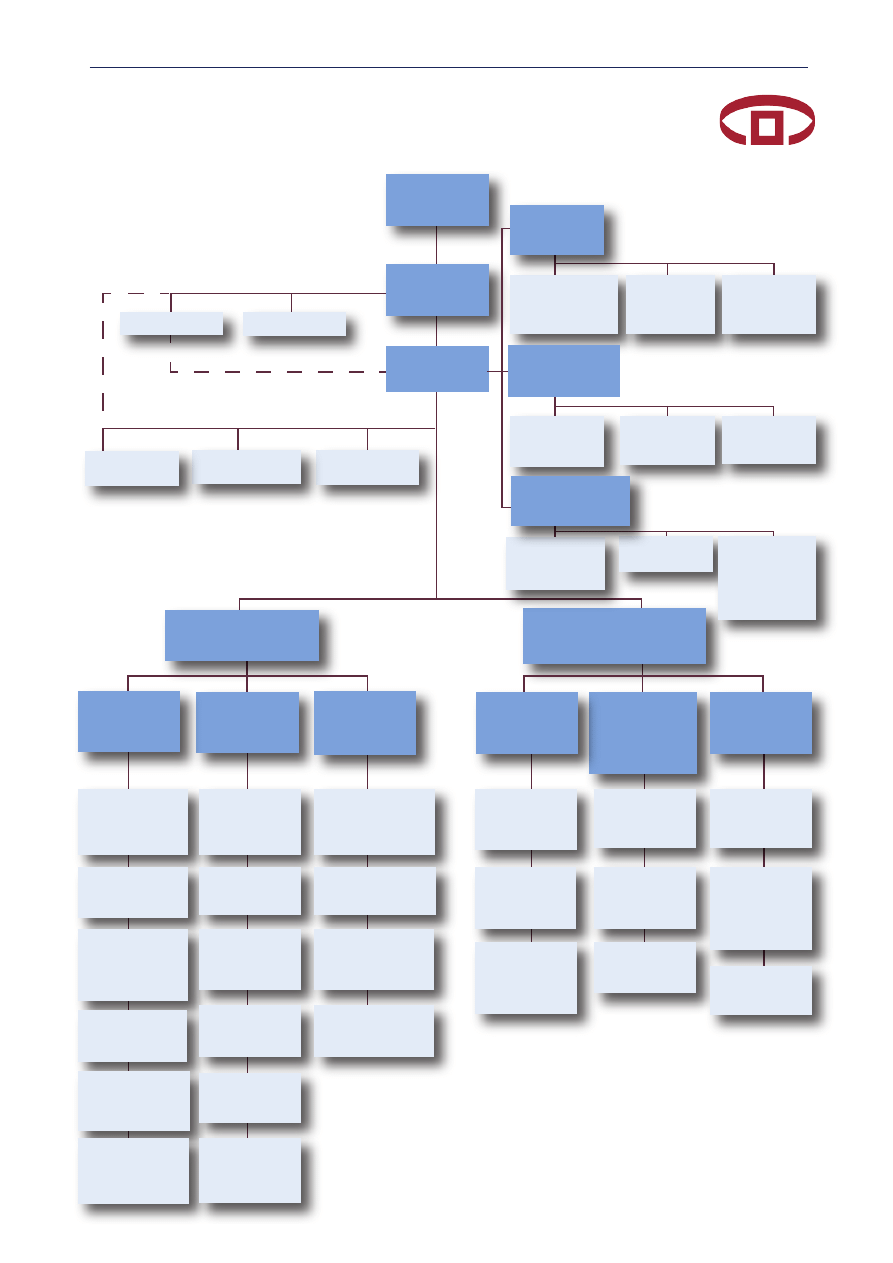
93
2004 DEVELOPMENTS IN THE HUNGARIAN BANKING SYSTEM
ORGANIZATIONAL STRUCTURE OF THE HUNGARIAN
FINANCIAL SUPERVISORY AUTHORITY
Chairman of the
Board
Board of the
HFSA
Director
general
Deputy director general
Prudential Supervision
Deputy director general
Market Developments
Oversight
Directorate of
Methodology
Regulatory,
Analytical and
International
Affairs
Directorate
EU counsellor
Banking and
Capital Market
Legal Enforce-
ment Department
Universal Banks
Supervision
Department
Dept. For Supervision
of Commercial Banks
and Specialized
Credit Institutions
Capital Market
Supervision
Department
Dept. for
Supervision of
Cooperative
Credit Institutions
Financial
Enterprises
Supervision
Department
Actuarial and
Modelling
Department
Methodological
Department
IT Supervisory
Department
General
Supervisory
Department
Monitoring and
Institutional
Analysis Dept.
Economic,
Statistics and
Data Processing
Department
EU counsellor
Insurance and
Pension Funds
Enforcement Legal
Department
Insurance
Supervision
Department
Pension Funds
Supervision
Department
Pension Funds
Administration
Department
Banking and
Capital Market
Licensing
Department
Insurance
and Funds
Licensing
Department
Capital Market
Corporate
Financing
Department
Regulatory and
Legislation
Department
Analyses and
Research
Department
International
Affairs
Department
Consumer
Protection
Department
Customer
Service and
Complaint
Management
Department
Market Conduct
Oversight
Department
Internal Audit
Secretariat
Department of the
Central Registration
of Pension Funds
Maintanence
Department
Financial &
Budgetary
Department
Controlling
Department
Human
Resources
Department
Administration
Department
Process
Engineering
& Internal
Regulations
Department
Financial &
Controlling
Directorate
Security Officer
Communication
Legal
Counsellor
IT Services
Directorate
Human Resources
& Administration
Directorate
Market
Oversight
Directorate
Banking and
Capital Market
Supervision
Directorate
Insurance
and Funds
Supervision
Directorate
IT-
Applications
Department
IT-
Infrastructure
Department
Licensing
Directorate

94
INTERNATIONAL ACTIVITIES OF YOUR AUTHORITY
Cooperation within the European Union
In 2004, the EU accession and the related tasks were the most significant events
for Hungary. The HFSA started preparation for the new environment by partici-
pating in the work of various EU level committees and working groups, in respect
of cross-border services and implementation of EU provisions and changes in
supervisory methodologies and procedures. The experts of the HFSA have con-
tributed to the work of various committees as observers since 16 April 2003, the
date of signing the accession treaty, and as members since the accession. The
HFSA has become a member of the organisations of the financial supervisory
authorities of the European Economic Area, which are sectorally organised as
Level 3 committees according to the Lamfalussy process. The authorities of the
28 countries form the CEBS in the field of banking, the CEIOPS for insurance
and pension funds, and the CESR for securities (capital markets). At present,
the representatives of the HFSA participate in the work of 39 committees and
working groups in the fields of banking, capital market, insurance, pension
fund, financial conglomerates and anti-money-laundering. In addition to innu-
merable exchanges of e-mails the committee members attended 150 meetings
in 2004. Last year, the HFSA joined the CESR-Pol Joinder Agreement, while
in case of the CEIOPS the HFSA became party to the document providing for
the supplementary supervision of insurance undertakings in insurance groups
(Helsinki Protocol) and the document on the cooperation of insurance super-
visory authorities (Siena Protocol) by the accession. In addition to numerous
other cooperation agreements, the HFSA signed the multilateral memoranda
of understanding of the European Central Bank on crisis management, and on
payment systems.
Cooperation outside the European Union
OECD
The OECD operates with several expert committees; of these, the Committee on
Financial Markets, the Working Party of Governmental Experts on Insurance
and the Pension Fund Working Group are of outstanding importance from a
supervisory aspect; the HFSA regularly and actively participate in their meet-
ings and in the preparatory work. The most important projects of 2004 were as
follows: financial education, consumer awareness, competition in the financial
sector, corporate governance in the financial sector, aging population and its
effects on pension schemes and structure of investments.
IAIS
In 2004, the HFSA, as a member of the association, participated in the 11
th
annual
meeting of the International Association of Insurance Supervisors, and attended
the meetings of 7 committees and subcommittees of the IAIS on 9 occasions.
2004 DEVELOPMENTS IN THE HUNGARIAN BANKING SYSTEM

95
Between 29 March and 1 April 2004, the Executive Committee, the Technical
Committee and its sub-committees and the Emerging Markets Committee and
Education Subcommittee held their quarterly sessions in Budapest. Related to
the committee meetings, the HFSA organised a regional seminar on 1-2 April
2004 for the staff of Central and Eastern European insurance supervisory au-
thorities, with 61 participants. The HFSA prepared its self-assessment exercise,
examining compliance with the new Insurance Core Principles approved in
2003, and was one of the first institutions submitting it to the IAIS Secretariat
in December.
IOSCO
IOSCO is the international organization of securities commissions, where our
personal participation is limited to the annual conferences (in May 2004 the 29
th
annual conference of the IOSCO was held in Jordan), while we always partici-
pate in major projects and in questionnaire surveys. In 2004, IOSCO launched
or continued several projects that promote international cooperation.
IOPS
In 2004, after lengthy preparation, the International Organisation of Pension
Supervisors was established, with the HFSA as one of its founding members.
The representative of the HFSA holds a senior position in the organisation that
was formerly affiliated to the OECD, but operates independently since 2004.
After its establishment, the organisation now considers the elaboration of
common supervisory standards as its most important task.
BSCEE
Since 1996 HFSA and its predecessors has been hosting the Secretariat of the
Group of Banking Supervisors from Central and Eastern Europe. During 2004,
the representatives of the HFSA attended the 17th conference of the group, as
well as the seminars organised twice a year (jointly with the Financial Stability
Institute – FSI).
Conference of integrated financial supervisory authorities
The 6th conference of the Integrated Financial Supervisory Authorities was held
in Singapore on 13-17 August 2004. The 2004 conference of the organisation,
with the supervisors of 16 countries as its members, focused on assessing the
efficiency of supervision and discussing the issues of cost-sensitive supervision.
AML Working Group
The HFSA participated in the work of the Anti-Money Laundering working
group, which elaborated the new 3rd anti-money laundering directive of the
EU, and contributed to the formulation and representation of the Hungarian
position. Furthermore, the experts of the HFSA participated in the work of the
AML Contact Committee, which fosters the anti-money laundering internal re-
lations of the EU and the relations between the EU and international antimony
2004 DEVELOPMENTS IN THE HUNGARIAN BANKING SYSTEM

96
laundering organisations (FATF, MONEYVAL, etc.), to help formulate the EU’s
position. In 2004, the HFSA headed the Hungarian delegation to Moneyval.
COOPERATION WITH OTHER SUPERVISORY BODIES IN
YOUR COUNTRY
In respect of the cooperation of the financial control bodies, the tripartite
agreement of the Ministry of Finance, the National Bank of Hungary and the
Supervision is of outstanding importance; it has the objective of assuring the
stability of the system of financial intermediation and the coordination of the
macro- and micro-prudential supervision, control, regulation and monitoring of
the sector. This arrangement, which is widely used internationally, has the addi-
tional objective of assisting the work of the three institutions in assuring finan-
cial stability. In addition to many other agreements, the Supervision has signed
a bilateral cooperation agreement with the Tax and Financial Control Authority
and the Parliamentary commissioner for citizens’ rights. The Supervision placed
great emphasis on reviewing, together with the trade associations of the financial
sector, the existing and potential areas of professional relations. Accordingly,
the HFSA Board engaged in consultation with the major interest representa-
tion bodies and trade associations of the financial sector (Hungarian Banking
Association, Association of Hungarian Insurers, BAMOSZ, Fund associations,
BSZSZ). In addition to the strengthening of relations with interest representa-
tion and trade associations, the Supervision organised a number of consulta-
tions, held presentations and organised successful conferences for practitioners
working in the financial sectors.
OTHER RELEVANT INFORMATION AND DEVELOPMENTS
IN THE COURSE OF LAST YEAR
In 2004, the Hungarian Financial Supervisory Authority (HFSA) focused on
the implementation of the reformulated objectives. It is not that a “different”
supervision was created; rather, an organic development process was started,
building on our existing values such as the highly qualified staff. All this aimed to
assure that the HFSA complies with the modern organisational and operational
principles set forth in the Act on the Supervision adopted last year, and that si-
multaneously it finds its place in the supervisory community of the European
Union. Among its fundamental objectives, the HFSA set out to shorten its re-
sponse time to market problems, to speed up the adoption of measures and to
reinforce its preventive function. We also had to meet the expectation that our
supervisory activity should encompass the screening of all financial, operational
and consumer protection risks arising at the financial institutions. In the course
of its modernisation, the Supervision focuses on assuring the conditions of
professionalism and integrity. The resulting organisational structure provides
the equilibrium that supports efficient supervisory work from all aspects. To
supplement the “classic” prudential supervision, greater emphasis has been
2004 DEVELOPMENTS IN THE HUNGARIAN BANKING SYSTEM

97
placed on market oversight within the organisation of the HFSA. In that con-
text, the HFSA takes actions against irregularities to protect the interests of all
market actors, from service providers to the consumers. The responsibilities of
the market oversight function include not only consumer protection activities
– complaint procedures, client service, information – but also the detection of
unlicensed service providers and identification of information indicative of in-
sider trading. The market oversight function, which monitors sensitive informa-
tion, performs examinations requiring timely action and outstanding capabili-
ties. To accelerate procedures and bring legal considerations closer to the daily
work of financial institutions, law enforcement work has been integrated into
audit and economic activities both in prudential supervision and in the equally
important market oversight. More efficient work is promoted by the altered de-
cision making mechanism and the decentralisation of decision making powers.
The number of units directly reporting to the operative head of the Supervision
has been decreased while the directorates working in the prudential and market
oversight lines have received greater discretionary decision making powers and
the concomitant greater responsibility. Within the governance structure of the
HFSA, the Board sets the objectives and strategies for the entire Supervision and
monitors their implementation. On the other hand, the Office, headed by the
Director General and supported by the operative management meeting to pre-
pare decisions, is responsible for the implementation and practical management
of the tasks. The HFSA continues to maintain its institution-based supervisory
structure. However, alongside the hierarchical structure, working groups have
been set up from delegates of several organisation units, which promote consoli-
dated, integrated and activity-based supervision in horizontal cooperation. This
is how the more efficient supervision of increasingly complex financial services
and innovative products can be assured. The bank holding supervision groups,
as well as the working groups looking at activities characteristic of more than
one sectors, such as asset management, operate along those lines. In its contacts
with market participants and peer authorities, the Supervision strives for part-
nership and dialogue. Accordingly, in the autumn of 2004 the Supervision, the
National Bank of Hungary and the Ministry of Finance concluded a tripartite
agreement on the coordination of tasks to assure the stability of the financial
sector. A number of consultations were held with the participation of the trade
associations and representative bodies of the supervised sectors, which are also
represented in the working groups of the Supervision. From among the market
and consumer protection measures, we should highlight the introduction of the
register of insurance agents to promote the more efficient identification of in-
surance intermediaries, the preparation of the system of electronic returns by
employers to private pension funds, and the reinforcement of the investigation
of unauthorised financial activities. The Supervision informed consumers in a
series of information booklets and continuously updated product comparison
tables last year as well. This was also promoted by the transformation of the
client service and complaint handling procedures to make them more custom-
er-friendly and smoother. During the whole year, special emphasis was placed
on the preparation for the legal definition of the annual percentage rate (APR),
the supervisory measures relating to addressing the problems of the Interbank
Debtor and Credit Information System (BAR), and the theme audits relating to
2004 DEVELOPMENTS IN THE HUNGARIAN BANKING SYSTEM
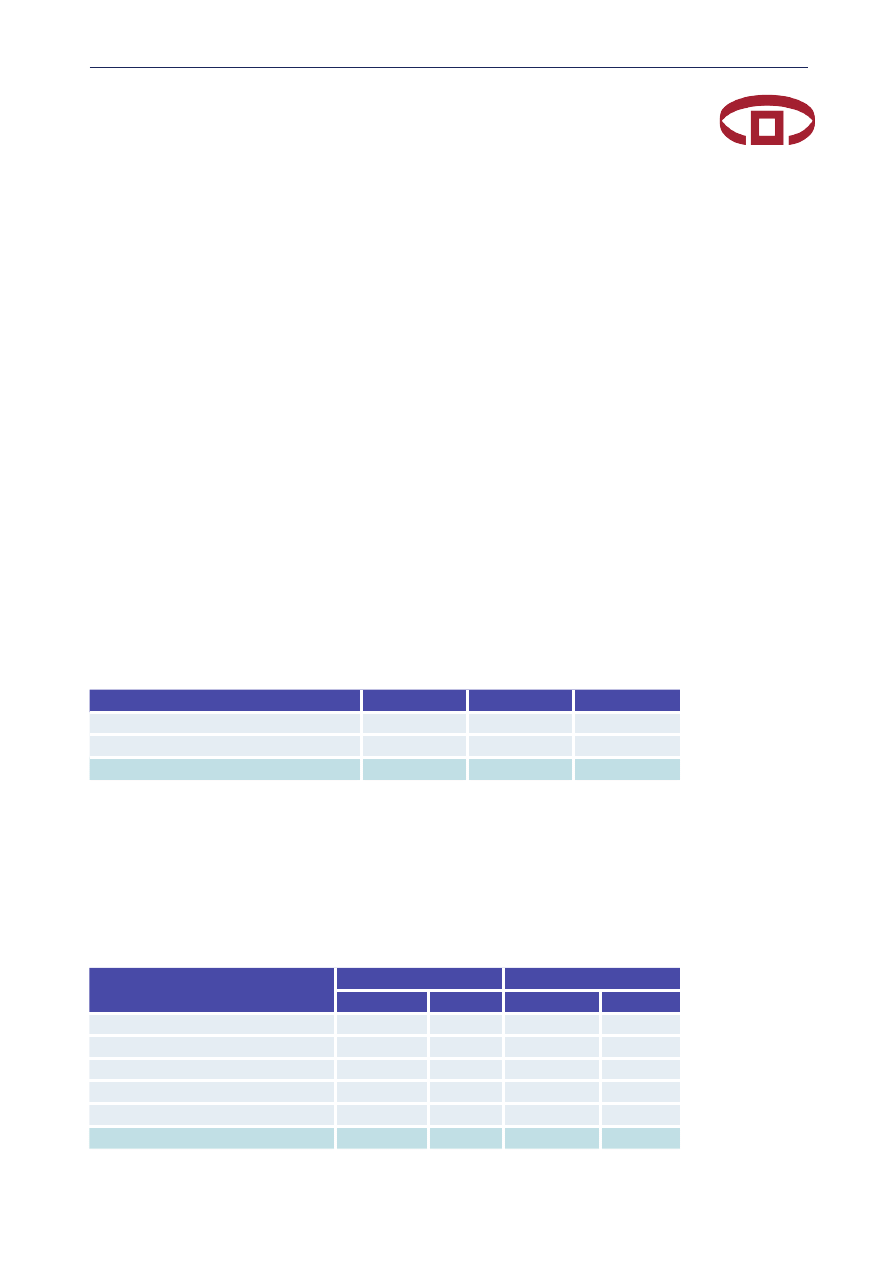
98
mortgage lending practices and the oversight activities of banks employing cur-
rency exchange agents. The HFSA took a major role in the preparation for the
transposition of EU rules and directives into Hungarian law. Our staff actively
participated in the work ongoing in the committees of organisations of the su-
pervisory bodies of the European Economic Area. In order to coordinate infor-
mation flows relating to the European Union, a separate EU working group was
set up within the HFSA, combining representatives of different specialities. In
order to more effectively implement the procedures of Basle II, the new Basle
capital accord, the establishment of a comprehensive cooperation procedure
has been started with peer agencies and the supervised institutions, and a fur-
ther training programme was launched within the Supervision. The work of the
HFSA doubtlessly contributed to the fact that in the financial sector, consisting
of more than two thousand institutions, the risk levels did not change last year,
and fewer institutions received high risk ratings.
STATISTICAL TABLES
Number of financial institutions
(at year-ends)
Type of financial institution
2002
2003
2004
Banks and specialized credit institutions
37
36
35
Saving and credit cooperatives
189
182
178
Financial institutions
226
218
213
Ownership structure of the banking system
on the basis of registered capital
(at year-ends)
Item
2003
2004
HUF billion
%
HUF billion
%
Public sector ownership
3.6
0.9
3.6
0.9
Other domestic ownership
49.2
13.1
44.2
11.5
Domestic ownership total
52.8
14.0
47.8
12.4
Foreign ownership
308.0
81.9
309.6
80.4
Preferential and repurchased stocks
15.1
4.0
27.6
7.2
Banking system, total
375.9
100.0
385.0
100.0
2004 DEVELOPMENTS IN THE HUNGARIAN BANKING SYSTEM
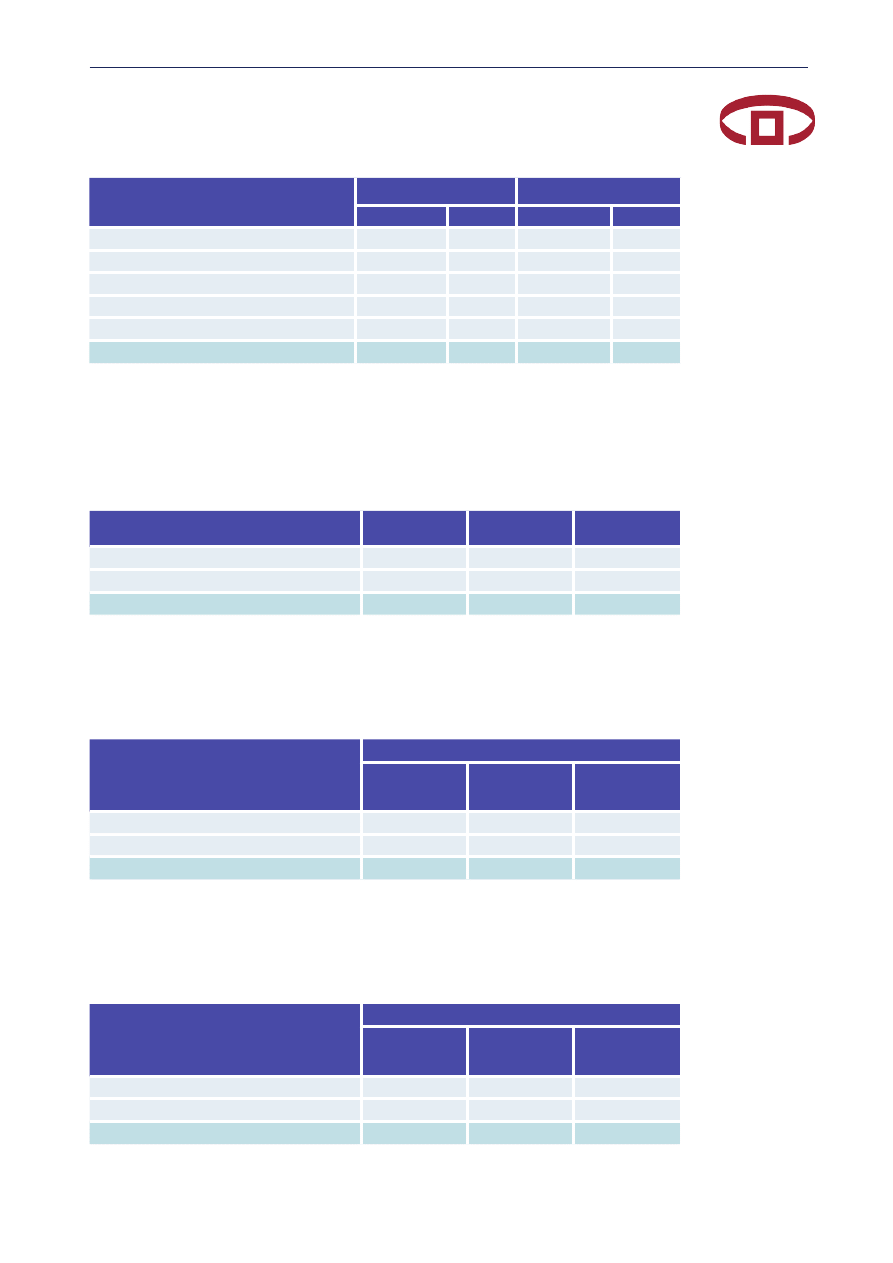
99
Ownership structure of saving and credit cooperatives
on the basis of registered capital
(at year-ends)
Item
2003
2004
HUF billion
%
HUF billion
%
Public sector ownership
1.3
9.0
1.1
6.8
Other domestic ownership
13.4
90.9
15.2
93.2
Domestic ownership total
14.8
99.8
16.3
100.0
Foreign ownership
0.0
0.2
0.0
0.0
Preferential and repurchased stocks
0.0
0.0
0.0
0.0
Saving and credit cooperatives, total
14.8
100.0
16.3
100.0
Concentration of asset by the type of financial institutions
HUF billion
Type of institutions
The first
three largest
The first five
largest
Total
Bank and specialized credit institutions
6,120.0
8,425.0
14,926.4
Saving and credit cooperatives
84.3
125.7
1,064.4
Financial institutions
6,204.3
8,550.7
15,990.8
Return on asset (ROA) by type of financial institutions
Type of institution
2004
After-tax
profit
(HUF billion)
Average
assets
(HUF billion)
ROA
(%)
Bank specialized credit institutions
275.2
13,952.5
1.97
Savings and credit cooperatives
8.2
817.3
1.01
Financial institutions
283.4
14,769.8
1.92
Return on equity (ROE) by type of financial institutions
Type of institution
2004
After-tax
profit
(HUF billion)
Average own
equities
(HUF billion)
ROE
(%)
Bank and specialized credit institutions
275.2
1,176.3
23.40
Savings and credit cooperatives
10.1
65.3
15.51
Financial institutions
285.3
1,241.6
22.98
2004 DEVELOPMENTS IN THE HUNGARIAN BANKING SYSTEM
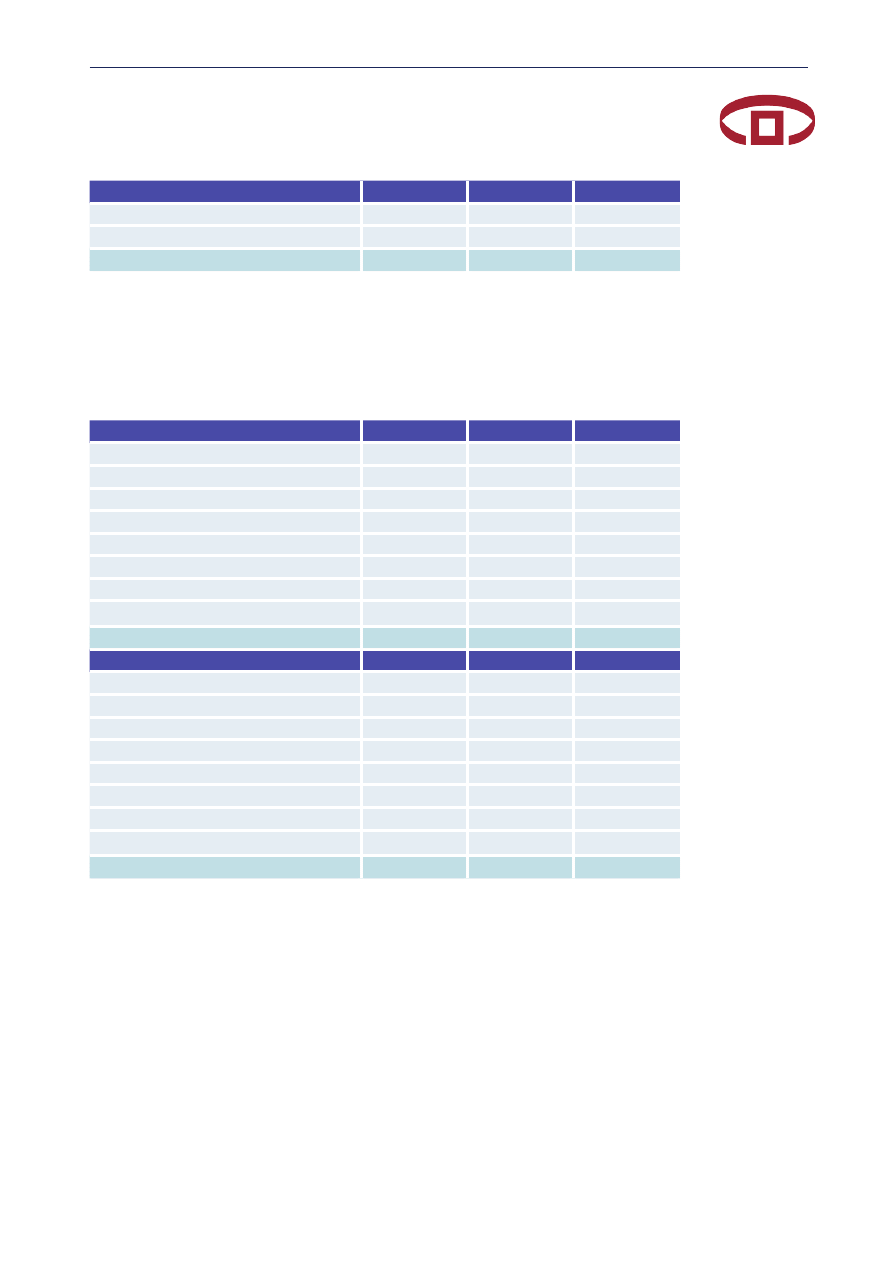
100
Balance sheet total
(at year-end)
HUF billion
Type of financial institution
2002
2003
2004
Bank and specialized credit institutions
10,195.6
12,860.0
14,926.4
Savings and credit cooperatives
779.1
923.4
1064.4
Financial institutions
10,974.7
13,783.4
15,990.8
The structure of assets and liabilities of the banking system (%)
(at year-end)
Assets
2002
2003
2004
Cash and settlement accounts
4.8
3.6
4.9
Securities for trading purposes
4.5
5.3
4.01
Securities for investment purposes
10.4
11.5
10.1
Central bank and inter-bank deposits
14.2
10.0
10.8
Credits
59.8
63.2
63.5
Proprietary interests
1.9
2.0
1.6
Own assets
1.9
1.8
2.0
Other assets
3.2
Balance sheet total
100.0
100.0
100.0
Liabilities
2002
2003
2004
Deposits
65.3
56.6
52.9
Inter-bank deposits
7.1
8.2
9.8
Borrowing
7.8
12.3
12.0
Dept securities
4.5
8.5
9.9
Subordinated liabilities
1.3
1.3
1.2
Special provisions
1.1
1.0
0.9
Own capital
8.7
8.5
8.9
Other liabilities
4.6
Balance sheet total
100.0
100.0
100.0
2004 DEVELOPMENTS IN THE HUNGARIAN BANKING SYSTEM
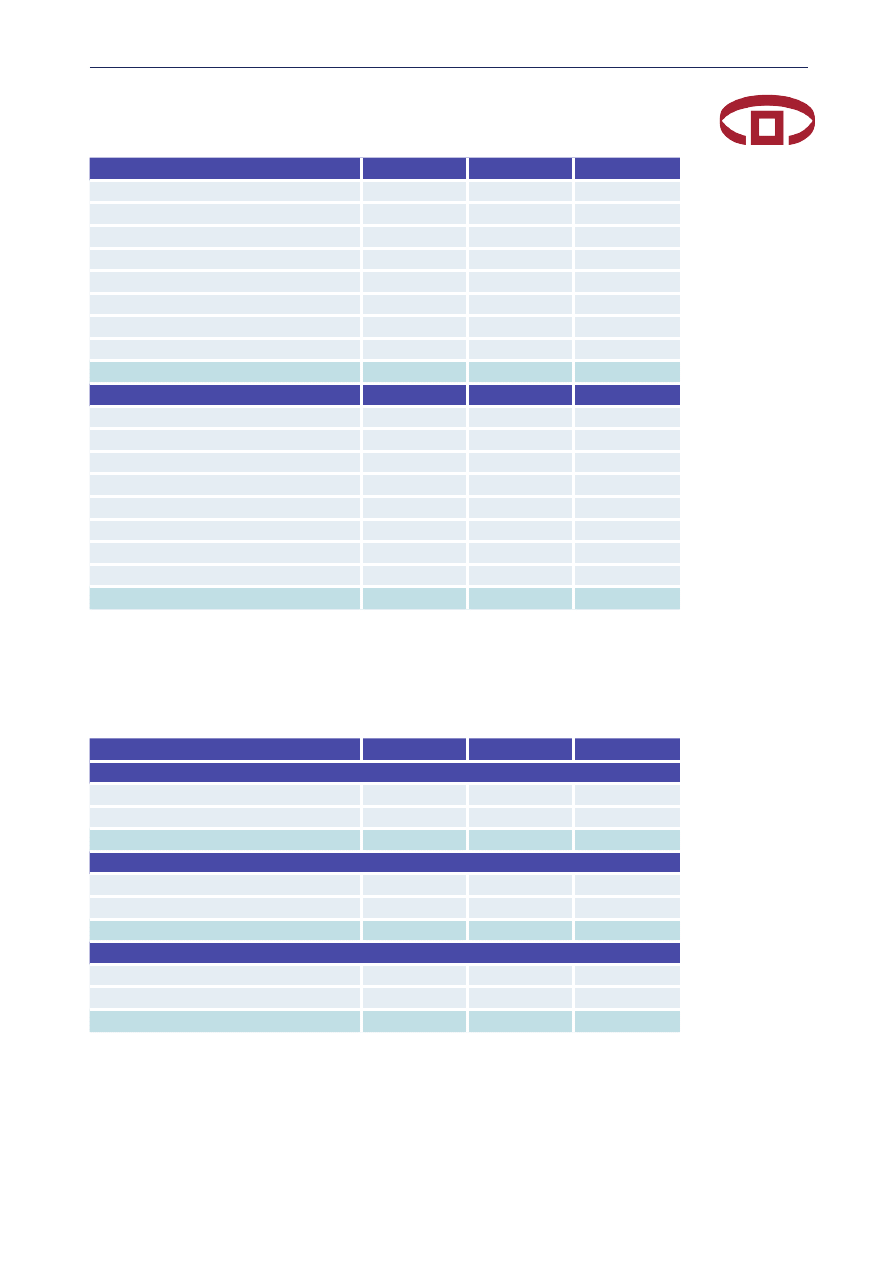
101
The structure of assets and liabilities of savings and credit cooperatives (%)
(at year-end)
Assets
2002
2003
2004
Cash and settlement accounts
5.9
5.9
5.3
Securities for trading purposes
29.0
26.5
23.0
Securities for investment purposes
6.1
5.8
5.3
Central bank and inter-bank deposits
12.7
11.9
12.5
Credits
40.5
44.2
47.2
Proprietary interests
0.3
0.3
0.7
Own assets
3.3
3.4
3.6
Other assets
2.2
2.2
2.5
Balance sheet total
100.0
100.0
100.0
Liabilities
Deposits
90.1
89.7
89.5
Inter-bank deposits
0.5
0.5
0.4
Borrowing
0.2
0.4
0.5
Dept securities
0.0
0.0
0.0
Subordinated liabilities
0.4
0.4
0.8
Special provisions
0.4
0.4
0.3
Own capital
6.4
6.6
6.7
Other liabilities
2.1
2.1
1.8
Balance sheet total
100.0
100.0
100.0
Development of off-balance sheet activities
Type of financial institution
2002
2003
2004
Balance sheet total (HUF billion)
Banks and specialized credit institutions
10,196
12,860
14,926
Savings and credit cooperatives
779
923
1,064
Financial institutions
10,975
13,783
15,990
Off balance sheet total (HUF billion)
Banks and specialized credit institutions
7,320
9,693
8,765
Savings and credit cooperatives
26
37
45
Financial institutions
7,346
9,730
8,810
Off balance sheet / balance sheet (%)
Banks and specialized credit institutions
71.8
75.4
58.7
Savings and credit cooperatives
3.4
4.0
4.2
Financial institutions
66.9
70.6
55.1
2004 DEVELOPMENTS IN THE HUNGARIAN BANKING SYSTEM
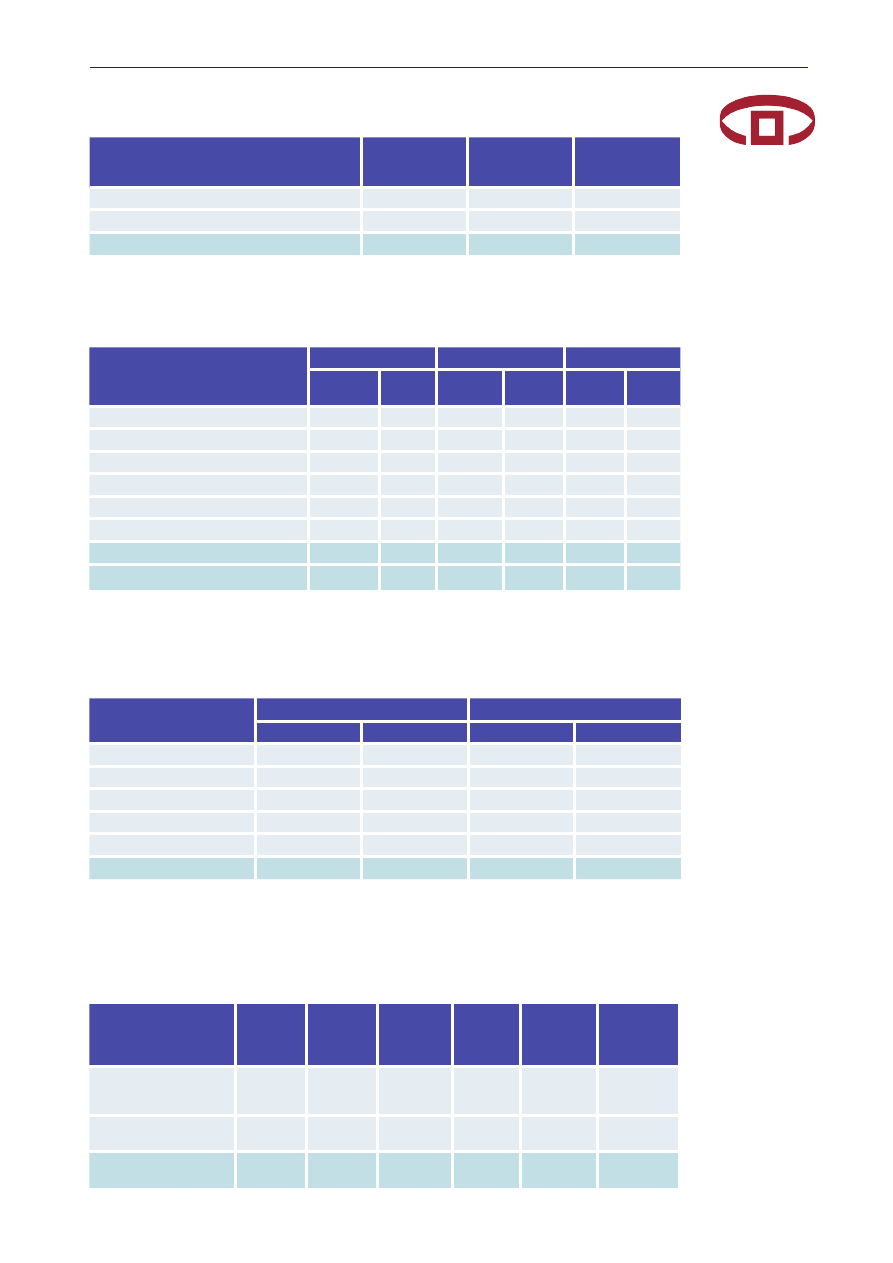
102
2004 DEVELOPMENTS IN THE HUNGARIAN BANKING SYSTEM
Solvency ratio of financial institutions
Type of the financial institution
Guaranteed
capital
(HUF billion)
Weighted
assets
(HUF billion)
Solvency
ratio (%)
Bank and specialized credit institutions
1,114.2
9,639.5
11.56
Savings and credit cooperatives
64.5
489.1
13.19
Financial institutions, average
1,178.7
10,128.6
11.64
Portfolio quality of the banking system
Asset classification
2002
2003
2004
HUF
billion
%
HUF
billion
%
HUF
billion
%
Problem free
13,516
92.8
18,863
94.6
19,601
94.8
Special mention
743
5.1
739
3.7
680
3.3
Non-performing
300
2.1
339
1.7
397
1.9
- substandard
142
1.0
166
0.8
202
1.0
- doubtful
78
0.5
82
0.4
79
0.4
- bad
80
0.6
92
0.5
116
0.5
Classified total
14,559
100.0
19,941
100.0
20,677
100.0
Specific reserves (HUF billion)
156
170.0
163
The structure of deposits and loans of banking system in 2004 (%)
(at year-end)
Deposits
Loans
HUF billion
%
HUF billion
%
Households
4,279.3
54.2
2,597.1
27.4
Government sector
265.4
3.4
278.4
2.9
Corporate
2,399.2
30.4
4,613.8
48.7
Foreign
490.3
6.2
429.4
4.5
Other
462.9
5.9
1,564.5
16.5
Total
7,897.1
100.0
9,483.2
100.0
Proportion of foreign exchange assets and liabilities in 2004 (HUF bn, %)
(at year-end)
Type of the
financial
institutions
FOREX
assets
Total
assets
FOREX
assets
/ Total
assets
FOREX
liab.
Total
liab.
FOREX
liabilities
/ Total
liab.
Bank and
specialized credit
institutions
5,006.6
14,926.4
33.5
4,096.0
14,926.4
27.4
Savings and credit
cooperatives
1.4
1,064.4
0.1
1.1
1,064.4
0.1
Financial
institutions
5,008.0
15,990.8
31.3
4,097.1
15,990.8
25.6
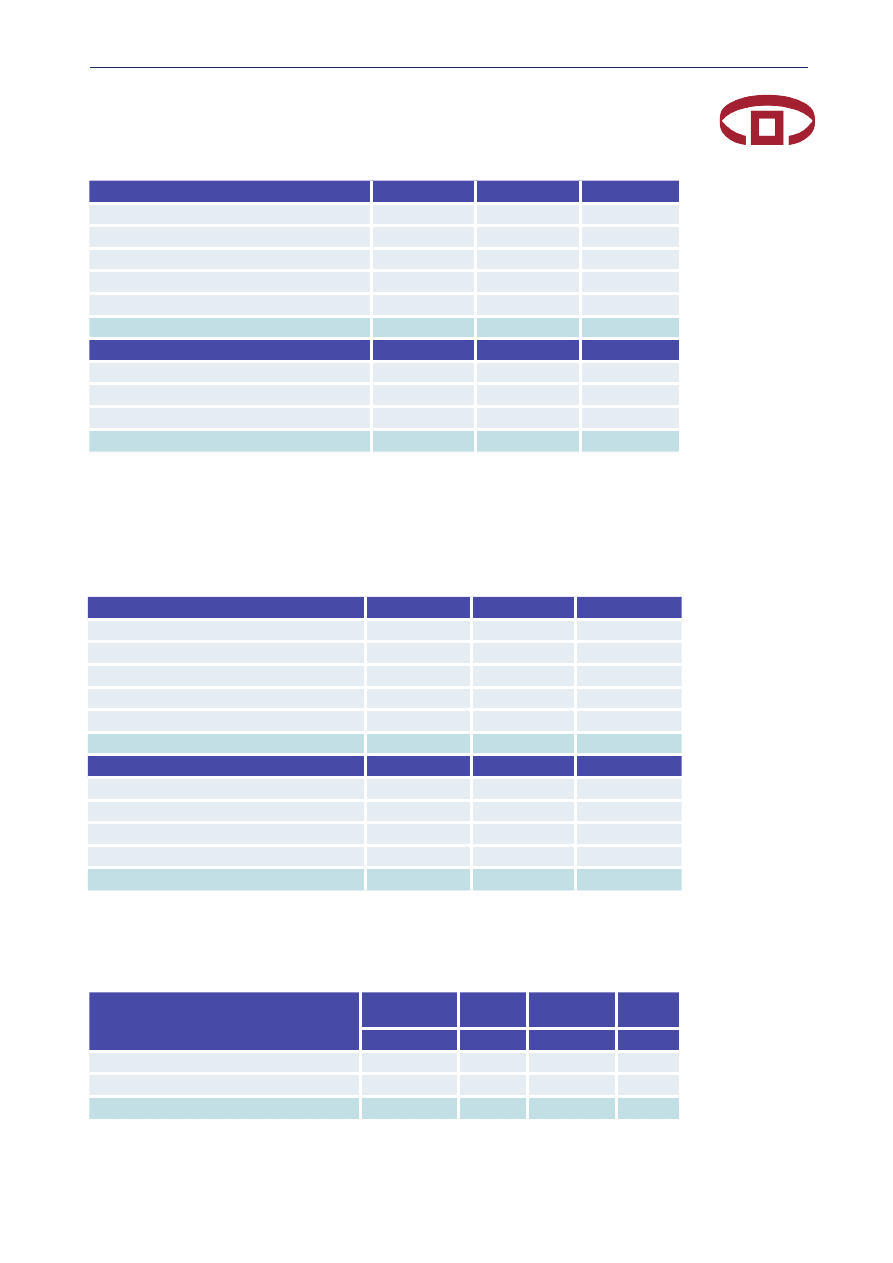
103
2004 DEVELOPMENTS IN THE HUNGARIAN BANKING SYSTEM
Structure of revenues and expenditures of the banking system
(at year-ends)
HUF bn
Revenues
2002
2003
2004
1. Interest income
846.4
1,045.4
1,440.6
2. Net non interest income
107.8
150.1
194.8
Of which: Net income from commissions
128.8
167.2
181.0
Dividends
8.3
12.8
15.7
3. Extraordinary income
8.6
12.6
3.5
Revenues total (1.+2.+3.)
1,099.9
1,388.1
1,835.6
Expenditures
2002
2003
2004
1. Interest expenditures
459.8
595.3
895.1
2. Overheads
341.9
387.9
416.3
3. Extraordinary expenditures
5.6
9.0
3.7
Expenditures total (1.+2.+3.)
807.3
992.2
1,315.1
Structure of revenues and expenditures of savings and credit cooperatives
(at year-ends)
HUF bn
Revenues
2002
2003
2004
1. Interest income
84.6
93.8
124.9
2. Net non interest income
4.0
3.0
6.9
Of which: Net income from commissions
10.1
12.3
14.2
Dividends
0.0
0.0
0.2
3. Extraordinary income
0.2
0.7
0.7
Revenues total (1.+2.+3.)
88.8
97.5
132.6
Expenditures
2002
2003
2004
1. Interest expenditures
41.4
41.7
68.8
2. Overheads
38.7
45.6
51.1
3. Extraordinary expenditures
0.1
0.2
0.6
4. Taxes paid
1.5
1.8
1.9
Expenditures total (1.+2.+3.)
81.8
89.3
122.5
Structure of registered capital and own funds of financial institutions in 2004
Type of the financial institutions
Registered
capital
/Total
assets
Own
funds
/Total
liab.
HUF bn
%
HUF bn
%
Bank and specialized credit institutions
384,963
2,6
1,323,827
8,9
Savings and credit cooperatives
16,3
1,5
71,5
6,7
Financial institutions
401,263
2,5
1,395,327
8,7

104
2004 DEVELOPMENTS IN THE LATVIAN
BANKING SYSTEM
MACROECONOMIC ENVIROMENT
In 2004, the robust economic growth of Latvia was supported by the strong
domestic and rising foreign demand. In terms of current prices, gross domes-
tic product (GDP) amounted to 7.4 billion lats, with real GDP exceeding last
year’s indicator by 8.5%.
In 2004, the annual average inflation in Latvia was 6.2%, with prices for
consumer goods rising at a faster pace (6.5%), but those for services increasing
by 5.6% on average. Annual consumer price inflation was 7.3%. In 2004, the
average monthly gross wage and salary and the average monthly net wage and
salary of persons employed in the national economy were LVL 211.06 and LVL
150.35, respectively. Compared with the previous year, the average gross wage
and salary increased by 9.6%, and the average net wage and salary rose by 8.9%.
The rise in wage and salaries exceeded the annual inflation rate; hence year-on-
year, the real gross wage rose by 3.2% and the real net wage by 2.5%.
In 2004, the general government consolidated budget posted a fiscal defi-
cit of 55.0 million lats or 0.7% of GDP based on the accrual principle used for
evaluating compliance with the Maastricht criterion. According to the cash
flow principle applied in central government budgeting, the general govern-
ment consolidated budget recorded a fiscal deficit of 79.0 million lats or 1.1%
of GDP, which was considerably lower than in 2003 (1.8% of GDP) and below
the projections (2.2% of GDP); it was achieved on account of better revenue
collections and moderate Government expenditure. Just as in 2003, the fiscal
deficit accumulated only at the end of the year and for the first eleven months
of the year the general government consolidated budget ran a surplus.
Despite the buoyant economic activity in 2004, the number of the unemploy-
ment registered with the State Employment Agency increased slightly (to 8.8%
of the total economically active population; 8.6% in 2003).
DEVELOPMENTS IN THE BANKING SYSTEM
At the end of 2004, 22 banks, the Latvian Branch of Nordea Bank Finland Plc
and 32 credit unions were registered in the Republic of Latvia.
At the end of 2004, the banks’ paid-up share capital amounted to 383.8
million lats (an increase of 24.7% over the end of 2003). Nearly all banking in-
dustry, except one bank is in private hands in Latvia. At the end of 2004, the
Government’s stake in the banking sector’s paid-up share capital was a mere
5.9%. The Latvian State is the sole owner of the JSC Latvijas Hipotēku un Zemes
banka. The share of foreign capital in the banks’ total paid-up share capital
increased slightly to 57.8% (53.9% at the end of 2003).

105
In 2004, all major bank performance indicators continued to grow rapidly,
including assets, which expanded by 37.3% (to 7 850.1 million lats), loans (in-
cluding transit credit) and deposits, which grew by 46.0% (to 4 380.6 million
lats) and 36.6% (to 5 094.3 million lats), respectively. A rise of 30.6% (to 629.2
million lats) was recorded in the banks’ equity.
In 2004, loans continued to gain importance in the structure of the banks’
assets, reaching 55.8% (including a 17.0% rise in lending to households), and
the share of claims on credit institutions also grew slightly (to 24.7%).
Compared to the end of 2003, the share of long-term loans granted to non-
banks (with a maturity of over 5 years) increased from 41.6% to 47.3% of the
loan portfolio, whereas the share of short-term loans (with a maturity over 1
year) declined from 20.3% to 16.5%.
In 2004, the share of non-banks deposits in the banks’ liabilities remained
broadly unchanged (64.9% at the end if 2004), whereas liabilities to banks grew
by 2.2 percentage points (to 21.1%).
Deposits received from non-banks by banks grew at a slower rate than loans
granted to non-banks in 2004. With the share of short-term deposits on total
deposits received by banks growing (from 20.1% to 22.5%), that of demand
deposits decreased (by 1.0 percentage point, to 72.2%). The share of medium-
term deposits (with a maturity of 1 year to 5 years) shrank by 1.2 percentage
points (to 4.8%).
In 2004, the assets of credit unions grew by 24.5% (to 4.9 million lats), loans
and deposits increased by 27.7% (to 4.1 million lats) and 21.6% (to 3.2 million
lats), respectively. Credit unions’ profit was 78.8 thousand lats (a year-on-year
increase of 34.5%). In 2004, their paid-up capital and reserves expanded by
33.2% (to 0.9 million lats) and 31.8% (to 1.2 million lats), respectively. Although
credit unions develop rather rapidly in Latvia, their impact in the financial
sector is yet insignificant.
THE LEGAL AND INSTITUTIONAL FRAMEWORK OF
OPERATIONS AND SUPERVISION OF FINANCIAL
INSTITUTIONS, NEW DEVELOPMENTS
In the reporting year the FCMC continued to harmonize banking legislation
and regulations with the requirements of the EU directives and the Basle Core
Principles for Effective Banking Supervision.
1. Amendments to the Law on Credit Institutions, according to which:
• The minimum capital adequacy requirement was reduced from 10% to
8%;
• The law was supplemented with a new type of credit institution – the
electronic money institution, whose sole purpose of operations is to
issue and service electronic money. The law stipulates the regulatory
norms governing the operations of such institutions. The law provides
an exception for electronic money institutions that do not plan to
issue more than five million euro in electronic money. These institu-
2004 DEVELOPMENTS IN THE LATVIAN BANKING SYSTEM

106
tions do not need to obtain a license from the Financial and Capital
Market Commission;
• In order to protect the rights of creditors and third parties in all of the
EU member states, the law was supplemented with norms that regulate
the reorganization, bankruptcy and liquidation of credit institutions.
The law specifies the roles of the competent authorities involved in
reorganisation measures or winding-up.
• The law was supplemented with norms that specify the principles for
supervision on a consolidated basis of banks that are subsidiaries of
the EU financial holding companies. It also specifies the co-operation
in exchange of information in involved supervisory institutions;
• The law specifies the requirements that credit institutions must meet,
when outsourcing accounting, internal audit function, the manage-
ment or development of information technologies and the provision
of financial services.
MAIN STRATEGIC OBJECTIVES OF THE FCMC IN 2004
1. The supervision of the Latvian financial and capital market by off-site
analysis and by conducting on-site examinations of market participants.
2. Improvements to Latvian legislative enactments and their harmonization
with EU requirements, with the recommendations of international finan-
cial supervisory authorities and with the best international best practices
in this field, so as to continue the smooth integration p of the Latvian
financial and capital market into the EU market.
The Commission’s Action Plan for 2004 and 2005 is available on the
Commission’s Internet home page at www.fktk.lv.
THE ACTIVITIES OF THE FCMC
IN THE FIELD OF BANKING SUPERVISION IN 2004
The Supervision Department, which comprises two divisions (the Banking and
Securities Market Division and the Insurance Division) is the largest depart-
ment of the Commission. Around half of the Commission’s budget is spent to
ensure the performance of functions of the Supervision Department.
The primary task of on-site examinations is to assess the financial stand-
ing and capital adequacy for supervised banks, as well as whether the internal
control system ensures overall risk evaluation and management. Timely detec-
tion of causes of potential problems and finding of preventative solutions dur-
ing examinations reduce a possibility for individual banks to default on their
obligations as well as the effects of potential problems on the entire financial
and capital market.
2004 DEVELOPMENTS IN THE LATVIAN BANKING SYSTEM

107
The analysis of financial statements of banks, in turn, allows the evaluation
of the financial standing, operational risks and their tendencies, as well as of
the conformity of operations with regulatory enactments. Conclusions from
these analyses were regularly submitted to the Commission’s Board, at which
priorities of supervisory activities were discussed with a view to reduce risks
inherent in operations of banks.
In 2003 the Commission started its work on developing a system that would
ensure a continuous and systematic evaluation of risks incurred by individual
market participants. This system, which is designed to assess risks, will also be
required for the implementation of the new Basel Capital Accord. This project
continued during 2004.
For the purpose of ensuring efficient supervision, providing for equal treat-
ment of all market participants, the Commission has formulated a Supervision
Manual, which establishes guidelines and procedures for conducting examina-
tions.
INTERNATIONAL ACTIVITIES OF THE FCMC
The European Union
Following Latvia’s accession to the European Union (EU) on May 1
st
, 2004,
the Commission continued the work that it had already begun in harmonizing
Latvia’s normative acts with EU directives. It also participated in the drafting
of new EU directives. In order to present a strong Latvian position and submit
recommendations concerning various draft EU normative acts affecting the fi-
nancial and capital market, and which were reviewed last year at the European
Council’s ECOFIN and COREPER meetings, the Commission prepared Latvia’s
national positions and drafted instructions. Within the spheres of its compe-
tence, the Commission also reviewed and evaluated draft positions and instruc-
tions prepared by other Latvian institutions.
International organizations
During the reporting year the Commission continued to cooperate with such
international organizations as the Group of Banking Supervisors from Central
and Eastern Europe, the World Bank and the International Monetary Fund.
Commission experts also took part in meetings of the Selected Committee of
Experts on the Evaluation of Anti-Money Laundering Measures (MONEYVAL).
The Commission also cooperated with foreign financial market supervisory in-
stitutions to prevent the use of Latvia’s financial market for money laundering
purposes.
Following Latvia’s accession to the EU, the Commission became a party of
several European agreements. It signed the Memorandum of Understanding on
Co-operation Between Payment Systems Overseers and Banking Supervisors
in Stage Three of Economic and Monetary Union, the Memorandum of
2004 DEVELOPMENTS IN THE LATVIAN BANKING SYSTEM

108
Understanding on High-level Principles of Co-operation Between the Banking
Supervisors and Central Banks of the European Union in Crisis Management
Situations.
Foreign financial market supervisory institutions
The Commission expanded its sphere of co-operation with foreign finan-
cial market supervisory institutions and has reached an agreement with the
Federal Bank Commission of Switzerland on exchange of information. In to-
tal Commission have been signed 18 agreements with other financial market
supervisory institutions.
COOPERATION WITH OTHER SUPERVISORY BODIES
The FCMC is a unified supervisory authority for the financial sector in Latvia.
2004 DEVELOPMENTS IN THE LATVIAN BANKING SYSTEM

109
2004 DEVELOPMENTS IN THE LATVIAN BANKING SYSTEM
ORGANIZATIONAL CHART OF THE FCMC
Public Relations Division
Chairman
Deputy Chairman
IT Division
Internal Auditor
Finance Division
Personnel Division
Record Keeping Division
General Service Division
Banking
and
Securities
Market
Division
Insurance
Division
Legal
Division
Licensing
Division
Regu-
lations
Division
Statistics
and
Analysis
Division
Supervision Department
Legal and Licensing
Department
Regulations and
Statistics Department
Board of the Commision*
Consultative Council**
* The Board consists of five Board members Chairman of the Commission, Deputy Chairman of the Commission
and three Board members, who are simultaneously directors of the departments of the Commission.
** The Consultative Council of the Financial and Capital Market is formed on a parity basis from representatives
of the Commission and heads of professional organisations of financial and capital market participants.

110
STATISTICAL TABLES
Number of financial institutions
(at year-ends)
Type of financial institution
2002
2003
2004
Banks
22
22
22
Credit unions
26
28
32
Foreign bank branches
1
1
1
Financial institutions, total
49
51
55
Ownership structure of banks on the basis of registered capital (%)
(at year-ends)
Item
2002
2003
2004
Public sector ownership
7.3
6.3
5.9
Other domestic ownership
38.3
39.8
36.3
Domestic ownership total
45.6
46.1
42.2
Foreign ownership
54.4
53.9
57.8
Banks, total
100.0
100.0
100.0
Ownership structure of banks on the basis of assets total (%)
Item
2002
2003
2004
Public sector ownership
4.0
4.1
4.0
Other domestic ownership
49.2
46.3
47.4
Domestic ownership total
53.2
50.4
51.4
Foreign ownership*
46.8
49.6
48.6
Banks, total
100.0
100.0
100.0
*
Banks with foreign ownership >50% and foreign bank branch
Concentration of assets in 2004 (%)
The first three largest
The first five largest
Banks
49.1
62.4
2004 DEVELOPMENTS IN THE LATVIAN BANKING SYSTEM

111
Return on assets (ROA) (%)
2002
2003
2004
Banks
1.5
1.4
1.7
Return on equity (ROE) (%)
2002
2003
2004
Banks
16.4
16.7
21.4
Distribution of market shares in balance sheet total (%)
Type of financial institution
2002
2003
2004
Banks
96.0
95.4
94.9
Foreign bank branches
4.0
4.6
5.1
Financial institutions, total
100.0
100.0
100.0
The structure of assets and liabilities of the banking system (%)
(at year-end)
Assets
2002
2003
2004
Cash and balances with the Bank of Latvia
5.7
4.5
4.6
Claims on credit institutions
25.2
23.2
24.7
Loans
48.1
52.5
55.8
Bonds and other fixed interest securities
15.6
15.3
11.2
Shares and other variable yield securities
0.7
0.3
0.2
Participating interest and other financial
investments
0.6
0.6
0.7
Other assets
4.1
3.6
2.8
Liabilities
2002
2003
2004
Amounts owed to the Bank of Latvia
0.7
1.0
0.2
Amounts owed to credit institutions
14.4
18.9
21.1
Deposits
69.4
65.3
64.9
Other liabilities
5.5
5.2
4.7
Provisions
1.3
1.2
1.1
Total equity
8.7
8.4
8.0
2004 DEVELOPMENTS IN THE LATVIAN BANKING SYSTEM

112
2004 DEVELOPMENTS IN THE LATVIAN BANKING SYSTEM
Development of off-balance sheet activities (%)
(off balance sheet items / balance sheet total)
2002
2003
2004
Banks (incl. foreign bank branch)
9.6
12.4
11.6
Capital adequacy of banks (%)
2002
2003
2004
Banks
13.1
11.7
11.7
Asset portfolio quality of the banking system (%)
Asset classification
2002
2003
2004
Standart
97.1
97.6
98.0
Watch
0.9
1.0
0.9
Substandart
0.9
0.6
0.5
Doubtful
0.7
0.5
0.3
Lost
0.4
0.3
0.3
Classified total
100.0
100.0
100.0
Specific provisions
1.5
1.2
1.1
The structure of deposits and loans in 2004 (%)
(at year-end)
Deposits
Loans
Households
24.5
29.9
Government sector
2.5
1.5
Corporate
18.3
54.8
Other
0.7
0.6
Foreign
54.0
13.2
Total
100.0
100.0
The structure of deposits and loans in 2004 (%)
(at year-end)
Maturity of deposits
Maturity of loans
At sight
72.2
Long term loans
47.4
Within one year
22.5
Medium-term loans
36.1
Over one year
5.3
Short-term loans
16.5
Total
100.0
Total
100.0

113
Proportion of foreign exchange assets and liabilities (%)
(at year-ends)
FOREX assets / Total assets
FOREX liabilities / Total liabilities
2002
2003
2004
2002
2003
2004
Banks (incl. foreign
bank branch)
64.2
65.2
68.8
65.6
65.0
68.6
Structure of revenues and expenditures of the banking system (%)
(at year-ends)
Revenues
2002
2003
2004
Interest income, incl.:
57.2
54.3
58.1
interest on loans
40.4
39.4
43.3
interest on deposits with credit
institutions
5.5
4.4
5.4
interest on bonds and other fixed
income securities
9.6
9.5
8.0
other
1.7
1.0
1.4
Dividends
0.1
0.04
0.04
Commission received
24.6
25.6
24.4
Profit/loss from securities and currencies
trading
10.4
11.2
10.0
Other
7.7
8.8
7.5
Expenditures
2002
2003
2004
Interest expense
29.1
25.8
28.0
Commission paid
5.6
6.4
6.5
Operating expenses
42.8
43.6
44.3
Depreciation
8.4
7.7
6.8
Loan loss provision expense
8.5
8.9
7.6
Other
5.6
7.6
6.8
Structure of registered capital and own funds of banks in 2004
in thousand of EUR
Registered capital
/Total assets
Own funds
/Total liabilities
EUR
%
EUR
%
Banks
546,100
4.9
835,545
7.5
2004 DEVELOPMENTS IN THE LATVIAN BANKING SYSTEM

114
2004 DEVELOPMENTS IN THE
LITHUANIAN BANKING SYSTEM
MACROECONOMIC ENVIROMENT
The growth of the Lithuanian economy that started in 2000 continued and was
reflected by 6.7 per cent growth of the Gross Domestic Product (GDP) in 2004.
Further progress of the Lithuanian financial system and economic growth were
positively evaluated by the largest international rating agencies. At the begin-
ning of 2004 the rating agency Fitch upgraded their rating for long-term loans
in foreign currency from BBB to BBB+. Standard&Poor’s also reviewed their
rating and issued Lithuania a long-term borrowing in foreign currency rating
A- instead of the previous BBB+; Moody’s, accordingly, upgraded the credit
rating to A3.
In its 2004 annual report on Lithuania, Moody’s Investors Service said its A3
country-ceiling credit rating for foreign currency debt, foreign bank deposits,
and government bonds was based on advanced economic and financial integra-
tion with Western Europe – an integration that was further enhanced by mem-
bership in both NATO and the European Union earlier in the year. Lithuania’s
investment-grade credit rating and its positive outlook were also supported by
the continued strengthening of public sector finances, which were underpinned
by steady reforms in the tax system, municipal finances, and pension and health
sectors. Moreover, entry to the Economic and Monetary Union, which could
occur as early as in 2007 now that the country is in ERM II, reduces concerns
about possible external payment disruptions. The pace of economic activity
remains brisk, fuelled by EU-related financing and rapid credit expansion.
The development of the domestic economy depends to a significant extent on
the expansion of foreign trade. According foreign trade balance data, Lithuanian
exports increased last year by approximately 27 per cent, and imports by 14 per
cent. The trends of Lithuania’s export to both old and new EU Member States
remained on the upside in 2004. Exports to EU-15 countries in 2004 made up
about 49 per cent of the domestically produced output and services (in 2003
this market accounted for 42 per cent of the total export of goods). Last year
Lithuanian exports to the new EU-10 Member States amounted to 20 per cent
of the total export of the country. Trade with the CIS countries occupied a rather
significant place, however, for several years in turn exports to these countries
were declining (in 2003 these exports made up 17 per cent, in 2004 15 per cent
of the production), partially due to an unfavourable customs policy and political
uncertainty in relation to these countries. The largest part of exports consisted
of mineral products, re-exported vehicles, agricultural and textile products.
The main trade partners included France with a 10.7 per cent share in total
exports, Germany (10.2%) and Russia (9.0%). As to imports, most goods, again,
were imported from EU-25 countries (54.5% of the total imports of goods); CIS
countries ranked second with a 34.0 per cent share in the total import value.

115
Developments in the GDP structure in 2004 showed that most of the value
added was created in the manufacturing and domestic retail sectors. A higher-
than-average growth rate was also recorded in transport, storage and commu-
nications, and hotels and restaurants sectors. Continuing economic expansion
and new labour mobility opportunities following EU accession determined
rising employment and higher average wages and salaries. Average annual
unemployment ratio declined from 12.4 to 11.4 per cent, average monthly wage
increased by 8.5 per cent. On the other hand, in the context of growing energy
prices, inflation reached 2.9 per cent after a longer period of lower inflation;
thus, prices on food products rose by 5 per cent, transport services by 5.4 per
cent, and house maintenance expenses by 3.7 per cent.
In 2004, the banking sector preserved the tendencies of stability and growth,
banking assets to real GDP ratio grew from 39.5 to 47.1 per cent. Banks imple-
mented modern information technologies, developed e-services and provided
customers with more sophisticated financial products via their subsidiary com-
panies. Although borrowing demand remained high in the light of the continu-
ing consumer activity, interest rates on loans stood at record-low levels (for
example, the average annual interest rate on mortgage loans in the national
currency for residents at the end of 2003 was 4.57 per cent, and at the end of
2004 4.47 per cent).
DEVELOPMENT OF THE BANKING SYSTEM
In late 2004, the Lithuanian banking system consisted of:
• 10 commercial banks with 118 branches in different regions throughout
the country;
• 2 branches of foreign banks;
• 3 representative offices of foreign banks.
In addition, the Bank of Lithuania had received 48 notifications from the fi-
nancial services supervisory authorities of various EU countries informing about
the intentions of credit institutions supervised by them to exercise the freedom
to provide services and start activities in Lithuania without establishing local
subdivisions (branches). For the most part, these were banks from the United
Kingdom (18 banks), Austria (9 banks), and Germany (8 banks).
By the end of 2004, foreign investor-owned capital (mostly Scandinavian and
German) prevailed in the domestic banking sector, the share of which comprised
87.3 per cent. Domestic banks continued to strengthen their capital base last
year, thus creating preconditions for their further development: 4 banks reg-
istered a higher share capital, 3 banks were permitted to include subordinated
loans in Tier II capital.
Investment by financially strong foreign strategic partners contributed to the
strengthening of the Lithuanian banking system. In 2004, the share capital of the
banking system increased by 8.6 per cent and reached EUR 388 million. Banks
continued organisational structure reforms in order to use more effectively the
resources and increase their efficiency under the conditions of growing compe-
tition and at the same time hold the current position in the market and ensure
2004 DEVELOPMENTS IN THE LITHUANIAN BANKING SYSTEM

116
further business development. The assets of the domestic banks made up EUR
8.4 billion at the end of 2004, increasing over the year by 32.3 per cent.
The result of banks’ performance in 2004 was a profit of EUR 86.7 million
that was the best during the banking history from the reestablishment of in-
dependence. This shows that consistent increase of bank operating efficiency,
use of progressive information technologies, improvement of loan portfolio
and development of new financial services has yielded positive results, banks
have successfully adjusted to the increasing market competition and increased
their profitability, although the real interest margin has been gradually declin-
ing over the past few years.
The analysis of banking performance in 2004 allows distinguishing several
main business segments, which, compared to 2003, had a positive effect on
bank profitability. Bank results were primarily influenced by income generated
from the growing loan portfolio. Such income was the main factor behind the
increase in net interest income by 21.7 per cent. In addition, a wider range of
services and higher fees on services in some banks resulted in the increase of
net income from services and commissions of 14.6 per cent. Rapid economic
development of the country as well as the growing popularity of leasing and in-
surance services had a positive impact on the business results of bank subsid-
iaries. In 2004, banks earned 2.8 times higher profits from investment in the
equity of these companies. The growth of bank net profit was slowed down to
some extent last year by the increased expenditure on specific provisions re-
lated to the rapid growth of the loan portfolio of the banking system. Moreover,
the growing volume of deposits in banks resulted in higher expenses on deposit
insurance contributions. At the end of last year domestic banks held EUR 5.2
billion of deposits, of which EUR 2.8 billion were deposits of natural persons.
The total amount of deposits increased over the year by 31.6 per cent, and
deposits of natural persons grew by 24.4 per cent.
Last year, banks continued to abandon certain activities and purchased
bank ancillary services from third parties, reducing in this way the number of
employees. In 2004, the number of bank employees went down by 5.7 per cent,
yet the effect of this process on the operating expenses was not that noticeable
as they declined by a mere 1.1 per cent. These results were related to the further
development of the bank network.
Owing to ongoing economic expansion, favourable economic expectations
and low interest rates, loan demand has remained high, although the loan port-
folio growth rate subsided somewhat in comparison with 2003. The share of
the loan portfolio in total banking assets that increased to 58 per cent confirms
that credit risk remains the most important of risks faced by banks.
The total loan portfolio in 2004 increased 1.4 times and reached EUR 4.9
billion. A further increase of long-term loans was supported by favourable bor-
rowing conditions, positive evaluation of business development prospects after
accession to the EU, growing purchasing power of individuals and government
policy supporting lending for house purchase through the application of per-
sonal income tax exemptions. The amount of long-term loans granted to private
companies, compared to 2003, increased 1.4 times, and loans to individuals
went up as much as 1.9 times.
2004 DEVELOPMENTS IN THE LITHUANIAN BANKING SYSTEM

117
In 2004, the concentration in the banking sector slightly declined, while
three largest banks predominated in the market. These banks held 68 per cent
of the banking system assets and 75 per cent of individual deposits; they granted
almost 74 per cent of the banking sector loans to private enterprises.
LEGAL AND INSTITUTIONAL FRAMEWORK FOR THE
SUPERVISION OF FINANCIAL INSTITUTIONS
As stated in the Law on the Bank of Lithuania, the Bank of Lithuania supervises
the activities of credit institutions holding a licence of the Bank of Lithuania
according to the procedure provided for by laws and other legal acts. The
supervision of the activities of credit institutions which hold a licence of the
Bank of Lithuania consists of:
(1) licensing – consideration of applications for issuing licences, permissions
and consents established by laws, and adoption of decisions, as well as
other activities related thereto;
(2) collection and analysis of information obtained for the purposes of su-
pervision in the form of reports, as well as assessment of activities of
credit institutions and their financial situation on the basis of the said
information, taking into account prudential and other requirements of
the activities of credit institutions established by legal acts;
(3) inspection of the activities of credit institutions — verification of the cor-
rectness of the compilation of financial reports presented to the Bank of
Lithuania and assessments of the activities and financial situation (capital,
quality of assets, profitability) of credit institutions, as well as assessment
of the efficiency of the management of risks (credit, liquidity, market,
operational, others) and of the management of a credit institution;
(4) application of enforcement measures prescribed by laws to credit insti-
tutions.
In performing supervision of the activities of credit institutions, the Bank of
Lithuania has the right to:
(1) receive information necessary for the performance of the supervisory func-
tion from state institutions, credit institutions, their subsidiaries, as well
as from other enterprises, institutions and organisations;
(2) inspect (examine) credit institutions holding a licence issued by the
Bank of Lithuania, and, in the cases established by laws, other persons
as well;
(3) in the cases and manner established by laws, apply enforcement meas-
ures to credit institutions and other persons holding a licence issued by
the Bank of Lithuania; and
(4) take measures in order to ensure efficient operation of the credit
system.
2004 DEVELOPMENTS IN THE LITHUANIAN BANKING SYSTEM

118
The information received by the Bank of Lithuania for the purposes of
supervision of credit institutions may not be disclosed publicly, released to
anyone or made public in any other way, except in the cases specified by the
laws regulating the activities of credit institutions.
Ongoing supervisory functions are performed by the Credit Institutions
Supervision Department, a structural unit of the Bank of Lithuania. The Board
of the Bank of Lithuania is empowered to resolve issues pertaining to the
issuance and revocation of licenses, permissions, consents to credit institutions,
to apply enforcement measures established by laws to credit institutions, to
decide on issues regarding initiation of bankruptcy proceedings against credit
institutions, etc.
MAIN STRATEGIC OBJECTIVES OF THE BANKING
SUPERVISORY AUTHORITY IN 2004
In 2004, the Bank of Lithuania continued to focus on the implementation of a
credit institution supervisory framework conforming to the international prac-
tice, encouraging banks to improve their internal control systems, adequately
assess, control and manage traditional risks and identify in due time the emerg-
ing problems, as well as provide for measures to be undertaken in order to main-
tain the stability of banking activity under unfavourable market conditions. The
main goals for the year 2004 were as follows:
• Seeking soundness, transparency and competitiveness of the domestic
banking system.
• Improving the legal regulatory framework and aligning national legisla-
tion with the requirements of EU directives.
• Preparing for implementation of the provisions of the new EU Capital
Requirements Directive (CAD III) provisions in Lithuania;
• Implementing risk-focused on-site inspection; during inspections, focus-
ing on the assessment of credit, liquidity, market, operational and other
risk management effectiveness, introducing assessment of other areas
(real estate assessment, mortgage credit, etc.).
• Improving off-site monitoring and assessment of operations of credit
institutions, continuing and improving stress testing of individual banks
and the banking system.
• Expanding and strengthening co-operation with respective foreign finan-
cial sector supervisory authorities by exchanging the information neces-
sary to ensure effective banking supervision.
KEY ACTIVITIES OF THE BANKING SUPERVISORY
AUTHORITY IN 2004
In performing the function of the supervision of credit institutions, in 2004
the Bank of Lithuania focused on the regulation of risk management processes
in banks and improvement of internal control systems, encouraging banks to
2004 DEVELOPMENTS IN THE LITHUANIAN BANKING SYSTEM

119
adequately assess, control and manage traditional risks and to identify in due
time the problems arising in the provision of banking services, as well as be
prepared to operate in emergency situations.
The year 2004 was characterised by a large number of amendments intro-
duced to legal acts regulating bank operation stemming from Lithuania’s mem-
bership of the EU and in line with the new provisions of the Law of the Republic
of Lithuania on Banks and the Law on the Bank of Lithuania. Seeking to ensure
realisation of a simplified market entry procedure for the banks outside the ju-
risdiction of the EU Member States that wish to start operating in our country,
amendments to some rules regulating licensing procedures were introduced.
In addition, the procedure for the establishment of the banks of the Republic of
Lithuania and associated financial undertakings and/or the provision of financial
services in another EU Member State without establishing a branch as well as
the procedure for the implementation of the right to provide financial services in
the Republic of Lithuania by foreign banks licensed in other EU Member States
and financial undertakings under their control were defined.
Taking into account the changed conditions of banking activities after EU
accession and the development of the banking sector, amendments to the calcu-
lation of the capital adequacy ratio were adopted in 2004. In order to establish
equal competitive conditions for the banks of Lithuania in the EU environment,
the capital adequacy ratio applied to the banks of the Republic of Lithuania was
reduced from 10 to 8 per cent and the maximum open position ratio in foreign
currency and precious metals was changed by establishing an unlimited euro
position held by banks.
In 2004, the Bank of Lithuania updated a number of legal acts on account-
ing and accountability, including the Rules on Consolidation of Financial Group
Accounts and Joint (Consolidated) Supervision. The rules specify that the pro-
cedure of consolidated supervision performed by the Bank of Lithuania will
depend on whether the parent bank of the financial group or the financial hold-
ing company falls under the jurisdiction of an EU Member State or the jurisdic-
tion of a third country. In addition, new Rules for Supervision of Foreign Bank
Branches Operating in the Republic of Lithuania were approved. These rules
establish different supervisory conditions for foreign bank branches licensed in
the EU Member States and foreign bank branches licensed in the third countries
other than the EU Member States.
The Bank of Lithuania continued to focus considerable attention on strength-
ening risk management processes in banks in 2004. Considering the recent
trends in the operations of domestic banks related to abandoning certain
activities (e.g. security, cash collection, information system maintenance, and
software development) and concluding agreements with third parties with
regard to outsourcing bank ancillary services, and in order to ensure stability and
reliability of bank operation after the conclusion of such agreements as well as
avoid obstacles for the supervisor to perform its functions effectively, the Rules
for Outsourcing Bank Ancillary Services were approved. They define certain key
principles to be followed by banks as they enter into such agreements.
The Bank of Lithuania has initiated the implementation of a new concept of
the centrally managed Loan Risk Database in 2004 in order to improve credit
risk management and to provide possibilities for banks for gradually intro-
2004 DEVELOPMENTS IN THE LITHUANIAN BANKING SYSTEM

120
ducing internal borrower rating systems, as recommended in the New Capital
Accord and relevant EU directives. Subsequent to the planned changes, bor-
rowers will be classified into separate categories by the nature of their business
and information will be collected about cases of default on the basis of estab-
lished criteria. Later on, the collected information will enable computing the
probability of defaults which is necessary in preparing for the introduction of
internal rating models.
One of the key tasks of the Bank of Lithuania in the area of supervision of
credit institutions in 2004 was the preparation for the implementation of the
New Basel Capital Accord and the new European Union Capital Directive. To
this end, the Bank of Lithuania organised a number of meetings with bank rep-
resentatives to assess the level of preparation of banks for the implementation of
the new capital requirements, especially when assessing credit and operational
risk, to draw the attention of banks to the essential aspects of these require-
ments, and to identify the key problems and the intentions of banks to move to
more complex capital requirement calculation methods in the future. In addi-
tion, domestic banks were requested to carry out preparatory work for the capi-
tal adequacy calculation on the basis of the former and new requirements yet to
be implemented. At the end of 2004, the Bank of Lithuania started developing
the procedure for the calculation of capital adequacy under the requirements
of the new EU Capital Directive with respect to the planned calculations in the
transitional period.
Taking into consideration progressive practices of foreign supervisory
authorities, the Bank of Lithuania has continued to enhance supervisory methods
and tools. In 2004, the Bank of Lithuania reviewed its inspection procedures as
one of the key tools of ongoing supervision. The previous CAMELS rating-based
inspection methodology was replaced by the risk-focused inspection system.
The general inspection focuses on bank management and internal control,
the efficiency of the risk management system in the key risk areas, including
credit, liquidity, market and operational risks, to allow timely identification,
assessment, monitoring and management of the risks, while targeted inspec-
tions focus on particular areas requiring special attention.
INTERNATIONAL ACTIVITIES AND CO-OPERATION WITH
OTHER SUPERVISORY BODIES
In 2004, considerable attention was given to issues of cross-border co-opera-
tion. Representatives of the Bank of Lithuania participated as full members in
the work of various EU institutions and ECB working groups, discussing fur-
ther the issues related to changes in the operation of the banking sector and
supervisory institutions in the context of the implementation of the common
supervisory standards in line with the provisions of the new EU Capital Directive
and the New Basel Capital Accord. Discussions in the working groups included
such issues as cross-border supervision of financial groups, crisis management
policy, convergence of supervisory practices under the provisions of the new EU
Capital Requirements Directive, harmonisation of the international accounting
and audit standards with EU law, etc.
2004 DEVELOPMENTS IN THE LITHUANIAN BANKING SYSTEM

121
Last year, the Bank of Lithuania further strengthened co-operation with
foreign financial sector supervisory authorities. An agreement on co-operation
with the Swedish Financial Supervisory Authority was signed in early 2004; its
representatives later visited the Bank of Lithuania to discuss issues related to
the application of new capital requirements.
Such co-operation agreements were signed earlier with the respective super-
visory authorities of Poland, Finland, Latvia, Estonia, Germany, Russia, and
Belarus. These agreements provide for co-operation principles in performing
joint bank supervision on the international level, including licensing require-
ments and capital ownership control, on-site inspections, subsidiary control,
application of prudential requirements, principles for mutual exchange of infor-
mation, and general actions in supervising banks or bank branches established
in each country. Representatives of the National Bank of Ukraine visited the
Bank of Lithuania in 2004 to get acquainted with the Lithuanian banking sys-
tem, various aspects of the organisation of banking supervision and applicable
supervisory requirements.
In view of the strengthening relations between the financial sector and the
insurance sector and their influence on the business of credit institutions, the
Bank of Lithuania continued close co-operation with other financial and insur-
ance supervisory authorities of Lithuania. This co-operation was coordinated
by the Commission for the Regulation of the Business of Financial Institutions
and Coordination of Supervision, which was set up in 2003. The Commission
includes representatives of all the three financial and insurance supervisory
authorities of Lithuania. The Commission, in consultation with the representa-
tives of banks, other financial institutions and insurance undertakings, seeks to
ensure a more efficient coordination and improvement of the supervisory pro-
cesses in individual sectors of the Lithuanian financial market, development of
a supervisory strategy and identification of its priorities; it submits proposals
to the Seimas (Parliament) on the amendments to the laws and other legal acts
regulating the provision of financial and insurance services, the business and
the supervision of financial institutions and insurance undertakings.
2004 DEVELOPMENTS IN THE LITHUANIAN BANKING SYSTEM

122
THE STRUCTURE OF CREDIT INSTITUTIONS
SUPERVISION DEPARTMENT OF THE BANK OF
LITHUANIA AT THE END OF 2004
2004 DEVELOPMENTS IN THE LITHUANIAN BANKING SYSTEM
Deputy Director
Deputy Director
Deputy Director
Director
On-site
Inspection
Division
Licensing
Division
Non-bank
Credit
Institutions
Division
Methodo-
logy and
Information
Division
Off-site
Monito-
ring
Division
Banks
Financial
Analysis
Subdivision
Early
Warning
Subdivision

123
STATISTICAL TABLES
Number of financial institutions
(at year-end)
Type of financial institution
2002
2003
2004
Commercial banks
10
10
10
Foreign bank branches
4
3
2
Credit unions
54*
58*
62
*
including Central Credit Union
Ownership structure of financial institutions on the basis
of registered capital (%)
(at year-end)
Item
2002
2003
2004
Public sector ownership
0.5
0.3
0.2
Other domestic ownership
11.5
11.7
13.7
Domestic ownership total
12.0
12.0
13.9
Foreign ownership
88.0
88.0
86.1
Financial institutions, total
100.0
100.0
100.0
*
registered capital of a foreign bank branch is funds of this branch received from the headquarter with the pur-
pose to commence the branch operations
Ownership structure of financial institutions on the basis of assets total (%)
(at year-end)
Item
2002
2003
2004
Public sector ownership
N/a
N/a
N/a
Other domestic ownership
N/a
N/a
N/a
Domestic ownership total
87.0
89.1
84.4
Foreign ownership
13.0
10.9
15.6
Financial institutions, total
100.0
100.0
100.0
2004 DEVELOPMENTS IN THE LITHUANIAN BANKING SYSTEM

124
Concentration of assets by the type of financial institutions in 2004 (%)
(at year-end)
Type of institutions
The first three largest
The first five largest
Banks
67.6
79.5
Credit unions
28.9
34.9
Financial institutions
-
-
Savings cooperatives
-
-
Specialized credit institutions
-
-
Return on assets (ROA) by the type of financial institutions
(at year-end)
Type of institutions
2002
2003
2004
Banks
0.93
1.26
1.20
Credit unions *
0.65
0.71
0.52
Financial institutions
-
-
-
Savings cooperatives
-
-
-
Specialized credit institutions
-
-
-
* Without Central Credit Union
Return on equity (ROE) by the type of financial institutions
(at year-end)
Type of institutions
2002
2003
2004
Banks
9.8
13.37
13.52
Credit unions*
4.9
5.5
4.85
Financial institutions
-
-
-
Savings cooperatives
-
-
-
Specialized credit institutions
-
-
-
* Without Central Credit Union
Distribution of market shares in balance sheet total (%)
(at year-end)
Type of financial institution
2002
2003
2004
Commercial banks
92.2
90.7
89.5
Foreign bank branches
7.4
8.6
9.7
Credit unions
0.4
0.7
0.8
Financial institutions, total
100.0
100.0
100.0
2004 DEVELOPMENTS IN THE LITHUANIAN BANKING SYSTEM
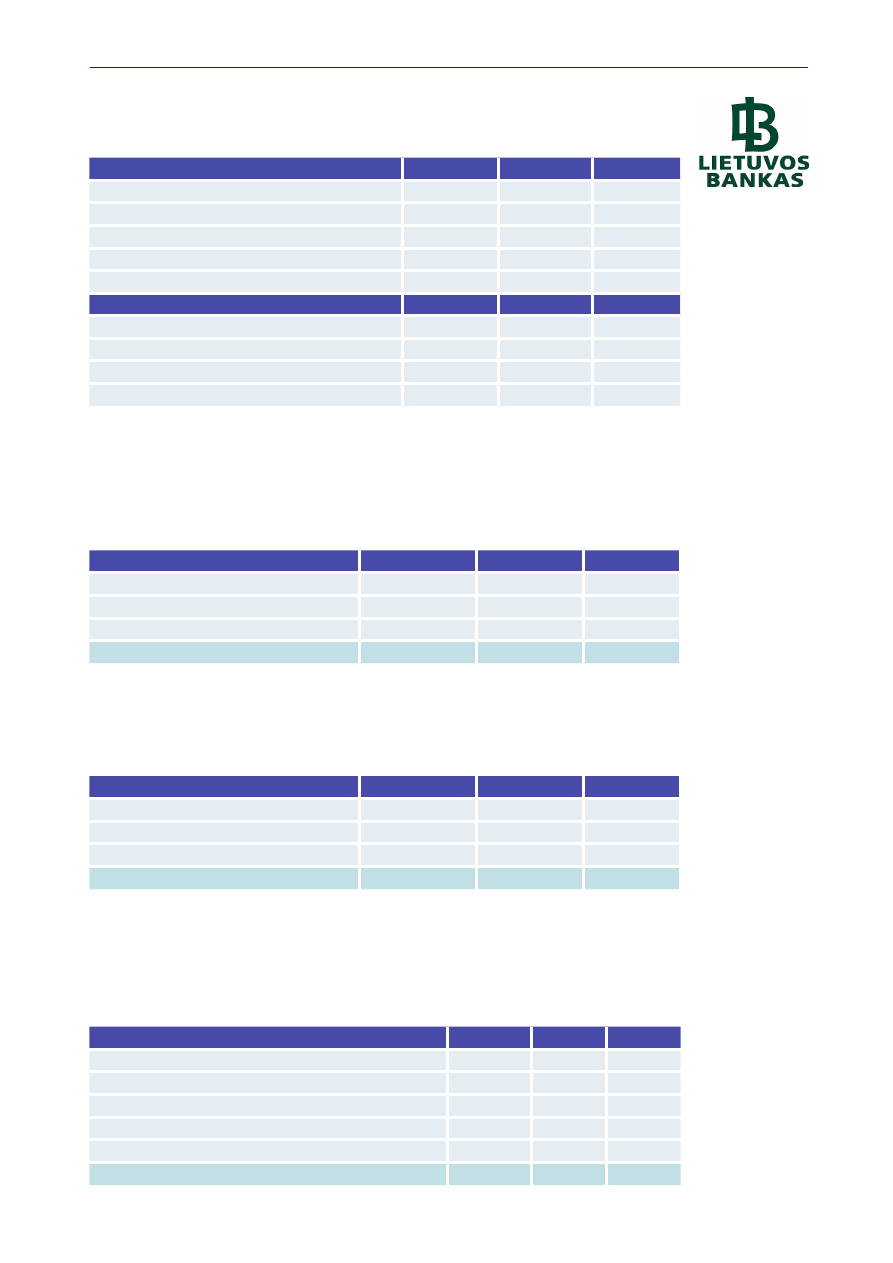
125
The structure of assets and liabilities of the banking system (%)
(at year-end)
Assets
2002
2003
2004
Cash in hand
3.8
3.1
2.3
Claims on banks and other financial institutions
18.7
21.1
24.4
Securities
22.5
15.8
12.4
Loans granted*
45.6
54.4
57.6
Other assets
9.4
5.6
3.3
Liabilities
2002
2003
2004
Liabilities to banks and other financial institutions
14.8
22.6
22.7
Deposits and L/C
67.8
61.6
61.3
Other liabilities
7.4
5.3
7.3
Bank capital
10.0
10.5
8.7
*
Net values
Development of off-balance sheet activities
(off-balance sheet items/balance sheet total) (%)
(at year-end)
Type of financial institution
2002
2003
2004
Commercial banks
16.8
23.6
16.1
Foreign bank branches
10.6
22.9
33.4
Credit unions
-
-
-
Financial institutions, total
16.3
23.4
17.8
Solvency ratio of financial institutions (%)
(at year-end)
Type of financial institution
2002
2003
2004
Commercial banks
14.8
13.2
12.4
Foreign bank branches*
-
-
-
Credit unions
16.5
16.6
16.5
Financial institutions, average
14.8
13.3
12.5
*
solvency ratios of foreign bank branches is not calculated
Loan portfolio quality of the banking system (%)
(at year-end)
Asset Classification
2002
2003
2004
Standard loans
76.2
79.6
74.8
Watch loans
18.0
17.7
23.1
Substandard loans
4.1
1.7
1.1
Doubtful loans
1.5
0.9
1.0
Bad loans
0.2
0.1
0.1
Non-performing loans/ Total loan portfolio
5.8
2.6
2.1
2004 DEVELOPMENTS IN THE LITHUANIAN BANKING SYSTEM
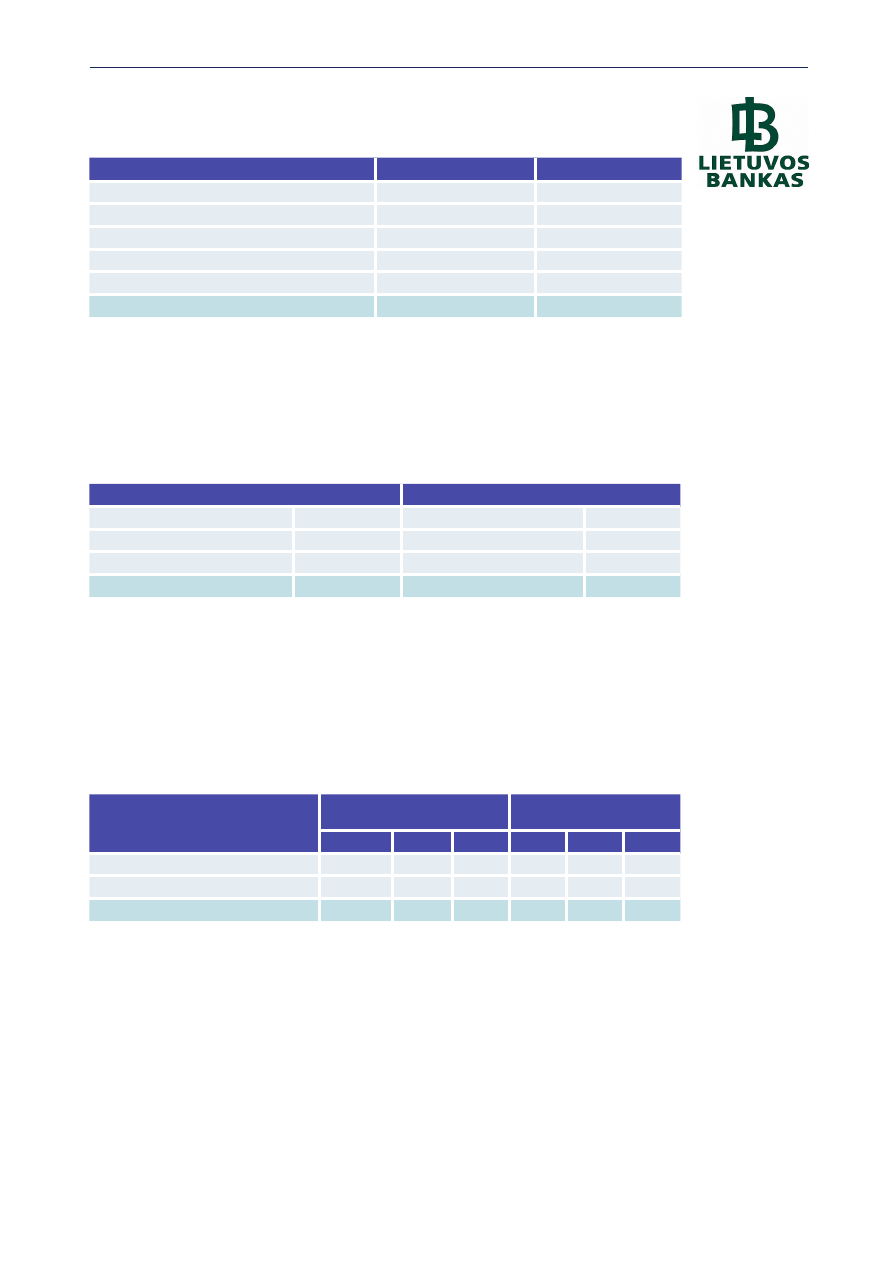
126
2004 DEVELOPMENTS IN THE LITHUANIAN BANKING SYSTEM
The structure of deposits and loans of the banking system in 2004 (%)
(at year-end)
Deposits
Loans
Households
53.9
26.2
Government sector
2.5
0.5
Corporate
31.1
65.1
Foreign
6.0
0.7
Other
6.5
7.5
Total
100.0
100.0
The structure of deposits and loans of the banking system in 2004 (%)
(at year-end)
Maturity of deposits
Loans*
At sight
59.3
Long-term loans**
39.1
Within one year
38.0
Medium-term loans***
24.4
Over one year
2.7
Short-term loans****
36.5
Total
100.0
Total
100.0
*
net value
***
1-3 year
**
over 3 years
****
1 year and less
Proportion of foreign exchange assets and liabilities (%)
(at year-end)
Type of financial institution
FOREX assets/Total
assets
FOREX liabilities/
Total liabilities
2002
2003
2004
2002
2003
2004
Commercial banks
32.1
46.4
54.4
41.2
42.0
40.7
Foreign bank branches
75.7
77.4
83.0
83.5
82.2
86.6
Financial institutions, average
45.3
49.1
57.2
44.5
45.9
45.5
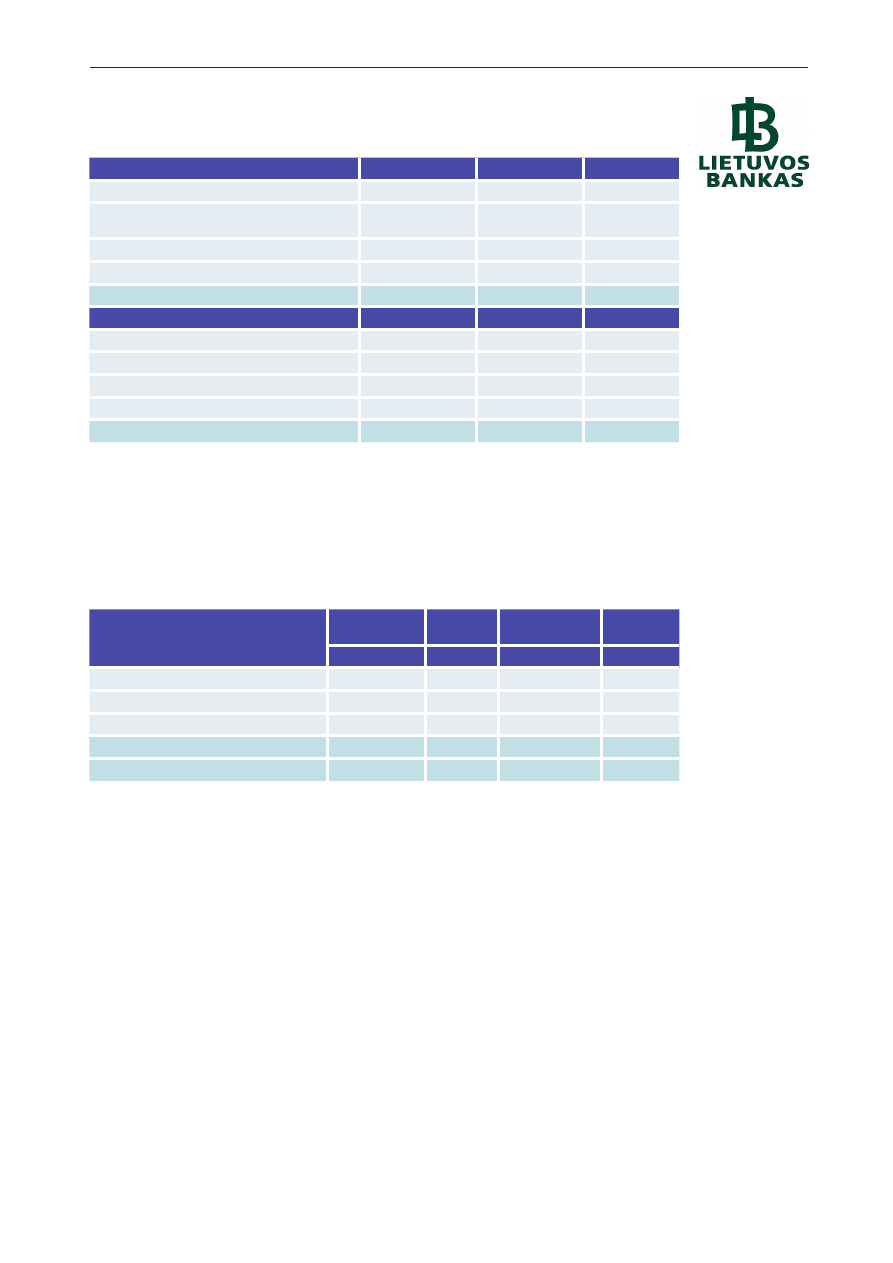
127
2004 DEVELOPMENTS IN THE LITHUANIAN BANKING SYSTEM
Structure of income and expenses of financial institutions (%)
(at year-end)
Income
2002
2003
2004
Interest income
58.8
59.0
61.0
Profit from operations in foreign
exchange
6.6
12.9
7.4
Income from services and commissions
23.3
27.5
27.9
Other bank income
11.3
0.6
3.7
Total Income
100.0
100.0
100.0
Expenses
2002
2003
2004
Interest expenses
23.7
23.4
25.7
Operational expenses
45.6
53.6
46.3
Expenses for specific provisions
7.3
-4.0
2.5
Other expenses
23.4
27.0
25.5
Total expenses
100.0
100.0
100.0
Structure of registered capital and own funds of financial institutions in 2004
(at year-end)
Type of financial institution
Registered
capital
/Total
assets
Own funds
/Total
liabilities
EUR million
%
EUR million
%
Commercial banks
387.6
5.1
724.6
10.5
Foreign bank branches *
11.3
1.4
13.1
1.6
Credit unions
7.4
11.1
8.3
14.2
Financial institutions, average **
33.2
4.7
61.5
9.6
Financial institutions, average ***
5.5
4.8
10.1
9.6
*
registered capital of a foreign bank branch is funds of this branch received from the headquarter
with the purpose to commence the branch operations
**
without Credit Unions
***
Including Credit Unions

128
2004 DEVELOPMENTS IN THE BANKING
SYSTEM OF THE REPUBLIC OF
MACEDONIA
MACROECONOMIC ENVIRONMENT
Macroeconomic performances of the Macedonian economy in 2004 can be
assessed as relatively satisfactory, especially from the viewpoint of the Central
Bank, having in mind the trend of preserving price and financial stability, the
favourable developments in the banking system and the development of finan-
cial markets.
In 2004, the real GDP growth equalled 2.9%, which represents an insignifi-
cant acceleration of the growth relative to the previous year (2.8%). Such per-
formances are to a large extent a result of the high concentration of the domestic
output, i.e. the reduced activity in industry, which is the dominant component of
the GDP. Contemporaneously, the current account deficit reached 7.7% of GDP,
mainly as a consequence of the broadening of the trade deficit. At the same time,
the high structural unemployment (in 2004 the unemployment rate equalled
37.2%) represents a signal of the necessity for conducting high-quality reforms
on a microeconomic level, incurring the investment activity and attracting
foreign direct investments.
In addition, during 2004, the monetary policy was directed toward creating
favourable environment for economic activity through further maintaining of
the price stability, as the main monetary policy objective. The monetary strategy
of a „de facto” targeting of the nominal exchange rate of the denar against the
euro was maintained. Consequently, the exchange rate remains to be a nomi-
nal anchor, which contributes to stable inflation expectations and maintaining
of a low and stable inflation. In 2004, the average change in the rate of infla-
tion was negative and equalled 0.4%, which was primarily due to non-mone-
tary factors, i.e. lower costs of food due to the reduction of the customs duties
on imports in line with the Stabilization and Association Agreement with the
EU and the membership in the World Trade Organization (WTO). With this,
the extremely high increase in the price of crude oil on the international mar-
kets in 2004 was completely offset and there was no transmission effect on the
domestic inflation.
The pressures on the foreign exchange market (caused by the broadening of
the current account deficit, unrealized inflows from abroad and speculations),
as well as the uncertain distribution of the budget spending during the year,
represented the main factors of the changes in the monetary policy stance in
2004. In the course of 2004, the National Bank of the Republic of Macedonia
(NBRM) increased the interest rates on CB bills on several occasions (so that the
interest rate on CB bills with maturity of twenty-eight days reached 10% p.a.),
which was made in order to stabilize the movements on the foreign exchange

129
market and preserve the exchange rate stability. Simultaneously, in December,
NBRM adopted a decision on increasing the compulsory reserve requirement
from 7.5% to 10% (effective since January 2005). The higher reserve require-
ment on denar deposits should contribute to the reduction of the structural
excess liquidity in the banking system and creation of an additional supply on
the foreign exchange market. On the other hand, the higher rate of reserve re-
quirement in foreign exchange is of a prudential character, given the intensive
lending in foreign currency, after the liberalization of the lending in foreign
currency in July 2003. Such changes in the monetary instruments resulted in
an insignificant amount of net-sale of foreign currency on the foreign exchange
market by the NBRM in 2004. Gross foreign exchange reserves in 2004 reg-
istered an annual increase of US Dollar 82.3 million (which is mainly due to
foreign exchange gains), with their level providing coverage of 3.6 months of
import of goods and services from the current year.
From a viewpoint of the fiscal policy, in 2004 the central budget registered
surplus of 0.1% of GDP, while the general government budget was almost
balanced. The accomplished budget balance for 2004, however, deviated from
the projection (projected deficit in the central and in the general government
budget of 0.8% of GDP and 1.9% of GDP, respectively), where the budget
spending during the year signalled uncertainty, which implied adequate
precautionary measures of the monetary policy. In 2004, the fiscal sec-
tor significantly contributed to the development of the financial market by
issuing the first short-term government securities (three-month and six-month
Treasury bills), with which the sources of budget financing expanded. At the
same time, the diversification of the securities portfolio is aimed at further
promotion of the monetary set of instruments, i.e. it is a basis for conducting
open market operations. To the end of supporting the development of the
domestic financial market and integrating the Macedonian economy into the
global financial flows, the Republic of Macedonia was given the first inter-
national credit rating, made by the international rating agency “Standard &
Poor’s”, which granted the Republic of Macedonia rating BB/B for the debt in
foreign currency and BB+/B for the debt in domestic currency, with positive
expectations for the future.
Despite the increase in the interest rates on the CB bills and the short-term
Treasury bills, the downward trend in the lending and deposit interest rates of
banks continued also in 2004. Thus, the average weighted lending interest rate
(on short-term denar credits) registered an average annual decline of 3.5 per-
centage points and equalled 12.5%, while the decline in the average weighted
deposit interest rate on the three-month denar deposits equalled 1.4 percent-
age points, thus being reduced to 6.5%. The decline in the banks’ interest rates
reflects the increased deposit potential of banks, the higher quality of the credit
portfolio, the improved efficiency and reduction of the costs of the banks, the
higher level of competition in the banking system, as well as the need for main-
taining good business relations with creditworthy clients. The higher efficiency
of the banking system and the higher level of competition are confirmed also
with the decline in the costs of financial intermediation, expressed through the
narrowing of the interest rate spread by 2.1 percentage points. Yet, despite the
downward trend, the interest rates of banks in the Republic of Macedonia are
2004 DEVELOPMENTS IN THE MACEDONIAN BANKING SYSTEM

130
higher relative to those in the advanced countries in transition, which points to
the need for further improvement of the banking operations.
In 2004, current account deficit deteriorated (7.7% of GDP, compared to
3.3% of GDP in 2003), primarily generated from the significant broadening
of the trade deficit, which reflects certain special circumstances in 2004 (re-
starting of one of the major metallurgic plants, increase in the price of oil on
the world markets, intensified import of vehicles before the reintroduction of
excises on motor vehicles), but is also an effect of the gradual trade liberaliza-
tion in line with the Stabilization and Association Agreement with the EU and
the membership of the Republic of Macedonia in the WTO. Current transfers
still represent the dominant source of the trade deficit financing. The degree of
coverage of the current account deficit with inflows from foreign direct invest-
ments and portfolio investments in 2004 equalled 36.2%, but further keeping
of the foreign direct investments at the level of 2% of GDP points to the need
of incurring this long-term and stable source of financing, which should also
enable an increase in the productivity, faster economic growth and higher em-
ployment rate. In 2004, the total external debt registered an annual increase
of US Dollar 203.6 million, with almost half of the realized growth being due
to the realized foreign exchange gains. The Republic of Macedonia, however, is
still in the group of less, i.e. moderately indebted countries, and all indicators
of the degree of indebtedness in 2004 registered improvements relative to the
previous year.
In 2004, the Republic of Macedonia confirmed its firm determination to
get closer to the European Union and actively integrate in the international
trade and financial flows. In March 2004, the Republic of Macedonia for-
mally filed the application for membership in the EU, while in April 2004
the Stabilization and Association Agreement with the EU became effective,
after it had been ratified by all countries-members of the EU. With this,
the Republic of Macedonia gained the status of a country with associative
membership, and successfully continued the process of gradual convergence
to the EU, as its strategic objective.
The key challenge for the Macedonian economy is to supplement the con-
sistent macroeconomic framework with structural reforms, to strengthen the
corporate governance and the institutional framework and to create favour-
able investment climate. NBRM will continue to be focused on preserving the
price stability, as the main monetary objective, so that the monetary policy will
contribute in the most adequate manner to the creation of an environment for
initiating and maintaining faster economic growth. Thus, NBRM successfully
converges towards the position of the central banks in the developed economies
and gives its contribution for faster integration of the Republic of Macedonia
in the EU.
2004 DEVELOPMENTS IN THE MACEDONIAN BANKING SYSTEM

131
DEVELOPMENT OF THE BANKING SYSTEM
(INCLUDING THE ASSETS TOTAL/GDP)
Structure of the banking system
The Macedonian banking system is consisted of two main segments: banks and
saving houses. As of December 31, 2004 the banking system was consisted of 21
banks and 15 saving houses. The saving houses play a marginal role in the total
performances of the banking system, since they account 1.3% of the total assets.
Consequently the rest of 98.7% of the total assets belongs to the banks.
In order to achieve a better quality of the analysis of bank’s performances,
the banks in the Republic of Macedonia are divided in three ”peer groups”
according to total assets criterion:
• Large banks (with assets over Denar 15 billion)
• Medium size banks (with assets from Denar 2 to 15 billion); and
• Small-size banks (with assets less than Denar 2 billion)
The criterion of the size of total assets determines that as of December 31,
2004 the decisive group is the group of large banks. Altogether 3 banks are in-
cluded in this group, while the group of medium-size banks contained 8 banks
and the group of small-size banks was consisted of 10 banks.
Same as in the preceding year, the analysis as of December 31, 2004 showed
relatively high level of concentration of the Macedonia's banking system within
large banks group according to almost all criteria. So, according the size of total
assets, the group of large banks was most influential group with 66.8% share of
the total assets. The remaining 33.2% belongs to the other two groups, whereas
22.0% refers to the medium-size banks and 11.2% refers to the small size banks.
The concentration of the banking system according to the capital strength cri-
teria analysed by banking groups indices that the dominant group is the large
banks group with their share of 42.4% of the total banking capital (32.6% for
the medium-size and the rest of 25.0% for the small-size banks).
The level of concentration of the banking system from aspect of the total
assets can be quantified also with the Herfindahl Index
1
. As of December 31,
2004 Herfindahl Index amounts to 1685 units and shows level of acceptable
concentration
2
of the banking system of the Republic of Macedonia.
The dominant position of the large banks group in all banking areas structure
is confirmed by their market share of 67.7% of the total banking activities (on
and off balance-sheet activities). If the bank’s credit activity
3
is taken in con-
sideration, the share of the group of the large banks in the credit activity of all
banks equals 66.2% as of December 31, 2004. The most evident concentration
2004 DEVELOPMENTS IN THE MACEDONIAN BANKING SYSTEM
1
H=i (assets of each bank/total assets of all banks*100)
2
According to the Herfindahl if the Index ranges between 1.000 and 1.800 units, the concentration of the assets
is considered acceptable, while up to 1.800 units, the concentration is considered significant
3
Credit placements to the non-financial entities (corporate and household sector)

132
by the large banks group was ascertained in the analysis of the bank’s deposit
activity
4
. As of December 31, 2004 the group of large banks mobilized 75.5% of
the total deposits.
As of December 31, 2004, foreign capital was present in 15 banks, with share
of 47.5% in the total banking capital. Out of aforementioned 15 banks, 8 banks
are owned and controlled by foreign shareholders, engaging 47.6% of the total
capital and 47.3% of the total assets. Domestic private shareholders had own-
ership over 12 banks covering 47.5% of the total banking capital and 50.8% of
the total assets, and 1 bank is 100% state owned. This bank
5
covers 4.9% of the
total banking capital and 1.9% of the total assets. Analysed by group of banks,
56.9% of the capital of the group of large banks is foreign capital, while the re-
spective percentages for the group of medium-size banks and small-size banks
are 34.2% and 48.8%. Thus, the foreign capital has the highest share in the
group of large banks.
The balance sheet structure
The growth of the deposit potential, as a main determinant for intensification
of the bank’s credit activity, had a positive impact on the continuos strengthen-
ing of the degree of financial intermediation in the Macedonian economy. Thus,
as of December 31, 2004 this indicator calculated as a ratio of the banks’ total
assets, the gross credits extended to clients and the total deposits to the gross
domestic product (GDP) of the Republic of Macedonia, was 44.6%, 21.7% and
31.1%, respectively. The same indicators as of 31.12.2003 were 41.4%, 17.8%
and 27.7%, respectively.
The total assets of the banks in the Republic of Macedonia continued to in-
crease, as a result of the continuos upward trend of total deposits, as major
source of banks’ funds. The total assets of the banks as of December 31, 2004
amounted to Denar 117.985 million, which represents an increase of 12.5% com-
pared to December 31, 2003. Analysed by banking groups (large, medium-size
and small-size banks), the increase of the banks’ total assets was solely due to
the growth in the assets by the group large banks. Thus, comparing December
31, 2004 with December 31, 2003, the assets of the group of large banks went
up by 35,4%, due to transfer of one bank from the group of medium-size to the
group of large banks, as well as due to the increase of the assets of large group
banks. At the same time, three banks moved from the group of small-size banks
to the group of medium-size banks. Thus, the assets of the group of medium-
size and small-size banks, decreased by 11.9% and 23.4%, respectively, in the
observed period. Nevertheless, despite such movements, on December 31, 2004,
compared to December 31, 2003, the group of large banks remained with domi-
nant share in the total assets.
2004 DEVELOPMENTS IN THE MACEDONIAN BANKING SYSTEM
4
Deposits to the non-financial legal entities (corporate and household sector)
5
This state owned banks is with special determined function and has primary task to support the development, which
shall be performed through the following sectors: 1/ financing investments of small and medium enterprises;2/
promoting exports; and 3/ implementing foreign loans and donation.

133
The total assets growth was almost solely reflected by the growth of
credits to non-financial entities (enterprises and households) as most evident
asset category relative to the increase in the analysed period, as well as due the
dominant share in the total assets. So, the amount of gross credits registered
growth of Denar 12.182 million or 27.0%, confirming the fact that in 2004 the
banks placed whole amount of collected deposits in credits.
As of December 31, 2004, the structure of the assets registers slight move-
ments compared to December 31, 2003. The credits to non-financial entities
accounting 40.7% of the total assets (35.4% -31.12.2003), took the first place
which was previously held by placements to banks which make up 34.2% (35.6%
– 31.12.2003). Aggregately, the above two categories constitute 74.9% of the
total assets, thus comprising its two most significant segments.
The upward trend of deposit potential registered in previous years contin-
ued in 2004. On 31.12.2004 the amount of total deposits achieved the highest
level from Macedonian monetary independence which confirms the permanent
growth of the confidence in the Macedonia’s banking system. As of December 31,
2004 the total deposits to non-financial legal entities and households amounted
Denar 82.284 million or 69.8% from the total sources of funds, thus remaining
most important source of funds for Macedonian banks. Compared on annual
basis, they registered growth of Denar 12.096 million or 17.2%. Analysed by
banking groups (large, medium-size and small-size banks), almost the whole
increase of total deposits was determined by the increase of the group of large
banks deposits.
The income statement structure and ratios
In 2004 the banks in the Republic of Macedonia, on aggregate level, showed
positive financial result in the amount of Denar 1.247 million, which represents
increase by 178.3% compared to 2003. This increase is indicator for significant
improvement of the Macedonian banks profitability in 2004, even though the
number of banks which showed positive financial result decreased to 16 (in 2003
there were 17 banks), thus registering higher net income of Denar 594 million
compared to the December 31, 2003. The remaining 5 banks, showed negative
financial result which is lower for Denar 205 million compared to the December
31, 2003. Analysed by banking groups, the largest effect on Macedonian banking
system profitability had the group of large banks, which achieved profit equalled
82.8% of the total financial result of all banks in the Republic of Macedonia.
Similar to 2003, also in 2004 the positive financial result was mainly based
on registered extraordinary income, but a positive trend of increasing the share
of income from main banking activities on the burden of decreasing the domi-
nant share of extraordinary income was registered. The realized profit in 2004
had positive impact on the major profitability ratios for banks in 2004. So,
ROAA (return of average assets) for 2004 is 1.1% and ROAE (return of aver-
age equity) is 6.2%, which represent improvement by 0.6 and 3.9 percentage
points, respectively.
2004 DEVELOPMENTS IN THE MACEDONIAN BANKING SYSTEM

134
Credit risk
The credit risk still represents most dominant risk on which the banks in the
Republic of Macedonia are exposed to. The key indicators for credit portfolio
quality show that during 2004 there was slight improvement of the credit port-
folio quality. As of December 31, 2004 the share of the total exposure classi-
fied in the risk categories C, D and E in the total credit portfolio of banks was
13.2%, which is a decrement of 1.9 percentage points compared with December
31, 2003. The average level of risk of the credit portfolio, calculated as a ratio
between calculated potential losses and the total credit exposure, equalled 9.7%,
which correspond to average risk category B. Compared with 31.12.2003 the
indicator for average level of risk of the credit portfolio shows decrease of 0.6
percentage points. These improvements confirm the continuous improvement
of Macedonian banks credit policies and practices. Analysed by groups of banks,
the share of total exposure classified in the risky category C, D and E in the
total credit exposure is highest within small-size banks and equals 21.3%, then
follow the group of large banks with rate of 13.1% and medium-size banks with
10.1%. The average level of risk of the credit portfolio is highest within group
of small-size banks and amounts 14.5%, followed by the group of large banks
with 9.6% and medium-size banks with 8.0%.
Capital adequacy ratio
As of December 31, 2004 the own funds of the Macedonian banks accounts
17.0% of the total sources of funds. As a result in the movement of the guaran-
tee capital, risk-weighted on- and off-balance sheet assets and open foreign ex-
change position, the average capital adequacy ratio of the banks in the Republic
of Macedonia equalled 23.0% as of December 2004, which represents a decrease
of 2.8 percentage points, compared to December 31, 2003. Analysed by groups
of banks the lowest capital adequacy ratio belongs to the group of large banks
(15.1%), while capital adequacy ratio of small-size banks is 45.1% and 34.0%
for medium-size banks. The reason for such high level of capital adequacy ratio
within the small-size banks group is due to the simpler structure of the sources
of financing, whereas the own source of funds have significant share. Contrary
to that, the most significant sources of funds within the group of large banks is
deposit base, what is the reason for the lowest capital adequacy ratio and for
higher efficiency in performing the financial intermediation.
As of December 31, 2004 all banks in the Republic of Macedonia had fulfilled
the prescribed minimum of 8%. At the end of 2004 banks with capital adequacy
ratio in the rank between 30-50% are dominant. Also, it can be consider that
there is structural movement of the banks in direction from rank of higher capi-
tal adequacy toward rank of lower capital adequacy.
During the previous years the banking system of the Republic of Macedonia
had maintained relatively high and stable level of capital adequacy ratio which
equalled above 30.0% what is indicator for the stable solvent position of the
banks. There is a trend of permanent decreasing of the capital adequacy ra-
tio (average quarterly decreasing of 0.3 percentage points, starting from the
2004 DEVELOPMENTS IN THE MACEDONIAN BANKING SYSTEM

135
beginning of 2002 when the ratio equalled 25.9%) what is positive with regard
to improvement of the efficiency of the financial intermediation of banks in the
Republic of Macedonia.
Liquidity risk
During the year 2004 the banks in the Republic of Macedonia maintained
satisfactory liquidity position. In that context the continuing trend of increas-
ing in the deposit base, as a dominant source of funds was a positive precondi-
tion which caused reduced usage of secondary source of funds. In the 2004, the
average share of the liquid assets defined in the broaden sense
6
in the total
assets equalled 43.1%, which represent decreasing of 1.9 percentage points,
compared to December 31, 2003.
The residual maturity structure on expected inflows and outflows represent
high level of maturity match of assets and liabilities, mostly due to high rate of
stable sight deposits.
The rate of the stable sight deposits with maturity up to seven days at the
level of the whole banking system accounts 74.6%, which represents an increase
of 5.8 percentage points compared to December 31, 2003. Such a high level of
stable deposits is mostly due to the high level of stable sight deposits of large
banks (83.4%). The improved stability position of the deposits indicates lower
level of deposits outflow. Thus, in accordance with the expectations of the banks
in the Republic of Macedonia, only 14.9% of the total deposits with maturity of
up to seven days will outflow (19.2% – December 31, 2003). The high rate of
stable sight deposits is confirmed through the percentage of the stable share of
the Denar sight deposits within the maturity profile of up to seven days equals
78.3%, while it equals 71.7% of the foreign exchange deposits.
Foreign Exchange rate risk
As of December 31, 2004 foreign exchange assets accounts 57.8% of the total
assets, while foreign exchange liabilities equalled 49.4%. Compared to the same
ratios in the previous years there is an increasing trend due to household’s pref-
erence to make foreign exchange savings. Because of the short-term character
of these savings, the banks hold larger proportion of liquid foreign exchange
assets in foreign banks.
The aggregate open foreign exchange position accounts 51.2% of the guar-
antee capital of the banks at the end of 2004, which represents an increase of 7
percentage points compared to the end of 2003. The banking system exposure
toward the Euro as a dominant currency in the foreign exchange assets and
liabilities structure equalled 43.9% from the guarantee capital, compared with
50.6% on December 31, 2003.
2004 DEVELOPMENTS IN THE MACEDONIAN BANKING SYSTEM
6
The liquid assets, in broaden sense, encompasses the funds and the balances with the National Bank
of the Republic of Macedonia, the CB bills, the short-term debt securities, the short-term credits with
domestic and foreign banks and balances on the accounts with domestic and foreign banks.

136
Analysed by groups of banks, the large banks group has dominant influence
over the long aggregate open foreign exchange position, which is 79.7% of the
guarantee capital for this group. This ratio is 35.3 % and 19.0% for the group of
medium-size and small-size banks respectively. The long open position to Euro
accounts 74.2% for the group of the large banks, 25.7% for the group of medium
size banks and 11.5% for the group of small-size banks.
THE LEGAL AND INSTITUTIONAL FRAMEWORK OF
THE OPERATION AND SUPERVISION OF FINANCIAL
INSTITUTIONS, NEW DEVELOPMENTS
LEGAL COMPETENCE OF THE BANKING SUPERVISORY
AUTHORITY IN MACEDONIA
National Bank of the Republic of Macedonia is a sole banking supervisory body
in the Republic of Macedonia. The National Bank is an independent institu-
tion in conducting its functions, including the supervisory function. Within the
National Bank of the Republic of Macedonia, a special department – Supervision
Department, conducts the supervisory function. According to the organization-
al chart of the National Bank of the Republic of Macedonia, the Supervision
Department is directly liable for its operations to the Governor of the National
Bank of the Republic of Macedonia.
In the first half of 2004, within the overall changes in the organizational
structure of the National Bank of the Republic of Macedonia, the organizational
structure of the banking supervision was also a subject to changes. The opera-
tive implementation of the supervisory function of the National Bank of the
Republic of Macedonia was conducted by the Supervision Department which,
besides the on-site and off-site supervision of the operations of each bank was
also responsible for implementing the regulatory function and for analysing and
monitoring the risks in the overall banking system. The organizational changes
in 2004 resulted in segregation of the supervisory function from the regula-
tory one, by forming two separate Departments within the National Bank of
the Republic of Macedonia, i.e. the Supervision Department and the Banking
Regulations Department.
The Supervision Department remained responsible for direct implementa-
tion of the supervisory function, i.e. licensing the banks and savings houses,
on-site and off-site supervision of their operations and undertaking correc-
tive measures against institutions suffering problems, irregularities and non-
compliance with the regulations.
The Banking Regulations Department is responsible for the activities relat-
ed to establishment and improvements of the banking supervision regulatory
framework, promotion of the supervisory practices and following of the interna-
tional standards in banking and supervision. Also, this Department is respon-
sible for financial stability analysis which, at the same time, is a new activity of
the National Bank of the Republic of Macedonia.
The competence of the National Bank of the Republic of Macedonia is regu-
lated by the Law on the National Bank and the Banking Law, as well as other
regulation related to banks.
2004 DEVELOPMENTS IN THE MACEDONIAN BANKING SYSTEM

137
During 2004, the prudential framework has undergone several changes, in
line with the World Bank mission recommendations and achieving a higher
level of compliance of the Macedonian banking supervision with the Basle Core
Principles for effective Banking Supervision.
Since 1998 within the National Bank exist a Registry on data on the banks’
and savings houses credit exposures to legal and natural persons. In 2004, the
National bank issued a Decision on the content and manner of Credit Registry
functioning and a Manual for executing this Decision that obtain a legal basis
for the Credit Registry functioning. The data in the Credit Registry are for su-
pervisory purposes for more adequate assessment of the credit risk for each
separate banks borrower. In order to decrease and control the banks exposure
to credit risk, the National bank enabled the banks to use aggregate informa-
tion from the Credit Registry. The aforementioned Decision was issued on the
basis of a certain changes in the Law on National Bank.
The legal basis provided in the Law on National Bank and adoption of the
corresponding by-law regulation, were steps toward implementation of the
World Bank Recommendations as a part of the FESAL arrangement. At the
same time, the opportunities for promotion and improvement of the Credit
Registry were broaden.
Within the enforcement of the licensing criteria, which is one of the activity
of the supervisory function, in November 2004 a Decision on the documenta-
tion necessary for granting approvals to the banks and submitting notification
of the change in the ownership structure of voting shares was established. With
this Decision, the criteria for the part of the banks financial activities executed
abroad were improved, as well as for brokerage operation with transferable secu-
rities. So, in order to be able to trade on the financial markets, the banks should
have adequate electronic system for access to financial markets information, as
well as the employees’ who execute duties connected to these financial activities
should hold corresponding certificate for financial market operations.
The aforementioned improved criteria represent one of the main precondi-
tions which will enable the banks in the Republic of Macedonia to have access
to financial markets in the country and abroad, as well as to manage the risk
connected to foreign exchange market operations.
In the direction of further promotion of the regulatory package which per-
tains to the liquidity risk management, after the adoption of the Decision on
identifying, assessing and managing the banks’ liquidity risk and the respective
Instructions which established the fundaments for the liquidity risk manage-
ment, a Supervisory Circular No. 6 – Liquidity Risk Management was developed
in June 2004. The primary objective of the Circular is to provide guidelines for
efficient implementation of the liquidity risk management process by the banks
and to give an integrated review of all aspects affiliated to this process, having
in mind the recommendations of the Basle Committee.
In 2004, The Supervision Department and the Banking Regulations
Department started with preparation of several changes in the existing regula-
tion in direction of increasing the stability and soundness of the banking sys-
tem. The new regulation is expected to become effective during 2005. The main
purposes of the changes are: strengthening the “fit and proper” criteria for new
shareholders, creating a legal power for the National Bank to revoke previously
2004 DEVELOPMENTS IN THE MACEDONIAN BANKING SYSTEM

138
issued license for bank shareholder, further harmonization of the Macedonian
banking regulation with the EU Directives in banking, increasing the efficien-
cy of the receivership, bankruptcy and liquidation procedure, provisions on
consumer protection etc.
MAIN STRATEGIC OBJECTIVES OF THE SUPERVISORY
AUTHORITY
In 2004, the main activities of the National Bank were focused on the imple-
mentation of the FSAP recommendations and harmonisation of the banking
legislation with the EU Directives.
Following the FSAP recommendations the Supervision Department and
Banking Regulation Department in 2004 defined several strategic objectives
which main objective is to ensure increased efficiency and sustainable stability
of the banking system and drafted time-frame for their implementation.
The main strategic objectives of the supervisory authority can be summa-
rized as follows:
a) Changes in the legal framework that will enable the National Bank to:
• strengthen the licensing criteria for bank shareholders and improve
the corporate governance in the banks;
• revoke previously issued licences for shareholders that are no longer
fulfilling fit and proper criteria for bank shareholders;
• enhance the risk management standards;
• improve the accounting and internal auditing;
• improve financial reporting and public disclosure;
• further strengthening of the corrective measures that can be undertaken
by the supervisory authority against weak banks;
• improve the efficiency of the rehabilitation and receivership of troubled
banks i.e. more efficient procedures fore dealing with troubled banks;
and
• introduce provisions for customer protection and market competi-
tion.
b) Changes in the legal framework that will enable its harmonization with the
EU Directives especially EU Directive 2000/12/EC relating to the taking
up and pursuit of the business of credit institutions – codified directive
and Capital Adequacy Directive 93/6/EC and 98/31/EC);
c) Transition from compliance focused supervision to risk-based supervision.
This will be a long-term process that will have to be implemented in to
several stages. The concept of the risk-based supervision is planed to be
introduced in line with World Bank technical assistance. During 2005 the
National Bank and the World Bank will draft a Supervisory Development
Plan that will contain all the necessary activities in order for the National
Bank to efficiently transfer to risk-based supervision;
d) Changes in the accounting framework in line with the requirement of IFRS
that will enable better financial reporting and disclosure and enhance bank
transparency.
2004 DEVELOPMENTS IN THE MACEDONIAN BANKING SYSTEM

139
THE ACTIVITIES OF THE BANKING SUPERVISORY
AUTHORITY
The supervisory function of the National Bank of the Republic of Macedonia is
performed through 3 main activities: licensing, on-site and off-site supervision
and undertaking corrective measures. The main steps taken during 2004, to-
ward fulfilling these activities of the National Bank of the Republic of Macedonia
are as follows:
• Within the licensing framework, the National Bank of the Republic of
Macedonia issues 14 different types of licenses and approvals among which
the main activities in 2004 were related to issuing approvals for appoint-
ing an executive body of the banks, issuing approvals for changes in the
ownership structure of the voting shares, issuing approvals for changes
in the Statute of the banks, etc.
• In 2004, he National Bank of the Republic of Macedonia carried out 41
on-site supervisory examinations, 21 of which were full-scope supervisory
examinations and 20 were targeted examinations. The full-scope on-site
examinations are carried out on the basis of the CAMELS rating system,
where dominant component is the credit risk assessment. The full-scope
examination were supplemented with assessment of the anti-money laun-
dering systems of banks and saving houses in the Republic of Macedonia,
from the aspect of the internal Customer Due Diligence policies and pro-
cedures, their adequacy and implementation, identification of suspicious
transactions, the role of the management and the internal audit, etc;
• Within its legal authorizations, the National Bank of the Republic of
Macedonia undertakes corrective actions against banks and savings houses
in which violations and irregularities were identified in order to preserve
the stability and the safety of the banks and the savings houses and the
stability and the safety of the overall banking system. During 2004, the
National Bank of the Republic of Macedonia issued 28 Decision with cor-
rective measures towards 13 banks and 4 saving houses. Also, in the first
half of 2004 National Bank of the Republic of Macedonia has revoked the
operating license of one bank and one saving house. The most common cor-
rective measures and actions undertaken against banks and saving houses
were: ban on performing certain banking operations within a certain period
of time; revocation of the issued license for executive body; measure for
reducing the credit exposure within the prudential limits; ban on lending
to clients classified in risk categories C, D and E; acquiring higher capital
adequacy ratio; ban on capital investments; allocation of additional pro-
visions for loan losses; prohibition on dividend payments; permanent
oversight over the implementation of the imposed measures.
2004 DEVELOPMENTS IN THE MACEDONIAN BANKING SYSTEM

140
ORGANIZATIONAL CHART OF THE BANKING
SUPERVISORY AUTHORITY
Banking Supervision Department
2004 DEVELOPMENTS IN THE MACEDONIAN BANKING SYSTEM
Manager
Deputy Manager
Methodology Division
Unit for aplication of the
International Accounting
Standards
Financial Stability
Analysis Division
Unit for
IT Systems
Supervision
Division of General
Supervision
Operations
Manager
Deputy Manager
Deputy Manager
Division of Banks
Under Enhanced
Monitoring
Division of
Off-Site
Supervision
Division of
On-Site
Supervision
Banking Regulations Department

141
INTERNATIONAL ACTIVITIES OF YOUR AUTHORITY
According to the existing legal framework, the National Bank of the Republic
of Macedonia may exchange information with foreign supervisory agencies
with relation to supervision of internationally active banks. Furthermore,
the National Bank may approve an on-site examination of a foreign bank for-
eign bank subsidiary and a foreign bank branch in the Republic of Macedonia
conducted by supervisory bodies of the home country of the founding bank.
In order to assert this right, the National Bank requires from the supervisory
bodies of other countries to provide legal and operational capability to ensure
confidentiality of the data.
Based on this legal framework, National Bank of the Republic of Macedonia
has signed Memorandums of Understanding (MoU’s) with several supervisory
agencies. These bilateral agreements define the principal areas of co-operation,
exchange of information and common procedures for supervision of subsidiaries
of foreign banks. Thus, besides the MoU’s that were concluded in the previous
years with the Bank of Slovenia, the Central Bank of the Russian Federation
and the Bulgarian National Bank, in 2004 the National Bank of the Republic of
Macedonia has signed a MoU with the Bank of Albania.
In June-September, 2004 the long-term technical assistance provided by
the European Agency for Reconstruction, was finalized. The National Bank
of the Republic of Macedonia was an end user or participant in 4 projects
organized by this institution (Implementation of the International Accounting
Standards, Approximation with the European Directives in the field of banking,
Preparation for implementation of the New Capital Accord – Basel II, Creation
of Bank File).
COOPERATION WITH OTHER SUPERVISORY BODIES IN
THE COUNTRY
The co-operation between domestic regulators and supervisory bodies is regu-
lated by the existing framework which enables the National bank to exchange
information with other domestic supervisory bodies. So far, the National bank,
as an authorized body for banking supervision has signed agreements for
co-operation with several domestic authorities.
At the end of 2004, the National Bank has signed a Memorandum of under-
standing (MoU) with the Security Exchange Commission, as an authorized body
for supervision of capital markets, brokerage houses and investment funds. This
MoU sets the base for regular exchange of information (at least quarterly), as
well as for organization and performance of joint examinations on the entities
that are under the supervision of both supervisory bodies regarding the opera-
tion with securities.
In order to expand the data base and information contained in the Credit
Registry
7
, at the end of 2004 the National Bank has signed an agreement with
2004 DEVELOPMENTS IN THE MACEDONIAN BANKING SYSTEM
7
The Credit Registry within the National Bank is established in 1998.

142
the State Statistics Office of the Republic of Macedonia. Upon this agreement
the National Bank uses following information: economic sector codes, full name,
address and ID number of legal entities, publications etc. Few years ago, the
National Bank has signed an agreement for co-operation with Macedonian bank
for Development Promotion for determination the country risk weights.
In favour of improvement of the supervisory function, in the middle of
2004 the National Bank has signed an agreement with the Central Securities
Depository.
The National bank has started with initial activities in the area of financial
stability analysis that creates the need for further development of co-operation
with other domestic financial institutions.
OTHER RELEVANT INFORMATION AND DEVELOPMENTS
IN THE COURSE OF LAST YEAR
During 2004 the IT supervision on banks was enhanced by creation a meth-
odology for the Information Systems Security including its presentation to the
banks, monitoring of banks from the aspect of the implementation of their
Policies on information security. Also, in 2004, the IT Supervision has gained
two certificates related to IT supervision: CISSP – Certified Information System
Security Professional, issued by ISC and BS 7799 Lead Auditor, issued by BSI
– British Standard Institute.
STATISTICAL TABLES
Number of financial institutions
(at year-ends)
Type of financial institution
2002
2003
2004
Banks*
21
21
21
Savings houses
17
15
15
Brokerage firms
9
8
8
Deposit insurance funds
1
1
1
Insurance companies
6
7
9
Stock exchange
1
1
1
Money market
1
1
1
Leasing companies
6
8
Financial institutions, total
56
60
64
*As of 2004 out of 21 banks, 6 banks have brokerage firms which operates in the name and account of the
bank.
2004 DEVELOPMENTS IN THE MACEDONIAN BANKING SYSTEM

143
Ownership structure of financial institutions on the basis of registered capital (%)
(at year-end)
Item
2002
2003
2004
State ownership
4.90
4.80
4.90
Other domestic ownership
50.50
46.60
47.50
Domestic ownership total
55.40
51.40
52.40
Foreign ownership*
44.60
48.60
47.60
Financial institutions, total
100.00
100.00
100.00
Note: Savings Houses are not included due to their marginal participation in the total registered capital.
* Foreign owned banks are considered banks with foreign capital exceeding 50% of their capital structure.
Ownership structure of financial institutions on the basis of assets total (%)
(at year-ends)
Item
2002
2003
2004
State ownership
2.00
1.80
1.90
Other domestic ownership
54.00
51.30
50.80
Domestic ownership total
56.00
53.10
52.70
Foreign ownership
44.00
46.90
47.30
Financial institutions, total
100.00
100.00
100.00
Note:
The table includes data for the ownership structure of the banks. The data for the other financial institu-
tions are N/A.
Concentration of assets by the type of financial institutions (%)
(at year-end)
Type of financial institution
The first three largest
The first five largest
Banks
66.84
76.24
Note: Savings Houses are not included due to their marginal participation in the total assets.
Return on asset (ROAA) by type of financial institutions (%)
Type of financial institution
2002
2003
2004
Banks
0.40
0.45
1.1
Return on equity (ROAE) by type of financial institutions (%)
Type of financial institution
2002
2003
2004
Banks
2.06
2.28
6.2
2004 DEVELOPMENTS IN THE MACEDONIAN BANKING SYSTEM
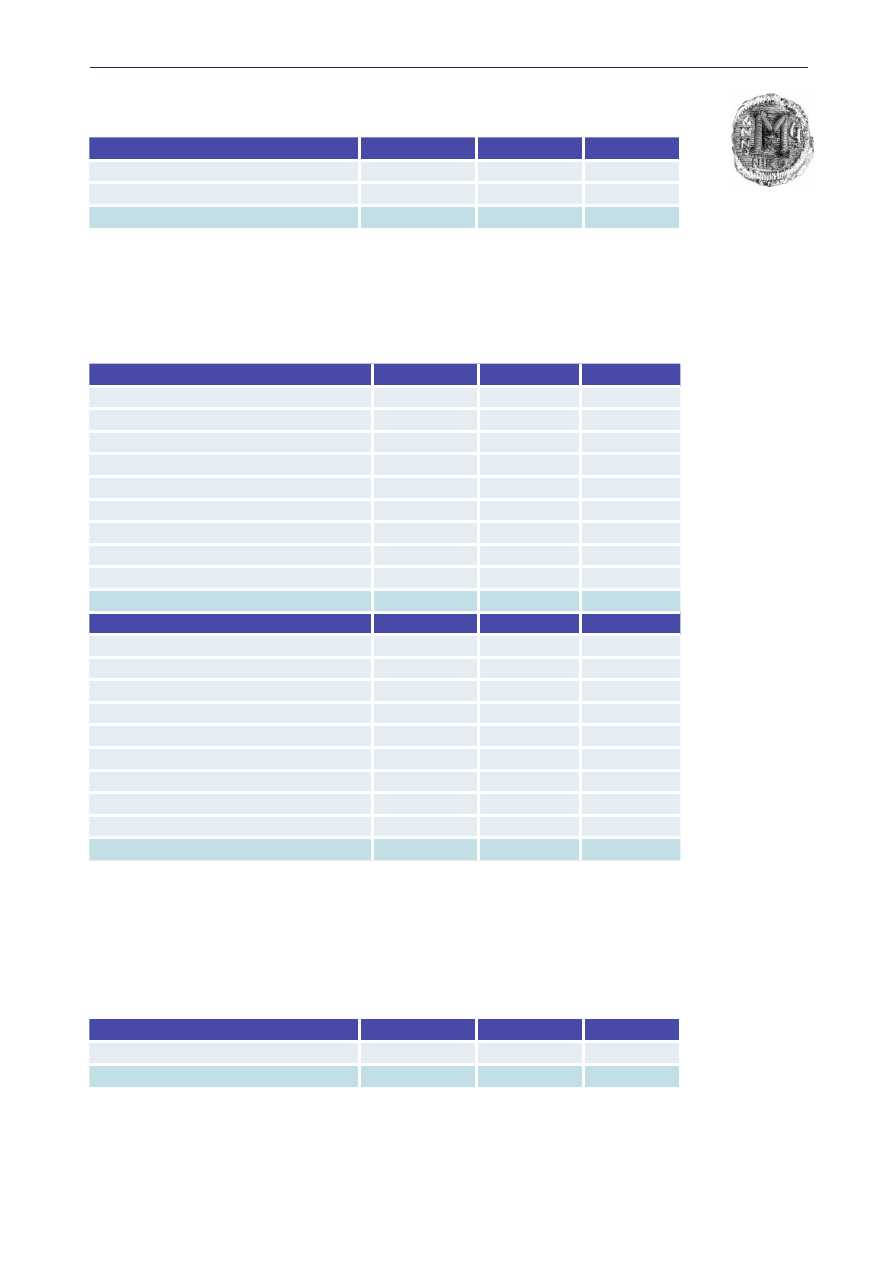
144
2004 DEVELOPMENTS IN THE MACEDONIAN BANKING SYSTEM
Distribution of market shares in balance sheet total (%)
Type of financial institution
2002
2003
2004
Banks
99.03
98.80
98.70
Savings houses
0.97
1.20
1.30
Financial institutions, total
100.00
100.00
100.00
The structure of assets and liabilities of the banking system (%)
(at year-end)
Assets
2002
2003
2004
Cash and balance with NBRM
6.50
5.40
4.30
Nbrm bills
2.10
3.80
3.80
Debt securities
0.90
0.90
1.40
Placements to other banks
36.30
35.60
34.20
Placements to clients
34.40
35.40
40.70
Accrued interest and other assets
4.80
5.80
4.70
Securities investments
8.30
7.00
5.80
Fixed assets
6.70
6.10
5.50
Nonalocated reserves for potential losses
0.00
0.00
-0.50
Total assets
100.00
100.00
100.00
Liabilities
2002
2003
2004
Deposits of banks
3.10
2.10
1.30
Sight deposits
39.00
41.00
37.20
Short-term deposits up to one year
19.40
22.70
29.70
Short-term borrowings up to one year
3.10
1.80
0.70
Other liabilities
2.50
2.90
3.30
Long-term deposits over one year
3.70
3.20
2.90
Long-term borrowings over one year
7.90
6.60
7.50
Provisions for off-balance sheet liabilities
0.50
0.50
0.50
Owned funds
20.70
19.10
17.00
Total liabilities
100.00
100.00
100.00
Development of the off-balance sheet activities (%)
(off balance sheet items/balance sheet total)
Type of financial institution
2002
2003
2004
Banks
13.54
11.46
10.23
Financial institutions, total
13.54
11.46
10.23

145
2004 DEVELOPMENTS IN THE MACEDONIAN BANKING SYSTEM
Solvency ratio of financial institutions
Type of financial institution
2002
2003
2004
Banks
28.10
25.80
23.03
Savings houses
/
/
/
Financial institutions, average
28.10
25.80
23.03
Asset portfolio quality of the banking system
in million denars
Asset classification
2002
%
2003
%
2004
%
A
67,337
72.24
77,686
74.48
91,394
76.69
B
11,018
11.82
10,871
10.42
12,025
10.09
C
6,269
6.73
4,602
4.41
4,826
4.05
D
6,497
6.97
5,735
5.50
4,191
3.52
E
2,094
2.25
5,413
5.19
6,744
5.66
Classified total
93,215
100.00
104,307
100.00
119,180
100.00
Provisions
8,166
10,719
11,591
The structure of deposits and loans (%)
(at year-end)
Deposits
Loans
Households
56.68
26.06
Public sector
2.00
1.02
Corporate
36.69
69.73
Domestic banks
1.29
1.29
Foreign banks
0.54
1.19
Other
2.80
0.71
Total
100.00
100.00
The structure of deposits and loans (%)
(at year-end)
Maturity of deposits
Maturity of loans
At sight
53.18
Long term loans*
63.95
Within one year
42.61
Medium term loans
Over one year
4.22
Short term loans**
36.05
Total
100.00
Total
100.00
* In the amount of Long term loans, the amount of Non-performing loans is included.
** In the amount of Short term loans, the amount of Past-due but still performing loans is included.
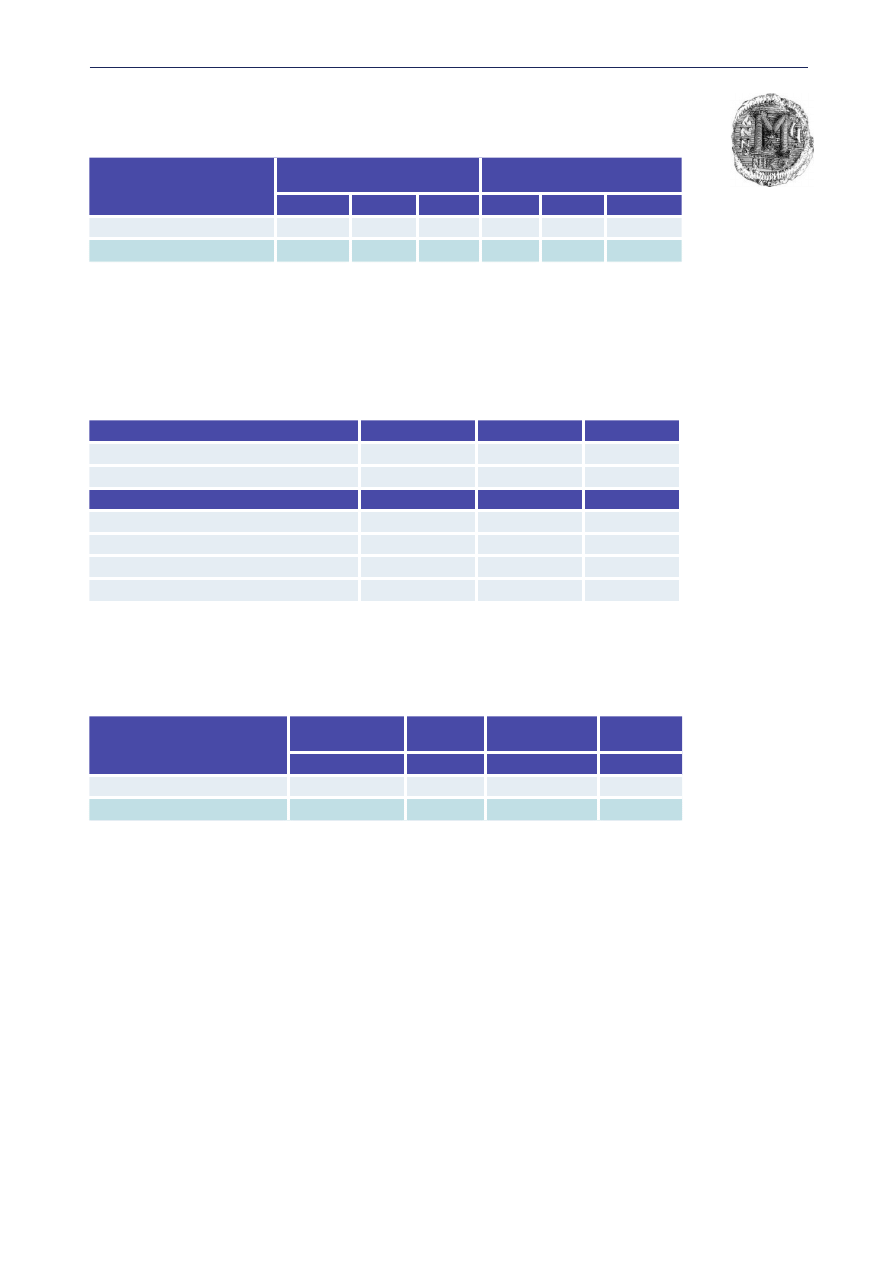
146
2004 DEVELOPMENTS IN THE MACEDONIAN BANKING SYSTEM
Proportion of foreign exchange assets and liabilities (%)
(at year end)
Type of the financial
institution
Forex assets/Total assets
(%)
Forex liabilities/Total
liability (%)
2002
2003
2004
2002
2003
2004
Banks
55.43
56.22
57.85
43.90
45.78
49.38
Fin. institution, average
55.43
56.22
57.85
43.90
45.78
49.38
Structure of revenues and expenditures of financial institutes
(at the year-end)
in million denars
Revenues
2002
2003
2004
Interest income
5,428
5,161
5,920
Other income
4,945
5,188
5,129
Expenditures
2002
2003
2004
Interest expenses
2,999
2,625
2,310
Provisions for potential loan losses
1,798
2,334
1,979
Other expenses
5,107
4,858
5,326
Income tax
74
83
186
Structure of registered capital and own funds of financial institutions in 2004
Type of
financial institutions
Registered
capital
/ Total
assets
Own funds
/ Total
liabilities
EUR (million)*
%
EUR (million)*
%
Banks
314
16.30
327
16.97
Fin. institutions, average
314
16.30
327
16.97
* Calculated by the exchange rate of NBRM on December 31, 2004.

147
2004 DEVELOPMENTS IN THE BANKING
SYSTEM OF THE REPUBLIC OF
MOLDOVA
MACROECONOMIC ENVIRONMENT
The nominal Gross Domestic Product (GDP) in 2004 amounted to 31991.7
million lei, denoting a 7.3%-increase in real terms.
Industrial output produced by enterprises of all property forms rose by 6.9%
in real terms over the year and totalled 17533.0 million lei. Labour productivity
in the industrial sector recorded during 2004 an average growth rate of 5.8%.
Agricultural output (according to preliminary estimates of NBS for 2004)
within all categories of farms amounted to 12600.8 million lei in current prices,
increasing by 20.4% in real terms from the previous year.
Investments in fixed capital allocated in the national economy in a value of
5140.0 million lei increased by 8.0% in real terms from the previous year.
Retail sales of goods amounted to 16575.8 million – by 5.6% more than in
2003.
Paid services rendered to the public rose by 5.3% and totalled 6970.4
million lei.
Average monthly salary of en employee in the national economy totalled
1103.1 lei, recoding an increase by 23.9% in nominal terms and by 10.2% in
real terms.
Consumer prices in 2004 denoted an annual growth of 12.5%, including
as follows: food products – 13.1%; non-food products – 11.9%; and services
rendered to the pubic – 11.8%.
The current account of the balance of payments recorded a deficit of US$
112.9 million (minus 4.4% of GDP). The trade deficit of goods and services to-
talled US$ 813.1 million, increasing by 21.6% from the previous year. However,
the growth rate of import of goods and services (23.3%) was inferior to that of
exports (24.4%). The coverage of imports by exports in 2004 accounted for
61.8% (61.3% in 2003).
Total external debt of the Republic of Moldova as of 31.12.2004 amounted to
US$1924.5 million (similar to the end of 2003). The public and publicly guar-
anteed external debt amounted to US$ 884.1 million, decreasing by US$ 126.4
million (12.5%) from the previous year.
Domestic public debt totalled 3714.1 million lei as of 31.12.2004. Within to-
tal domestic debt loans extended by the National Bank of Moldova amounted
to 2338.0 million lei and state securities in circulation – to 1376.1 million lei
(including in the NBM portfolio – 400.0 million lei).
The consolidated budget was closed with a surplus of 131.4 million lei,
accounting for 0.4% of GDP.

148
BANKING SYSTEM DEVELOPMENT
As of December 31, 2004 there were 16 commercial banks, including 2 branch-
es of foreign banks authorised by the National Bank of Moldova acting on the
territory of the Republic of Moldova.
The total number of banking offices included 866 units, out of which: 16 head
offices of banks (placed in the city of Chişinău), 195 branches, 210 representa-
tive offices and 445 agencies.
The development of the banking sector of the Republic of Moldova over the
reported year denoted positive trends. Total assets of the banking sector rose by
3012.5 million lei
8
(29.3%) and amounted to 13295.5 million lei as of December
31, 2004. Their weight in GDP increased from 37.7% to 41.6%.
The larger value of assets was mainly due to increases in the balances of
banking liabilities by 2603.2 million lei (32.0%) and equity capital by 409.4
million lei (19.0%).
All the components of assets’ structure displayed upward evolution. Cash
means increased by 186.3 million lei (34.0%); money means owed by banks and
NBM – by 1003.5 million lei (45.6%); securities – by 248.6 million (34.5%); and
other assets – by 119.9 million lei (11.6%). The largest increase was recorded by
credit portfolio (net) – by 1454.2 million (25.2%).
Net credits accounted for the largest share of 54.4% in total assets, reducing
by 1.8 p.p. from 31.12.2003. Credits have been mainly extended to industry/
trade – 47.8% and agriculture/food industry – 24.1% of total credits.
With regard to qualitative parameters of the credit portfolio, unfavourable
credits (substandard, doubtful and compromised) accounted for 6.9% of to-
tal credits as of 31.12.2004, denoting a relatively low level of concentration of
risks related to credit portfolio. As compared to the end of 2003 this indicator
displayed an insignificant increase of 0.5 p.p.
The ratio of credit loss provisions (risk fund) to total credits accounted for
5.9%, increasing by 0.3 p.p. as compared to the end of 2003.
Liquid assets increased over the year by 1532.9 million lei (46.4%) and
amounted to 4836.7 million lei. Liquidity ratios of the banking sector reflected
the banks’ capacity to honour both current and long-term commitments.
Thus, long-term liquidity as of 31.12.2004 (assets with a term over 2 years
/ financial resources with a term over 2 years ≤ 1) constituted 0.5. The level of
this indicator denotes the availability of resources to be invested in long-term
credits.
Current liquidity (liquid assets (expressed in cash, deposits with the NBM,
state securities, net interbank credits with a term up to 1 month) / total assets
≥ 20%) accounted for 36.4% as at year-end.
Tier-1 Capital as of 31.12.2004 increased by 404.8 million lei (19.9%) and
amounted to 2434.1 million lei mainly due to the net income gained by banks
(423.0 million lei) and the closing of share issue at seven commercial banks on
the account of additional contribution by shareholders (112.8 million lei).
2004 DEVELOPMENTS IN THE BANKING SYSTEM OF THE REPUBLIC OF MOLDOVA
8
US$ 1 = 12.4600 lei as of December 31, 2004.

149
The average risk weighted capital adequacy (total regulated capital to risk
weighted assets) within the banking sector accounted for a high value of 31.4%
as at year-end (as against 12% set as minimum level in the Republic of Moldova).
However, this indicator displayed over the year a slight downward trend due
to the better management within banks, including re-distribution, of available
money means flows.
The significant share of 52.4% at year-end accounted for by foreign invest-
ments in the banking capital of the Republic of Moldova illustrates the attrac-
tiveness of the internal banking system for external bankers.
Within banking liabilities deposits held the largest share of 88.6% as of
31.12.2004; their weight increased by 4.1 p.p. Out of total deposits: deposits
by individuals accounted for 45.3%; deposits by legal entities – for 40.7%; and
deposits by banks – for 2.6%. Other loans and other liabilities constituted 8.7%
and 2.7%, respectively.
Assets profitability (net income to average assets) accounted for 3.7%
in 2004. Equity capital profitability (net income to average equity capital)
accounted for 17.8%.
LEGAL AND INSTITUTIONAL FRAMEWORK OF BANKING
OPERATION AND SUPERVISION, NEW MODIFICATIONS
LEGAL COMPETENCE OF THE BANKING SUPERVISORY
AUTHORITY
The Republic of Moldova has a 2-tier banking sector: the National Bank of
Moldova and 16 authorised commercial banks, including two subsidiaries of
foreign banks.
The activity of the National Bank of Moldova in the filed of banking regula-
tion and supervision of commercial banks placed in the Republic of Moldova
in stipulated in the Law on the National Bank of Moldova, which provides the
competence, main objective, basic attributions of the National Bank and it rela-
tionship with financial institutions. The Law on Financial Institutions is the basic
law that regulates the activity of financial institutions, including of banks.
Based on general accepted standards worked out by the Basel Committee on
Banking Supervision, the National Bank of Moldova promotes a dynamic policy
in the field of banking supervision and regulation of banks’ activity through as
follows: establishment of criteria to be used for banks’ authorisation, of limits
on banks’ ownership and quotas, of requirements towards banks’ adminis-
trators, of capital requirements; establishment of requirements aimed at im-
proving the banks’ internal control systems, including of procedures related to
anti-money laundering, especially of “know-your-client” rules; establishment
and supervision of compliance with prudential requirements for the purpose
to reduce banks’ exposure to activity risks; performance of measures related
to correction actions, including sanctions, towards banks that violate the leg-
islative requirements. The implementation of these measure contribute to the
further consolidation of the banking sector, promoting a sound and competitive
financial sector and thus consolidating the security level of banking sector. All
2004 DEVELOPMENTS IN THE BANKING SYSTEM OF THE REPUBLIC OF MOLDOVA

150
the prudential requirements are available on the official web site of the NBM
at www.bnm.org.
Paying due consideration to the achievements within bank consolidation,
NBM created all the relevant premises for the implementation of deposit guaran-
tee system. Thus, the Law on Guarantee of Individuals’ Deposits in the Banking
Sector became effective on 1 July 2004. According to the provisions of this Law,
the Guarantee Fund of deposits within the banking system was established as
legal entity of public law that accumulates financial means on the account of
contributions paid by commercial banks. All the authorised banks within the
Republic of Moldova have access and are obliged to participate in the forma-
tion of Fund means.
The financial sector of the Republic of Moldova, including the banking sector,
was subject in 2004 to an evaluation study of the International Monetary Fund
and World Bank within the Financial Sector Assessment Program. FSAP results
denoted that the banking legislation of the Republic of Moldova is sound and in
line with the EU Directives and best practices within central banking.
MAIN STRATEGIC OBJECTIVES OF THE BANKING
AUTHORITY IN 2004
Over 2004 the National Bank of Moldova promoted a coherent policy aimed at
ensuring the stability and consolidation of the banking sector by:
• maintaining the minimum required capital as to ensure the compliance
of the capital of banks conducting international transactions with UE
standards;
• supervising the implementation by commercial banks of adequate and
efficient internal control systems for the purpose of contributing to the
increase of banks’ competitiveness and mitigating risks, including through
increase of transparency level of banks’ shareholders;
• supporting the security of the banking system by promoting requirements
related to the diversification of risks of active transactions of banks, es-
tablishment of provisions to cover these risks, establishment of maximum
limits on exposures to risks related to agreements concluded with affili-
ated persons and provision of “large” credits in accordance with best inter-
national practice;
• regular examination of data disclosed by banks and, if required, imple-
mentation of measures to ensure data completeness, timeliness, and cor-
rectness with the view to consolidate the market discipline and credibility
of the banking sector.
2004 DEVELOPMENTS IN THE BANKING SYSTEM OF THE REPUBLIC OF MOLDOVA

151
ACTIVITY OF THE BANKING SUPERVISORY AUTHORITY
IN 2004
The National Bank of Moldova is the only institution to supervise and regulate
the financial institutions’ activity. As in accordance with the mandate and rights
granted by the Law on the National Bank of Moldova, the NBM performs both
off-site and on-site banks’ controls.
With a view to performing off-site supervision, the National Bank of Moldova,
based on its normative acts on reporting, receives, on monthly and quarterly ba-
sis, financial statements on commercial banks’ activity. According to data from
financial statements, the analysis of existing development trends in each bank
and of the banking system as a whole is carried out, using the Distant Banking
Supervision System (BOSS). Following the analysis, the monthly statement on
the banking system’s financial situation is compiled to be submitted for ex-
amination to the National Bank. In event a negative trend is traced out in the
activity of a certain bank, a decision is adopted regarding the necessary
measures to improve its financial situation.
To ensure a continuous supervision, the National Bank of Moldova is perform-
ing systematic on-site controls (at least once a year) in all commercial banks. In
case the financial statements’ analysis reveals unfavourable dynamics in some
banks, the NBM carries out a thematic control in these banks. Thus, 16 complex
controls and 11 thematic controls were performed in 2004.
Within on-site controls, inspectors mainly analyse and assess the follow-
ing critical issues of a bank’s operations and situation: credits classification
and credit loss provisioning, overdue credits, credits extended to affiliates, to
employees, “large” credits, interbank credits, transactions in foreign currency,
capital adequacy, dynamics of assets and liabilities, dynamics of incomes and
expenses, liquidity planning and management, information technologies, bank’s
compliance with the banking legislation as well as regulations and recommen-
dations worked out by the NBM etc. The drawbacks in the bank’s activity and
deviations from the normative acts accepted by the bank and detected within
complex and thematic controls are subject to analysis, followed by the estab-
lishment of remedy measures.
Under the scope of relevant improvement of prudential regulation and su-
pervision methods in line with the new generally accepted standards, includ-
ing those of the Basel Committee, the National Bank of Moldova has performed
modifications and completions to the NBM existent normative acts.
The National Bank made all efforts to contribute to the stability of commer-
cial banks within the country by increasing the minimum required capital to a
level in line with current requirements in the majority of European states. To
maintain the capital in compliance with capital requirements, the National Bank
has supervised over the year the efficiency of measures undertaken by banks in
the context of activity compliance with new capital requirements.
With a view to improving the process of disclosure by banks of the informa-
tion on their activity, the National Bank of Moldova has, additionally to exist-
ing requirements, set up that commercial banks publish a number of financial
indicators, based on which the public has the possibility to determine assets’
2004 DEVELOPMENTS IN THE BANKING SYSTEM OF THE REPUBLIC OF MOLDOVA

152
quality, return on assets, as well as return on share capital. Under the scope
of banking supervision, the National Bank verifies the degree of public disclo-
sure by commercial banks of the information on their activity, establishing the
compliance of commercial banks with relevant requirements.
To facilitate the extension of “small” credits, there were additionally explained
some aspects of their classification. A distant banking supervision system was
established to monitor these credits.
The report on the National Bank’s activity containing a section on supervi-
sion and regulation of the banking activity, including financial indicators of the
banking system is published annually and is available on www.bnm.org.
ORGANIZATIONAL STRUCTURE OF THE BANKING
SUPERVISORY AUTHORITY
2004 DEVELOPMENTS IN THE BANKING SYSTEM OF THE REPUBLIC OF MOLDOVA
The Council of Administration of the National Bank of Moldova
Vice Governor of the National Bank of Moldova
Banking Supervision and Regulation Department
Director of Banking Supervision and Regulation Department
Banking Regulation and
Licensing Division
Banking Control and
Supervision Division
Licensing
Section
Reports
Section
Methodology
and Raiting
Section
Banking
Activity Control
Section
Economic
Analysis
Section

153
INTERNATIONAL COOPERATION OF THE BANKING
SUPERVISORY AUTHORITY
Currently, the National Bank maintains agreement relationship in the field
of banking supervision with the supervision authorities of central banks from
Romania, Russia, Belarus and Kazakhstan. These agreements serve as basis
for bilateral relations and relevant exchange of information related to previous
activity of persons proposed for the position of administrator in the banks of
the Republic of Moldova, as well as of the information with regard to the activ-
ity of certain administrators of Moldovan banks proposed for the position of
administrator in some banks of mentioned countries.
COOPERATION WITH OTHER SUPERVISORY
AUTHORITIES OF MOLDOVA
Under the scope of further monitoring of risks related to banking activity in the
Republic of Moldova, the National Bank cooperates with other supervision au-
thorities of Moldova. Thus, to analyse the impact of the activity of savings and
loan associations upon the banking system, NBM cooperated with the Ministry
of Finance with the view to exchanging information on citizens’ savings and
loan associations based on data provided by the State Service of Supervision of
citizens’ savings and loan associations.
To monitor and supervise banks’ activity in the securities’ market and relat-
ed risks, the National Bank has, in common with the National Commission of
Securities, further regulated the conditions and procedure of issuance and circu-
lation of securities issued by banks. The National Commission of Securities, in its
turn, ]in common with the National Bank of Moldova, establishes the procedure
of elaboration, submission and publication of specialised reports, as well as of
public offer prospectuses of professional participants of securities’ market.
To confirm the nominees for the position of administrator according to the
“fit and adequate” principle, the National Bank of Moldova cooperates with the
relevant authorities with the view to obtaining information of possible crimi-
nal records, civil actions against individuals, sanctions applied by regulators of
similar industries, implication in doubtful activities, etc.
Under the scope of provided intensification of banking monitoring in the field
of anti-money laundering and combating of terrorism financing, the National
Bank cooperates with a series of relevant state authorities through informing
and provision of respective materials to law establishments.
OTHER RELEVANT INFORMATION AND TRENDS IN 2004
The financial sector of the Republic of Moldova, including the banking sector,
has been subject, over 2004, to an evaluation study conducted by a joint com-
mission of experts from the World Bank, the International Monetary Fund
and some central banks of developed countries of the European Union and the
2004 DEVELOPMENTS IN THE BANKING SYSTEM OF THE REPUBLIC OF MOLDOVA

154
USA within the Financial System Assessment Program. Thus, a detailed ex-
amination was made of the compliance of the financial sector, including banks,
with standards and best practices and codes of transparency within monetary
and financial policies; of the compliance of banking supervision with the core
principles of the Basel Committee for efficient banking supervision, accounting
and audit standards, principles of corporate governance, etc.
According to FSAP evaluation results, the Republic of Moldova achieved cer-
tain success in the establishment of a functional market economy. It was stated
that: the banking legislation of the Republic of Moldova is sound and in line with
the banking Directives of the European Union and modern practices of central
banks; the National Bank is duly authorised to undertake adequate measures
towards banks implying excessive risks; the banking supervision and regula-
tion is adequately comprehensive and conforms, in general terms, to the Core
Principles of the Basel Committee on Banking Supervision. According to made
conclusions, the banking sector denotes, in general terms, impressive levels of
income, capitalisation and liquidity, as well as reduces values of non-perform-
ing assets. Within the context of different analytical and stress tests. Evaluators
did not reveal systemic vulnerabilities of the banking sector.
To further promote the stability of the financial condition of the banking sec-
tor of the Republic of Moldova and paying due consideration to FSAP conclu-
sions, the National Bank of Moldova has, in common with the Government of
the Republic of Moldova, worked out the Development Strategy of the Financial
Sector of the Republic of Moldova for the years 2005 -2010 and completed the
section related to the banking sector for the National Program of the RM-EU
Plan Implementation. The main objective of the Strategy of financial sector
development for the years 2005 – 2010 provides the development and further
consolidation of the financial and fiscal system, inflation reduction and inflation
maintenance at low positive level acceptable for a sustainable economic growth,
the increase of Government and NBM role in the elaboration, promotion and
correlation of budgetary, fiscal, monetary, foreign exchange, credit and invest-
ment policies for the purpose of continuous development of a viable and stable
financial, including banking, system.
The promotion of oriented strategic measures shall support the development
and further consolidation of the banking sector, thus contributing to the in-
crease of public confidence in the banking sector and the improvement of system
capacity to support with relevant resources structural reforms, establishment
of adequate entrepreneurial and investment environment in line with sustain-
able economic growth.
2004 DEVELOPMENTS IN THE BANKING SYSTEM OF THE REPUBLIC OF MOLDOVA

155
STATISTICAL TABLES
*
Number of financial institutions
(at year-ends)
Type of financial institution
2002
2003
2004
Banks including:
16
16
16
Subsidiaries of foreign banks
2
2
2
Ownership structure of financial institutions
on the basis of registered capital (%)
(at year-ends)
Item
2002
2003
2004
Public sector ownership
2.18
2.06
3.6
Other domestic ownership
38.03
37.74
44.0
Domestic ownership total
40.21
39.8
47.6
Foreign ownership
59.79
60.20
52.4
Financial institutions, total
100.0
100.0
100.0
Ownership structure of the financial institutions on the basis of assets total (%)
Item
2002
2003
2004
Public sector ownership
7.52
8.69
10.10
Other domestic ownership
54.63
54.60
54.90
Domestic ownership total
62.15
63.29
65.00
Foreign ownership
37.85
36.71
35.00
Financial institutions, total
100.0
100.0
100.0
Concentration of assets by type of financial institutions (%)
Type of institution
The first three largest
The first five largest
Commercial banks
52.23
70.43
Return on assets (ROA) by type of institutions
Type of institution
2002
2003
2004
Commercial banks
4.27
4.38
3.72
2004 DEVELOPMENTS IN THE BANKING SYSTEM OF THE REPUBLIC OF MOLDOVA
*
Data are adjusted according to the results of the external audit.

156
Return on equity (ROE) by type of financial institutions
Type of institution
2002
2003
2004
Commercial banks
16.74
19.72
17.81
Distribution of market shares in balance sheet total (%)
Type of financial institution
2002
2003
2004
Commercial banks
95.37
95.11
95.60
Subsidiaries of foreign banks
4.63
4.89
4.40
Total banks
100.0
100.0
100.0
The structure of assets and liabilities of the banking system (%)
(at year-ends)
Assets:
2002
2003
2004
- Cash
4.94
5.33
5.52
- Due from banks and NBM
23.29
21.42
24.11
- Loans and net financial lease
50.46
56.21
54.41
- Total securities
9.94
7.01
7.29
- Other
11.37
10.03
8.67
Total assets
100.00
100.00
100.00
Liabilities:
- Deposits to individuals
30.25
32.71
36.53
- Deposits to legal entities
34.37
32.61
32.81
- Other
12.39
13.69
11.35
- Share capital
22.99
20.98
19.31
Total liabilities and share capital
100.00
100.00
100.00
Development of off-balance sheet activities (%)
(off balance sheet items /balance sheet total)
Type of financial institution
2002
2003
2004
Total banks
10.47
14.45
7.68
Solvency ratio of financial institutions
Type of financial institution
2002
2003
2004
Average of risk-weighted capital sufficiency for
the banking system ( > 12%)
36.39
31.58
31.36
2004 DEVELOPMENTS IN THE BANKING SYSTEM OF THE REPUBLIC OF MOLDOVA

157
Loan portfolio quality of the banking system (%)
Loan classification
2002
2003
2004
Standard
57.36
58.21
59.21
Under supervision
34.99
35.41
33.90
Substandard
5.23
4.86
5.00
Doubtful
2.29
1.32
1.55
Loss
0.13
0.21
0.34
Total
100.00
100.00
100.00
Specific reserves to total loans
6.31
5.60
5.89
Structure of deposits and loans in 2004 (%)
(at year-ends)
Deposits
Loans
Individuals
51.12
Industrial / commercial loans
47.79
Legal entities
35.46
Agricultural/food industry loans
24.10
State budgets and local budgets
10.45
Real estate / construction and
development loans
5.95
Deposits to banks
2.97
Energy resources and fuel loans
4.40
Other loans
9.08
Consumer loans
3.55
Road construction and
transportation loans
2.60
Loans to banks
1.49
Government loans
1.04
Total
100.0
Total
100.0
Structure of deposits and loans in 2004 (%)
(for year-ends)
Maturity of deposits
Loans
At sight
38.08
Short-term loans
40.29
Time deposits
61.92
Medium and long-term loans
59.71
Total
100.0
Total
100.0
Foreign exchange assets and liabilities*
(at year-ends)
Type of
institution
Net Forex assets / Total assets
Net Forex liabilities / Total liabilities
2002
2003
2004
2002
2003
2004
Banks
39.62
41.92
37.46
47.14
48.61
44.45
*Regulation position is not included (accounts “Placements in bank’s central office and subsidiaries”, “Subsidi-
aries’ “Nostro ” accounts”) and off-balance sheet accounts.
2004 DEVELOPMENTS IN THE BANKING SYSTEM OF THE REPUBLIC OF MOLDOVA

158
Structure of revenues and expenditures of financial institutions
(at the year-ends)
Revenues:
2002
2003
2004
- Total interest income including:
744.32
982.72
1,258.72
- Interest income for loans and financial leasing
655.91
832.08
1,082.39
- Interest income for securities
44.18
85.38
121.14
- Interest income for other assets
44.24
65.26
55.19
- Total non-interest income
498.32
591.31
682.68
Expenditures:
- Total interest expences
281.86
334.99
525.87
- Total non-interest expences
498.32
669.94
797.96
- Allowances for loan losses
62.52
101.00
127.01
Total net income
289.63
399.66
423.03
Structure of registered capital and own funds of financial institutions in 2004
Type of financial
institutions
Registered
capital
/Total
assets
Own funds
/ Total
liabilities
EUR (thousand)
%
EUR (thousand)
%
Commercial banks
64,158.42
8.18
151,419.42
23.93
As of 31.12.2004 1 EURO –16.9542 lei
Structure of off-balance items as of December 31,2004
Conditional assets
/Total
assets
(%)
Conditional liabilities
/ Total
liabilities
(%)
Acquisitions to current operations
0.87
Sales to current operations
1.08
Acquisitions to time operations
0.28
Sales to time operations
0.40
Acquisition of loans and securities
0
Sale of loans and securities
0.03
Total conditional assets
1.15
Total conditional liabilities
1.52
2004 DEVELOPMENTS IN THE BANKING SYSTEM OF THE REPUBLIC OF MOLDOVA

159
2004 DEVELOPMENTS IN THE
MONTENEGRIN BANKING SYSTEM
MACROECONOMIC ENVIRONMENT
The macroeconomic situation in 2004 improved in comparison with the previ-
ous year. It was characterized by an increase in production output, a downfall
in inflation, a reduction in the fiscal deficit, an increase in savings and granted
loans, and an increase in the current account deficit and a growth in foreign
borrowing. Table 1 shows the most important macroeconomic indicators.
Table 1. Macroeconomic indicators
Macroeconomic indicators
2003
2004
GDP (EUR million)
1.375
1.475
GDP increase rate (%)
2.53
2.97
Inflation (%)
6.7
4.3
Current account balance (EUR million)
-114
-182
Foreign direct investments (EUR million)
43.8
61.9
Savings (EUR million)
45
80
Granted loans (EUR million)
201
284
M 21
494
547
The inflation rate in 2004 was on a downtrend. Measured by the retail price
index and the cost of living index it amounted to 4.3% and 1.5%, respectively.
The facts that inflation is lower than the projected level of 4.5%, and that it has
been on a downward trend for three years in a row are certainly encouraging.
It has approached the EMU inflation rate (which is the goal to be reached in
the long term), being at the same, and even slightly below the level of the afore-
mentioned interest rate until the fourth quarter of the year.
9
If we analyse the
factors which led to the increase in prices, we find that the main culprits are
the prices of services whose growth can explain for 80% of this year’s inflation.
Since these are solely the prices of non-tradable services by suppliers enjoying
monopoly or oligopoly position, the enactment of antimonopoly regulation is a
sine qua non for restricting inflation in 2005. However, we can conclude that a
declining inflation rate is the price to be paid in the economic reform process.
9
Inflation was 2.5% until December, but an increase in the prices of telecommunication services of 100% led to
inflation of 1.8% in the last month of the year, which represents the highest monthly inflation in the last three
years, with the exception of April 2003 when VAT was introduced. Such an increase in prices raises doubts about
the existence of an abuse of a monopoly position, which is prohibited in all developed market economies.

160
Positive trends were also present in the monetary sector. Banks` potential
rose by 27%, granted loans by 42%, savings by 79%, and total deposits by 30%.
Observed as a whole, the banking sector was characterized by a high liquidity
level. To wit, the total liquid assets and discharged debts amounted to EUR 101
million and EUR 24 million, respectively. A continuous increase in term deposits,
which now make up more than half of the total deposits (55%), represents a very
positive trend unlike two years ago when they made up less than 30%.
The money supply is also increasing. The broadest monetary aggregate,
M21, amounted to EUR 547 million, showing an increase of more than EUR 50
million since last year. Bearing in mind that the movements in the balance of
payments in euro (dollarized) economies are the sources of an increase and/or
a decrease in the money supply, we can conclude that the real situation is much
more favourable than recorded in the statistics, that is, there is a substantial
amount of income which was not recorded.
Interest rates are still high, thus making the economy’s business activities
harder. The main culprits for the high level of interest rates are: high country
risk, client risk, inadequate working procedures of the judicial system, inflation
still higher than that in the EMU, and so on. The sizeable difference between
interests receivable and interests payable indicates that there is enough space
for their further decrease. With regard to the stabilisation of economic and
political situations, a gradual fall in interest rates could be expected in 2005.
Net salaries grew by 11.7% in comparison with the previous year. In the last
two year, salaries have grown much faster that the cost of living, which has led
to a real growth in the living standard. However, the continuation of a faster
growth of salaries than productivity, i.e. the GDP rate of increase, may bring
about numerous negative trends, such as higher operating costs, a rising pres-
sure on the budget, growth in inflation, deterioration in the current account
deficit, and so on.
Industrial production recorded an extremely high growth, 13.8%, which is
by far the highest in the region. It can be mostly explained by the privatisation
and the reforms carried out in the last few years which are yielding positive re-
sults after a certain time delay. However, this year’s level of industrial output
is just 70% of that achieved in 1990. The main contributors in the structure of
industrial production are electricity and semi-finished products. With a view
to achieving high rates of economic growth it is necessary to continue with the
restructuring of large systems, complete the privatisation process, upgrade the
quality of production, and achieve international quality standards.
Tourism is the branch that recorded the most dynamic development in 2004.
The number of tourists who visited Montenegro rose by 17.4%, whereby the
number of overnight stays increased by 14.7%. The estimated revenues from
tourism amounted to some EUR 180 million (19% more than in 2003), which
is very important from the aspect of the current account deficit. The number
of foreign tourists is increasing steadily. The declining number of tourists who
visited mountain resorts can be explained by the lack of modern well-equipped
hotel enterprises. Bearing in mind the extraordinary natural potential for the
development of mountain tourism, the restructuring of these enterprises is
essential with a view to attracting foreign investors. What Montenegrin tour-
ist offer lacks most are the non-existence of high-class hotel capacities and
2004 DEVELOPMENTS IN THE MONTENEGRIN BANKING SYSTEM

161
the absence of renowned hotel chains. With regard to the great potential for
Greenfield investments it is important to strive towards attracting renowned in-
vestors. Although the number of registered overnight stays is 54.2% lower than
that recorded in 1989, some indicators (the number of roaming users, accom-
modation capacities, electricity consumption) suggest that the actual number
of tourists was much larger.
Increases were also recorded in forestry and agriculture, and a fall in the
construction industry. As for transportation, road transport of passengers, air
traffic and transportation via railways are on the increase, whereas a downtrend
was recorded with other forms of transportation.
The labour market recorded falls both in the number of employed and the
number of unemployed people of 9.4% each. Such trends are explained by
the increased number of pensioners and those who were removed from the
Employment Bureau records due to the non-fulfilment of legally prescribed
conditions. Although the unemployment rate fell by some 3.5% in compari-
son with the previous year, it is still high, 22%, and it will represent one of the
biggest problems in 2005.
The balance of payments current account deficit deteriorated from EUR 114
million in 2003 to EUR 183 million in the reporting year. However, the dilemma
remains whether this is the actual deterioration or a result of statistical omis-
sions from the previous year which was, therefore, represented as falsely low.
10
Some half of the increase in the current account deficit can be explained by the
increased prices of oil and oil derivatives. The balance of payments problems
are mainly concentrated in the trade balance, as a result of the increased im-
port of consumer goods and intermediate goods (this category can indirectly
contribute to a growth in production). An uptrend in the import, as well as a
downtrend in the export of agricultural-consumer products gives some reasons
for concern if the existing natural conditions for the development of this sec-
tor are taken into account. The main culprits for the deficit are the following
factors: uncompetitive domestic products, the expansion of domestic demand
(through increases in salaries and consumer loans), a liberal foreign trade
regime, the low employment of capacities, and the substantial amount of non-
registered income as well. However, we must be aware of the fact that almost
all transitional economies (including those who have become members of the
EU) still face balance of payments current account deficits.
The dynamics of the inflow of foreign investments is not as expected. Almost
half of them are in the service sector. However, what gives reason for concern
is a drastic increase in loans. To wit, net loans amounted to EUR 122 million,
which is three times the amount achieved last year.
Although the level of foreign indebtedness shows that Montenegro belongs
to the group of low-indebted countries, a certain concern represents the fact
that foreign borrowing is on the increase; its contribution to GDP is 34%, and it
2004 DEVELOPMENTS IN THE MONTENEGRIN BANKING SYSTEM
10
There is a doubt that a part of the December 2003 transactions was registered in January 2004. Also, VAT
was introduced in April 2003, and the customs records were transferred from the Federal Customs Office to the
Montenegro Customs Office. In this adjustment period of several months, a falsely low level of imports was reg-
istered.

162
was 32% in 2003. Further, foreign borrowing policy should be very restrictive,
otherwise all future surpluses will go to foreign debt repayments.
Montenegro was assigned a `BB-` credit rating by the international rating
agency Standard&Poors’. It is a very favourable rating, much higher than that
assigned to most of the countries in the region. This will certainly have a posi-
tive effect on Montenegro’s position in the international capital market, the
movement of interest rates, and the inflow of foreign investments. Of course,
one should not expect the situation to improve radically, but to treat this credit
rating as the confirmation that the reforms have been on the right track and
that they should continue as planned.
The grey economy is still widespread, so measures to suppress it must con-
tinue. On one hand, it acts as unfair competition, while on the other it reduces
budgetary revenues. Bearing in mind the social dimension of the grey economy,
the accent should be put on its conversion into legal flows by allowing tax relief
wherever possible.
Montenegro should stay on a course of accelerated movement towards inter-
national organisations whose member it is yet to become, these primarily being
the European Union and the World Trade Organisation. The EU has allowed
the so-called “dual track” approach, and the WTO the separate membership
of Serbia and Montenegro. These are actually precedents which have not been
granted to any other country in the world, so any further delay will only be our
fault. The most important demands to be imposed by the EU have already been
fulfilled by the Central Bank of Montenegro, and these relate to its full indepen-
dence, the implementation of international standards with regard to bank su-
pervision, the prevention of lending to the Government, and the banning of the
public sector’s privileged access to sources of finance. The condition that is yet
to be fulfilled is the free appearance of banks from the EU, including the right
to open only subsidiaries. The fulfilment of this condition would be counterpro-
ductive at this moment because the restructuring and the privatisation of the
banking sector should be finished first; other economies in transition fulfilled
this condition immediately before their joining the European Union.
Any scenario of future economic development must be based on a high in-
vestment rate. Taking into account a relatively limited domestic accumulation
of capital, the emphasis must be put on attracting foreign investors. The role of
the state in this context is to create a stimulating business environment. This
means freeing up business activities, the continuation of the reduction in inter-
est rates (as well as all administration costs), the following of an active policy
of the suppression of the grey economy, the creation of an efficient legal and
judicial system, with a withdrawal of the state from the production process at
the same time.
The strategic preference of Montenegro should be liberalism and high level
of openness, but this does not exclude the possibility of the protection of some
sensitive products for a limited period of time. Montenegro has to trade most
of its domestic products in the world market, which implies the specialisa-
tion in those sectors that could achieve comparative advantages. The domestic
market should be protected by all the measures used by developed countries,
including antidumping procedures, the prohibition of the import of prod-
ucts that do not meet quality standards, the prohibition of the import of non-
certified products, and so on.
2004 DEVELOPMENTS IN THE MONTENEGRIN BANKING SYSTEM

163
DEVELOPMENT IN THE BANKING SYSTEM
If 2001 represented the year when the establishment of effective bank supervi-
sion had started and when the reform of banking system had begun, then 2002
represented the year when this reform was intensified. If 2003 represented
the year when this reform was internationally recognized and when it gave the
results, then the year 2004 can be characterized as a year of continuous devel-
opment in banking sector and achievement of high level of bank supervision
effectiveness.
Ten banks are operating in the banking system of Montenegro. During
one-year comparable period, no changes occurred in the number and struc-
ture of banks. The key trends in the banking industry in Montenegro are the
following:
1. Total assets of banks have significantly increased by EUR 94.6 million
during one-year comparable period, or 27% in relation to total assets as
of December 31, 2003.
2. Increase of concentration in the banking system. The total assets of three
banks account for 60% of the total financial potential. These three banks
granted 63% of all loans. Capital of these three banks makes 47% of total
capital of all banks. Three banks with the largest deposits potential have
62% of all deposits in banking system.
3. Lending activity of banks is significant. Total loans increased by EUR 81
million, or by 40%, in the period between 12/31/03 and 12/31/04. Loan
growth in one-year period exceeds the growth of total assets by 27% in
this period.
4. Total deposits of banks increased by EUR 62 million, or by 29.47% during
the last year. Deposits of individuals increased significantly in the one-
year period, by EUR 35 million, or by 78%. Their share in total deposits
increased from 21% to 29% in the same period.
5. Loans to deposit ratio is high and amounts to 103.03%, which represents
an increase in relation to 95.08%, as of 12/31/03. The level of this indica-
tor is significantly above the acceptable.
6. Long-term loans increased in one-year period. The share of long-term
loans in total loans increased from 25% to 40% in this period.
7. Loans granted to privately owned companies and individuals (83% of all
granted loans at the system level) increased in one-year period as well as
their share in total loans.
8. Majority of loans in banking sector were granted to trade industry (42%)
and this trend is evident in the observed one-year period. Banks’ clients
from trade industry are the most important net borrowers of funds from
banks. Negative creditor/depositor relation regarding trade industry
amounts to minus EUR 59 million at 2004 year-end.
9. Positive creditor/depositor relation was achieved by retail sector in the
amount of EUR 5.5 million.
10. Asset quality of the banks at the industry level needs improvement, as
seen in the one-year period. Assets classified as substandard, doubtful
and loss (C, D, E) to total capital and reserves at the system level report a
growth in the one-year period. All categories of poor quality assets grew
in the observed period.
2004 DEVELOPMENTS IN THE MONTENEGRIN BANKING SYSTEM

164
11. Total criticized assets achieved a significant growth of 116% in this
period due to increase of special mention assets by 152%. There is a risk
in asset quality of the banking system due to constant increase of special
mention assets. Loans that are past due at the system level are significant
and amount to 5.17%.
12. All banks in the banking system achieve growth of total capital in the
observed period, except for one bank, which reports a significant decline.
Total capital of banks in the one-year period grew by 1.76%. Exclud-
ing the negative impact of the capital decline in one
bank on the total
capital trends in the system, the total capital of banks at the annual level
increased by EUR 8.8 million, or at the rate of 16.63%. During 2004, five
banks provided additional capital through new issues of shares.
13. In the structure of total capital at the end of the fourth quarter 2004, the
state capital has a share of 25.76%, private capital 36.35% and foreign
capital 37.89%. The ownership structure of total capital did not signifi-
cantly change in relation to end 2003.
14. Liquidity of the banks is satisfactory, although key ratios during 2004
show negative movements.
15. There is maturity mismatch of financial assets and liabilities at the
aggregated level in period from 1-7 days. This mismatch has negative
influence on cumulative gap in the system, which is negative in period up
to 180 days. Maturity mismatch in the system is also evident in period
over 5 years.
16. Depositor/creditor relationship with the state is concentrated with three
banks, of which one does not have dominant market share in the system.
Out of all state deposits with banks, these three banks hold 83.5%, while
at the same time they have extended 61.3% of all the loans to the state
sector. At the system level, the state sector is a net depositor of funds in
the amount of EUR 8,709 thousand.
17. Financial outcome at the system level at the end of 2004 is negative and
amounts to minus EUR 1,116 thousand. All banks made profits at the end
of the observed period, except for one bank that had a loss of EUR 7,280
thousand, which resulted in a negative aggregate financial outcome.
18. Interest rate spread in the one-year period has a declining trend. As
of 12/31/03, this indicator was 9.62%, while at the end of 2004 it was
7.61%.
19. Risk management by commercial banks depends on the complexity
and scope of risks assumed by banks. Generally, measures taken by
banks include risk reduction and strengthening of risk management
process. This trend will continue to be intensified in the future in the
light of the passing the decisions on minimum standards for market
risk management, operational risk management and country risk
management.
The picture of all the events happened in relation with the banking sector
would not be completed if unrealized expectations were not mentioned. It re-
fers to delay in further bank privatization, low growth of deposits from private
companies, insufficient decline of interest rates, lack of full implementation
of deposit protection scheme and inability to finalize initiated bankruptcy and
liquidation proceedings in banks.
2004 DEVELOPMENTS IN THE MONTENEGRIN BANKING SYSTEM

165
Bank supervision did reach a considerable level of effectiveness, but there is
also challenge to maintain and further improve reached level. Therefore, there
are numerous tasks that bank supervision should fulfill. Achieved level of ef-
fectiveness provides the grounds for considering how and when to pursue to
Basel II. One of the open questions that needs to be resolved heading towards
challenges of Basel II implementation is the issue of strengthening the institu-
tional knowledge in Montenegrin banking. It is one of the largest guarantors of
strengthening the corporate governance in banks, and its further development
on the grounds of safe and sound operations.
THE LEGAL AND INSTITUTIONAL FRAMEWORK OF
THE OPERATION AND SUPERVISION OF FINANCIAL
INSTITUTIONS,
NEW DEVELOPMENTS; LEGAL COMPETENCE OF THE
BANKING SUPERVISORY AUTHORITY
Proposal of the Law on amendments to Law on Banks was prepared at the end
of 2004. The proposed amendments intensify the institutional strength of the
Central Bank during licensing process of new banks and during assessments
of non solid operations the may expose the bank to excessive risks in opera-
tions. In addition, new solutions will enable the preparation for implementing
particular principles from Basel II in the following period, having in mind its
approach of higher sensitivity to risks in operations of banks.
Besides, normative activities in 2004 were focused on improvement of sub-
ordinate legislation and approval of new Decision. Five enabling decisions
were issued: Decision on Minimal Standards for Market Risk Management,
Decision on Minimal Standards for Operational Risk Management, Decision
on Minimal Standards for Country Risk Management, Decision on Reports that
Banks Submit to CBM and Decision on Manner and Procedures of and Fees for
the Bank Supervision.
In addition, normative division participated in development of Law on
Insurance, Law on Financial Leasing and Law on bill of exchange.
MAIN STRATEGIC OBJECTIVES OF THE SUPERVISORY
AUTHORITY
In 2004, the activities of the bank supervision department were focused on
additional adoption of regulations, analyses of changes of regulation and
bank supervision globally, preparation of the amendments to Law on Banks,
expansion of risk supervision of the banks and intensification of international
cooperation.
The additional need to amend Law on Bank came through the performance of
the operations during prior years. Proposed amendments to Law on Bank create
a space to gradual transition towards implementation of principles and meth-
ods of Basel II having in mind uniqueness of banking system of Montenegro.
2004 DEVELOPMENTS IN THE MONTENEGRIN BANKING SYSTEM

166
2004 DEVELOPMENTS IN THE MONTENEGRIN BANKING SYSTEM
Key proposals of the amendments to Law on Banks provide the basis for higher
level of sensitivity to risks in banking operations.
Further improvement of normative infrastructure through adoption of
new and improvement of current subordinate legislation shall enable more
comprehensive supervision of all risks the banks in Montenegro are exposed
to in their operations.
New techniques for more thorough risk assessment were introduced in on
site examination. Market risk examination was comprehensively performed in
all banks. In addition, examination of internal controls system and audit were
performed. The examination of implementation of regulations from the area of
prevention of money laundering started as well.
Significant activities of the off site examination, besides regular analysis of
individual banks and banking system analysis, were improvement of software
for bank analyses and preparation of establishing regulatory credit bureau.
Regulatory credit bureau will start to function at the beginning of 2005 and it
will significantly improve the quality of monitoring of the credit and market risks
in banks. Besides, it may be used in the future for easier adoption of advanced
approaches within Basel II having in mind specific Montenegrin economy.
In order to maintain the safety and soundness of the system, Central Bank
of Montenegro has taken measures against banks, which corrected deficiencies
noted in banks regarding asset quality and liquidity. To continuously monitor
imposed measures, staff from the department for imposing and monitoring
measures against banks was directly involved in monitoring the measures in
banks.
2004 was particularly successful year in the area of international coopera-
tion. Significant results were achieved through connection with other regulators
from the region. Central Bank has joined, among other things, the BSCEE.
In staffing aspect, a special attention was paid to training of employees
through attendance of seminars in country and overseas and practical training
during examinations. Pursuant to strategic goals of supervisory function, train-
ing related to market risk and introduction with Basel II Principles represented
the most significant area of training. Manuals were adopted in order to improve
internal controls system, which describe in details procedures for performing
activities within department.
The performance evaluation system in Bank Supervision Department, which
has been additionally developed during 2004, has shown its advantages in
strengthening the efficiency in performing activities within the department
and served as additional tool for implementation of the supervision principles
introduced within Pillar II of Basel II. Models for change of the organizational
structure of the department were developed. These models should be evaluated
in the following period to select the best solution of the organizational structure
from projected requirements standpoint.

167
THE ACTIVITIES OF THE BANKING SUPERVISORY
AUTHORITY
During 2004, 20 on site examinations were performed. Of that, 10 were full
scope examinations and 10 were target examinations. As compared to 2003,
when 33 on site examinations were performed (11 full scope and 22 target), this
represents a decrease primarily due to the fact that the condition of the bank-
ing system as a whole was stable and there were no need to perform such high
number of targeted examinations. The average number of engaged people/days
in one examination is 5 x 15. Since the average similar efficiency, from human
resources and time standpoint, was achieved in 2003 and that during 2004 the
scope of examination was higher, from the size of controlled portfolio standpoint
as well as from the volume of controlled risks standpoint, it may be concluded
that Bank Supervision Department achieved substantially higher efficiency in
2004. This was followed up by high quality, which can be seen from the fact
that the banks established higher level of reserves for potential losses in 2004
than in 2003. The quality of examinations has been particularly improved since
June 2004.
Having in mind a significant increase of banks’ activities, particularly increase
of lending activity, a special attention during examinations is paid to evaluation
of asset quality, financial analysis of borrowers and evaluation of their ability to
repay the loans and evaluation of financial strength in future period.
Consumer loans expansion resulted in additional attention of supervision of
this part of banks’ portfolio with special stress on procedures and conditions of
the consumer loan approval processes.
Level of market risk, techniques of measurement and identification of these
risks are controlled in all banks. During these examinations, banks are given the
recommendations to improve management and control of market risk.
The adoption of the Law on Prevention of Money Laundering and establish-
ment of Administration for Prevention of Money Laundering intensified the
activities of supervision of prevention of money laundering during full scope
banks examinations.
Regular, quarterly analyses of individual banks and the system as a whole
were improved to give the evaluations of future movements of key parameters
and trends that serve as assessment of banks.
The project of introduction of regulatory credit bureau has been brought to
implementation phase, so it will start to operate in the first quarter 2005.
Measures that have been taken over during 2004 were primarily focused
on correction of weaknesses and deficiencies in operations of individual banks
related to asset quality, funds management and improvement of risks manage-
ment process.
Orders were issued to two banks and an agreement on removing deficiencies
in operations was signed with one bank. To further follow up measures taken
over in particular cases, the employees from division for monitoring and impos-
ing measures against banks were directly engaged on follow up of the measures
in banks against which the measures were imposed.
Complicated proceedings, inefficiency of court system and weaknesses in
legislation were the key factors of non-finalizing bankruptcy proceedings in
2004 DEVELOPMENTS IN THE MONTENEGRIN BANKING SYSTEM

168
Jugobanka AD Podgorica. Similar has happened with the liquidation proceed-
ings in Ekos Bank AD Podgorica.
Current experience in implementation of bankruptcy and liquidation proceed-
ings in banks points out that Law on Bank Bankruptcy and Liquidation should
be changed to increase the efficiency of these proceedings.
There were no requests for licensing new banks in last year. Banks contin-
ued to expand their business networks. 18 approvals for opening new organiza-
tional parts have been issued. In relation to the prior year, the number of newly
opened organizational parts was significantly lower, which was expected since 44
approvals for opening new organizational parts were issued in the prior year.
In one case, the request for issuing approval for acquiring qualified share in
bank’s capital was denied. 3 approvals were issued for appointment of general
director in three banks.
Significant staffing changes occurred in the prior year in Bank Supervision
Department. New Director of the Department was appointed at the beginning of
the year and Deputy for On Site and Off Site Examination as well. Management
of the CBM wanted to give the opportunity to young people from the Department
who affirmed themselves during the current engagement in the Department.
Three employees left the Department in the prior year. On the other hand, two
new employees were hired that had banking experience and assigned to per-
form examination operations. Having in mind that during the following year
the examination will expand following up the expansion of banking activities,
a need for additional employment in on site will be evident.
In the development of staffing capacity needed for the implementation of its
supervisory role, the key challenge before the CBM will be to increase institu-
tional knowledge and minimize employee turnover.
2004 DEVELOPMENTS IN THE MONTENEGRIN BANKING SYSTEM

169
ORGANIZATIONAL CHART OF THE BANKING
SUPERVISORY AUTHORITY
2004 DEVELOPMENTS IN THE MONTENEGRIN BANKING SYSTEM
Member of the Council
Member of the Council
Krunislav Vukčević
Member of the Council
Internal audit
Presidents
Office
Division for Cooperation
with Financial and other
International Institutions
Manager
Snežana Milić
Human Resources
Management Division
Manager
Stanka Vizi
Research
an Statistics
Department
Chief Economist
Financial and
bank operations
Department
Director
Idriz Ćetković
Bank Supervision
Department
Director
Tafik Telaćević
Payment
Operations
Department
Director
Goran Bakić
Information
Technology
Center
Director
Tamara
Gazdić
Vault
Manager
Todor
Cicmil
Division for
legal and
Administrative
Operations
Manager
Stojanka
Redžić
Accounting
and
Finaces
Division
Manager
Zdenka
Ratkočević
Division
for
Common
Affairs
Manager
Sreten
Pejović
Division for
Regulations
and Payment
Operation
Control
Manager
Veselin Koprivica
COUNCIL
Council Secretary
Ljiljana Sekulić
President of the
Council
Ljubiša Krgović
Chief Economist
Ph. D. Econ.
Nikola Fabris
General Director
M. A. Econ.
Milojica Dakić
Deputy General
Director for
payment operations
Petar Drakić
Deputy General
Director
for supervision
of the banks
M. A. Econ.
Goran Knežević
Inspector General
Pero Ćuk

170
INTERNATIONAL ACTIVITIES OF YOUR AUTHORITY
Cross border cooperation have an important role in achieving modern regula-
tory and control function from consolidated supervision standpoint and from
improvement of exchange of supervision information and methods stand-
point.
Activities that were taken over the last years included active implementa-
tion of the reform of banking system, high compliance with Core Principles
for Effective Bank Supervision and active monitoring of international trends
in bank supervision as well. This resulted in joining the Association of Bank
Supervisors of the Central and East European Countries (BSCEE), at 19
th
meeting of the Association held in Dubrovnik in May 2004.
Current engagement in this area is completed and it opens the further pos-
sibility of research, education and advanced training of supervisory activities,
exchange experiences in conducting supervisory functions and know how,
through close cooperation and day-to-day communication with supervisory
units of the countries members of the Association. The further step of the Bank
in order to intensify cooperation is participation of Bank representatives on 13
th
International Conference of Bank Supervisors in September 2004 in Madrid.
The Agreement with Bank of Slovenia, which was signed in 2003, has been
realized in all parts completely meeting the expectations. Examiners from Bank
of Slovenia participated in the full scope examination of Montenegrobank AD
Podgorica, which was conducted in the middle of the year. In addition, coopera-
tion with Bank of Slovenia was also improved in the field of exchange of experi-
ence in the areas in which Bank of Slovenia has more experience (Operational
risk and Market risk).
Agreement with Bank of Albania was reconciled in the prior year and a
successful cooperation was reached with National Bank of Austria.
Bank plans to intensify cross border cooperation in area of regulatory and
supervisory function through signing of the bilateral agreements with almost
all central banks from the surrounding countries in the near future.
COOPERATION WITH OTHER SUPERVISORY BODIES IN
YOUR COUNTRY
Central bank of Montenegro has good relationship with Security Commission
of Montenegro and Anti-money laundering units.
2004 DEVELOPMENTS IN THE MONTENEGRIN BANKING SYSTEM

171
STATISTICAL TABLES
Number of financial institutions
(at year-ends)
Type of financial institution
2002
2003
2004
Banks
10
10
10
Financial institutions, total
10
10
10
Ownership structure of the financial institutions
on the basis of registered capital (%)
(at year- ends)
Item
2002
2003
2004
Public sector ownership
31
23
26
Other domestic ownership
44
44
36
Domestic ownership total
75
67
62
Foreign ownership
25
33
38
Financial institutions, total
100
100
100
Ownership structure of the financial institutions on the basis of assets total
Item
2002
2003
2004
Public sector ownership
31
19
16
Other domestic ownership
59
57
53
Domestic ownership total
90
76
69
Foreign ownership
10
24
31
Financial institutions, total
100
100
100
Concentration of asset by the type of financial institutions (%)
Type of institutions
The first three largest
The first five largest
Banks
60
77
Return on asset (ROA) by type of financial institutions (%)
Type of institution
2002
2003
2004
Banks
3.97
1.60
-0.29
2004 DEVELOPMENTS IN THE MONTENEGRIN BANKING SYSTEM

172
Return on equity (ROE) by type of financial institutions
Type of institution
2002
2003
2004
Banks
15.69
6.50
-1.24
Distribution of market shares in balance sheet total (%)
Type of financial institution
2002
2003
2004
1 bank
23
27
31
3 banks
62
59
60
5 banks
80
78
77
7 banks
91
90
90
Financial institutions, total
100
100
100
The structure of assets and liabilities of the banking system (%)
(at year-end)
Assets
2002
2003
2004
Cash funds & deposit accounts with
depository institutions
41.17
27.46
24.21
Loans and lease operations
36.67
57.36
63.34
Securities held to maturity
1.48
4.58
4.22
Business premise and other fixed assets
6.46
6.91
5.06
Acquired assets
4.19
1.84
1.14
Equity investments
1.72
1.63
1.22
Other assets
12.44
2.98
3.94
Less: reserves for losses
-4.13
-2.76
-3.13
Total assets
100.00
100.00
100.00
Liabilities
2002
2003
2004
Deposits
60.36
60.33
61.48
Borrowings taken from other banks
1.44
5.50
Obligations on taken loans and borrowings
2.72
4.97
12.20
Obligations to government
0.81
1.47
1.20
Reserves
0.70
Other obligations
11.76
2.23
4.00
Total liabilities
77.09
74.50
79.58
Total capital
22.91
25.50
20.43
Total liabilities and capital
100.00
100.00
100.00
2004 DEVELOPMENTS IN THE MONTENEGRIN BANKING SYSTEM

173
Development of off-balance sheet activities (%)
(off balance sheet items / balance sheet total)
Type of financial institution
2002
2003
2004
Banks
15.52
16.32
19.60
Financial institutions, total
15.52
16.32
19.60
Solvency ratio of financial institutions (%)
Type of the financial institution
2002
2003
2004
Banks
42.03
39.44
31.28
Financial institutions, total
42.03
39.44
31.28
Asset portfolio quality of the banking system
Asset classification
2002
2003
2004
Pass (A)
81.71
78.02
64.93
Special Mention (B)
6.37
14.56
27.04
Supstandard (C)
3.64
4.64
4.24
Doutful (D)
7.82
2.72
2.79
Loss (E)
0.46
0.06
1.00
Classified total (000)
179,046
225,838
303,009
Specific reserves
7.86
4.28
5.18
The structure of deposits and loans in 2004 (%)
(at year-end)
Deposits
Loans
Government sector
11.72
5.96
Municipalities
4.81
3.35
State owned companies
5.02
3.75
Private companies
28.83
58.99
Banks
6.70
0.36
Financial institutions
4.50
1.01
Households
29.02
26.43
Other
9.40
0.15
Total
100.00
100.00
2004 DEVELOPMENTS IN THE MONTENEGRIN BANKING SYSTEM
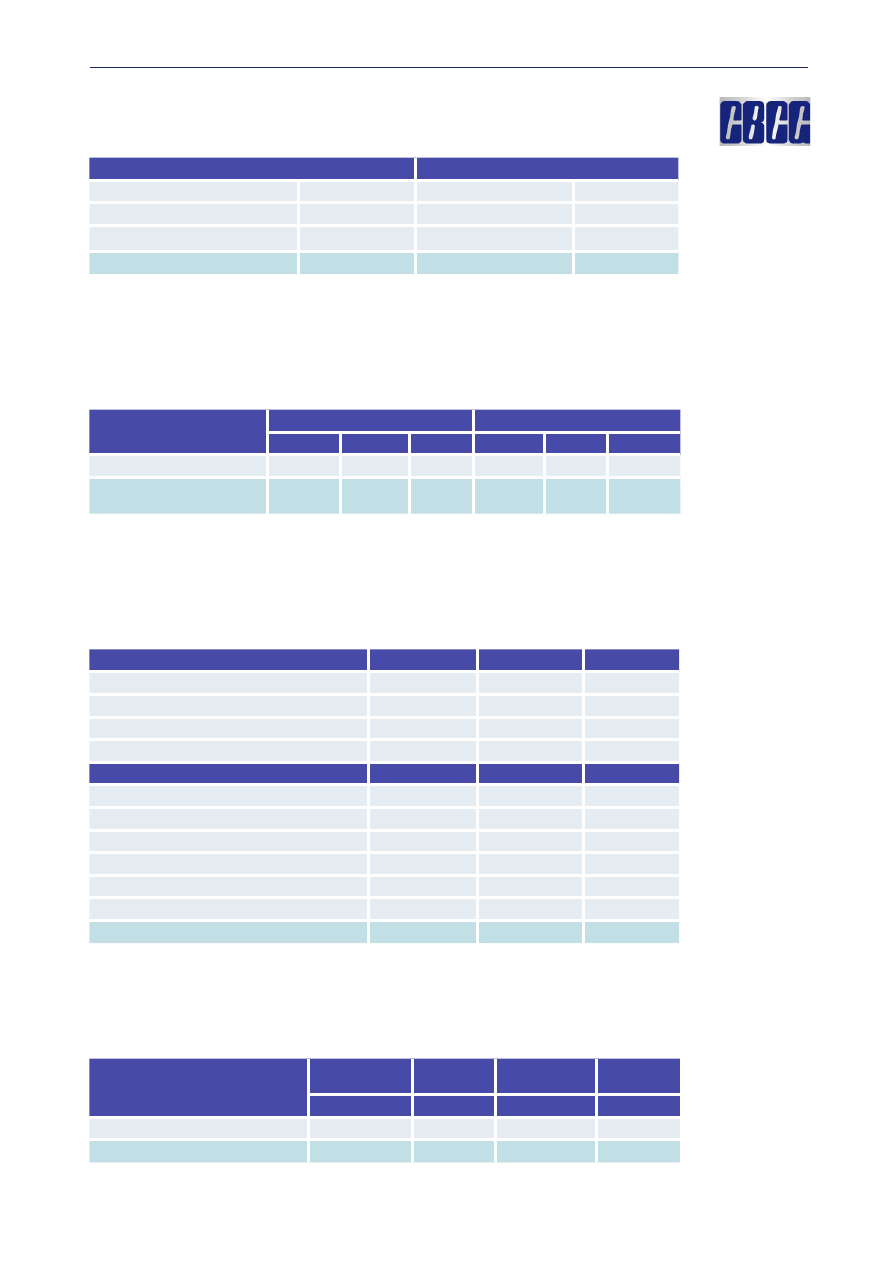
174
2004 DEVELOPMENTS IN THE MONTENEGRIN BANKING SYSTEM
The structure of deposits and loans in 2004 (%)
(at year-end)
Maturity of deposits
Loans
At sight
55.46
Long term loans
39.51
Within one year
40.59
Short- term loans
60.49
Over one year
3.95
Total
100.00
Total
100.00
Proportion of foreign exchange assets and liabilities
(at year-ends)
Type of the financial
institutions
Forex assets / Total assets
Forex liabilities / Total liab.
2002
2003
2004
2002
2003
2004
Banks
6.47
6.55
3.26
6.75
6.73
5.38
Financial Institutions,
average
6.47
6.55
3.26
6.75
6.73
5.38
Structure of revenues and expenditures of financial institutions
(at year-ends)
Revenues
2002
2003
2004
Interest income
24.16
53.62
51.07
Fee income
18.70
38.43
43.03
Other operating income
3.46
5.04
5.89
Extraordinary income
53.68
2.91
0.01
Expenditures
2002
2003
2004
Interest expense
7.08
14.56
14.55
Provision for losses
25.29
14.64
21.92
Fee expenses
5.00
7.41
12.21
Operating expenses
31.17
59.87
49.65
Extraordinary expenses
26.20
1.71
0.13
Taxes
5.26
1.81
1.54
Net profit / loss (000 EUR)
12,118
5,336
-1,116
Structure of registered capital and own funds of financial institutions in 2004
Type of the financial
institutions
Registered
capital
/Total
assets
Own funds
/Total
liab.
000 EUR
%
000 EUR
%
Banks
71,378
16.06
303,792
68.36
Financial Institutions, average
71,378
16.06
303,792
68.36

175
2004 DEVELOPMENTS IN THE POLISH
BANKING SYSTEM
MACROECONOMIC ENVIRONMENT IN POLAND
11
Preliminary estimates indicate that Poland’s GDP growth came to 5.3% in
2004, the highest for seven years, although growth waned from one quarter to
the next.
The main drivers of GDP growth were domestic demand, which rose 4.5%
over the year (as against 2.5% in 2003), gross fixed investment (up 5.1%, com-
pared to a decline of 0.5% the previous year), and exports. Exports and imports,
at 272.1bn zloty and 324.6bn zloty (current prices), were up 30.2% and 22.5%,
respectively, on 2003.
12
The deficit on trade in goods thus amounted to 52.5bn
zloty (having stood at 56.2bn a year earlier).
Industrial output was 11.6% greater than a year before (compared to growth
of 8.1% in 2003). Strong gains were sustained in labour productivity (around
13%, as measured by output per employee), with average employment having
decreased (down 0.4%).
The situation on the labour market improved slightly in 2004. At the end of
December, both the jobless total (2,999.6 thousand) and the unemployment
rate (19.1%) were lower than a year before, having slipped by 176.1 thousand
and 0.9 points, respectively.
Immediately after Poland was admitted to the EU, an acceleration was seen
in consumer price growth, primarily attributable to the increase in food and
transportation prices. Annual inflation came to 3.5%, a figure 1.5 points higher
than had been written into the Budget. Initial figures also show producer prices
running higher than a year previously. Producer price growth averaged 7.0%,
as against 2.6% in 2003.
The dollar traded at an annual average of 3.6540 against the zloty in 2004,
6.0% down on 2003, whereas the euro averaged 4.5340, up 3.1%.
For the first two months of the year, the euro strengthened against the zloty,
reaching an all-time high of 4.9149 on March 1, with the dollar also making gains
(valued at 4.0572 zloty on April 29). The zloty then began to firm, continuing
to do so until year end. At that point, the euro had lost 13.5% to the zloty com-
pared to the end of 2003, while the dollar had weakened 20.1% (taking these
currencies to 4.079 and 2.9904 zloty, respectively).
11
Figures in this section are based on data from the Central Statistical Office (GUS) and the NBP.
12
Expressed in dollars, exports came to 73.8bn, while imports totalled 87.9bn (stated in euros, the relevant fig-
ures were 59.7bn and 71.1bn).

176
The appreciation of the zloty, particularly in the latter half of the year, was
traceable to:
• interest rates that were attractive to foreign investors,
• an improvement in macroeconomic conditions,
• upbeat investor sentiment in the region as a whole (with the strengthen-
ing of the Czech and Slovak koruna, and also the Hungarian forint),
• upgrades in Poland’s rating outlook from two agencies (Standard & Poor’s
and Moody’s),
• an influx of foreign currency to fund purchases of shares in PKO Bank
Polski SA.
The year 2004 was the first in the performance of Poland’s Monetary Policy
Strategy beyond 2003. The basic objective of this Strategy is to stabilise infla-
tion at a low level (2.5% year on year, with a permissible bandwidth of ±1 point
either side of that target). As of January 2004, this represents a constant inflation
target. This means that achievement of the target is not reviewed in December,
as was the case previously, but rather each month throughout the year.
In seeking to hit this target, the Monetary Policy Council shifted its policy
stance in April from neutral to tightening, and then carried out three hikes in
NBP official interest rates, raising them by half a point in June, a quarter point
in July, and half a point in August.
The upshot was that the reference rate (the rate on reverse repos) rose from
5.25% to 6.50%, with the lombard rate going up from 6.75% to 8.00%, the deposit
rate rising from 3.75% to 5.00%, and the rediscount rate going up from 5.75%
to 7.00%. These adjustments to official rates resulted in a similar increase in
money market rates. Average 1-month WIBOR (the Warsaw Interbank Offered
Rate) rose from 5.5% in December 2003 to 6.7% in December 2004, while the
weighted average yield on NBP money market bills climbed from 5.3% to 6.5%,
and that on Treasury bills went up from 6.1% to 6.4%.
However, the final quarter of the year brought a fall in rates on money mar-
ket instruments with the longest maturities. Thus, 12-month WIBOR dropped
from 7.6% in mid-September to 6.6% at year end, while yields on 52-week
T-bills slid from 7.5% to 6.3%.
The increase in central bank and money market rates also led to changes in
the deposit and lending rates the banks were offering their customers. These
changes were smaller than the moves in the reference rate. Weighted average
rates on zloty time deposits rose 0.85 points (from 2.90% to 3.75%), while those
on zloty loans went up 0.76 points (from 9.63% to 10.39%). The effect of this
was therefore to narrow the gap between rates on loans and time deposits by
0.09 points (from 6.73% to 6.64%), to the benefit of bank customers.
13
2004 DEVELOPMENTS IN THE POLISH BANKING SYSTEM
13
Weighted average rates on household zloty deposits went up 0.95 points (from 2.89% to 3.84%), whereas zloty
lending rates for households edged down 0.03 points (from 12.03% to 12.00%), although rates on housing loans
rose 0.50 points (from 7.63% to 8.13%) and those on consumer loans were up 0.16 points (from 15.77% to 15.93%).
As regards corporates, weighted average rates on zloty deposits showed an increase, up 0.4 points (from 2.98%
to 3.38%), as did zloty lending rates, up 1.16 points (from 7.18% to 8.34%).

177
THE POLISH BANKING SECTOR IN 2004
In 2004, the banking sector exerted the determining influence on the stability of
Poland’s financial system, since – as in many other EU countries – it remained
its largest and most developed segment.
However, due to the swifter growth of non-bank financial institutions, the
proportion of financial sector assets held by banks declined to 74.4% (compared
to 77.9% in 2003).
At the end of 2004, operating activity was being carried on in Poland by 650
domestic banks (53 incorporated as public limited companies, 1 state-owned
bank and 596 cooperative banks) and 3 branches of credit institutions.
While the authorised capital of domestic commercial banks declined by 305m
zloty in the course of 2004 (coming down to 11,256m), the members’ share fund
of the cooperative banks went up 13m zloty (to 525m).
At year end 2004, 14 domestic banks were listed on the Warsaw Stock
Exchange, together with 1 foreign bank. Thanks to the flotation of PKO Bank
Polski SA, the share of domestic banks in the capitalisation of the Exchange rose
0.9 points to 33.9%. This is significantly higher than in the other countries of
Central and Eastern Europe.
14
As of 31 December, 2004, there were 13 domestic commercial banks (out of
a total of 54 with majority Polish equity. This group included 5 banks controlled
by the Treasury (2 of them directly), 3 banks affiliating cooperative banks, 4
small private-sector banks and, temporarily, one large high-street bank (follow-
ing the first stage of its privatisation).
15
The remaining 41 domestic banks were controlled directly or indirectly by
foreign investors. In 2004, the equity interests in domestic banks held by these
investors dropped 230m zloty (to 7,086m), while their share of the authorised
capital of the banking sector slipped 0.5 points (to 60.1%).
The high proportion of foreign equity in the Polish banking industry is trace-
able both to privatisations and to the involvement of foreign investors in the
rehabilitation of distressed private-sector banks. It is worth adding that the
banks established by foreign undertakings account for no more than 10% of
the sector’s total assets.
At the end of December 2004, investors from 17 countries were present in the
banking sector. The capital involvement of investors from Belgium, the United
Kingdom and Japan increased (up 302m, 40m and 16m zloty, respectively),
whereas that of German, French and US investors decreased (down 350m, 202m
and 178m zloty, respectively).
At the end of 2004, the ten largest banks in Poland held 71.9% of total
banking sector assets and had taken 78.7% of total deposits from non-financial
customers. Each of these banks had taken at least 10bn zloty in deposits and had
a total footing in excess of 16bn zloty (over 20bn in the case of nine banks).
2004 DEVELOPMENTS IN THE POLISH BANKING SYSTEM
14
At the end of 2003, this ratio stood at 18.7% in Hungary, 16.5% in the Czech Republic and 3.5% in Slovakia.
15
As of January 2005, this bank has majority foreign equity.

178
The level of concentration was lower in loans than in assets, but higher in
deposits. The reduction in banking industry concentration observed in recent
years (as measured using both the Herfindahl-Hirschman Index
16
and the
market shares of the five, ten and fifteen biggest banks
17
) is related to small and
medium-sized banks expanding more swiftly than large ones.
The economic upturn had a positive impact on the development of the bank-
ing industry in 2004. The total assets of the banks rose 10% to 538bn zloty,
thereby growing twice as fast as in 2003 (4.8%). Asset growth would have been
even faster, at 14.3%, had it not been for the appreciation of the zloty. Following
the increase in earnings, ROE increased by 12.2 percentage points and ROA
by 0,9 percentage points.
THE NEW DEVELOPMENTS IN THE LEGAL FRAMEWORK
OF THE SUPERVISION OF FINANCIAL INSTITUTIONS IN
POLAND IN 2004
Poland’s entry to the European Union had been preceded by many years in
which Polish legal regulations had been brought into line with EU standards.
At the date of accession, Polish banking law was in full conformity with the
acquis communautaire.
The most recent comprehensive amendments to Poland’s Banking Act were
adopted by the Polish Sejm (the lower house of parliament) on April 1, 2004. In
terms of the effectiveness of banking supervision, the most significant changes
relate to the capital base (regulatory capital, or “own funds”), capital adequacy
and large exposures; the amendments on these questions were the only ones
which did not take effect until January 1, 2005.
• In accordance with Directive 2002/87/EC of the European Parliament
and of the Council of 16 December 2002 on the supplementary supervi-
sion of credit institutions, insurance undertakings and investment firms
in a financial conglomerate, Article of the Banking Act was amended to
include a requirement that capital holdings in insurance undertakings
also be deducted from a bank’s capital base.
• In terms of a bank’s “interim results” (profit pending audited confirma-
tion and current period net earnings), it was stated that, subject to fulfil-
ment of certain conditions specified in the Act, these could be included in
additional items of core capital.
• The calculation of capital adequacy was made uniform by abandoning the
practice of reducing the capital base by the amount exceeding the ceiling
on capital holdings, while including the relevant charge in a bank’s overall
capital requirement.
2004 DEVELOPMENTS IN THE POLISH BANKING SYSTEM
16
The Herfindahl-Hirschman index (HHI) is defined as the sum of the squares of the market shares of particular
companies in a given industry (e.g., the sum of the squares of the share of banks in total banking sector assets);
thus, HHI = ∑w
i
2
, where w
i
is the market share of bank i (i = 1,2,3, …, n).
17
Referred to as the discrete concentration ratio, CR.

179
• In order to give a more precise content to large exposures limits, the
definitions involved were expanded. These now not only refer to “credit
exposures”, but also to “equity exposures”. On the other hand, exposures
were exempted from the large exposure and clustering limits where the
bank’s obligor is another domestic bank or a credit institution, and where
the exposures concerned mature in no longer than one year, with the
exception of those items included in the capital base of the domestic bank
or credit institution.
• New articles in the Act regulate the question of outsourcing, an impor-
tant issue for the banking sector. The solutions adopted here attempt to
reconcile the banks’ drive to maximise profitability with the need to ensure
the safety of deposits taken. Outsourcing agreements should allow banks
to carry on their operations in compliance with legal regulations and to
ensure each bank is managed in a prudent and stable manner, while also
enabling the Commission for Banking Supervision to exercise effective
supervision over the activities outsourced by a given bank.
• A legal framework for securitisation, long-awaited by the banking indus-
try, was established in the Banking Act, thereby creating new methods for
asset restructuring, which should contribute to a further improvement
in the quality of loan portfolios. The essence of securitisation is that it is
predicated on issuing securities backed by claims or receivables. Banks
are the sole financial market institutions to have been given an opportu-
nity to carry out operations of this kind, using either a securitisation fund
(a particular kind of closed-end investment fund) or a special-purpose
company (as the issuing vehicle).
18
• In line with international trends in the regulation of financial markets, the
Banking Act was amended to strengthen significantly the role of internal
controls, by requiring banks to have an internal control system in place.
This legislation also raises the status of the internal audit function, which
all banks should have (with the exception of cooperative ones, where in-
ternal audit is performed by the affiliating bank). The Act clearly stipulates
that these functions cannot be outsourced to third parties.
• In addition, other amendments to the Act make more precise the provi-
sions concerning:
− the principles governing the communication by banks of information
subject to the obligation of banking secrecy,
− the consolidated supervision of banks,
− controls over the transfer of title to shares in banks incorporated as
public limited companies,
− rehabilitation and liquidation proceedings at banks,
− liquidity.
2004 DEVELOPMENTS IN THE POLISH BANKING SYSTEM
18
An important point is that the tax regulations recognise any loss incurred on the sale of assets to securitisation
funds as tax-deductible expense, up to the level of the associated specific provision expensed against income.

180
As of January 1, 2004, amended principles are in place for asset classifica-
tion and specific provisioning. The largest changes involve:
• extending the period of delinquency that requires a downgrade in
classification,
• simplifying the classification procedures for retail loans and advances
(with only one category of irregular assets, i.e., “loss”),
• allowing consideration to be given to the most robust forms of security
already at the stage when an exposure is being classified,
• introducing a requirement for the bank to verify the eligible security it has
taken with respect to the delinquency in the claim thus secured, setting
a maximum period of eligibility (applicable to the security in whole or in
part).
The implementation of this new system, which resembles the solutions
applied in most European countries, concluded the period of convergence
between Polish requirements and EU standards.
Following on from the amendments to the Banking Act, adjustments were
made to the prudential regulations issued by the Commission for Banking
Supervision (these took effect on January 1, 2005).
• The most significant changes to the calculation of capital adequacy
(introduced under Commission Resolution no. 4/2004, September 8,
2004), entail the following:
− the capital requirement for a breach of the ceiling on capital holdings
has been included in the overall capital requirement,
− securitisation, subparticipations and credit derivatives have been
recognised as credit risk mitigation techniques,
− the constraints concerning mortgage collateral in force for the purposes
of specific provisioning (the LtV limit) have been moved to the calcula-
tion of credit risk capital requirements
19
, and
− the coefficients used in determining the equity price risk requirement
have been lowered to the level in force in other EU countries.
• The key change introduced under Commission Resolution no. 5/2004,
September 8, 2004, relates to the procedures for deducting holdings
in other financial undertakings and banks from a bank’s capi-
tal base; this derives from Article 35, paragraph 2, point 12, of Directive
2000/12/EC. This resolution requires that non-qualifying holdings also be
deducted from the capital base, i.e., ones that individually are no greater
than 10% of the capital base, where their aggregate amount exceeds the
said limit. The effects of this provision will primarily be felt by cooperative
banks, which will have to reduce their capital base by the value of their
holdings in their affiliating bank and other cooperative banks.
2004 DEVELOPMENTS IN THE POLISH BANKING SYSTEM
19
This is to encourage banks to utilise the valuations of expert appraisers and to increase the value of the collat-
eral they take relative to the loans they make.

181
Further, the resolution specifies the principles governing the inclusion in
the capital base of profit pending audited confirmation and current period
earnings.
• Changes were also made to another prudential regulation in the wake
of the amendments to the Banking Act, which – in line with Directive
2000/12/EC – employ the concept of a large exposure limit rather
than a credit concentration limit, and which alter the scope of exempt
exposures. In particular, Commission Resolution no. 6/2004, September
8, 2004, contains the following provisions:
− it defines the conditions for exemptions from large exposure limits in
the trading book, at banks with significant trading book business,
− it gives more detailed procedures for the treatment of contingent
commitments and off balance sheet trading transactions,
− it extends the list of exempt exposures.
MAIN STRATEGIC OBJECTIVES OF THE SUPERVISORY
AUTHORITY IN 2004
The strategic areas of activity of the Commission for Banking Supervision in
2004 were set by the progressing changes in the Polish banking sector, imple-
mented in relation to Poland’s accession to the EU and the necessity to meet the
requirements of the new environment. The performed works continued earlier
trends, such as banking sector consolidation and the increase in competition
among banks.
A new task of banking supervision in 2004 was the analysis of notifications
submitted by relevant supervisory authorities of the home country, which speci-
fied the activities that a credit institution intended to perform within the frame-
work of banking activities conducted by a branch, or cross-border activities.
This requirement follows from the provisions of the Banking Act, according to
which on May 1, 2004 credit institutions having their registered office on the
territory of one of the EU Member States were authorized to pursue activities
on the territory of Poland upon prior submission of relevant notification.
THE ACTIVITIES OF THE COMMISSION FOR BANKING
SUPERVISION IN 2004
The Commission for Banking Supervision played an important part in the im-
provement of the financial standing of Polish banks. The Commission actively
supported, among other things, the activities of banks’ authorities aimed at rais-
ing additional capital, by referring investors interested in commencing banking
activity to banks and proposing banks with larger capital to participate in recov-
ery processes at banks threatened with bankruptcy. This enlarged their capital,
helped commence recovery actions, or facilitated takeovers by other banks. The
Commission’s undertakings were also focused on restructuring activities and
on improvement of management quality at banks.
2004 DEVELOPMENTS IN THE POLISH BANKING SYSTEM

182
As regards the banks in an unstable condition, certain interventions were
undertaken under applicable legal regulations and depending on the ongoing
assessment of the risk borne by banks, which included issued recommenda-
tions or relevant rulings.
The Commission for Banking Supervision initiated numerous activities at all
the banks implementing recovery programs, in order to accelerate the banks’
return to a secure level of operation. The Commission monitored on an ongoing
basis the condition of banks implementing recovery programmes and it watched
the progress of banks at which supervisory activities were initiated.
In the course of its activities, the Commission closely cooperated with the
Bank Guarantee Fund, which was notified, on a regular basis, of any decisions
obliging banks to commence recovery proceedings, of initiated supervisory ac-
tivities and, in individual cases, of the condition of particular banks, especially
those using the Fund’s financial assistance. The Commission submitted results
of examinations performed at banks that used the Fund’s assistance, whereas
the BFG submitted the results of its audits at those banks.
Moreover, the CBS issued permits for purchases of qualifying holdings,
which allowed investors to gain control over banks. The issuance of a permit to
purchase shares at a bank that was significant for the banking sector required
certain declarations to be made by the strategic investor, related to e.g. retain-
ing the local character of a bank, maintaining quotations of the bank’s shares
at the stock exchange, or a specific bank development strategy.
Fulfilment of the declared commitments was supervised on an ongoing ba-
sis, as well as the fact whether the implemented strategy ensured appropriate
and secure development of banks.
Within the framework of direct analytical supervision the Commission
regularly received information on the implementation of post-examination
recommendations, on the compliance of banks’ operations with binding legal
regulations and prudential standards, on timely submission and accuracy of
statements. As a result, interventions were possible in the case of delayed im-
plementation of recommendations or a necessity for the banks to supplement
submitted information.
Within consolidated supervision
20
, the Commission monitored the capital
adequacy of banking groups and the impact of subsidiaries on the banks’ finan-
cial standing. The financial condition of parent undertakings of Polish banks, as
well as the economic condition of foreign shareholders of domestic banks and
its potential impact on those banks were also analysed.
To sum up, the activities undertaken by the Commission for Banking
Supervision in 2004 facilitated effective achievement of the objective set by the
legislator for banking supervision, i.e. assuring security of funds held on bank
accounts and banks’ compliance with the provisions of the Banking Act, the Act
on the National Bank of Poland, their articles of association and issued rulings
on the authorization to establish a bank.
2004 DEVELOPMENTS IN THE POLISH BANKING SYSTEM
20
In accordance with Art. 141f Section 1 of the Banking Act, consolidated supervision shall apply to those domestic
banks which are the parent of another domestic bank, a foreign bank, a credit institution, a financial institution
or an ancillary banking services undertaking, which have close links with another undertaking or undertakings,
and operate within a financial group or a mixed-activity group.
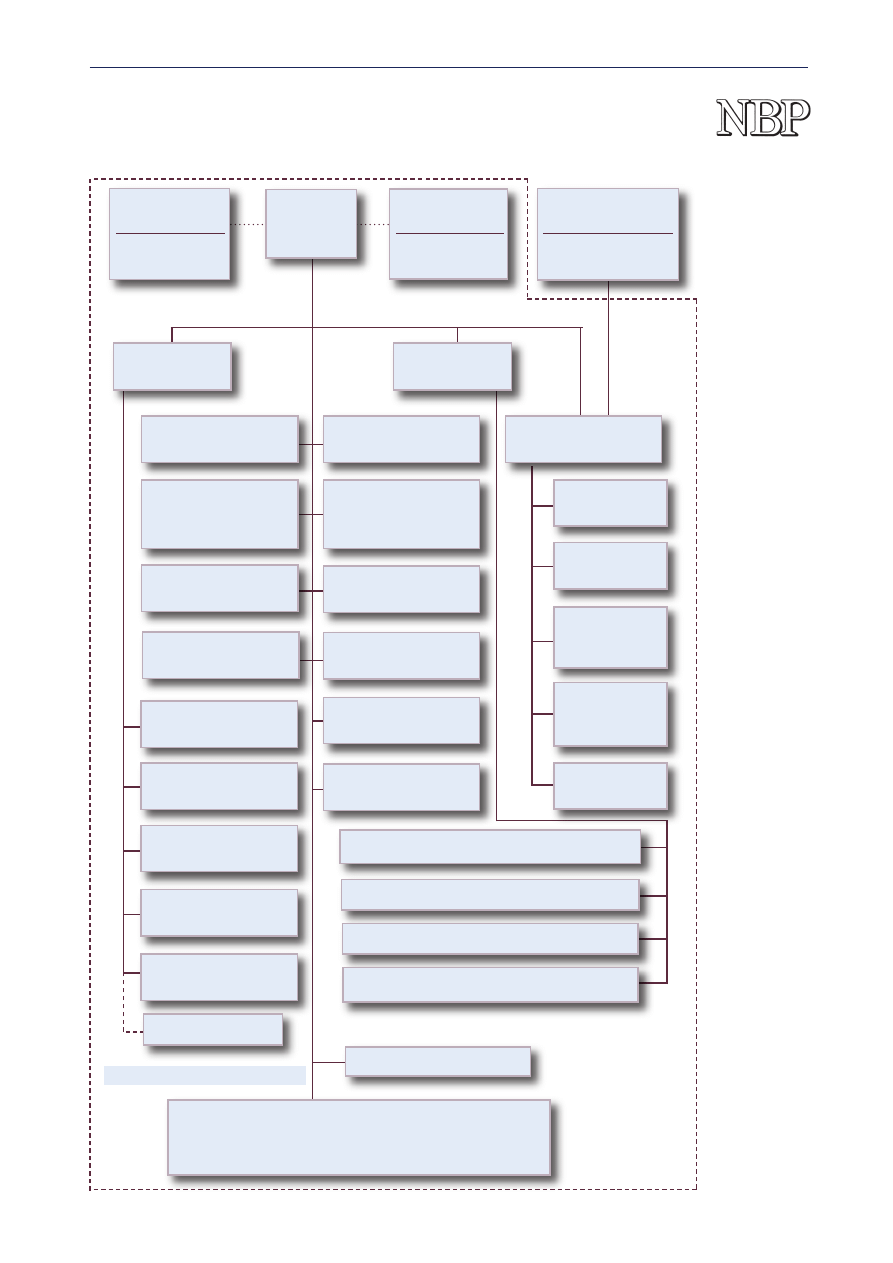
183
ORGANIZATIONAL CHART OF THE BANKING
SUPERVISORY AUTHORITY
2004 DEVELOPMENTS IN THE POLISH BANKING SYSTEM
NBP HEAD OFFICE
Monetary Policy
Council
Chairperson
President of NBP
PRESIDENT
OF THE NBP
NBP Management
Board
Chairperson
President of NBP
Comission for Banking
Supervision
Chairperson
President of NBP
Deputy President
First Deputy
President
General Inspectorate of
Banking Supervision
Bank Licensing
Division
Supervisory
Policy Division
Banking Systems
Off-Site Analysis
Division
On-Site
Examination
Division
Co-operative
Banking Division
Administration
Department
Information Technology
& Telecommunication
Department
Security Department
Office of the President
Department of
Information and Public
Relations
Internal Audit Department
Legal Department
Personnel Department
International Department
Macroeconomic and Structural Analysis Department
Department of Statistics
Foreign Exchange Department
Bureau of Macroeconomic Research
Financial System
Department
Domestic Operations
Department
Accounting and
Operations Department
Payment Systems
Department
Cash and Issue
Department
Support Services Office
Regional Branch in:
Opole
Bialystok
Katowice Lubin
Poznań
Warsaw
Bydgoszcz
Kielce
Lódż
Rzeszów
Wroclaw
Gdansk
Kraków
Olsztyn
Szczecin
Zielona Góra
Financial Risk
Management Department
Operational Risk Unit

184
INTERNATIONAL ACTIVITIES OF THE COMMISSION FOR
BANKING SUPERVISION IN 2004
Poland’s membership in the EU greatly strengthened international coopera-
tion. The dissolution or reorganization of previously existing bodies under
which the European banking supervisors operated (e.g. the Banking Advisory
Committee) re-oriented the involvement of supervisors in the works on EU
legislation from a political level to a purely content-oriented approach. New
committees and working groups of the EU Council were established. Currently,
the European supervisors operate under the Committee of European
Banking Supervisors.
In 2004, the representatives of the Polish supervision joined the works of
25 working groups operating within the EU. Through the participation in the
working groups of the European Central Bank (ECB) and the Committee of
European Banking Supervisors (CEBS), Groupe de Contact (GdC) and the EU
Banking Advisory Committee, Poland significantly contributes to the develop-
ment of the common EU policy for the financial system supervision.
One of the crucial elements of the international cooperation was the par-
ticipation of the supervisory authority in the procedures of identification and
supervision of financial conglomerates. These tasks were performed together
with Polish Security and Exchange Commission (KPWiG) and Commission of
Supervision of Insurance Companies and Pension Funds (KNUiFE) and the
Ministry of Finance.
The supervisory authority employees participated in the preparation of
NBP’s stance for EU committees and working groups. They were also involved
in coordination of the participation of experts in the works on the EU forum
(for the needs of the Ministry of Finance, the Ministry of Economy and Social
Policy, the Office of the Committee for European Integration and for the needs
of the NBP).
The supervisory authority actively participated in the works of the Committee
of European Banking Supervisors (CEBS) and its working groups. The most
important issues included the transfer of the New Capital Adequacy (NCA)
provisions to the provisions of the amended Directives 2000/12/EC and 93/6/
EEC.
The particularly important event for the Polish supervisory experts was
the opportunity to participate in the works of working groups responsible for
developing coherent and uniform for the whole EU:
• standards for financial reporting and banks’ capital adequacy reporting;
• standards for the transparent operations of the supervision (the so-called
supervisory disclosures);
• requirements for internal models applied by banks and procedures for
their recognition by supervisory authorities in EU Member States.
The employees of the banking supervision also joined the works of the
Council of Europe Select Committee of Experts on the Evaluation of Anti-
Money Laundering Measures in Central and Eastern European Countries
(MONEYVAL). They focused, in particular, on the assessment of evaluation
reports from Russia, Moldova and Armenia.
2004 DEVELOPMENTS IN THE POLISH BANKING SYSTEM

185
A particularly important aspect of the bilateral cooperation was the partici-
pation of the supervisory authority in negotiations lasting for over 2 years and
leading to the conclusion of the supervisory cooperation agreement between the
Commission for Banking Supervision and the Board of Governors of the Federal
Reserve System, the Office of the Comptroller of the Currency and the Federal
Deposit Insurance Corporation of the United States of America in October 2004.
The agreement regulates the scope and procedures of consolidated supervision
over banks operating in financial groups.
Two months later, in December 2004, the Commission for Banking
Supervision concluded a supervisory agreement with the German banking
supervision authority, Bundesanstalt für Finanzdienstleistungsaufsicht.
TRAINING INITIATIVE FOR BANKING SUPERVISION
ACTIVITIES IN 2004
In 2004, the TIBS held two seminars addressed to the supervisors from Central
and Eastern Europe
21
:
– “Credit Risk Management: the Banker’s and Regulator’s Perspective” –
May 31 – June 4, 2004,
– “Consolidated Supervision” – November 22 – 26, 2004.
Additionally, as part of the TIBS and at the request of Mr. Olexandr Shlapak,
Deputy Governor of the National Bank of Ukraine (NBU), the Polish banking
supervisory authority conducted a seminar in Kiev on September 5 – 10, 2004.
The seminar entitled “Risk Based Supervision” was addressed to the supervi-
sors of the Ukrainian central bank.
2004 DEVELOPMENTS IN THE POLISH BANKING SYSTEM
21
In total, 59 persons from 22 countries participated in TIBS seminars organized in Poland in 2004. The par-
ticipants represented both the regional group of supervisors from Central and Eastern European countries and
the states of the former Soviet Union. The countries that have participated in the TIBS training so far include:
Armenia, Belarus, Bosnia Herzegovina, Bulgaria, Croatia, Czech Republic, Estonia, Georgia, Hungary, Serbia and
Montenegro, Kazakhstan, Kyrgyz Republic, Latvia, Lithuania, Macedonia, Moldova, Poland, Romania, Russia,
Slovakia, Slovenia, and Ukraine.
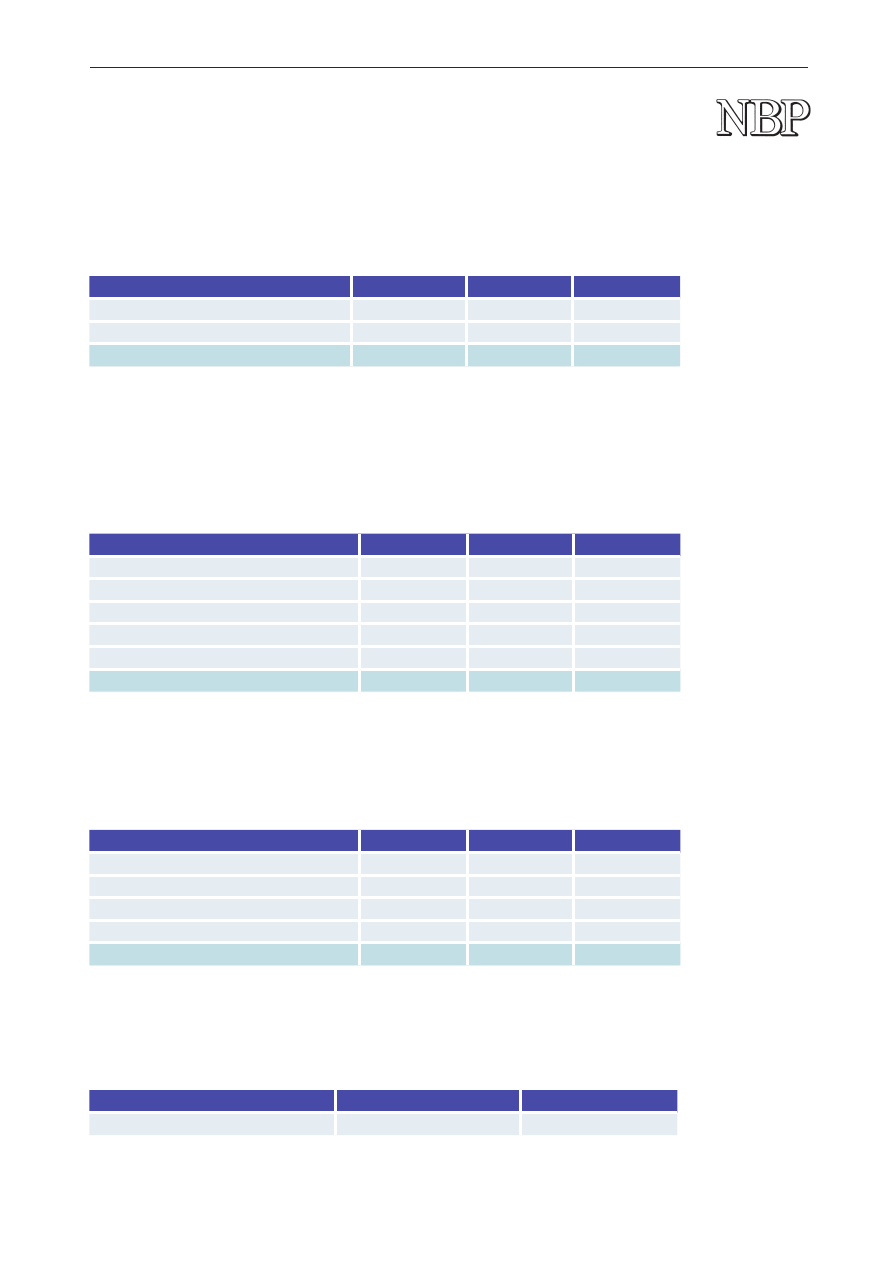
186
STATISTICAL TABLES
Number of financial institutions
(at year-ends)
Type of financial institution
2002
2003
2004
Commercial banks
59
58
54
Cooperative banks
605
600
596
Banking sector
664
658
653
Ownership structure of the financial institutions the basis of registered capital (%)
(at year-ends)
Item
2002
2003
2004
Public sector ownership
17.3
16.9
13.9
Other domestic ownership
9.5
9.6
9.0
Domestic ownership total
26.8
26.5
22.9
Foreign ownership
63.2
63.3
63.9
Dispersed holdings
13.1
10.2
13.2
Total commercial banks
100.0
100.0
100.0
Ownership structure of the financial institutions on the basis of assets total
Item
2002
2003
2004
Public sector ownership
26.4
25.8
25.8
Other domestic ownership
2.7
2.7
2.7
Domestic ownership total
29.1
28.5
28.5
Foreign ownership
70.9
71.5
71.5
Total commercial banks
100.0
100.0
100.0
Concentration of asset by the type of financial institutions (%)
Type of institutions
The first three largest
The first five largest
Commercial banks
39.7
52.3
2004 DEVELOPMENTS IN THE POLISH BANKING SYSTEM
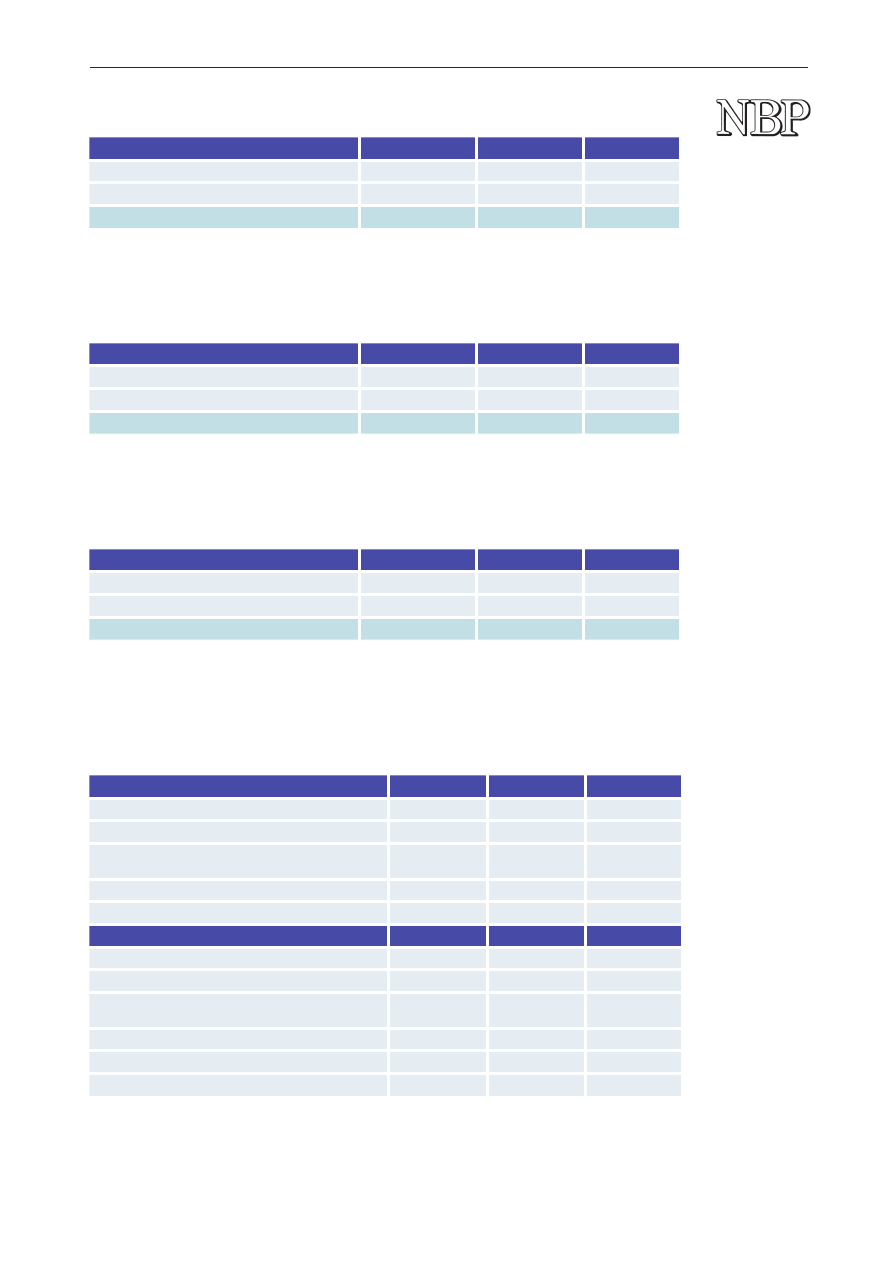
187
Return on asset (ROA) by type of financial institutions
Type of institution
2002
2003
2004
Commercial banks
0.5
0.5
1.4
Co-operative banks
1.6
1.2
1.8
Banking sector
0.5
0.5
1.4
Return on equity (ROE) by type of financial institutions
Type of institution
2002
2003
2004
Commercial banks
5.2
5.4
17.4
Co-operative banks
18.2
12.2
18.4
Banking sector
5.8
5.8
17.5
Distribution of market shares in balance sheet total (%)
Type of financial institution
2002
2003
2004
Commercial banks
95.0
94.7
94.7
Co-operative banks
5.0
5.3
5.3
Banking sector
100.0
100.0
100.0
The structure of assets and liabilities of the banking system (%)
(at year-end)
Assets
2002
2003
2004
- Cash and balance with Central bank
4.6
3.9
3.7
- Interbank deposits
16.7
15.7
19.8
- Due from non-financial and government
entities
46.3
48.4
45.9
- Secuirties
22.6
23.2
21.5
- Other assets
9.8
8.7
9.1
Liabilities
2002
2003
2004
- Borrowing from Central Bank
0.6
0.5
0.4
- Interbank deposits
13.4
14.9
14.6
- Deposits from non-financial and government
entities
61.1
64.6
62.4
- Bonds
0.8
1.1
1.2
- Other liabilities
14.0
8.8
11.6
- Capital and reserves
10.1
10.1
9.8
2004 DEVELOPMENTS IN THE POLISH BANKING SYSTEM
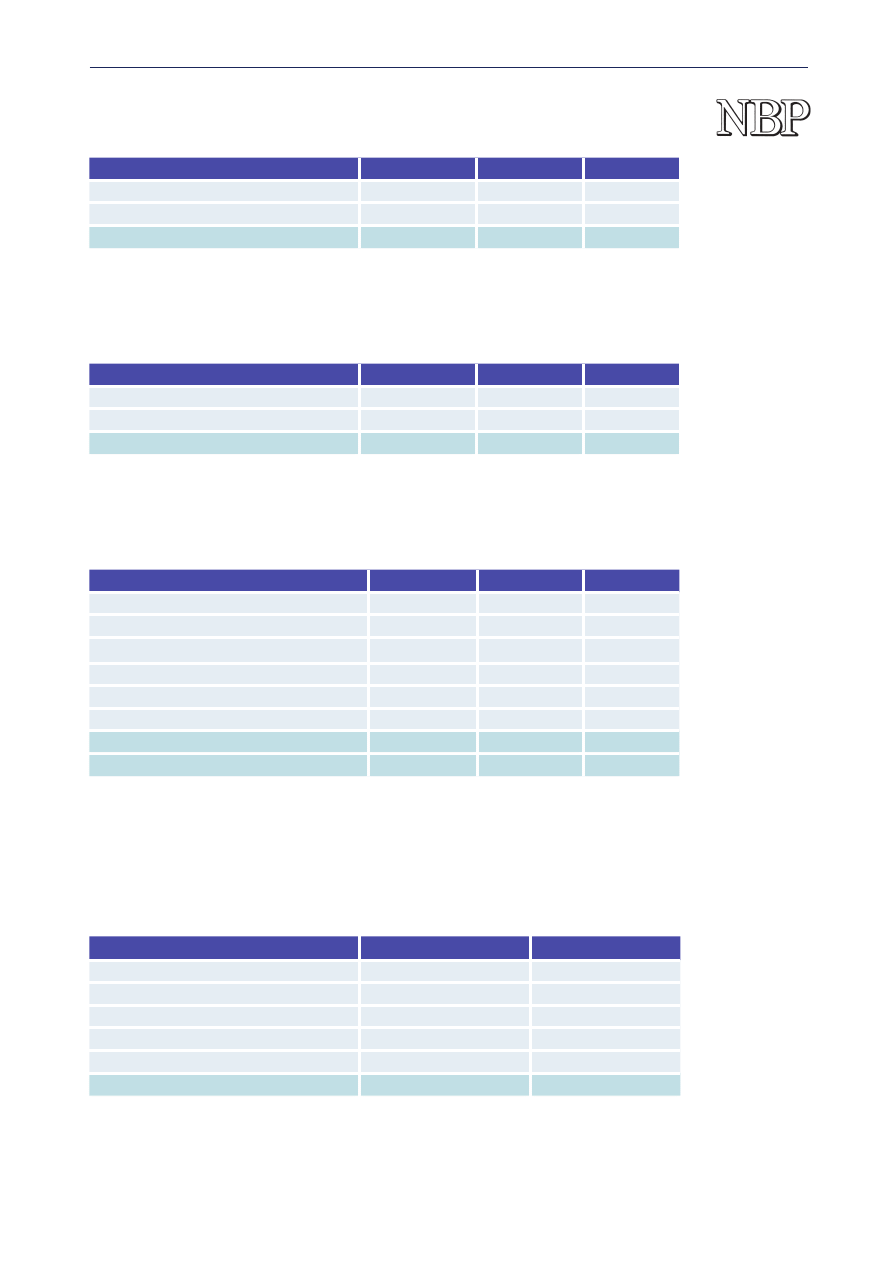
188
Development of off-balance sheet activities (%)
(off balance sheet items / balance sheet total)
Type of financial institution
2002
2003
2004
Commercial banks
259.1
335.1
321.5
Co-operative banks
0.4
0.6
0.8
Banking sector
259.5
335.8
322.2
Solvency ratio of financial institutions
Type of the financial institution
2002
2003
2004
Commercial banks
13.8
13.7
15.5
Co-operative banks
13.4
14.2
14.1
Banking sector
13.8
13.7
15.4
Asset portfolio quality of the banking system
Asset classification*
2002
2003
2004
- Consumer loans classified satisfactory
16.8
16.1
18.7
- Special mention claims
6.8
6.2
6.3
- Irregular claims. of which:
– substandard
4.8
4.6
2.6
– doubtful
5.6
5.6
2.6
– loss
10.7
11.0
9.6
Classified total
21.1
21.2
14.8
Specific reserves
18 341.4
20 001.3
18 886.5
* From non-financial institutions
The structure of deposits and loans in 2004 (%)
(at year-end)
Deposits
Loans
Households
63.8
44.1
Government sector
7.4
8.0
Corporate
26.0
47.6
Foreign*
1.2
0.8
Other
2.8
0.3
Total
100.0
100.0
* Deposits and loans are included in others items
2004 DEVELOPMENTS IN THE POLISH BANKING SYSTEM
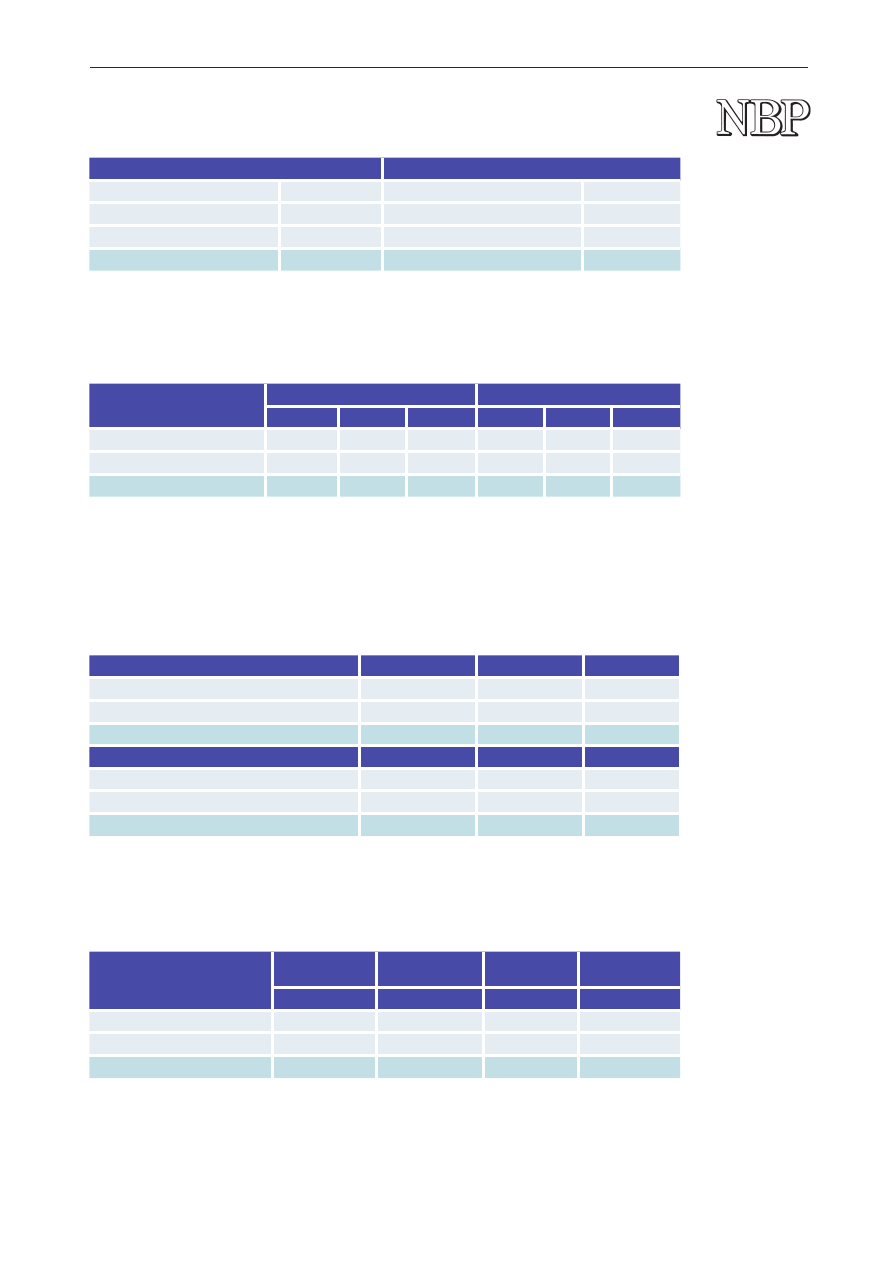
189
The structure of deposits and loans in 2004 (%)
(at year-end)
Maturity of deposits
Loans
At sight
36.1
Long term loans
60.4
Within one year
56.7
Medium-term loans
24.3
Over one year
7.2
Short-term loans
15.3
Total
100.0
Total
100.0
Proportion of foreign exchange assets and liabilities
(at year-ends)
Type of the
financial institutions
FOREX assets / Total assets
FOREX liabilities / Total liab.
2002
2003
2004
2002
2003
2004
Commercial banks
23.9
25.2
23.5
18.8
19.1
16.8
Co-operative banks
0.2
0.2
0.6
0.0
0.2
0.4
Banking sector
22.7
23.9
22.3
17.1
18.2
16.0
Structure of revenues and expenditures of financial institutions
(at year-ends)
million zloty
Revenues
2002
2003
2004
Commercial banks
86,215.4
74,275.6
77,713.4
Co-operative banks
3,657.8
3,234.9
3,453,0
Banking sector
89,873.2
77,510.5
81,166,4
Expenditures
2002
2003
2004
Commercial banks
82,884.5
71,174.2
70,282,8
Co-operative banks
3,161.9
2,832.0
2,862,9
Banking sector
86,046.3
73,007.2
73,145.7
Structure of registered capital and own funds of financial institutions in 2004
Type of the
financial institutions
Registered
capital
/Total sector
assets
Own funds
/Total liab.
EUR
%
EUR
%
Commercial banks
2,259.4
2.1
12,065.1
9.2
Co-operative banks
111.4
0.1
709.5
0.5
Banking sector
2,870.8
2.2
12,774.6
9.7
2004 DEVELOPMENTS IN THE POLISH BANKING SYSTEM

190
2004 DEVELOPMENTS IN THE
ROMANIAN BANKING SYSTEM
MACROECONOMIC ENVIRONMENT
In 2004, the Romanian economy experienced accelerated growth, with real GDP
expanding by 8.3 percent, faster than both the originally projected figure of 5.5
percent and the revised figure of 7.3 percent. The development was bolstered
by domestic demand, with the growth rate of household actual final consump-
tion rising by 3.6 percentage points from 2003 to 10.8 percent, amid significant
increase in household incomes (including remittances) and in self-consump-
tion against the backdrop of a bumper crop in 2004; unlike in the previous
year, lending was no longer a major driver of household consumption, but high
real interest rates provided an underpinning to saving. Consumption of public
administration was in line with the cautious fiscal policy (4.6 percent, similar
to the figure recorded in the previous year) despite the increases recorded in
2004 Q2 and Q4 associated with municipal and general elections.
Gross fixed capital formation grew at a fast pace (10.1 percent, up one
percentage point against 2003), albeit lower than that of final consumption,
due to the upturn in investment in retooling and construction. By contrast,
net exports had further a significant negative contribution to GDP growth
(2.7 percentage points); the growth rate in exports, owing to the expansion
in foreign demand from key trading partners and to the favourable envi-
ronment of some market segments, was further outpaced by the increase in
imports triggered by the rise in domestic demand.
DEVELOPMENT IN THE BANKING SYSTEM
2004 marked, in Romania, a period of progress which contributed to the increase
of the trust in the banking system, supported by its restructuring, the diversifi-
cation of the banking products portfolio, the increase of the purchasing power
of the population, and the macroeconomic stabilization. The expansion of the
banking assets in 2004 (+35,7% in real terms compared with the previous year),
higher than economic increase (+8,3%), lead to diminishing of the difference
between Romania and other countries from the region in terms of the banking
assets share in GDP further to its increase from 31.0% at the end of 2002 to
32.0% in December 2003, to 37.7% at end-December 2004, respectively.
Behind the increase in banks’ net aggregate assets stood the real 36.0 per-
cent pick-up in interbank operations and the 26.5 percent growth of lending to
non-banks. Operations in government securities increased with 124.4 percent
over the year before. As at end-December 2004, operations with non-banks
held the largest share in total assets, i.e. 46.5 percent, ahead of interbank
operations on 36.0 percent.

191
The share of the non-governmental credits in GDP increased from 15.9%
in 2003 to 17.5% in 2004. Despite to this end, the loans granting activity was
characterized, in 2004, by a more temperate growth rhythm compared with the
previous year (real growth decreased from 50% in 2003 to 26% in 2004). The
rhythm slowed down in the context of the restrictive politics imposed by the
central bank by the entering into force of the norms regarding the limitation of
the risk related to the consumer credit (NBR Norms no.15/2003) and mortgage
credit (NBR Norms no.16/2003).
The dynamics of the non-governmental credit is still given by the credits
granted to population
22
, whose rhythm of real annual increase (44,8%), much
lower than the previous year (215%), but higher than the non-governmental
credits, explains the increase of the weight of this segment from 24,8% to 28,4%.
The weight of real estate and mortgage credits increased from 25,6% at the end
of 2003 to 28,4% on 31.12.2004, consumer credits representing approximately
two thirds of its volume.
As far as the currency of denomination of credits is concerned, the credits in
foreign currency are preferred (60,8% of the non-governmental credits
23
), in
the last years the European currency imposed decisively towards the US dollar
and ROL. This orientation towards EUR currency appears in the context of the
extension of maturities of the credits granted to population, and, implicitly, of
the need of adequate provisioning of the total costs related to credit, by report-
ing to a more stable currency the national currency.
Significant progresses were also made in the evolution of the indica-
tors defining the quality of assets portfolio. The weight of the past due and
doubtful credits (net value)
24
in the total of credits oscillated between 0,6%
in March 2004 and 0,3% at the end of 2004, while past due and doubtful
claims (net value)/ total assets ratio fluctuated in the same period between
0,2% and 0,4%. Even in the context of including the off-balance sheet past
due claims in the calculation of the above mentioned ratio, it registered sig-
nificant restrains between 2000 – 2004, going from 13,4% on 31.12.2000
to 6,1%, respectively 4,2% at the end of last two years.
The decreasing values of these ratios reflect both the improvement of the
parameters of the banking system, as well as the increased interest of the
banks for obtaining a portfolio of performing credits.
To the same conclusion lead the information provided by the reports
regarding the credits’ classification, reported by the credit institutions. Thus,
at the end of 2004, the NPL’ ratio (calculated as a weight of the credits clas-
sified as doubtful and loss in the total of portfolio), registered the lowest val-
ues (2,9%) from the moment of entering into force of the NBR Regulation
no. 5/2002 (modified by the NBR Regulation no.7/2002), which provided
more severe criteria for classifying the debtors.
2004 DEVELOPMENTS IN THE ROMANIAN BANKING SYSTEM
22
According to the information provided by the monetary balance of the credit institutions
23
According to the monetary balance sheet
24
Registered in the accounting balance sheet

192
In 2004, there was also an improvement of the efficiency of the banking
sector, quantified through the ratios of financial return on equity – ROE and
on assets – ROA, 15.6% and, respectively 2.0%. The analysis of the financial
performance of banks revealed an increased of the aggregated net income at
the end of 2004 with 4,484.7 billion ROL in comparison with the previous
year, representing an increase with 33.6% in nominal terms and 22.2 in real
terms, respectively, exclusively due to the supplementing with 47.2% of the
interest net incomes. A major contribution to this dynamics had it the net
incomes related to the lending of the non-banking clients, increasing with
more than 67.5% in comparison with the previous period. A more rapid
increase in terms of profitability was registered especially by the banks which
increased the share on the credit market.
THE LEGAL AND INSTITUTIONAL FRAMEWORK OF
THE OPERATION AND SUPERVISION OF BANKS, NEW
DEVELOPMENTS
In 2004 good progress saw harmonization of banking legislation with EU
requirements in the field. The most important laws, norms and regulations
issued during 2oo4, are the following:
• Law no. 443 amends and supplements the provisions of Law 58/1998 on
banking activity;
• Law no. 149 amends and supplements the provisions of the Insolvency
Act as well as of other pieces of legislation on insolvency;
• Law no. 278 approves, amends and supplements the provisions regarding
judicial reorganization and winding up proceedings of credit institutions;
• Law no. 289 regulates the legal status of consumer loans agreements for
individuals;
• Regulation no.4 governs the organization and operation of the Credit Risk
Bureau on the premises of the NBR;
• Norms no. 5 regulate the capital adequacy of credit institutions on a con-
solidated basis and on an unconsolidated basis by implementing Directive
93/6/EEC, amended by the Directive 98/31/CE and 98/33/CE;
• Norms no. 15 lay downs the principles of supervision of credit institutions
on a consolidated basis and sets the prudential consolidation methods,
implementation of prudential requirements at a consolidated level;
• Norms no.9 amend and supplement the provisions of NBR no.12/2003
on supervision of solvency and large exposure of credit institutions;
• Norms no.10 lay down the procedures of licensing, the terms and condi-
tions, as well as the documents that must be submitted to the NBR for the
licensing of banks, electronic money institutions other than banks, as well
as savings banks for housing and branches of foreign credit institutions
operating in Romania;
• Norms no.11 regulate the conditions under which changes can be made
in the standing of banks, electronic money other than banks, real estate
saving house and foreign banks branches.
2004 DEVELOPMENTS IN THE ROMANIAN BANKING SYSTEM

193
THE ACTIVITIES PERFORMED BY THE BANKING
SUPERVISORY AUTHORITY
The new co-ordinate of the Romanian banking market together with the increase
of the complexity of the banking activity required the constant improvement
of the supervision process. In this context, the risk based supervision was an
objective necessity of the process of monitoring the banking sector, stressing
especially the identification and measurement of the credit, market, operation-
al, and reputational risk, which did not have, thou, a significant impact on the
patrimonial or reputational situation of the credit institutions.
During the on site inspections, most of the deficiencies found at banks were
remedied by programs of measures closely monitored by the NBR.
In addition to those mentioned above, the evaluation of the vulnerabilities
of the banking system was made in 2004 through stress tests
25
, which consist-
ed in evaluations of the sensitivity towards the fundamental risks (the foreign
exchange risk, the interest rate risk, the credit risk and the contamination risk
on the interbank market), and on the basis of scenarios representing various
combinations of possible extreme situations.
A significant contribution at making the supervision activity more efficient
had it, also, the improvement of the instruments used in the current activity, with
the support of the consultancy offered within projects financed from Phare, as
well as purchasing a new IT application for the development of the monitoring
system of the credit institutions on the basis of their reports. In this context, it
is noticed the new approach in the evaluation of banks’ management (compo-
nent M within the uniform rating system) which allows the identification of its
capacity to plan, monitor and control the banking risks, the evaluation of the
quality of the corporate governance, of the quality of IT systems at banks, as
well as the adequacy of the internal audit system. In order to support the new
approach, there were implemented some matrices for evaluating the risks (such
as scorecard), which include the most important characteristics of management
and allow to give each of the abovementioned element a mark.
At the same time, introducing new components of evaluation within the uni-
form system of banking rating – CAAMPL(S), respectively the sensitivity at the
market risk (S) will mark an important step in the evolution of the supervision
strategy. The necessity of completing the actual banking rating system with the
evaluation of the market risk appeared both as a consequence of the changes
in the Romania banking industry, and of the orientation of the supervision
authority towards the most advanced practices in this field.
2004 DEVELOPMENTS IN THE ROMANIAN BANKING SYSTEM
25
The stress test is an instrument of evaluation of the capacity of resistance of a banking system at exceptional, but
credible, macroeconomic perturbations, an instrument promoted by IMF and WB within the FSAP programs. The
purpose of these programs is to support various countries to identify and remove the weaknesses of the financial
sector, as well as the increase of its resistance at macroeconomic shocks.

194
LEGAL COMPETENCE OF THE NBR IN THE AREA OF
BANKING REGULATION AND SUPERVISION
The NBR has the exclusive competence to issue licences and is responsible for
prudential supervision of the credit institutions. According to the banking law
the credit institutions comprise banks, credit co-operative organisations, elec-
tronic money institutions and real estates savings houses. It issues regulations,
takes measures for their observance and applies sanctions for their infringement.
In addition to the off site inspections performed based on the periodic reports
submitted by the banks, on site inspections are conducted by the NBR at least
once on two year and more frequently when irregularities are detected. In case
of any violation of the regulations, the NBR can impose penalties.
2004 DEVELOPMENTS IN THE ROMANIAN BANKING SYSTEM

195
SUPERVISION DEPARTMENT AND REGULATION &
LICENSING DEPARTMENT
ORGANIZATION STRUCTURE
2004 DEVELOPMENTS IN THE ROMANIAN BANKING SYSTEM
Banking System Evaluation,
Methodology and Supervisory
Procedures Division
Head of Division
Inspection Division 1
Head of Division
Inspection Division 2
Head of Division
Inspection Division 3
Head of Division
Payment System Regulation,
Licensing and Monitoring Division
Head of Division
Banking Prudential
Regulation Division
Head of Division
Licensing Division
Head of Division
Foreign exchange
and Accounting
Regulation Divison
Head of Division
Supervision
Department
Director
Deputy Director
First Deputy
Governor
Regulation and
Licensing Department
Director
Deputy Director

196
INTERNATIONAL ACTIVITIES OF NBR
Having in view a closer co-operation with supervisory authorities in the country
of origin of capital invested in Romania, the NBR have finalized the negotiations
with seven supervisory authorities (National Bank of Moldova – 07.27.2001,
Supervision and Regulation Agency from Turkey – 02.19.2002, Central Bank of
Cyprus – 04.10.2002, Bank of Italy – 12.12.2002, Bank of Greece – 01.24.2003,
Federal Office for Banking Supervision from Germany – 03.04.2003, and
Nederlandsche Bank N.V. – 01.07.2004) and with other three supervisory
bodies the negotiations are in progress (Bank of Austria, Banking Commission
from France and Hungarian Financial Supervisory Authority).
The goal of the agreements in the field of banking supervision consists in the
establishment of an effective way to collect and to exchange supervision infor-
mation in order to facilitate the performance of the supervisory authority tasks,
meet the highest international standards for effective banking supervision and
promote the safe and sound functioning of banks and other financial organisa-
tions in their jurisdictions.
COOPERATION WITH OTHER SUPERVISORY BODIES IN
THE COUNTRY
The NBR made official the co-operation with National Commission for Securities
and Insurance Supervisory Commission, by signing, in April 2002, a co-opera-
tion protocol with these authorities.
In order to enhance the co-operation between NBR and the mentioned super-
visory authority, a great importance had played by the setting up of a working
committee designated to improve the contacts at the level of experts, especially
those involved in the working out of the financial stability indicators.
Also, in October 2004, another agreement on the co-operation oriented
toward the development of the National System for Governmental Financial
Statistics, between Ministry for Public Finance, National Institute for Statistics,
National Bank of Romania and National Commission for Prediction, had
been concluded. The parties undertake to co-operate in view to exchange and
disseminate the information among them on this issue.
MAIN STRATEGIC OBJECTIVES OF THE NBR IN 2005
Further harmonization of banking legislation with the EU legislation in the field
and the streamlining of banking supervision, including by co-operation with
other supervisory authorities are part of the NBR ongoing concern to enhance
its administrative capacity. In order to consolidate de supervisory function, the
NBR will act to improve the technical endowment of the bank examiners and
the staff training, and to support the process of restructuring and privatization
of the banking sector (the completion of the privatization process of the BCR
and of CEC).
2004 DEVELOPMENTS IN THE ROMANIAN BANKING SYSTEM
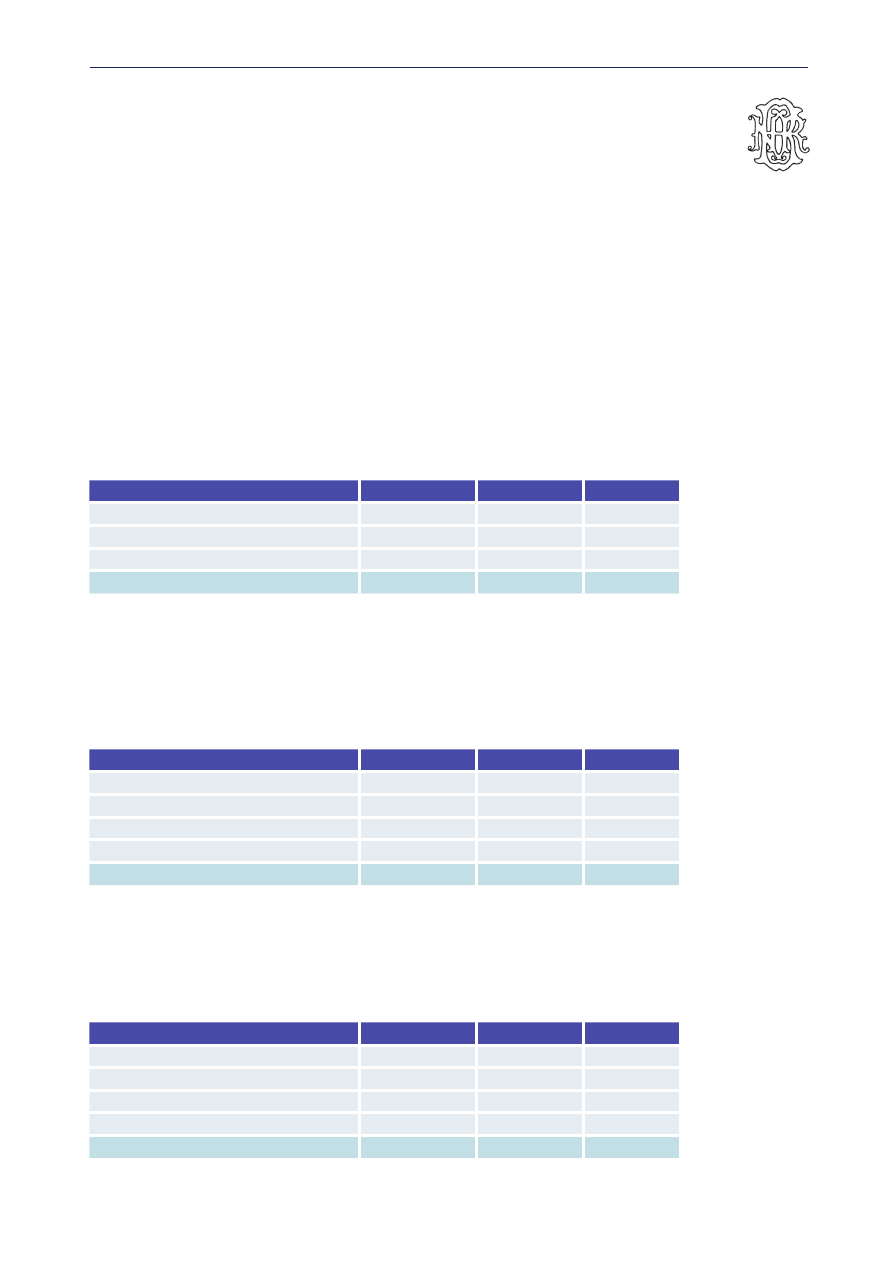
197
The existence of an efficient banking sector is a prerequisite for the devel-
opment of the Romanian economy and for the economic growth in the years
to come. The achievement of these objectives will bring the Romanian banking
sector closer to the EU standards as the full restructuring of the financial sec-
tor is deemed necessary in order to preserve the confidence of the people and
the Romanian and foreign investors.
STATISTICAL TABLES
Number of financial institutions
(at year-ends)
Type of financial institutions
2002
2003
2004
Commercial banks
31
30
32
Branches of foreign banks
8
8
7
Credit cooperatives
-
-
1
Total banking system
39
38
39
Ownership structure of financial institutions
on the basis of the registered capital (%)
(at year-end)
Item
2002
2003
2004
State ownership
29.9
25.7
4.8
Other domestic ownership
5.2
8.0
25.9
Domestic ownership, total
35.1
33.7
30.7
Foreign ownership
64.9
66.3
69.3
Total banking system*
100.0
100.0
100.0
*) excluding Credit cooperatives
Ownership structure of financial institutions
on the basis of assets total
Item
2002
2003
2004
Public sector ownership
40.4
37.5
6.9
Other domestic ownership
3.2
4.3
31.0
Domestic ownership, total
43.6
41.8
37.9
Foreign ownership
56.4
58.2
62.1
Total banking system*
100.0
100.0
100.0
*) excluding Credit cooperatives
2004 DEVELOPMENTS IN THE ROMANIAN BANKING SYSTEM

198
Concentration of assets by type of financial institutions (%)
(at year-end)
Type of institution
The first three largest
The first five largest
Banks
48.2
59.2
Credit cooperatives
-
-
Financial institutions
-
-
Savings cooperatives
-
-
Specialized credit institutions
-
-
Return on asset (ROA) by type of financial institutions (%)
Type of institution
2002
2003
2004
Banks
2.64
2.21
2.04
Credit cooperatives
-
2.35
2.66
Financial institutions
-
-
-
Savings cooperatives
-
-
-
Specialized credit institutions
-
-
-
Return on equity (ROE) by type of financial institutions (%)
Type of institution
2002
2003
2004
Banks
18.27
15.64
15.58
Credit cooperatives
-
9.85
9.77
Financial institutions
-
-
-
Savings cooperatives
-
-
-
Specialized credit institutions
-
-
-
Distribution of market shares in balance sheet total (%)
Type of financial institutions
2002
2003
2004
Commercial banks
92.6
92.3
91.1
Branches of foreign banks
7.4
7.7
8.5
Credit cooperatives
-
-
0.4
Total banking system
100.0
100.0
100.0
2004 DEVELOPMENTS IN THE ROMANIAN BANKING SYSTEM
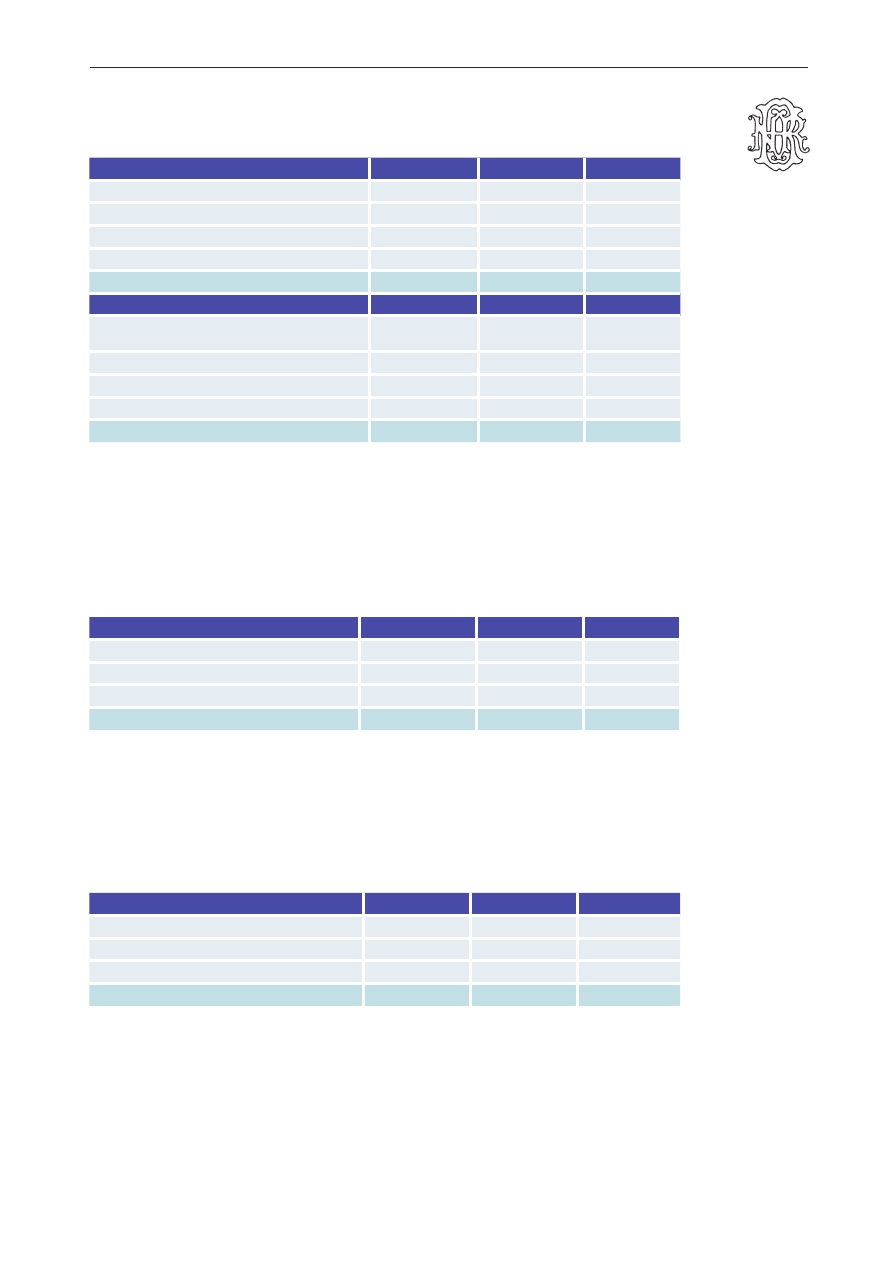
199
The structure of assets and liabilities of the banking system (%)
(at year-ends)
Assets
2002
2003
2004*
Cash and claims on banks
41.9
36.0
36.0
Net loans
38.1
49.9
46.5
Securities
12.5
7.1
11.7
Fixed assets and other assets
7.5
7.0
5.8
Total assets
100.0
100.0
100.0
Liabilities
2002
2003
2004
Due to other banks and financial
institutions
10.5
14.1
17.8
Due to clients
73.7
70.3
66.8
Other liabilities
1.6
1.7
2.7
Own capital
14.2
13.9
12.7
Total liabilities and capital
100.0
100.0
100.0
*) including Credit cooperatives
Development of off-balance sheet activities (%)
(off-balance sheet items*/balance sheet total)
Type of financial institutions
2002
2003
2004
Commercial banks
18.2
19.6
17.9
Branches of foreign banks
23.8
21.1
23.6
Credit cooperatives
-
-
0.1
Total banking system
18.6
20.0
18.3
* commitments in favor of banking and non-banking customers
Solvency ratio of financial institutions
Type of financial institutions
2002
2003
2004
Commercial banks
25.0
21.1
20.6
Branches of foreign banks
-
-
-
Credit cooperatives
-
-
33.6
Total banking system
25.0
21.1
20.6
2004 DEVELOPMENTS IN THE ROMANIAN BANKING SYSTEM

200
2004 DEVELOPMENTS IN THE ROMANIAN BANKING SYSTEM
Asset portfolio quality of the banking system
Mill EUR
Asset classification
2002
2003
2004
Standard
7,792
4,575
7,596
Watch
21
1,695
2,406
Substandard
62
341
515
Doubtful
11
78
78
Loss
45
152
204
Classified total
7,931
6,841
10,799
Specific reserves
58
118.2
171.5
According to the classification statement of Commercial Banks
The structure of deposits and loans in 2004 (%)
(at year-end)
Deposits
Loans
Households
28.4
14.6
Government sector
3.9
5.5
Corporate
25.3
21.4
Foreign
39.5
57.2
Other
2.9
1.3
Total
100.0
100.0
The structure of deposits and loans and commitments in 2004 (%)
(at year-end)
Maturity of deposits
Loans and commitments
At sight
27.1
Short-term
43.3
Within one year
65.4
Medium-term
40.7
Over one year
7.5
Long-term
16.0
Total
100.0
Total
100.0
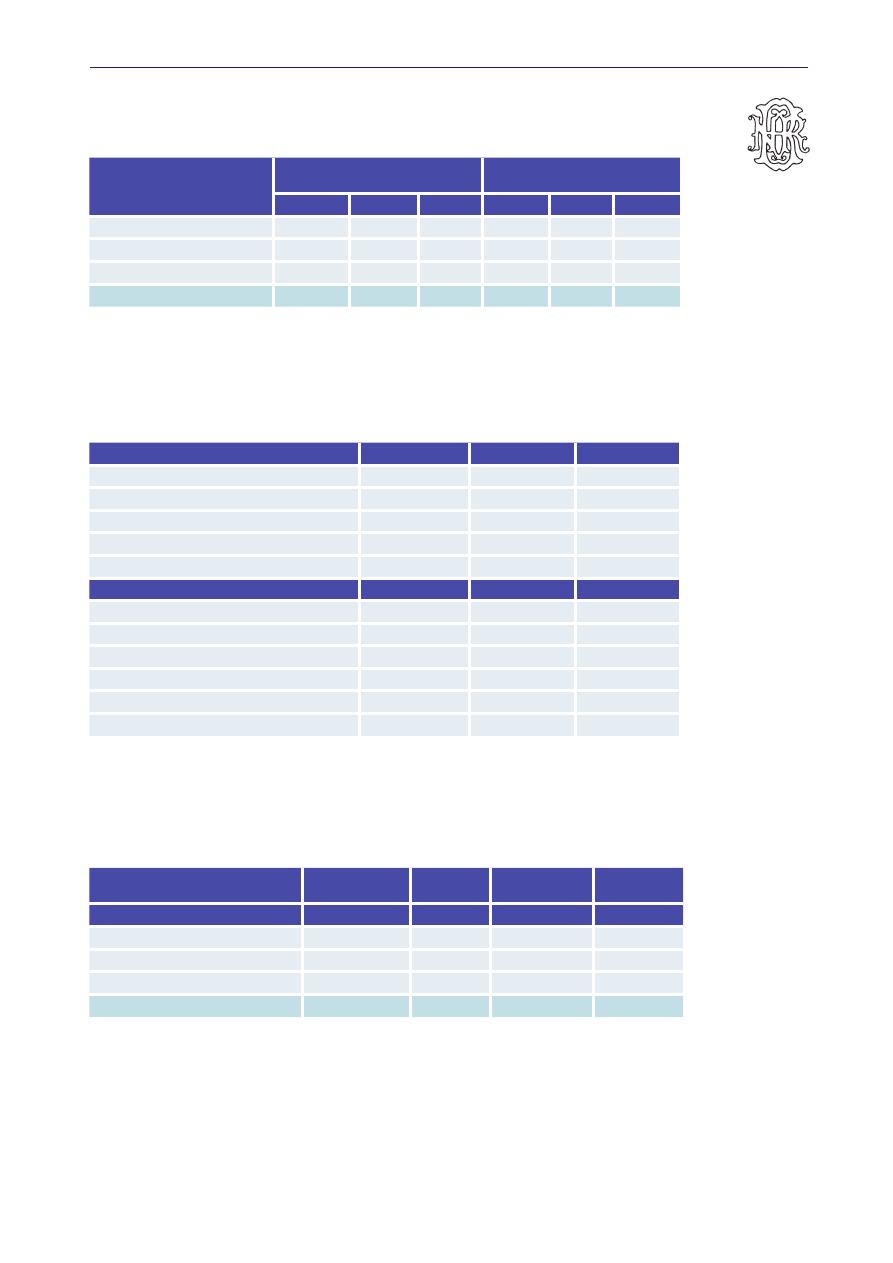
201
2004 DEVELOPMENTS IN THE ROMANIAN BANKING SYSTEM
Proportion of foreign exchange assets and liabilities
(at year-ends)
Type of financial
institutions
FOREX assets/Total assets
FOREX liabilities/
Total liabilities
2002
2003
2004
2002
2003
2004
Commercial banks
40.9
45.0
45.5
37.6
43.2
45.0
Branches of foreign banks
70.6
71.4
70.4
65.1
63.3
66.5
Credit cooperatives
-
-
0.0
-
-
0.1
Total banking system
43.1
47.0
47.4
39.6
44.8
46.7
Structure of revenues and expenditures of financial institutions
(at year-end)
Revenues
2002
2003
2004*
Interest income
25.6
23.5
31.6
Income from securities transactions
8.7
3.4
3.5
Recoveries from provisions
6.8
7.6
8.4
Income not derived from interest
58.8
65.4
56.5
Extraordinary income
0.1
0.1
0.0
Expenditures
2002
2003
2004
Interest expenses
19.1
12.6
17.2
Expenses for securities transactions
2.0
0.5
0.7
Provisions expenses
7.8
9.7
11.5
Expenses, other than interest
68.9
75.5
68.0
Extraordinary expenses
0.4
0.0
0.0
Profit tax
1.8
1.7
2.6
*) including Credit cooperatives
Structure of registered capital and own funds of financial institutions in 2004
Type of financial institution
Registered
capital
/Total
assets
Own funds
/Total
liabilities
Mill. EUR
%
Mill. EUR
%
Commercial banks
1,163.8
5.6
2,354.8
11.4
Branches of foreign banks
-
-
142.2*
7.4
Credit cooperatives
12.3
13.0
25.1
26.6
Total banking system
1,176.1
5.7
2,522.1
11.1
* own capital

202
2004 DEVELOPMENTS IN THE BANKING
SECTOR AND BANKING SUPERVISION IN
RUSSIA
MACROECONOMIC ENVIRONMENT
Russia continued to enjoy economic stability in 2004. It registered a federal
budget surplus of 4.4% of GDP as against 1.7% in 2003, and the country’s GDP
expanded by 7.1% as against 7.3% in 2003.
Russia’s international reserves increased by 60 % and as of January 1, 2005,
they stood at $124.5 billion. Their growth contributed to the country’s financial
stability.
Growth in household real money income (by 9.9%) led to the expansion of
consumer spending, which grew by an estimated 11.5% in 2004 as against 8.2%
in 2003.
Industrial output grew by 6.1% in 2004.
In 2004 the Russian government established a Stabilisation Fund as part of
the federal budget in which it accumulated extra revenues due to high oil prices
on the world market. By the end of 2004 the Stabilisation Fund amounted to
522.3 billion rubles. It played a major role in easing of inflationary pressure on
the economy.
Inflation, in terms of consumer price index, stood at 11.7% in 2004 as against
12% in 2003.
DEVELOPMENT IN THE BANKING SYSTEM
(INCLUDING THE ASSETS TOTAL / GDP)
Banking sector assets increased by 27.4% in 2004 as against 35.1% in 2003.
Capital growth stood at 16.2% as against 40.2% a year before. Loans to the non-
financial enterprise sector grew by 39.0% as against 42.4% in 2003. Household
deposits were up 29.7% in 2004 as against 47.1% in previous year.
This growth profile influenced the ratio of basic indicators of banking in-
dustry to GDP. Banking sector assets to GDP practically remained at a level of
the previous year (42.5% in 2004 as against 42.4% in 2003), just as household
deposits to GDP that changed little from 2003 (11.7% as against 11.5%). As for
banks’ capital, it fell from 6.2% to 5.6% of GDP.
At the same time, banking sector operations with the real economy became
the principal source of growth in banking sector assets in 2004. Loans and
other funds extended to non-financial enterprises and organisations in relation
to GDP reached 18.8% as against 17.2% in 2003 and the share of these opera-
tions in banking sector assets expanded from 40.5% to 44.1%.

203
LEGAL AND INSTITUTIONAL FRAMEWORK OF BANKING
AND BANKING SUPERVISION, NEW DEVELOPMENTS
LEGAL COMPETENCE OF THE BANK OF RUSSIA
The status, objectives, functions and powers of the Central Bank of the Russian
Federation are established by the Constitution of the Russian Federation and
Federal Law No. 86-FZ, dated July 10, 2002, “On the Central Bank of the Russian
Federation (Bank of Russia).” Under this Law, the Bank of Russia is the super-
visory authority in this country, it constantly monitors credit institutions’ and
banking groups’ compliance with banking laws, Bank of Russia’s regulations
and required ratios.
In the course of discharge of controlling and supervisory functions the Bank
of Russia makes decisions on the state registration of credit institutions and
keeps the State Register of Credit Institutions, issues, suspends and revokes
banking licences.
The Bank of Russia establishes mandatory rules for credit institutions and
banking groups on banking operations, accounting, reporting, internal controls,
compilation and filing accounting and statistical reports and other information
stipulated by federal laws.
As for banking legislation, the legal framework of credit institutions’ opera-
tions in Russia is established by Federal Law No. 395-1, dated December 2,
1990, “On Banks and Banking Activities” which defines a credit institution, a
bank, the banking system and banking operations.
Procedures and conditions for implementation of measures to prevent in-
solvency (bankruptcy) of credit institutions and the specific requirements and
procedures for declaring a credit institution insolvent (bankrupt) and liquidat-
ing it are established by Federal Law No. 40-FZ, dated February 25, 1999, “On
Insolvency (Bankruptcy) of Credit Institutions.”
Federal Law No. 115-FZ, dated August 7, 2001, “On Countering the
Legalisation of Earnings Obtained in an Illegal Way (Money Laundering) and
the Financing of Terrorism” provided a legal basis for control over operations
with cash and other property in Russia for the purpose of preventing, detecting
and cutting short the activities connected with money laundering and financ-
ing of terrorism. The Law granted the Bank of Russia the powers to establish
fit and proper requirements for bank officers responsible for the observance of
internal control rules and the implementation of internal control programmes,
the requirements for personnel training and instruction and the requirements
for the identification of customers and beneficiaries of credit institutions.
Federal Law No. 177-FZ, dated December 23, 2003, “On Insurance of Deposits
of Physical Persons in Banks of the Russian Federation” regulates the relations
involved in building and operation of the deposit insurance system, the forma-
tion and use of its funds, compensation payments on deposits upon the onset
of the insured event, the relations arising from the implementation of govern-
ment control over operations of the deposit insurance system and other rela-
tions arising in this sphere.
Federal Law No. 218-FZ, dated December 30, 2004, “On Credit Stories”
established the procedure for creating, storing and using credit histories and
2004 DEVELOPMENTS IN THE RUSSIAN BANKING SYSTEM

204
set out the principles of co-operation between credit bureaus (registers) and
borrowers, federal and local government bodies and the Bank of Russia.
Federal Law No. 152-FZ, dated November 11, 2003, “On Mortgage-backed
Securities” which regulates the relations arising in the issue and negotiation of
mortgage securities, except pawn-tickets, and the fulfilment of obligations on
such securities, requires credit institutions issuing mortgage-backed securities
to comply with additional prudential requirements set by the Bank of Russia
in pursuance with this Law.
MAIN STRATEGIC OBJECTIVES OF THE BANK OF RUSSIA
IN 2004
The principal objectives set for the Bank of Russia in the Guidelines for State
Monetary Policy in 2004 in upgrading the banking system and banking super-
vision were as follows:
• creating conditions allowing the banking sector to increase its stability
and functional role in the economy;
• creating optimal conditions stimulating credit institutions to expand and
improve credit and settlement services to the real sector, including the
development of the legal framework of mortgage lending and asset secu-
ritisation, especially through mortgage lending;
• developing approaches based on the substantive evaluation of credit institu-
tions’ performance, establishing the banking supervision regime and using,
whenever necessary, corrective actions, depending on the nature of risk as-
sumed by a credit institution and the quality of its risk management;
• continuing the work aimed at improving the quality of banking sector
capital with special emphasis on prevention of fictitious capitalisation of
credit institutions;
• upgrading supervision on a consolidated basis, including the analysis of
the reports by banking/consolidated groups (bank holding companies)
and the evaluation of the effect of operations conducted by non-credit
institutions of groups (holding companies);
• enhancing the efficiency of the Bank of Russia’s supervision through im-
proved prudential reporting and development of IFRS based reporting;
• tightening the requirements guaranteeing that only financially sound credit
institutions could get access to the market and could expand the range of
their activities;
• preventing executives and real owners with dubious business reputation
and unstable financial position from managing credit institutions;
• creating legal conditions allowing credit institutions to cut costs, especially
administrative expenses, involved in banking activities, and simplifying,
optimising and accelerating procedures connected with entry to the market
and opening branches and internal structural divisions of credit institu-
tions;
• ensuring that inspections focus on the current and long-term evaluation
of the financial soundness of credit institutions and the quality of their
management and internal controls on the basis of informed judgement.
2004 DEVELOPMENTS IN THE RUSSIAN BANKING SYSTEM

205
THE ACTIVITIES OF THE BANK OF RUSSIA IN 2004
In 2004 the Bank of Russia continued to upgrade its licensing practices in line
with the Basel Core Principles for Effective Banking Supervision. One of the
major objectives in registering and licensing banking activities to which the
Bank of Russia paid special attention last year was increasing transparency of
the ownership structure of credit institutions and enhancing the efficiency of the
Bank of Russia’s control over persons capable of exerting substantial influence
on the management of credit institutions by virtue of direct or indirect (through
third parties) ownership of shares (stakes) in credit institutions.
The Bank of Russia’s efforts in the field of off-site supervision last year were
aimed at implementing the provisions of Federal Law No. 177-FZ, dated October
23, 2003, “On Insurance of Deposits of Physical Persons in Banks of the Russian
Federation”, Bank of Russia regulations issued in pursuance of this Law and
Bank of Russia Regulation No. 254-P, dated March 26, 2004, “On the Procedure
for Making Loan Loss Provisions” which further developed the principle of in-
formed judgement, and Bank of Russia Instruction No. 110-I, dated January
16, 2004, “On the Banks’ Obligatory Normatives” which stipulated that banks
must comply with the required ratios on a daily basis.
The new approaches to the substantive analysis of the situation in a bank re-
quired the use of new indicators in evaluating financial soundness, such as the
transparency of ownership structure, risk management function and internal
control systems, as well as bank profitability indicators.
Last year, the Bank of Russia continued to evaluate the quality of credit insti-
tutions’ capital and carry out measures stipulated by Bank of Russia Ordinance
No. 1246-U, dated February 10, 2003, “On Actions Aimed at Detecting the Facts
(Signs) on Forming Sources of Own Funds (Capital) (a Part Thereof) Using
Improper Assets”.
In 2004 the Bank of Russia’s inspection activity was characterised by transi-
tion from formal control over the observance by credit institutions of legislation
and Bank of Russia regulations to qualitative assessment of their activities. In
2004 priority was attached to inspections of credit institutions and their branch-
es for the purpose of increasing banking sector stability and building a deposit
insurance system in pursuance of the Federal Law on Insurance of Household
Deposits with Russian Banks.
2004 DEVELOPMENTS IN THE RUSSIAN BANKING SYSTEM

206
ORGANIZATIONAL STRUCTURE OF THE BANK OF
RUSSIA
2004 DEVELOPMENTS IN THE RUSSIAN BANKING SYSTEM
Banking
Regulation and
Supervision
Department
Bank of Russia Banking
Supervision Committe
Chairman: Andrei A. Kozlov,Bank of Russia First
Deputy Chairman
Credit Institution
Licensing
and Financial
Rehabilitation
Department
Main
Inspectorate
for Credit
Institutions
Financial
Monitoring
and Foreign
Exchange
Control
Department
Bank of Russia
Regional Branches
INTERNATIONAL CO-OPERATION IN THE FIELD OF
BANKING SUPERVISION
The Bank of Russia continued to co-operate with the World Bank on issues
relating to the implementation of the Financial Institution Development
Programme and in preparing a comparative analysis of legislation in Russia
and industrialised nations in respect to the registration and licensing of bank-
ing activities.
The Bank of Russia’s representatives took part in the work of the Basel
Committee on Banking Supervision and its working groups and collaborated with
the EU Commission in implementing “The Banking Supervision and Reporting
Project and Central Bank Training Project. Stage III”, launched as part of the
EU/TACIS programme.
The Bank of Russia continued to look for better conditions and formats of
co-operation with foreign supervisory authorities. It concluded the Agreement
on Co-operation in the Field of Banking Supervision over Credit Institutions’
Activities with the National Bank of Kirghizia, discussed similar agreements with

207
banking supervisors in 15 countries and drafted new agreements with banking
supervisory authorities of two countries.
The Bank of Russia representatives participated in the work of the Banks/
Financial Services Sub-group of the Russian-German Intergovernmental
Working Group on the Strategy of Economic and Financial Co-operation and the
work carried out for the purpose of creating a single economic space in Belarus,
Kazakhstan, Russia and Ukraine. In addition, Bank of Russia representatives
took part in the plenary meetings of the Financial Action Task Force (FATF)
and the Council of Europe Select Committee of Experts on the Evaluation of
Anti-Money Laundering Measures (MONEYVAL).
COOPERATION WITH OTHER SUPERVISORY BODIES IN
THE COUNTRY
Under Russian legislation, the regulation of the activities of credit institutions
and their supervision are the exclusive competence of the Bank of Russia.
OTHER RELEVANT INFORMATION AND DEVELOPMENTS
IN THE COURSE OF LAST YEAR
Owing to the efforts made by the Bank of Russia in 2004 to build a depos-
it insurance system, the value of household deposits covered by the deposit
insurance system as of January 1, 2005, accounted for 90% of the total value
of household deposits with banks (as of April 1, 2005, that is, by the end of
the first stage of the examination of banks’ entry applications, 824 banks were
covered by the deposit insurance system and the value of household deposits
with these banks accounted for 98% of the total value of household deposits
with Russian banks).
2004 DEVELOPMENTS IN THE RUSSIAN BANKING SYSTEM
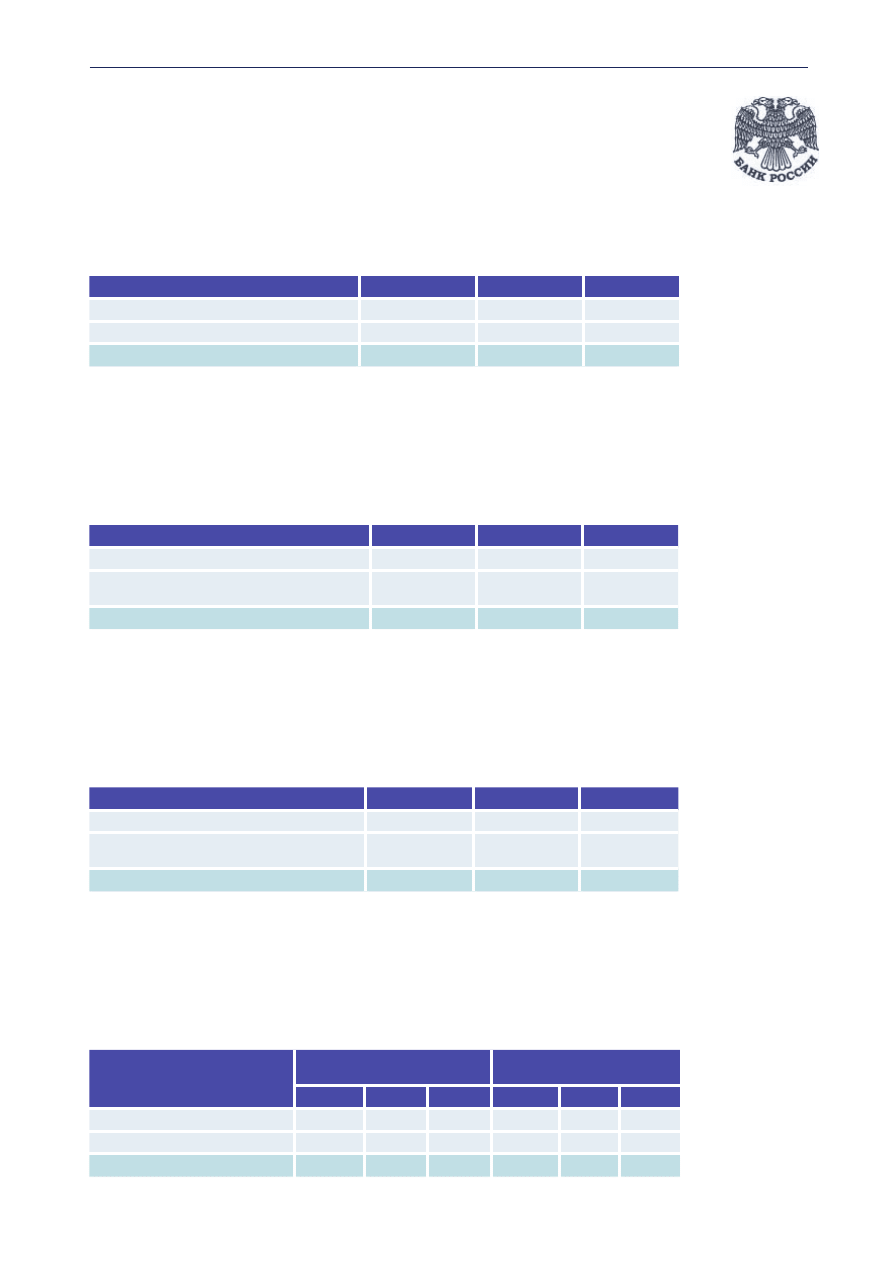
208
STATISTICAL TABLES
Number of credit institutions (%)
(at year end)
Type of credit institution
2002
2003
2004
Banks
1,282
1,277
1,249
Non-banking credit institutions
47
52
50
Banking sector total
1,329
1,329
1,299
Share in aggregate banking sector registered authorised capital (%)
(at year end)
Kind of property
2002
2003
2004
Russian credit institutions
95.1
95.3
94.8
Foreign-controlled banks (banks with non-
resident interest in excess of 50%)
4.9
4.7
5.2
Banking sector total
100.0
100.0
100.0
Share in aggregate banking sector assets (%)
(at year end)
Kind of property
2002
2003
2004
Russian credit institutions
91.9
92.6
92.4
Foreign-controlled banks (banks with non-
resident interest in excess of 50%)
8.1
7.4
7.6
Banking sector total
100.0
100.0
100.0
Credit institution asset concentration (%)
(share in aggregate banking sector assets)
Type of credit institution
Three largest credit
institutions by assets
Five largest credit
institutions by assets
2002
2003
2004
2002
2003
2004
Banks
37.5
37.0
39.9
44.3
43.0
45.4
Non-banking credit institutions
67.6
78.7
76.3
76.6
84.5
86.7
Banking sector total
37.4
36.8
39.6
44.2
42.9
45.1
2004 DEVELOPMENTS IN THE RUSSIAN BANKING SYSTEM

209
Credit institutions’ return* on assets (%)
(at year end)
Type of credit institution
2002
2003
2004
Banks
2.6
2.7
2.9
Non-banking credit institutions
1.9
1.6
0.9
Banking sector total
2.6
2.6
2.9
Credit institutions’ return* on capital (%)
(at year end)
Type of credit institution
2002
2003
2004
Banks
18.0
17.9
20.4
Non-banking credit institutions
53.7
45.2
41.5
Banking sector total
18.0
17.8
20.3
* Calculated as the ratio of the current year’s balance sheet profit to the average chronological value of assets
(equity capital) over the accounting period.
Share in aggregate banking sector assets
(at year end)
Type of credit institution
2002
2003
2004
Banks
99.76
99.56
99.43
Non-banking credit institutions
0.24
0.44
0.57
Banking sector total
100.0
100.0
100.0
Structure of credit institutions’ assets
(at year end)
Assets
2002
2003
2004
1.
Money, precious metals and gemstones
2.2
2.5
2.8
2.
Accounts with the Bank of Russia
10.1
11.8
9.7
3.
Correspondent accounts with banks
7.3
5.5
3.2
4.
4.1.
Securities acquired by banks
of which:
Russian government debt obligations
18.8
10.0
17.9
8.0
15.2
6.1
5.
Loan debt
51.8
54.4
62.5
6.
Other assets
9.8
8.0
6.5
Total assets
100.0
100.0
100.0
2004 DEVELOPMENTS IN THE RUSSIAN BANKING SYSTEM

210
Structure of credit institutions’ liabilities
(at year end)
Liabilities
2002
2003
2004
1.
Banks’ funds and profits
15.7
14.9
14.1
2.
Loans received by banks from the
Bank of Russia
0.1
0.0
0.3
3.
Banks’ accounts
4.3
3.6
1.6
4.
Total loans, deposits and other
funds received from other banks
7.6
9.4
10.3
5.
5.1.
5.2.
Customers’ deposits
of which:
Corporate deposits
Household deposits and other funds
52.9
26.3
24.8
53.6
24.7
27.0
58.2
27.8
27.5
6.
Debt obligations issued
10.9
11.3
9.0
7.
Other liabilities
8.4
7.2
6.5
Total liabilities
100.0
100.0
100.0
Development of off-balance operations (%)
(off-balance positions/balance sheet assets (liabilities))
(at year end)
Type of credit institution
2002
2003
2004
Banks
12.46
18.15
20.24
Non-banking credit institutions
0.03
0.00
0.00
Banking sector total
12.43
18.07
20.12
Capital adequacy indicator
(at year end)
Type of credit institution
2002
2003
2004
Banks
19.1
19.1
17.0
Non-banking credit institutions
43.1
47.9
60.3
Banking sector total
19.1
19.1
17.0
Deposit and loan structure in 2004* (%)
(at year end)
Loans, deposits and other
borrowed funds
Loans, deposits and other placements
Demand
9.2
Long-term (over 3 years)
14.7
Up to 1 year
40.5
Medium-term (from 1 year to 3 years)
24.9
Over 1 year
50.3
Short-term (up to 1 year)
60.3
Total
100.0
100.0
* Excluding overdue debt.
2004 DEVELOPMENTS IN THE RUSSIAN BANKING SYSTEM

211
Quality of banking sector loan portfolio
(at year end, as % of total loans)
Loan quality
2002
2003
2004
Standard loans
90.1
90.7
46.9
Substandard loans
4.3
4.3
37.1
Doubtful loans
1.8
1.5
12.2
Problem loans
-
-
1.9
Bad loans
3.8
3.4
1.9
Loan loss provisions
6.3
5.9
5.3
Before August 1, 2004, loan classification and provisioning were regulated by Bank of Russia
Instruction No. 62a, dated June 30, 1997, “On the Procedure for Making and Using Loan Loss
Provisions.”
After September 1, 2004, loan classification and provisioning are regulated by Bank of Russia
Regulation No.254-P, dated March 26, 2004, “On the Procedure for Making Loan Loss Provisions”.
Before April 1, 2004, calculations were made according to Form No. 115 “Loan Loss Provision
Calculation” (Annex No. 7 to Bank of Russia Instruction No. 17, dated October 1, 1997, “On Compiling
Financial Statements”).
After May 1, 2004, calculations are made according to Form 0409115 Section 1 “Information on
the Quality of Loans, Loan Debt and Similar Debts” (Bank of Russia Ordinance No. 1376-U, dated
January 16, 2004, “On the List, Forms and Procedure for Compiling and Presenting Reporting Forms
by Credit Institutions to the Central Bank of the Russian Federation”).
Deposit and loan structure in 2004 (%)
(at year end)
Loans, deposits and
other borrowed funds
Loans, deposits and
other placements
Government financial authorities and
extra-budgetary funds*
2.0
1.2
Legal entities
14.8
71.2
Private individuals
57.5
13.9
Banks
6.6
6.5
Non-residents**
19.1
7.2
Total
100.0
100.0
* Including the Central Bank of the Russian Federation
** Including banks and other legal entities and private individuals
Share of foreign currency assets and liabilities in
aggregate banking sector assets and liabilities (%)
(at year end)
Type of credit
institution
Foreign currency assets/
aggregate assets
Foreign currency liabilities/
aggregate liabilities
2002
2003
2004
2002
2003
2004
Banks
36.2
30.0
26.6
31.8
28.2
27.4
Non-banking credit
institutions
7.5
3.1
2.9
6.6
3.0
2.7
Banking sector total
36.2
29.9
26.5
31.7
28.1
27.3
2004 DEVELOPMENTS IN THE RUSSIAN BANKING SYSTEM
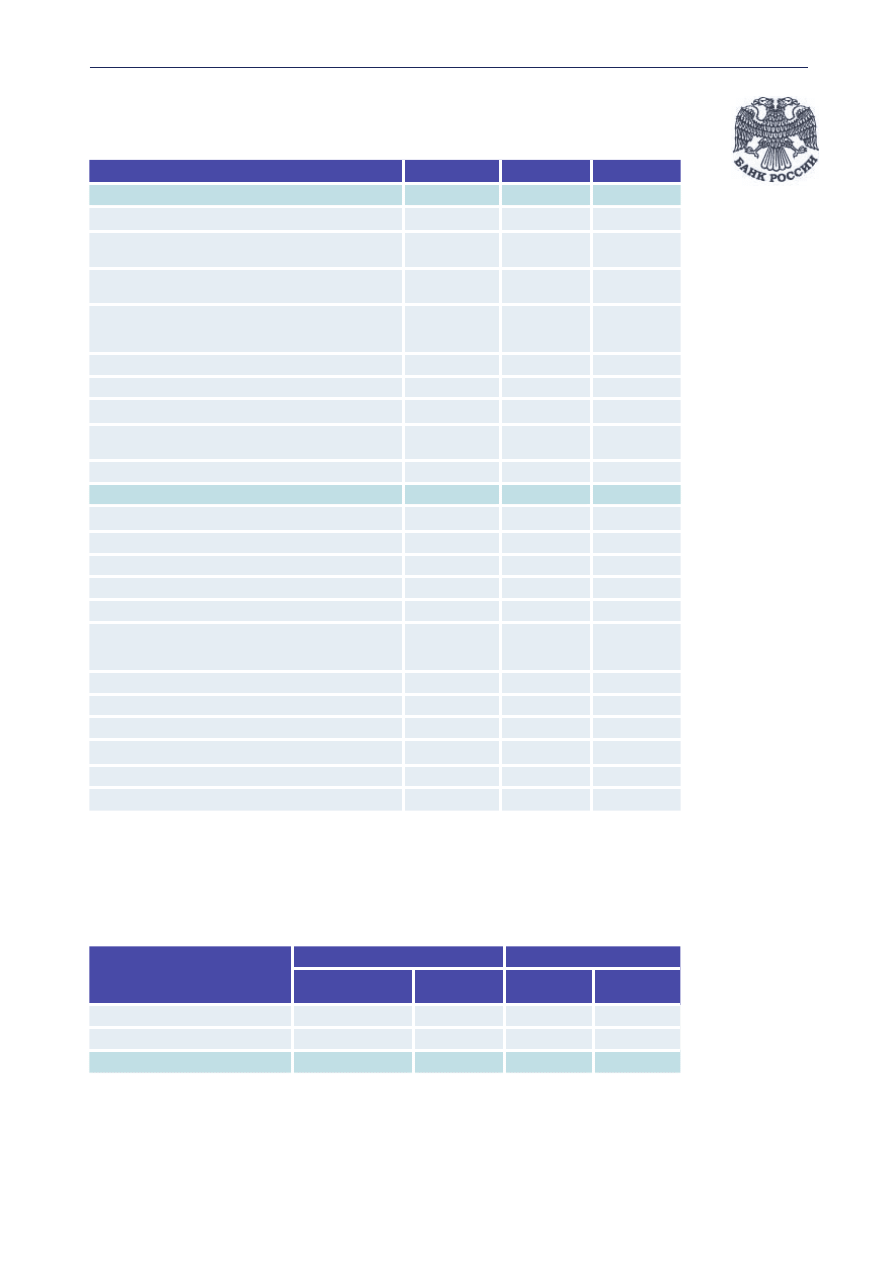
212
Structure of revenues and expenses of operating credit institutions (%)
(at year end)
2002
2003
2004
Revenues, total
100.0
100.0
100.0
of which:
- interest received on loans, deposits and other
placements
18.03
12.84
13.30
- incomes received from operations with
securities
10.13
11.54
7.76
- incomes received from operations with foreign
exchange and foreign currency-denominated
cheques, including travel cheques
27.76
39.20
37.32
- fines and penalties
0.56
0.11
0.09
- other incomes
43.49
36.30
41.52
of which:
recovery of sums from fund and reserve
accounts
35.31
28.52
33.97
commission received
3.77
3.14
3.52
Expenses, total
100.0
100.0
100.0
of which:
- interest paid on loans taken
1.14
0.71
0.83
- interest paid to legal entities for borrowed funds
2.49
1.52
1.31
- interest paid to households
5.04
3.98
3.73
- expenses on operations with securities
5.42
7.14
5.39
- expenses on operations with foreign exchange
and foreign currency-denominated cheques,
including travel cheques
28.03
41.00
38.69
- administrative expenses
6.47
4.81
4.47
- fines and penalties
0.05
0.03
0.01
- other expenses
51.35
40.81
45.57
of which
- deductions to funds and reserves
41.20
32.43
37.68
- commission paid
0.48
0.40
0.43
Structure of credit institutions’ registered
authorised capital and equity capital in 2004
Type of credit institution
Registered authorised capital
Equity capital
million euros
as % of
assets
million
euros
as % of
liabilities
Banks
10,049.5
5.4
24,999.4
13.3
Non-banking credit institutions
13.1
1.2
35.8
3.3
Banking sector total
10,062.5
5.3
25,035.2
13.3
2004 DEVELOPMENTS IN THE RUSSIAN BANKING SYSTEM

213
2004 DEVELPOMENTS IN SLOVAKIAN
BANKING SYSTEM
MACROECONOMIC ENVIRONMENT
The economic environment influenced the Slovak banking sector in 2004
favourably. This applies both to external factors, such as growth in the glob-
al economy and continuing positive development in banking groups across
the EU, and to domestic factors, in particular the Slovak Republic’s macro-
economic development.
The effect of Slovakia’s accession to the EU was not greatly apparent in Slovak
banks’ business. The fears of some banks as regards greater competitive pressure
were not confirmed. From the aspect of regulation banks are at various stages
of preparation for implementing the New Basle Capital Accord.
The recovery in the global economy in 2004 was seen also in increased growth
in the Slovak economy. The level of real GDP growth in 2004 ranged above
the five per cent limit, reaching 5.5% for the year as a whole. This growth was
supported in particular by the continuing growth in household consumption
and increased capital formation.
Both short-term and long-term interest rates continued to fall over the year.
The development indicates a continuing convergence of interest rates to the
EU level.
The improvement in macro-economic indicators supported the increased
interest in the SKK, causing the domestic currency’s appreciation against the
USD and the EUR.
The perception of the economic situation by households took on a particu-
larly positive trend; the number of households with a positive evaluation of the
past as well as future development of the economic situation grew significant-
ly. In 2004 unemployment fell, real wages grew, as did household disposable
incomes.
The perception of the economic environment by the corporate sector (ex-
pressed by confidence indicators) did not change significantly over the course
of 2004. Confidence in the construction sector developed positively. The corpo-
rate sector reacted negatively mainly to the development of demand in industry
and the expected development of prices in the retail sector.
According to preliminary data, the corporate sector’s profitability improved
over the year. Almost all economic sectors significant from the aspect of the
sectoral classification of bank lending saw in 2004 a year-on-year growth in
receipts from own performances and goods.

214
DEVELOPMENT IN THE BANKING SYSTEM
As at 31 December 2004, there were eighteen banks and three branches of for-
eign banks operating in the Slovak banking sector. In connection with the acces-
sion of Slovakia to the European Union in May 2004, the Banking Supervision
Division of the National Bank of Slovakia received, by the end of the period
under review, forty-nine notifications from foreign supervisory authorities of
intentions of foreign banks to freely provide cross-border banking services. Of
fifteen universal banks in the Slovak banking sector, eight banks and one branch
of a foreign bank have a licence to conduct mortgage transactions.
The net profit of the banking sector in 2004 increased on a year-on-year basis
by 8,52%. Banks’ return on equity at the end of 2004 reached 29,4%, against
27,2% for the same period in 2003. This growth in the banking sector’s profit
came about largely due to an increase in income from banking operations.
Despite the fall in interest rates, banks increased the largest item of their
incomes, net interest income. The growth was caused by a more significant de-
cline in interest expense than a decline in interest income of banks. The decline
in interest expense occurred due to the interest policy of banks, where banks
radically reduced their deposit rates, as well as due to changes in the assets
and liabilities of the banking sector. On the liabilities side the volume of time
and saving deposits decreased and the volume of non-interest bearing current
accounts increased. On the other side, banks compensated for the decline in
interest rates in their asset operations through an increased volume of lending
to households.
The fall in interest rates created increased pressure on the net interest margin
of the banking sector. For the first time since 2001 this was slightly reduced, at
the end of 2004 reaching 2.85% against 2.91% at the end of 2003.
The course of the interest margin was to a large extent the result of competi-
tion in the banking sector. The relatively high concentration of banks, particu-
larly in the households sector, was manifested in a growth in the interest margin
of the largest banks. On the other hand at most small and medium-sized banks
the interest margin decreased.
The trend of growth in non-interest income continued in 2004, where at the
end of 2004 these formed 27% of the total gross income from banking opera-
tions. It is probable that with the further decline in interest rates and downward
pressure on banks’ interest margins, the significance of non-interest income will
continue to grow. The largest item of non-interest income was formed by net
income from fees. The most significant growth in fee income was recorded by
banks with a dominant position in the household sector. The growth in income
from trading was driven primarily by income from securities trading.
In line with the growth in banks’ activities in the household sector operating
costs in the banking sector also rose. Purchased performances and employee
costs also grew at most banks. The process of improving operating efficiency
through reducing operating costs continued at several banks.
Despite the increase in operating costs, their share in total income from bank-
ing operations (the cost-to-income ratio) in 2004 decreased to 61%.
In comparison with the same period of 2003 the banking sector significantly
reduced income from the dissolution of reserves
3
. Income from the use of pro-
2004 DEVELOPMENTS IN THE SLOVAKIAN BANKING SYSTEM

215
visions in the banking sector increased, in connection with certain banks writ-
ing off in a higher rate claims towards customers.
THE LEGAL AND INSTITUIONAL FRAMEWORK
Legislation addressing the institutional arrangement of
supervision
Central Bank is responsible for banking supervision and its competences are
defined in The National Bank of Slovakia Act.
Financial Market Authority FMA is responsible for capital and insurance
market supervision, pension funds (retirement system reform) and its compe-
tences are definied in The Financial Market Authority Act.
According to the Government decision as of August 2003 integrated finan-
cial market supervision will be exercised by the Central bank from 1 st January
2006.
Substantive law
On 1 May 2004 Act No 215/2004 amending and supplementing the Act on
banks entered into force.
The amendment to the Act on banks has changed Article 91 paragraph 4 by
adding letter l). Hereby the scope of authorities (the National Security Office,
the Slovak Information Service, the Military Intelligence Service and the
Police Corps for the purposes of performing security checks) to which a bank
or a branch of a foreign bank reports on matters relating to a customer, which
matters are subject to bank secrecy, without the customer’s consent, following
a written request only.
On 1 January 2005 Act No 654/2004 Coll. which amends Act No 310/1992
Coll. on home savings as amended became effective. The main reason for the
mentioned amendment is an essential change in the setting of government bo-
nus percentage. The government bonus shall be set as a percentage share from
the annual volume of deposit, calculated on a basis of the formula made public
by the Ministry of Finance of the Slovak Republic, which percentage share is
from 5% to15% of the annual volume of the deposit, however maximally SKK 2
500 for the relevant calendar year.
With regard to changes in financial relations within the planning and bud-
geting of funds assigned to support building activities and improve the housing
quality, the powers of the provision and settlement of the government bonus
were transferred to the Ministry of Construction and Regional Development of
the Slovak Republic.
With respect to the creation of equal business conditions for all entities in
the Slovak banking sector, the possibilities for home savings banks to trade in
financial products of money and capital markets are being extended. At the same
time, the possibility to provide loans to legal entities under commercial condi-
tions from temporary-free home savings funds has also been introduced.
2004 DEVELOPMENTS IN THE SLOVAKIAN BANKING SYSTEM

216
On 1 January 2005 Act No 554/2004 Coll. amending and supplementing the
Act on banks entered into force.
The purpose of the amendment to the Act on banks was to incorporate
Directive 2002/87/EC of the European Parliament and of the Council on the
supplementary supervision of credit institutions, insurance undertakings and
investment firms in a financial conglomerate. The European Union regulates,
by this Directive, conditions for the conduct of supervision of financial con-
glomerates. When compared prudential supervision of credit institutions, in-
surance undertakings and traders in securities on a solo basis with supervision
on a consolidated basis, the latter is consolidated or the so-called supplemen-
tary supervision of prudential activities of those businesses from the individual
financial sub-sectors, which are part of financial conglomerates. Supplementary
supervision deals with solvency and risk concentration at the level of a finan-
cial conglomerate, intra-group transactions, internal procedures in the risk
management at the level of a conglomerate, and an adequate and suitable type
of the conglomerate management. The mentioned Amendment defines financial
conglomerate, conditions under which supplementary supervision is conducted
by the National Bank of Slovakia, limits for identifying financial conglomerate,
requirements ensuring a secure business activities at the level of the financial
conglomerate, part of which are banks or electronic-money institutions. Further
there are supplemented provisions on the NBS’s cooperation with relevant
supervisory authorities responsible for supervision of other entities which are
part of the financial conglomerate.
The amendment of Act on banks amends in Section II also Act No 510/2002
Coll. on the payment system and on amendments and supplements to certain
laws (hereinafter referred to as “Act on the payment system”) in such a way that
the provisions of the Act on banks, which regulate supplementary supervision,
apply to the electronic money institution.
Banking supervision is carried out also by means of secondary legislation,
licensing decrees and prudential regulations.
In 2004, the Banking Supervision Division of the National Bank of Slovakia
issued seventeen decrees and seven methodological instructions of the National
Bank of Slovakia.
MAIN STRATEGIC OBJECTIVES IN 2004
In 2004, apart from issuing methodological instructions, the Banking Supervision
Division focused on the implementation of the rules associated with supplemen-
tary supervision of financial conglomerates, as well as on preparation of a legal
framework for integrated supervision of the financial market.
In the period under review, the expectations regarding the introduction
of the “Single Passport” were not met. As at 31 December 2004, the Banking
Supervision recorded 49 foreign banks freely providing cross-border banking
services.
According to the notified information, there should have been five branches
of foreign banks established in the Slovak banking sector; by the end of the year,
however, the Banking Supervision Division had not registered a single applica-
tion for an establishment of a branch of a foreign bank.
2004 DEVELOPMENTS IN THE SLOVAKIAN BANKING SYSTEM

217
Finally it can be concluded that, in comparison with the previous years, as
far as the conduct of on-site inspections is concerned an improvement was
recorded in terms of the lower number of cases and the gravity of findings in bank
inspections. This fact results from the new strategy of the Banking Supervision
Division, which undertakes on-site inspections with greater intensity and
frequency and which, in turn, has a positive impact on the banks’ efforts towards
improvement and qualitative growth.
THE ACTIVITIES OF THE BANKING SUPERVISORY
AUTHORITY
In line with the plan of inspections for 2004, inspections in two banks were
carried out in the first quarter. Protocols from the inspections were presented
to the banks and the final review of the protocols took place in the first week of
June. Both inspections had a wider scope with the aim of evaluating the quality
of risk management and the degree of risk in individual banking operations.
An inspection in one bank was carried out that was not part of the plan for
2004. The objective of the inspection was to examine the existence and func-
tionality of control mechanisms in the anti-money-laundering system of the
bank and to evaluate their effectiveness. The inspection was carried out at the
initiative of the Organized Crime Office, a section of the Financial Police, which
asked the National Bank of Slovakia to examine the procedure used by the bank
to report suspicious transactions and evaluate the correctness of the bank’s
procedure in cases of selected transactions.
In connection with the subject of this on-site inspection in one bank, there
were four off-site inspections started: in VÚB, a.s.; Tatra banka, a.s.; UniBanka,
a.s.; and SLSP, a.s.
In the second quarter, two inspections were completed with a final review of
protocols. The banks accepted the findings and recommendations of the Banking
Supervision Division; measures adopted for the elimination of found deficien-
cies will be the subject of a follow-up process.
Two full-scope inspections were carried out in line with the plan. The full-scope
inspections were finished in two banks and the final review of protocols took place
in September. The objective of both inspections was to assess the quality of risk
management and the degree of risks involved in banking operations. The follow-
up inspection was aimed at checking the implementation of measures the bank
adopted based on the findings and recommendations of the inspection carried
out in 2003. The inspection was completed and finished at the same time was
presentation of reports on the fulfilment of the adopted measures.
Two inspections were completed in the third quarter. Both were finished
with a final review of protocols at the level of the Chief Executive Director of
the Banking Supervision Division. Banks were given binding instructions to
adopt a plan of measures to remove and prevent shortcomings found during
the on-site inspections.
In line with the plan for the third quarter, six inspections were carried out
and completed with the objective of examining the measures that banks adopted
based on the findings and recommendations of the inspections in 2003.
2004 DEVELOPMENTS IN THE SLOVAKIAN BANKING SYSTEM

218
In line with the plan for the fourth quarter, three targeted inspections and
one full-scope inspection were carried out. The targeted inspections were to
evaluate the quality of management, evaluation of the rate of foreign exchange
and interest rate risks, the quality of credit risk management system, compli-
ance with selected Decrees, and the review of internal management and control
systems, operational risks management system, including the areas of informa-
tion systems and AML prevention.
The inspections in two banks were finished with a final review of protocols
at the level of the Chief Executive Director of the Banking Supervision Division.
The banks were given binding instructions to adopt a plan of measures to re-
move and prevent shortcomings found during the on-site inspections. These
banks will submit their plans of corrective measures in the course of February
2005 and April 2005 respectively.
At the conclusion of two other inspections the banks received the letters of
the Banking Supervision Division of the NBS of 24 January 2005 and 2 February
2005.
Quarter I
Quarter II
Quarter III
Quarter IV
Quarters I-IV
Inspections
Started
Finished
St.
Fin.
St.
Fin.
St.
Fin.
Plan
Result
Full-scope
2
2
2
2
1
1
5
5
Follow-up
1
1
6
6
7
7
Targeted
1
1
2
2
4
4
3
7
Total
3
1
5
3
6
10
5
5
15
19
INTERNATIONAL ACTIVITIES AND COOPERATION WITH
OTHER SUPERVISORY BODIES
In view of the fulfilment of the tasks based on the Long-term Supervisory
Development Plan, the Banking Supervision Division co-operates with both
domestic and foreign supervisory authorities. On 12 February 2004, the
Memorandum of Understanding was concluded and signed with the Malta
Financial Services Authority.
On 12 November 2004, the Supplement to the Memorandum of Understanding
with the Ministry of the Interior of the Slovak Republic, Presidium of the Police
Corps, was approved and signed. The Memorandum had to be updated by the
above-mentioned supplement owing to the organizational changes carried out
in the Ministry of the Interior, as well as owing to the increasing importance of
detecting of the financing of terrorism.
2004 DEVELOPMENTS IN THE SLOVAKIAN BANKING SYSTEM

219
Banking Supervision Division
Chief Executive Director
Licensing and
International
Co-operation Department
Risk Management
Methodology Department
Supervision Department
Banking Supervision and International
Co-operation Development Section
Regulation and Administration Section
Banking Supervision Information Systems Section
Risk Analyses and Rating Section
Section for Standards and Methodology
Supervision and Analyses Section
Supervision and Inspection Procedures Section
2004 DEVELOPMENTS IN THE SLOVAKIAN BANKING SYSTEM
ORGANISATIONAL CHART
STATISTICAL TABLES
Number of financial institutions
(at year-ends)
Type of financial institution
2002
2003
2004
Banks
18
18
18
– Joint stock companies
15
15
15
– State financial institutions
-
-
– Building savings banks
3
3
3
Branches
2
3
3
Financial Institutions, total
20
21
21

220
Ownership structure of the financial institutions
on the basis of registered capital (%)
(at year-end)
Item
2002
2003
2004
Public sector ownership
5.4
1.9
1.9
Other domestic ownership
9.3
9.2
8.5
Domestic ownership total
14.7
11.1
10.4
Foreign ownership
85.3
88.9
89.6
Financial institutions, total
100.0
100.0
100.0
Ownership structure of the financial institutions
on the basis of assets total (%)
Item
2002
2003
2004
Public sector ownership
1.9
1.5
1.3
Other domestic ownership
2.5
2.3
2
Domestic ownership total
4.4
3.8
3.3
Foreign ownership
95.6
96.2
96.7
Financial institutions, total
100.0
100.0
100.0
Concentration of assets by type of financial institutions in 2004 (%)
(at year-end)
Type of institutions
The first three largest
The first five largest
Bank
53.14
66.55
Credit cooperatives
x
x
Financial institutions
x
x
Savings cooperatives
x
x
Specialized credit institutions
x
x
Return on assets (ROA) by type of financial institutions
Type of institutions
2002
2003
2004
Bank
1.16
1.17
1.21
Credit cooperatives
x
x
x
Financial institutions
x
x
x
Savings cooperatives
x
x
x
Specialized credit institutions
x
x
x
2004 DEVELOPMENTS IN THE SLOVAKIAN BANKING SYSTEM
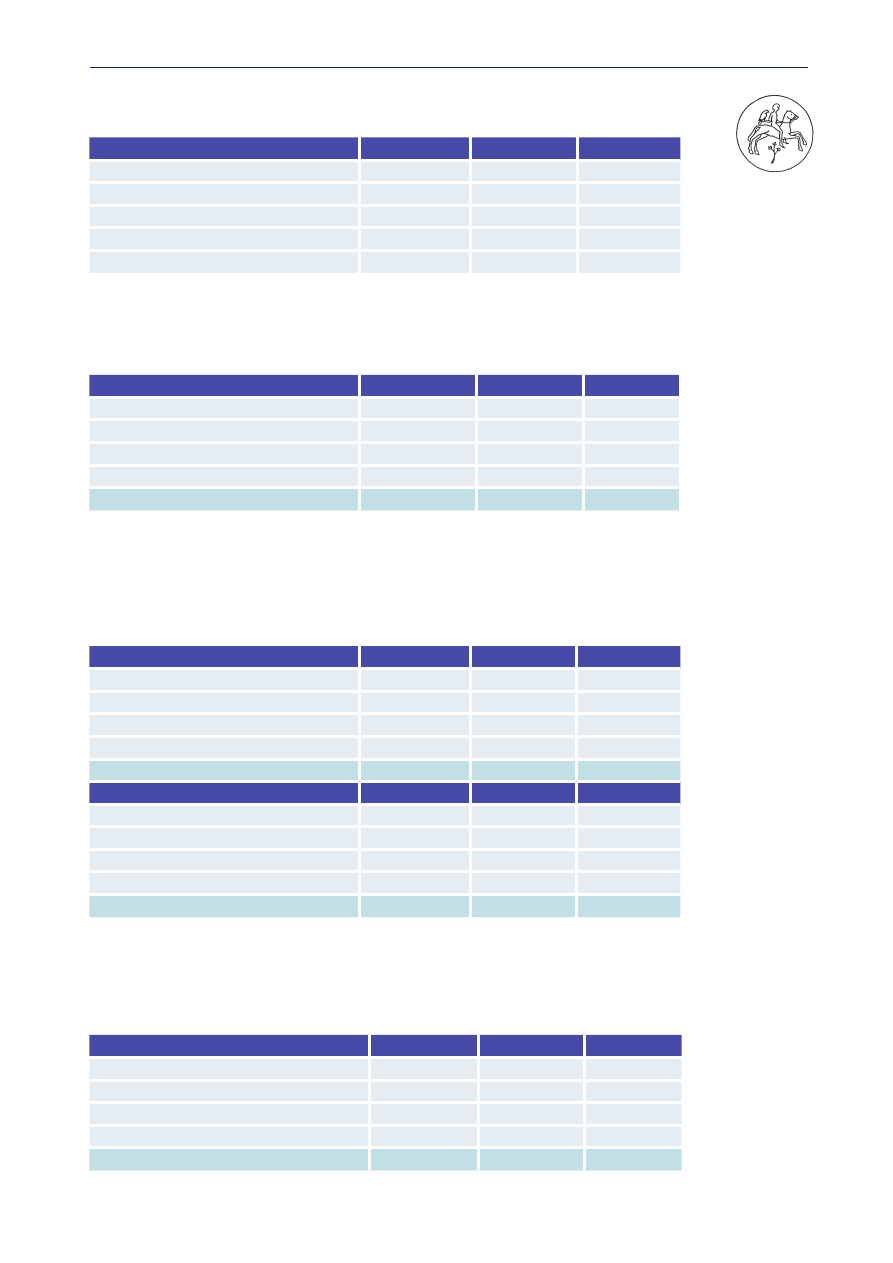
221
Return on equity (ROE) by type of financial institutions
Type of institutions
2002
2003
2004
Bank
29.43
27.98
29.03
Credit cooperatives
x
x
x
Financial institutions
x
x
x
Savings cooperatives
x
x
x
Specialized credit institutions
x
x
x
Distribution of market shares in balance sheet total (%)
Type of the financial institutions
2002
2003
2004
Joint stock companies
82.88
81.46
81.79
State financial institutions
0.00
0.00
0.00
Building savings banks
5.69
5.77
4.92
Branches
11.42
12.77
13.29
Financial institutions, total
100.00
100.00
100.00
The structure of assets and liabilities of the banking system (%)
(at year-end)
Assets
2002
2003
2004
Deposits and credits with banks
24.43
30.01
33.78
Granted credits
31.08
37.15
35.85
Securities
30.95
29.60
27.87
Tangible and intangible assets
13.55
3.24
2.50
Total assets
100.00
100.00
100.00
Liabilities
2002
2003
2004
Deposits and credits from banks
19.93
14.10
17.92
Received deposits
69.97
75.51
67.20
Reserves
2.57
1.37
5.69
Initial capital
7.53
9.02
9.19
Total liabilities
100.00
100.00
100.00
Development of off – balance sheet activities (%)
(off-balance sheet liabilities / balance sheet total)
Type of the financial institutions
2002
2003
2004
Joint stock companies
92.09
133.28
143.52
State financial institutions
0.00
0.00
0.00
Building savings banks
4.52
5.32
4.06
Branches
18.32
53.49
61.62
Financial institutions, total
114.94
192.09
209.20
2004 DEVELOPMENTS IN THE SLOVAKIAN BANKING SYSTEM

222
Solvency ratio of financial institutions
Type of the financial institutions
2002
2003
2004
Joint stock companies
21.68
20.71
18.17
State financial institutions
0.00
0.00
0.00
Building savings banks
17.75
30.92
24.25
Branches
0.00
0.00
0.00
Financial institutions, average
21.30
21.59
18.68
Asset portfolio quality of the banking system
in mil. SKK
Asset classification
2002
2003
2004
Substandard
7,335
6,812
8,287
Doubtfull
3,257
4,541
4,541
Loss
27,637
25,302
19,351
Classified total
38,229
36,655
32,179
Specific reserves
29,609
28,974
25,490
The structure of deposits and loans (%)
(at year-end)
Deposits
Loans
Households
42.71
24.76
Government sector
18.15
7.73
Business sphere
38.13
59.81
Foreign
0.96
2.73
Other
0.05
4.98
Total
100.0
100.0
The structure of deposits and loans (%)
(at year-end)
Maturity of depostis
Maturity of loans
At sight
35.82
Long term loans
39.96
Within one year
54.93
Medium-term loans
27.61
Over one year
9.24
Short-term loans
32.43
Total
100.00
Total
100.00
2004 DEVELOPMENTS IN THE SLOVAKIAN BANKING SYSTEM
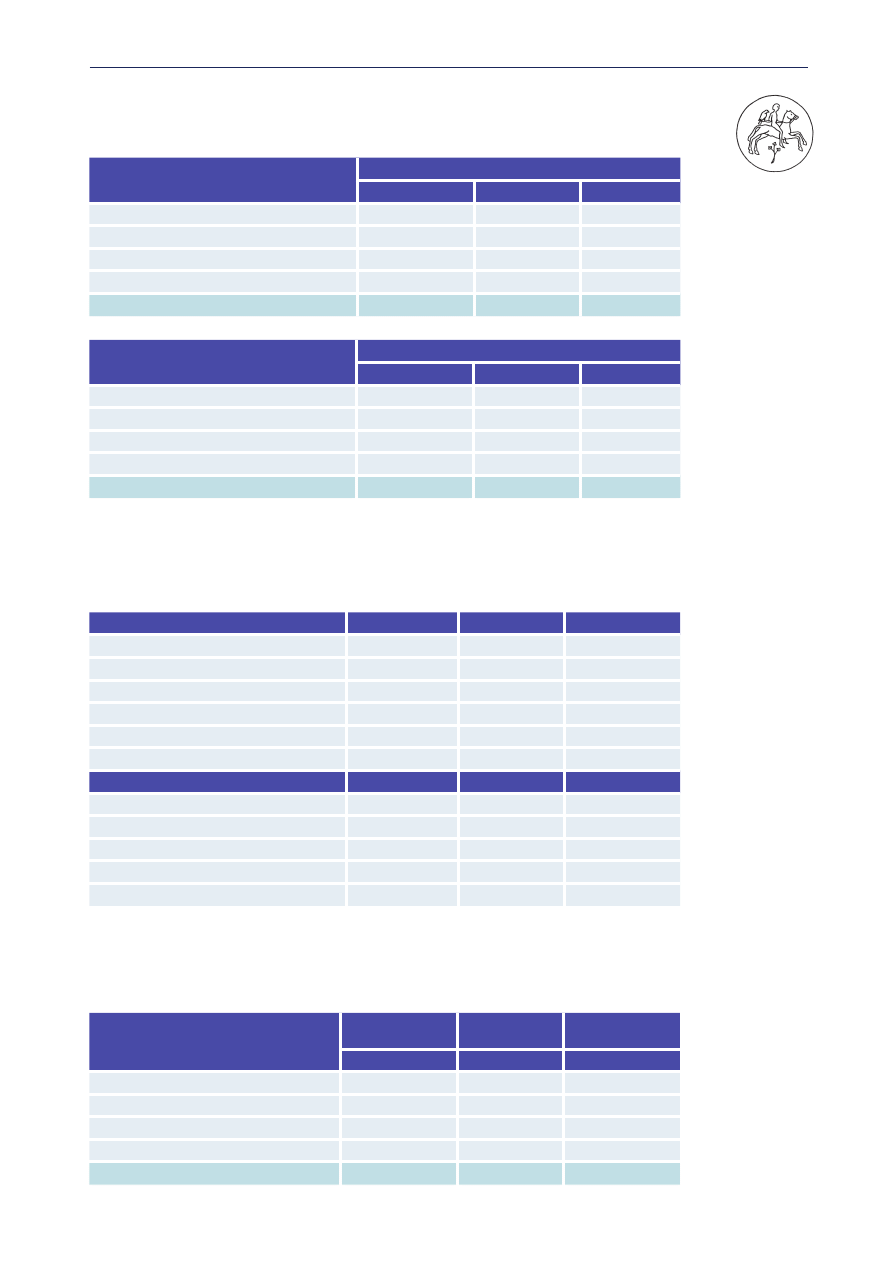
223
Proportion of foreign exchange assets and liabilities (%)
(at year ends)
Type of the financial institutions
Foreign exchange assets / Total assets
2002
2003
2004
Joint stock companies
13.89
16.42
16.09
State financial institutions
0.00
0.00
0.00
Building savings banks
0.35
0.37
0.26
Branches
13.05
11.15
9.05
Financial institutions, average
13.02
14.82
14.38
Type of the financial institutions
Foreign exchange liabilities / Total liabilities
2002
2003
2004
Joint stock companies
14.66
15.34
17.23
State financial institutions
0.00
0.00
0.00
Building savings banks
0.05
0.05
0.02
Branches
26.04
47.36
36.54
Financial institutions, average
15.64
19.04
19.35
Structure of revenues and expenditures of banks
(at year-ends)
in th. USD(EUR)
Expenditures
2002
2003
2004
Expenses from banking operations
3,720,905
5,483,065
6,049,393
Operational expenses
584,341
620,742
678,954
Provisions and reserves
625,970
726,817
797,529
Other operational expenses
280,010
322,173
353,134
Extraordinary expenses
14,485
455
5,158
Income taxes
8,387
889
46,087
Revenues
2002
2003
2004
Income from banking operations
4,729,538
6,443,615
7,256,995
Provisions and reserves
725,020
847,123
908,541
Other operational income
30,820
137,956
81,266
Extraordinary income
32,570
377
0
EUR
41,722
41,161
38,796
Structure of registered capital and own funds of financial institutions
(at year-end)
Type of the financial institutions
Registered
capital
/Total assets
Own funds
in mil. EUR
%
in mil. EUR
Joint stock companies
1,783.42
7.27
9,816.14
State financial institutions
0.00
0.00
0.00
Building savings banks
219.81
14.89
906.27
Branches
0.00
0.00
0.00
Financial institutions, total
2,003.22
6.68
10,722.41
SKK/EUR = 38.796
2004 DEVELOPMENTS IN THE SLOVAKIAN BANKING SYSTEM

224
2004 DEVELOPMENTS IN THE
SLOVENIAN BANKING SECTOR
SLOVENIAN MACROECONOMIC ENVIRONMENT IN 2004
After being rather low for several years, the economic growth in Slovenia was
relatively high in 2004. At 4.6% annual growth exceeded growth in potential
GDP for the first time in three years. The largest rises in the value added were
recorded in financial intermediation services (10.4%), in manufacturing (5.4%)
and in the health sector (4.9%), while the largest declines were in fishing (-2.9%)
and mining (-5.2%). This structure of economic growth indicates that activity
was primarily under the influence of the high level of activity by financial inter-
mediaries and the favourable economic climate abroad. The growth in indus-
trial output of 4.8%, in 2004, although growth rates slowed slightly at the end
of the year compared to the higher levels reached in the first part of the year.
The largest increase over the whole year was recorded in production of capital
goods (9.7%), while production of consumer goods fell by 1.1%. Total stocks in
industry rose by 19.3% in 2004.
In contrast to the reasonably favourable economic outlook wage growth was
relatively slow in 2004, primarily thanks to low public sector wage growth. Year-
on-year growth in gross wages averaged 5.7% in 2004, or 2.0% in real terms.
There was a favourable employment trend in 2004, in line with the trend
in economic activity. Improvement in the labour market conditions took place
throughout all the year, and only at the end of the year did a minor stalling in
employment occur. Unemployment was down 5.0% from 2003, with the un-
employment rate reaching 10.4% in December, slightly lower than the average
over the year (10.6%) and lower than in December 2003 (when it was 11.0%).
For the fourth successive year employment rose the most in real estate services
(4.3%), while the rise in employment in public administration was also signifi-
cant (2.7%).
Inflation measured by the consumer price index stood at 3.2% as from
December 2003 to December 2004, or 3.6% measured as the average for 2004
against the average for 2003. The disinflation trend thus continued in 2004,
with the average annual inflation rate falling by 2 percentage points. The sus-
tained fall in inflation in 2004 was brought about mostly by domestic factors,
namely structural factors connected with Slovenia joining the EU, and by ap-
propriate macroeconomic policy that mitigated the effects of adverse trends
in the foreign environment, high oil prices in particular. Among the domestic
factors having the most significant impact on lower inflation, prime position
was taken by the coordinated action of the Bank of Slovenia and the Slovenian
government. The latter used acyclic adjustments in excise duties to mitigate
the transmission of high oil prices on the world market into domestic prices,
and through its administered prices policy prevented the automatic transmis-
sion of costs into price formation. Prior to the tolar’s inclusion in the ERM II,

225
the Bank of Slovenia was able to affect the level of nominal interest rates, and
through this bring about a gradual reduction in inflation. By maintaining an
appropriate level of real interest rates and gradually stabilising the exchange rate
it contained inflationary pressures of a monetary nature and aggregate demand
pressures. The process of nominal convergence is sustainable as is reflected in
the equilibrated balance of payments and the fiscal balance.
Slovenia recorded a slight current account deficit for the second successive
year, amounting to EUR 238 million or 0.9% of the estimated GDP. The main
factors behind the widening of the current account deficit from 2003 were the
trends in imports and exports in the context of slightly higher domestic de-
mand and adverse price movements on the external market, and a decline in
the surplus from transfers. The record high surplus recorded by services and
the decline of more than 40% in net labour and capital outflows had a positive
effect on the current account.
The general government deficit, which covers the four general government
treasuries – the state budget, municipal budgets, the Pension and Disability
Insurance Institute and the Health Insurance Institute (compulsory insur-
ance only with regard to the latter two) – amounted to SIT 85 billion or 1.4% of
GDP in 2004 according to provisional figures. The state budget and the Health
Insurance Institute recorded a deficit, while the municipal budgets and the
Pension and Disability Insurance Institute recorded a surplus.
The primary objective of the Slovenian monetary policy in 2004 is price sta-
bility. The Bank of Slovenia conducted its monetary policy in 2004 in line with
the Bank of Slovenia Monetary Policy Guidelines of November 2001, and the
Programme for ERM II Entry and Adoption of the Euro (the Programme), which
was adopted by the Bank of Slovenia and Slovenian government in November
2003. In the joint programme they committed themselves to entering the ERM
II by the end of 2004 and to creating the conditions to allow the euro to be
adopted at the beginning of 2007.
Slovenia entered the ERM II on 28 June 2004. The central rate was set at
SIT 239.640 to the euro in agreement with the relevant European institutions.
Since entry into the ERM II, the Bank of Slovenia has maintained a high level
of stability in the exchange rate vis-à-vis the euro. The discrepancies between
the central rate and the market rate during the participation to date in the ERM
II have been negligible.
Maintaining a stable exchange rate limits the Bank of Slovenia’s ability to set
its interest rates independently of the ECB’s policy stance.
The sustained disinflation trends allowed the Bank of Slovenia to cut nomi-
nal interest rates while leaving real interest rates positive in the first half of the
year. The interest rate on 60-day tolar bills was cut from 6.0% in December
2003 to 4.0% in June 2004, while the year-on-year inflation rate fell from 4.6%
to 3.9%. The gap between domestic and foreign interest rates was reduced to
a level that allows the stabilisation of the exchange rate in the ERM II. In line
with the Programme, appropriate fiscal and incomes policies are implemented
to support price stability objective.
2004 DEVELOPMENTS IN THE SLOVENIAN BANKING SECTOR

226
STRUCTURE AND OWNERSHIP OF THE BANKING
SECTOR
Slovenia’s banking sector comprises banks, savings banks, and savings and loan
undertakings, with banks having the dominant position. At the end of 2004
banks accounted for 99.4% of the market as measured by total assets (com-
pared with 98.7% at the end of 2003), with savings banks and savings and loan
undertakings sharing the remainder. Savings banks held a 0.5% market share
(compared with 0.4% at the end of 2003), while savings and loan undertakings
held a market share of 0.1% (compared with 0.9% at the end of 2003).
As at 31 December 2004 there were 18 banks and two branches of foreign
banks operating in Slovenia. The number of banks was down by one from the
end of 2003 since the smallest Slovene bank went into ordinary liquidation.
However on 15 October 2004 the second branch of a foreign bank in Slovenia
was entered in the companies register, namely Bank für Kärnten und Steiermark
AG, bančna podružnica.
There was no change in the number of savings banks in 2004 (with two still in
operation). The number of savings and loan undertakings continues to fall due
to the capital and other requirements set in the 1999 Banking Act. There were
25 savings and loan undertakings in operation at the end of 2002, eight at the
end of 2003, but just two at the end of 2004. In recent years a large number of
savings and loan undertakings amalgamated with the Association of Savings and
Loan Undertakings, while to a lesser extent savings and loan undertakings were
taken over by banks or underwent voluntary liquidation and bankruptcy.
There were no major changes in ownership structure in 2004. Apart from
the five subsidiaries and two branches that were under majority foreign own-
ership, there were five banks under full domestic ownership, and eight banks
under majority domestic ownership (of these eight banks, three had less than 1%
foreign capital). Foreign shareholders were mostly from Austria, France, Italy
and Belgium. Although most of foreign subsidiaries and a branch had Austrian
owners, the equity capital of the Belgium bank KBC was dominant.
The proportion of equity capital under the ownership of non-residents was
the same at the end of 2004 as at the end of 2003 – 32.4% (of which 16.5% was
held by non-residents that hold more than 50% of the voting rights). The pro-
portion held by non-residents as measured by total assets was 3.8 percentage
points more than the proportion held by non-residents as measured by equity
capital as at 31 December 2004. The country’s second-largest bank (as measured
by total assets), Nova Kreditna banka Maribor d.d., and the 12th-largest bank
Poštna banka Slovenije d.d. remain under majority state ownership.
Total assets of banks, savings banks and savings and loan undertakings are
rising annually as a proportion of GDP. The aggregate total assets of all
credit
institutions (banks, savings banks and savings and loan undertakings) accounted
for almost 87 per cent of GDP at the end of 2004.
The Slovenian banking sector is characterised by a high concentration of
banks. The largest bank in Slovenia, Nova Ljubljanska banka, represented almost
33 per cent market share at end-2004. Together with the banks, which belong
to the Nova Ljubljanska banka banking group, the market share amounted to
36.5 per cent. The second largest bank (Nova Kreditna banka Maribor) account-
2004 DEVELOPMENTS IN THE SLOVENIAN BANKING SECTOR

227
ed for almost 11 per cent, and the third largest bank, Abanka Vipa amounted
to 8.5 per cent. The market share of the five largest banks, measured by total
assets, amounted to more than 65 per cent at the end of 2004. The market share
of majority foreign-owned banks has been increasing (At end-2003: 18.9 per
cent, at end-2004: 20.1 per cent).
BANK PERFORMANCE IN 2004
Since savings banks and savings and loan undertakings had only a 0.6% com-
bined market share in terms of total assets, this section on the bank performance
focuses exclusively on banks.
Banks and the two branches of foreign banks ended the 2004 with pre-tax
profits of SIT 56.1 billion (EUR 234.8 mn at the average exchange rate for
2004), and after-tax profits of SIT 36.8 billion. The 2004 profit was up SIT 8.3
billion from that in 2003, a real
26
rise of 13.3%. The rise in profit is the result
of higher earnings from net fees and net financial transactions, while earnings
from net interest income continued to decline last year, despite noteworthy
lending to non-financial companies and households.
The return on average assets has been stable in the last three years (1.1%
in 2004), with banks compensating for the decline in interest income with non-
interest income and lower operating costs. The return on average equity
improved. After rising in 2002 (owing to slower growth in capital as a result of
the abolition of general equity capital revaluation), it first fell slightly in 2003,
then rose to 13.3% in 2004 thanks to profit growing faster than capital.
The net interest margin (expressed as the ratio of net interest income to
average gross interest-bearing assets) was 2.8% in 2004. It continues to show
a falling trend, as banks’ earnings from net interest income are falling despite
real growth in gross interest-bearing assets.
The non-interest margin is of increasing importance, and is strengthening
significantly in the context of real growth in net fees and net financial trans-
actions.
The cost-effectiveness ratio (operating costs per average assets) continued to
improve, owing to the slowdown in labour costs and other operating costs. At
end-2004 the ratio operating expenses to average assets amounted to 2.8%.
The total assets grew in nominal and real terms in 2004, particularly banks
under majority foreign ownership continuing to record rapid growth. At the end
of 2004 the total assets of the banking system amounted to SIT 5,678.5 billion
(EUR 23.7 bn at the exchange rate of 31 December 2004), and were up 11.6%
in nominal terms and 8.2% in real terms
27
from 2003. The nominal growth in
banks’ total assets ranged from –1.1% to 55.5%. Again last year there was a
continuation of the above-average growth in the total assets of banks under
majority foreign ownership, while small banks under domestic ownership also
recorded above-average growth.
2004 DEVELOPMENTS IN THE SLOVENIAN BANKING SECTOR
26
Allowing for a consumer price index of 3.6% between 2003 and 2004
27
Allowing for inflation of 3.2%

228
Banks’ capital at the end of 2004, calculated in accordance with the Regulation
on Capital Adequacy of Banks and Savings Banks, stood at SIT 440 billion (EUR
1.8 bn at the exchange rate of 31 December 2004), representing a capital ad-
equacy ratio of 11.8% on risk-weighted assets of SIT 3,742 billion (EUR 15.6
bn at the exchange rate of 31 December 2004), At the end of 2004 three banks
had a capital adequacy ratio lower than 10 per cent. All the banks met the
minimum capital adequacy requirement as at 31 December 2004.
The quality of loan portfolio has not changed much over the past few
years. The share of performing on- and off-balance sheet items (claims classi-
fied in categories A and B) has ranged between 93 and 96 per cent (the share of
non-performing assets has ranged between 4 and 7 per cent).
LEGAL AND INSTITUTIONAL FRAMEWORK FOR
SUPERVISION OF FINANCIAL INSTITUTIONS
In Slovenia several supervisory authorities are responsible for supervision and
surveillance of individual segments of the financial system.
Slovenia’s central bank, the Bank of Slovenia, is an independent institu-
tion that carries out the tasks conferred upon it by the Bank of Slovenia Act.
Supervision of banks, savings banks and savings and loan undertakings is one
of the tasks of the Bank of Slovenia. The responsibility for the implementation
and enforcement of the Bank of Slovenia’s supervisory function is conferred
upon the Banking Supervision Department.
The Securities Market Agency is a self-governing and independent legal en-
tity with full power to supervise stock-broking companies, investment funds
(authorised investment companies, investment companies and mutual funds),
mutual pension funds, investment fund management companies and mutual
pension fund operators, as well as some other institutions (the Central Securities
Clearing Corporation, Ljubljana Stock Exchange, etc.).
The Insurance Supervision Agency became operational on 1 June 2000 as a
self-governing and independent legal entity whose responsibility is the super-
vision of insurance companies, reinsurance companies, companies and agents
who engage in insurance-related activities, as well as some other institutions (the
Slovenian Nuclear Insurance and Reinsurance Pool, the Slovenian Insurance
Association – guarantee fund, the Slovene Export Corporation – insurance oper-
ations, Kapitalska družba pokojninskega in invalidskega zavarovanja – Pension
Fund Management – voluntary pension insurance).
The Banking Supervision Department of the Bank of Slovenia was reorgan-
ised on 1 January 2005. The department is divided in five sections, with certain
joint functions being conducted at departmental level (e.g. duties connected
with legal advice, administration).
The Banking Analysis and Inspections section has been created from the pre-
vious on-site and off-site sections. Within the Banking Analysis and Inspections
there are four groups for four banking groups and four groups of specialist in-
spectors. Each group has its own portfolio manager, whose work is supported
by an analyst. The portfolio manager is responsible for monitoring banks and
savings banks and understanding them thoroughly, defining their risk profile in
2004 DEVELOPMENTS IN THE SLOVENIAN BANKING SECTOR

229
line with the newly developing methodology, co-ordinating supervisory activi-
ties on banks in the group, and heading on-site examinations of the banks. The
portfolio managers have primary responsibility for supervising liquidity, strate-
gic risk, reputation risk, capital risk and profitability risk. A final assessment of
other risks, primarily credit risk, market risk, interest rate risk and operational
risk, is conducted in conjunction with specialist inspectors. The analysts pro-
vide support to the portfolio manager, and also work with the Banking System
Analysis and Methodology section.
In order to ensure the highest level of specialist expertise and its applica-
tion in supervision procedures the remaining inspectors specialise in individual
areas. Thus the inspectors are also divided into four groups according to a
specialisation in various types of risk, which means that examiners now focus
on a specific risks. The specialist groups are credit risk, market and interest rate
risks, operational risk, and compliance.
A new Legal Advice sction has been created at the top of the department,
bringing together in a single site lawyers who were previously assigned to the
senior management at the department, the off-site section, or the licensing sec-
tion. The new section provides legal support to all the department’s law-related
activities. Through better co-ordination, flow of information and connections,
the creation of this section will see the legal experts in the department achieve
greater efficiency, a good transfer of information and knowledge among them-
selves, and a more standardised method of working.
The Banking System Analysis and Methodology section is involved in analy-
sis connected with the monitoring of the entire banking sector, its key function
being to build and maintain an effective early warning system, while it will also
work with the Financial Stability Department in drawing up joint working ma-
terial, will monitor liquidity, the movement of interest rates, etc. at the level of
the banking sector, will develop a database model for the purposes of pruden-
tial supervision of banks, and will be responsible for maintaining and updating
the methodology for the Risk Assessment System.
A new Prudential Regulation section has been created. Up to 31 December
2004 the functions of drafting and adopting regulations had been performed
at the off-site section.
The functions and activities of the Licensing section have remained un-
changed, but a staffing change has seen its lawyer move to the newly created
Legal Advice section.
ACTIVITIES OF THE BANKING SUPERVISION
DEPARTMENT IN 2004
Issuing authorisations to credit institutions is one of the Bank of Slovenia’s most
important responsibilities. As well as authorisations to provide banking servic-
es and other financial services, the Bank of Slovenia issues authorisations for
acquiring a qualifying shareholding, undertaking a merger or an acquisation,
establishing a branch abroad, establishing a branch of a foreign bank in Slovenia,
establishing a representative office of a foreign bank, serving as a member of
a bank’s management board etc. Decisions to grant or refuse an authorisation
are taken by the Governing Board of the Bank of Slovenia.
2004 DEVELOPMENTS IN THE SLOVENIAN BANKING SECTOR

230
In 2004 the Bank of Slovenia issued a total of 22 authorisations for banking
and other financial services, for acquiring qualifying holdings, for holding of-
fice as a member of the management board etc. One application for acquiring
a qualifying holding was rejected.
Off-site analysts continuously monitor the bank performance on the basis
of statutory returns and information and monitor compliance with prudential
regulations. They are involved in preparing documentation for the issue or
variation of authorisations for different types of activities of credit institutions,
evaluate proposed new systemic solutions, advise on the implementation of
standards of safe and sound banking, are involved in preparations for on-site
examinations in credit institutions and in discussions with the management of
credit institutions and meetings with other institutions, compile various written
documents for bodies of the Bank of Slovenia, etc. On discovering a departure
from the normal activity of a credit institution, off-site analysts immediately
notify the inspectors and management of the Banking Supervision Department,
who may accordingly decide to launch an on-site examination of the institu-
tion concerned.
On discovering an irregularity in the conduct of a credit institution, both
analysts and inspectors take appropriate action and monitor the remedial steps
taken.
A credit institution may be examined more than once in a given year. The
scope of the examination is determined on the basis of prior information and
analysis of the institution’s activities, initiated by the management of the Bank
of Slovenia or by external bodies. The examinations permit an in-depth inves-
tigation of areas of heightened risk or areas in which the Bank of Slovenia lacks
adequate information or data.
In view of the fact that the most significant source of risk at credit institutions
is credit risk, the emphasis in an examination is on the appropriate classification
of on- and off-balance-sheet items. Special attention is given to consolidated
supervision – the examination of a bank and its connected parties. In on-site
examinations of credit institutions during 2004, inspectors from the Banking
Supervision Department, in addition to the standard areas of examination,
focused particularly on supervision of capital and capital adequacy, manage-
ment of market risk and other risks, implementation of the Consumer Loans
Act, implementation of the Prevention of Money Laundering Act, corporate
payment systems and information technology.
In addition to 2 full-scope examinations, there were 44 targeted examinations
undertaken on banks and savings banks (including savings and loan undertak-
ings) and other companies in relation to specific areas of activity. Examinations
of IT systems were included in full-scope examinations or were undertaken as
independent examinations.
The Bank of Slovenia’s supervisory powers extend to other persons suspected
of providing banking services without authorisation from the Bank of Slovenia.
In 2004, on the basis of referrals from the Market Inspectorate of the Republic
of Slovenia, the Bank of Slovenia inspectors undertook 6 on-site examinations
of companies suspected of engaging in business activities without the Bank of
Slovenia authorisation.
In line with the Core Principles for Effective Banking Supervision, the Banking
Supervision Department of the Bank of Slovenia maintains regular contacts
2004 DEVELOPMENTS IN THE SLOVENIAN BANKING SECTOR

231
with the management of banks and savings banks, through channels including
regular annual meetings held at the completion of full-scope examinations or
specially. These meetings are primarily devoted to assessing the bank perfor-
mance and learning about its strategy.
PROGRESS ON CAD III
In 2004 the CAD III implementation group successfully finished few important
projects and established the basis for its further work.
Slovenian Quantitative Impact Study (SiQIS) was as a project
finished at the end of 2004. Its aim was testing the impact of simpler approaches
for credit and operational risk to banks capital. In addition, it was planned
to use the results of SiQIS as an input for decision-making process regarding
national discretion exercise.
The Bank of Slovenia focused on:
• Standardised approach for credit risk
• Basic indicator and Standardised approach for operational risk
• CRM techniques – simple approach.
SiQIS package consisted from:
• Templates for calculation of capital requirements
• Technical guidelines
• Questionnaire.
SiQIS templates for capital requirements calculation have been designed in a
way which provided us systemic analysis by 128 possible scenarios. The results
of different scenarios enable us to choose the “realistic scenario” which would
reflect the situation of Slovenian banking sector on the most accurate manner.
This was the starting point of setting the first preliminary decisions regarding
particular national discretions.
Summary of Slovenian Quantitative Impact Study (by the realistic scenario)
– autumn 2004:
• The capital requirement for credit risk on the level of the whole system
would decrease by 0.53% (from SIT 208.1 bn to SIT 207 bn).
• This number would represent only 3.9 % of capital requirement for
operational risk, calculated by Basic indicator approach (SIT 27.5 bn).
• Total capital requirements of the system will increase by 11% (from SIT
239.9 bn to SIT 266.3 bn SIT).
Consultative document on implementation of internal rating-
based systems was supported by external counsellor and finished at the end
of 2004. Its aim was:
• To identify open questions regarding IRB implementation and contribute
to the decisions of banks which approach for credit risk capital calculation
would be the most appropriate for them. This would be the starting point
for further discussions with banks regarding their readiness and ability
for implementation and on-going use of IRB approach.
2004 DEVELOPMENTS IN THE SLOVENIAN BANKING SECTOR

232
• To get the first impression about the current situation of banks regarding
compliance with IRB standards and minimum requirements.
• To use its results as an input for decision-making process regarding the
national discretion exercise.
The general impression based on the analysis was that some banks already
started with preparations on IRB, but their readiness is rather poor at the
moment. The Bank of Slovenia is already planning further activities regarding
practical co-operation with IRB banks.
Operational risk is also an important area where the Bank of Slovenia is
making significant efforts in co-operation with banks, so they would be prepared
on time. The Bank of Slovenia is preparing the Recommendations (Guidelines)
for operational risk management. The consultation process with banks is in the
pipeline.
Furthermore, in the middle of 2004 the Bank of Slovenia conducted the sec-
ond survey on operational risk issues. The aim of the survey was to recognise the
intentions of banks regarding implementation of operational risk approaches
and to explore awareness of the management board regarding operational risk
management.
Results on operational risk survey are the following:
• Most banks will apply Basic indicator approach
• Some banks will apply Standardised approach
• A lot of work will have to be done on operational risk management area
(identification, assessment, monitoring and controlling/mitigation of
operational risk).
Committee of European Banking Supervisors. The Bank of Slovenia
participates in many expert and working groups on the CEBS level (Groupe de
Contact, Expert Group on Capital Risk Directive, ECAI WG, JWGV, Common
Reporting, Supervisory Disclosures Task Force).
A lot of efforts are made in communication with banks through a number
of lecturers and seminars which are provided to banks by members of Basel II
Implementation Group, through articles in different banking magazines and
papers, through the Bank of Slovenia website (Basel II) etc.
CO-OPERATION WITH OTHER DOMESTIC SUPERVISORY
AUTHORITIES
In accordance with the Code of Practice for the co-operation between domestic
supervisory authorities a co-ordinating body headed by the Minister of Finance
has been established. The Governor of the Bank of Slovenia, the President of
the Council of Experts of the Securities Market Agency, and since September
2000, also the President of the Council of Experts of the Insurance Supervision
Agency are members of the co-ordinating body.
In addition, the committee on co-operation between domestic supervisory
authorities monitors the issues in relation to the implementation of financial
regulations and reports to the co-ordinating body. The committee on co-opera-
2004 DEVELOPMENTS IN THE SLOVENIAN BANKING SECTOR

233
tion between domestic supervisory authorities consists of the Deputy Governor
of the Bank of Slovenia, the Director of the Banking Supervision Department,
the Director of the Securities Market Agency and the Director of the Insurance
Supervision Agency.
There are memoranda of understanding (MoUs) between the Bank of Slovenia
and the Securities Market Agency and the Bank of Slovenia and the Insurance
Supervision Agency. In addition, a MoU was signed between the Securities
Market Agency and the Insurance Supervision Agency.
MoUs include the details of the nature and method of collaboration between
the signatories, as well as the channels for the dissemination of information.
Supervisory authorities must notify one another concerning irregularities they
find in the course of supervision, if such findings are also important for other
supervisory authorities. Supervisory authorities must fulfil the professional
secrecy requirements regarding information that they obtain and may use the
information only for the purposes for which it was obtained.
CO-OPERATION WITH FOREIGN SUPERVISORY
AUTHORITIES
To date the Bank of Slovenia has concluded memoranda of understanding with
the following regulatory institutions:
• January 2000: the State of New York Banking Department (because LBS, a
subsidiary of the largest bank in Slovenia, is no longer owned by the bank,
the memorandum is no longer required)
• January 2001: Austria’s Bundesministerium für Finanzen (the Austrian
Federal Ministry of Finance, which on 1 April 2002 merged with other
financial sector regulators to form the Austrian Financial Market Author-
ity or Finanzmarktaufsicht)
• April 2001: Germany’s Bundesaufsichtsamt fur das Kreditwesen (the
Federal Banking Supervisory Office, which on 1 May 2002 merged with
other financial sector regulators to form the German Financial Supervisory
Authority or Bundesanstalt für Finanzdienstleistungsaufsicht)
• June 2001: the National Bank of the Republic of Macedonia
• November 2001: Bosnia-Herzegovina’s Banking Agency (a Bosnian
Federation and Republika Srpska authority) and the Central Bank of
Bosnia-Herzegovina
• November 2001: the Bank of Italy
• October 2002: France’s Commission Bancaire (the French Banking
Commission)
• August 2003: Belgium’s Commission Bancaire et Financiere (the Banking
and Finance Commission)
• October 2003: the Central Bank of Montenegro
• December 2003: the Bulgarian National Bank
• June 2004: the National Bank of Serbia.
In 2004, the Bank of Slovenia inspectors examined the operations of the
largest Slovene bank subsidiaries abroad in cooperation with supervisors in
2004 DEVELOPMENTS IN THE SLOVENIAN BANKING SECTOR
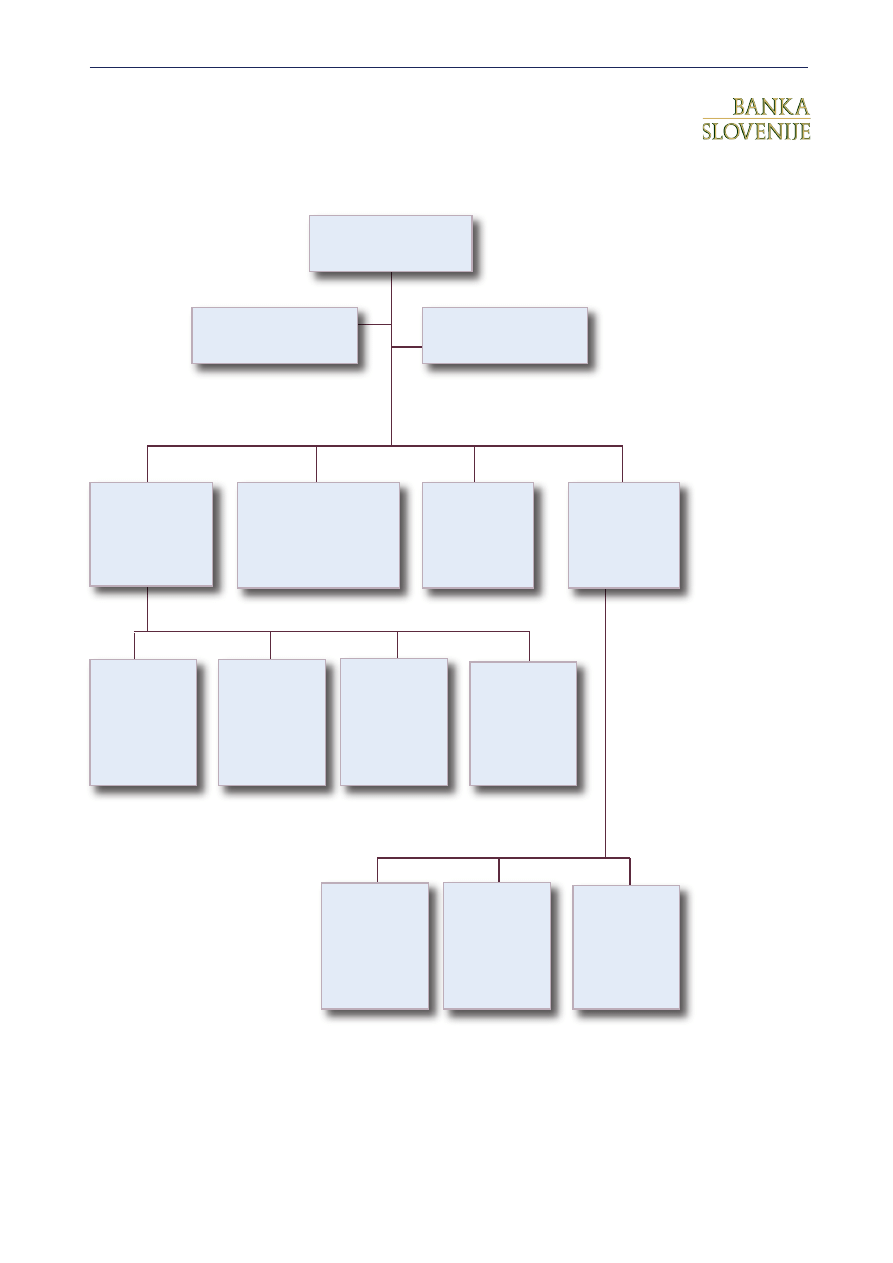
234
Macedonia and Montenegro on the basis of MoUs with foreign supervisory
authorities. As regards the exchange of information, the same rules apply as for
the exchange of information between domestic supervisory authorities.
2004 DEVELOPMENTS IN THE SLOVENIAN BANKING SECTOR
MANAGEMENT
24.00
Legal Advising
24.50
Banking System
Analysis and
Methodology
24.20
Banking
Analysis and
Inspections
24.10
Licensing
24.30
Supervision
of Credit
Risks
Supervision
of Market
Risks
Supervision
of
Operational
Risks
Compliance
Prudential
Regulation
System
Regulation
Accounting
Regulation
Regulation
24.40
Surveillance and Supervision
Regulation
Administration
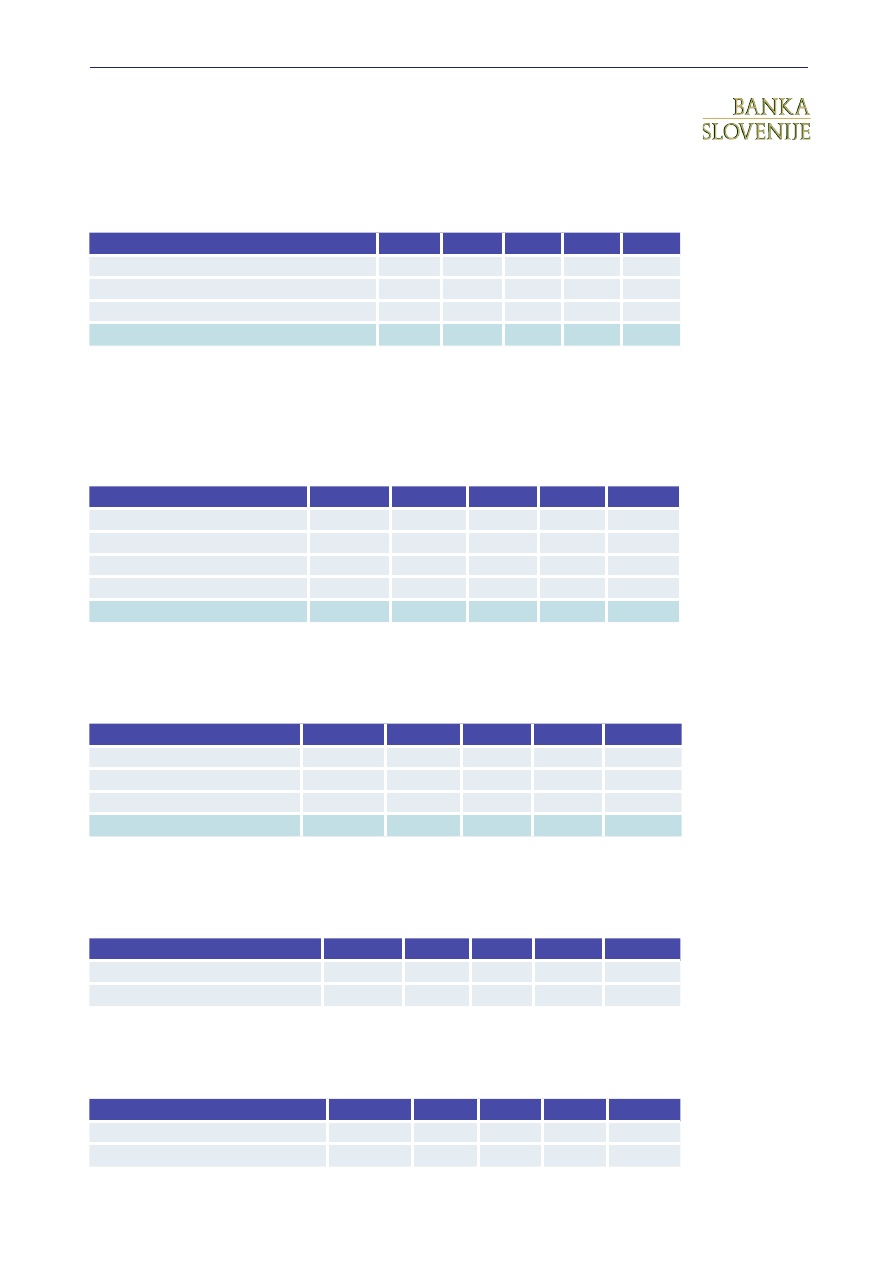
235
STATISTICAL TABLES
Number of credit institutions*
(at year-end)
Type of credit institution
2000
2001
2002
2003
2004
Banks (branches of foreign banks included)
25
21
20
20
20
Savings banks
3
3
2
2
2
Savings and loan undertakings
64
45
25
11
2
Credit institutions, total
92
69
47
33
24
*
The amount of initial capital for banks is set at SIT 1.2 billion, the amount of initial capital for savings banks
and savings and loan undertakings is set at SIT 245 million.
Ownership structure of banks on the basis of shareholders’ equity (%)
Item
2000
2001
2002
2003
2004
Central Government
36.8
37.0
20.3
19.4
19.1
Other domestic ownership
51.2
47.0
47.2
48.2
48.6
Domestic ownership total
88.0
84.0
67.5
67.6
67.7
Foreign ownership
12.0
16.0
32.5
32.5
32.3
Bank, total
100.0
100.0
100.0
100.0
100.0
Distribution of market shares measured by total assets (%)
Type of credit institution
2000
2001
2002
2003
2004
Banks
97.8
98.1
98.6
98.7
99.4
Savings banks
0.4
0.4
0.3
0.4
0.5
Savings and loan undertakings
1.8
1.6
1.1
0.9
0.1
Credit institutions, total
100.0
100.0
100.0
100.0
100.0
Off-balance sheet activities (off balance sheet items / total assets) (%)
Type of credit institution
2000
2001
2002
2003
2004
Banks
22.5
21.2
19.7
20.9
20.5
Savings banks
0.3
0.4
1.0
1.0
1.2
Solvency ratio of credit institutions
Type of credit institution
2000
2001
2002
2003
2004
Banks, average
13.5
11.9
11.9
11.5
11.8
Savings banks, average
11.3
11.1
9.2
8.8
9.5
2004 DEVELOPMENTS IN THE SLOVENIAN BANKING SECTOR
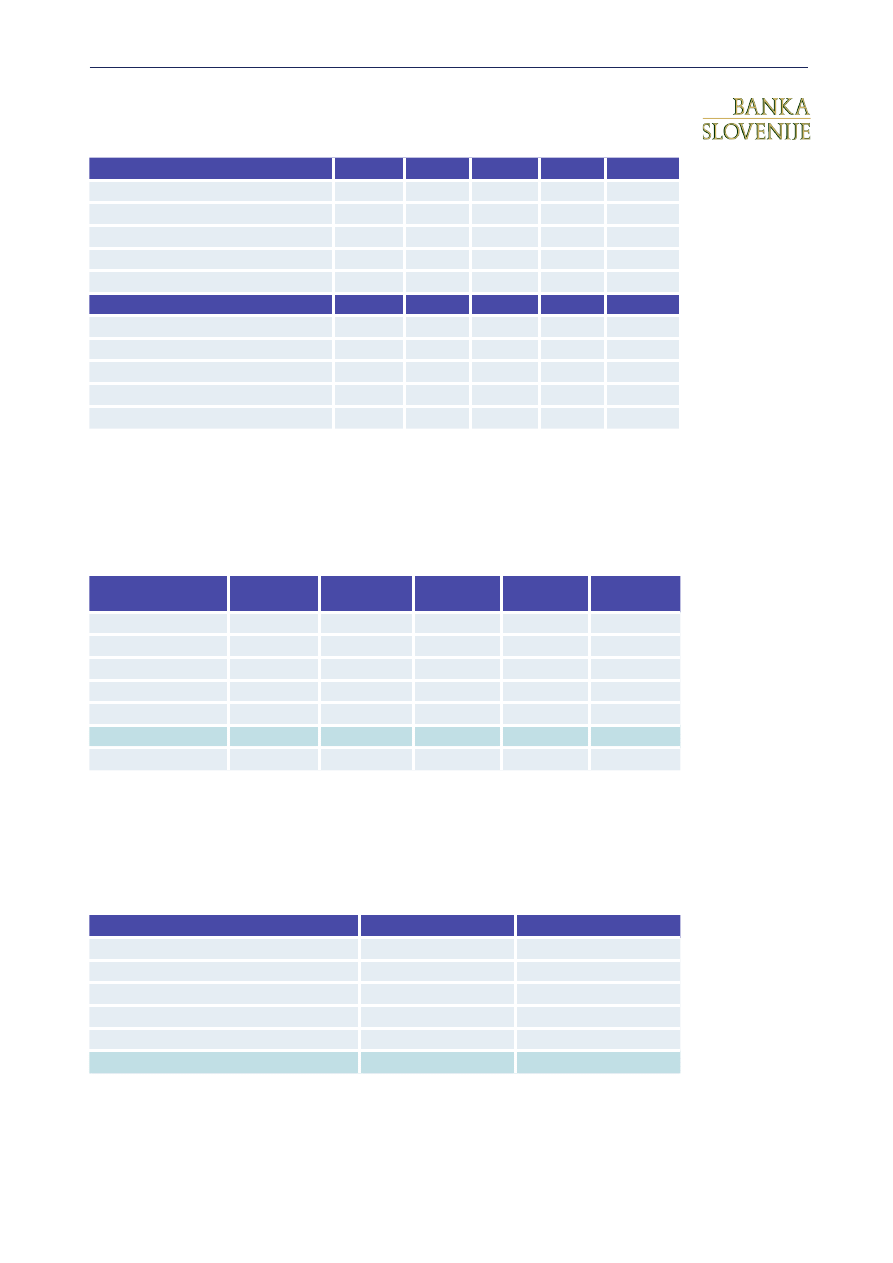
236
The structure of assets and liabilities of banks (%)
(at year-end)
Assets
2000
2001
2002
2003
2004
Cash and balances with CB
3.2
5.3
3.1
2.8
2.5
Loans to banks
11.7
10.2
8.4
6.8
8.9
Loans to customers
52.3
49.4
47.9
50.2
54.1
Securities
25.4
28.6
34.0
34.0
28.9
Other assets
7.5
6.5
6.6
6.2
5.6
Liabilities
Deposits from banks
12.8
11.7
12.8
16.5
19.7
Deposits from customers
69.0
71.2
69.1
65.1
62.1
Liabilities from securities
2.2
2.9
3.9
4.3
4.0
Capital and subordinated liabilities
11.4
9.8
9.9
10.2
10.6
Other liabilities
4.6
4.5
4.3
3.9
3.6
Assets portfolio quality of the banking system
in SIT millions
Assets
Classification
2000
2001
2002
2003
2004
A
2,418,844
2,755,349
2,943,971
3,363,863
4,001,552
B
266,315
348,333
467,919
522,938
624,126
C
75,507
91,012
113,470
119,360
121,050
D
53,692
62,188
63,434
70,428
69,614
E
56,572
78,947
79,483
81,870
79,059
Classified Total
2,870,931
3,335,829
3,668,276
4,158,459
4,895,401
Specific Provisions
168,175
212,079
228,868
244,902
255,598
The structure of deposits and loans (%)
(at year end)
Deposits
Loans
Households
66.4
24.9
Government sector
3.8
4.7
Corporate
18.0
63.1
Foreign
2.2
3.2
Other
9.6
4.2
Total
100.0
100.0
2004 DEVELOPMENTS IN THE SLOVENIAN BANKING SECTOR
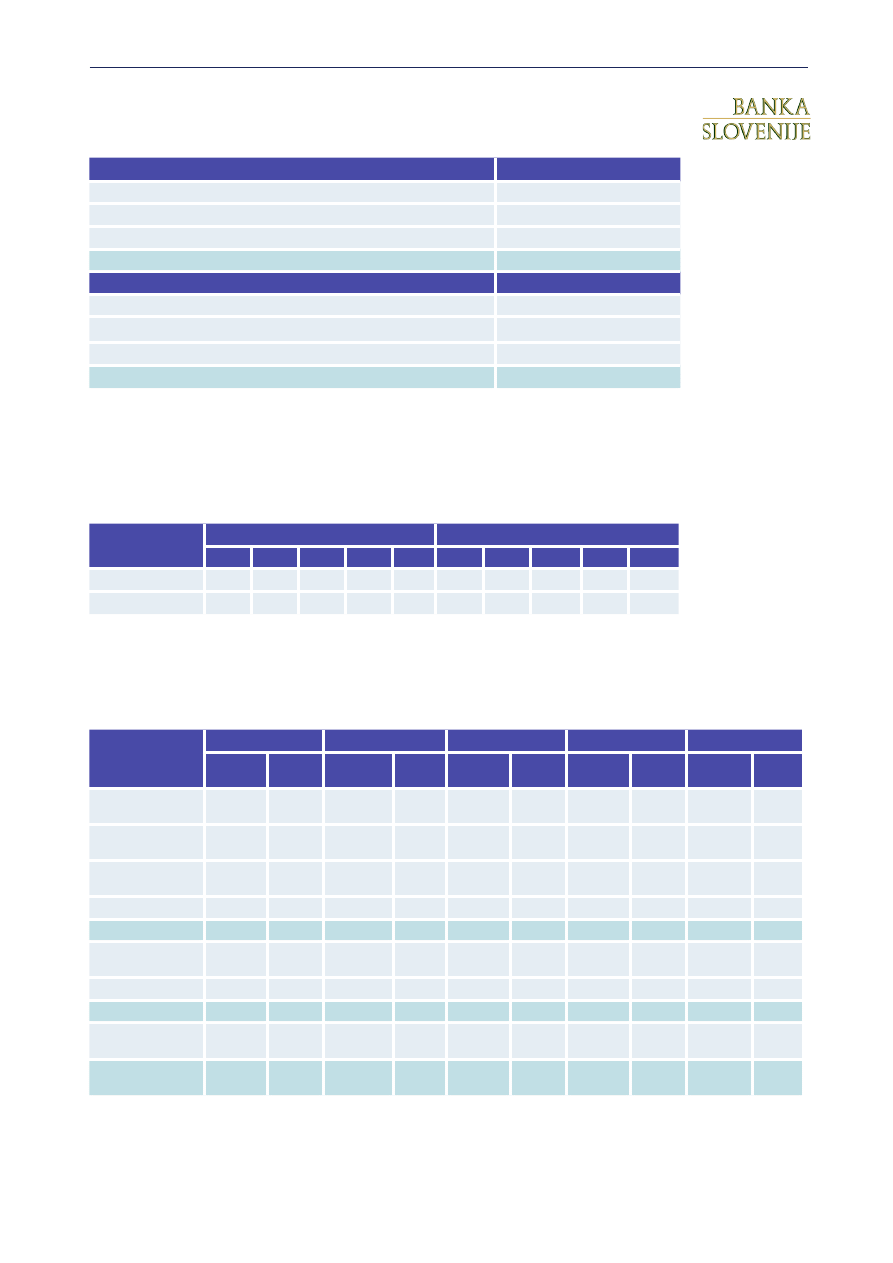
237
The structure of deposits and loans by maturity (%)
(at year end)
Deposits
At sight
34.8
Within one year
57.5
Over one year
7.7
Total
100.0
Loans
Long-term loans
49.6
Medium-term loans
Short-termn loans
50.5
Total
100.0
Proportion of foreign exchange assets and liabilities
(at year-end)
Type of credit
institution
Forex assets / Total assets
Forex liabilities / Total liabilities
2000 2001 2002 2003 2004 2000 2001 2002
2003
2004
Banks
33.5
34.4
33.0
33.4 35.9
34.9
35.3
33.9
34.6
38.3
Savings banks
0.3
0.3
0.1
0.1
0.1
0.0
0.0
0.0
0.0
0.0
Profit ans loss account of banks
2000
2001
2002
2003
2004
SIT
mills
USD
mills
SIT mils
USD
mills
SIT
mills
USD
mills
SIT
mills
USD
mills
SIT
mills
USD
mills
Net interest
income
126,134
555
115,930
462 143,407
649 145,678
769 143,678
815
Net fees and
commissions
37,858
166
41,523
165
53,962
244
54,907
290
61,872
351
Net financial
operations
14,442
64
20,805
83
21,205
96
19,490
103
30,268
172
Net other
-8,193
-36
-5,080
-20
5,808
26
8,862
47
6,934
39
Gross income
170,240
749
173,179
690 224,382
1,015 228,937
1,209 242,753 1,377
Operating
expenses
100,436
442
112,949
450 133,914
606 143,169
756 147,729
838
– labour costs
48,717
214
53,181
212
66,169
299
72,015
380
76,967
437
Net income
69,804
307
60,230
240
90,467
409
85,768
453
95,024
539
Net provisions
and write-offs
-37,233
-164
-44,783
-178
-44,450
-201
-38,006
-201
-38,908
-221
Profit before
taxation
32,571
143
15,447
62
46,017
208
47,762
252
56,115
318
2004 DEVELOPMENTS IN THE SLOVENIAN BANKING SECTOR
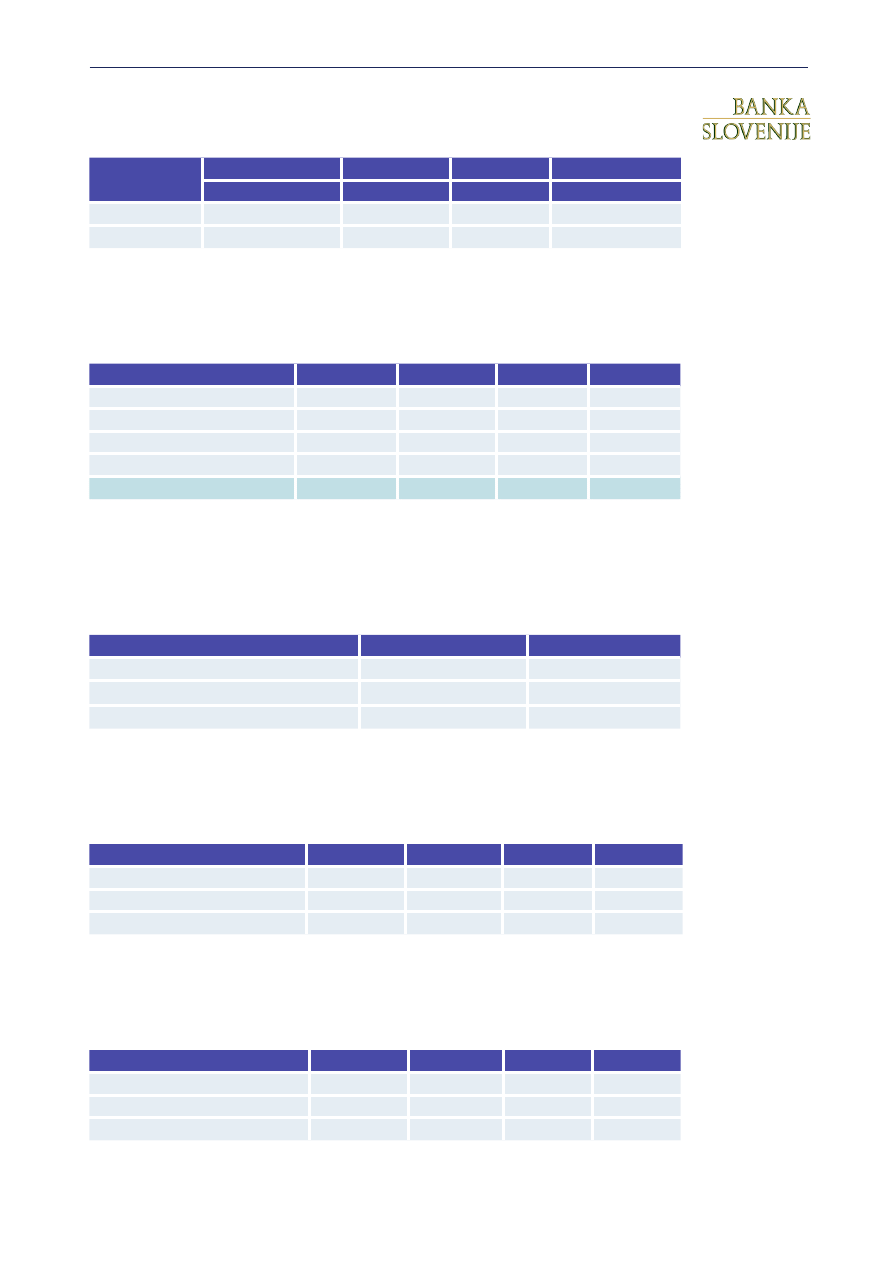
238
Structure of registered capital and own funds of credit institutions
(at year end)
Type of credit
institution
Registered capital
in Total assets
Own funds
in Total liabilities
USD millions
%
USD millions
%
Banks
494.3
1.5
2,496.7
7.7
Savings banks
4.4
2.9
10.3
6.8
Ownership structure of banks on the basis of total assets
Item
2001
2002
2003
2004
Central Government
41.6
24.9
23.8
23.6
Other domestic ownership
42.0
40.4
40.2
40.3
Domestic ownership total
83.6
65.4
64.0
63.8
Foreign ownership
16.4
34.6
36.0
36.2
Bank, total
100.0
100.0
100.0
100.0
Concentration of assets by the type of credit institutions (%)
(at year end)
Type of credit institution
The first three largest
The first five largest
Banks
51.9
65.1
Savings banks
100.0
Savings and loan undertakings
100.0
Return on asset (ROA) by type of credit institutions
Type of credit institution
2001
2002
2003
2004
Banks
0.45
1.11
1.00
1.05
Savings banks
1.62
0.94
1.04
1.06
Savings and loan undertakings
-0.77
-2.18
0.68
0.18
Return on equity (ROE) by type of credit institutions
Type of credit institution
2001
2002
2003
2004
Banks
4.77
13.30
12.47
13.34
Savings banks
17.31
12.02
15.42
16.93
Savings and loan undertakings
-9.34
-29.30
11.77
2.18
2004 DEVELOPMENTS IN THE SLOVENIAN BANKING SECTOR

239
2004 DEVELOPMENTS IN THE
UKRAINEN BANKING SYSTEM
MACROECONOMIC ENVIRONMENT IN UKRAINE
In 2004, the trend of economic growth persisted in Ukraine. Real gross domes-
tic product increased during the year by 12.1%.
Industrial output increased by 12.5%. The highest growth rate among the
main types of industrial activities equivalent to 28% was achieved in the branch
working to meet the investment demand of enterprises – machine building.
Total output in agricultural production increased by 19.1%.
Growth in volumes of retail turnover amounted to 21.9%.
Macroeconomic stability in Ukraine was to a certain extent ensured by the
efforts of banking system. What is meant here are national currency stability,
high level of surplus in the BoP current account, extension of the state inter-
national reserves.
Real effective exchange rate had stable dynamics for the Ukrainian export-
ers. Exports of goods and services increased by 37.2%, imports – by 26%. The
positive current account balance made 10.5% of gross domestic product, while
in 2003 this indicator was 5.8%. The increase in current account balance was
accompanied by a substantial capital inflow on the financial account as a result
of funds attraction from placement of bonds in international markets, increase
in foreign direct investments (1.2 times comparing with the previous year),
attraction of long-term credits, etc.
Total nominal money income of the population increased in 2004 by 25.1%,
its real income grew by 23.8 (versus 15.2% in the previous year).
DEVELOPMENT OF THE BANKING SYSTEM
As of January 1, 2005, there were 160 banks operating in Ukraine, 133 banks out
of them were joint-stock companies including 92 public joint-stock companies
(two of which were state-owned banks), 40 private joint-stock companies and
28 banks were limited companies.
As of January 1, 2005, nineteen banks with foreign capital participation func-
tioned in Ukraine, seven of them were established with 100% foreign capital.
During 2004 the foreign capital share of the banks’ authorised capital decreased
from 11.3% to 9.6% as a result of foreign capital growing at a lower pace than
the total authorised capital of banks.
In 2004 there were tendencies in operation and development of the
banking system of Ukraine which were the evidence of strengthening and
enhancement of the favourable impact on the socio-economic development of
the country.

240
Total banks’ capital increased by 37%, the authorized capital – by 43%.
Average authorized capital per one functioning bank grew by 41% over
2004.
As of January 1, 2005, the number of banks with the regulatory capital over
5 million Euro equalled to 130 (more than 80% of the total number of operating
banks), including 59 banks with the capital being in excess of 10 million Euro
(37% of the total number of operating banks).
Total amount of banks’ liabilities increased by 32.7%. Deposits of individuals
formed the biggest share in the liability structure. The rate of increase in indi-
vidual deposits (28.3%) decreased versus the previous year, which was caused
by the unstable political situation in November-December, but this unfavour-
able trend was successfully overcome at the beginning of 2005.
Total assets of banks increased by 34.1%. The banks’ assets increased mainly
due to credit portfolio growth, which made 32.3%. Debts under credits granted
to the economic entities increased by 25.7% and as of January 1, 2005 comprised
75% of the credit portfolio. Long-term loans kept on growing at outstripping
growth rates – by 61.8% and their share in the credit portfolio increased from
38.3% to 46.8%. The loans to investment operations increased by 75.5%.
The activities of banks become increasingly more social-oriented. The loans
granted to households increased by 64.4% in 2004 and their share in the credit
portfolio increased from 12% to 15%.
The rehabilitation of the banking system was performed through liquida-
tion and reorganization of insolvent and financially unsound banks. In 2004
four banks were excluded from the State register, among them 3 as a result of
liquidation procedure completion, and 1 in the process of the reorganization
through the merger with another bank as a branch. In the stated period 7 new
banks were registered.
THE LEGAL AND INSTITUTIONAL FRAMEWORK OF THE
BANKING OPERATION AND SUPERVISION
LEGAL POWERS OF THE BANKING SUPERVISION
AUTHORITIES
The Law of Ukraine “On Business Associations”, “On Banks and Banking”
and “On the National Bank of Ukraine” are the legal framework of banking in
Ukraine.
In compliance with the above laws, banking regulation and supervision in
Ukraine are effected by the National Bank of Ukraine, defined in the Constitution
of Ukraine as the special central body of state power.
The National Bank of Ukraine performs state regulation of banking activities
in the form of administrative and indicative regulation.
Supervisory activities of the National Bank of Ukraine extend to all the banks,
their units, affiliated and related persons of banks in the territory of Ukraine
and abroad, as well as other legal entities and individuals with regard to their
abidance by the requirements of the laws in force and regulatory acts concern-
ing the performance of banking activities.
2004 DEVELOPMENTS IN THE URKAINEN BANKING SYSTEM

241
The National Bank of Ukraine performs banking supervision on the indi-
vidual and consolidated basis and applies measures of influence for the breach
of current laws and regulations on banking.
Performing banking supervision the National Bank of Ukraine is entitled to
require from banks and their management to rectify a breach of the banking
laws in order to avoid or overcome the unwanted consequences that can endan-
ger the safety of funds trusted to such banks or prevent proper maintenance of
banking activities.
In 2004 the National Bank of Ukraine performed banking regulation and
supervision in accordance with the following regulatory acts:
• Regulation on the Procedure of Establishment and State Registration of
Banks, Their Branches, Representative Offices and Divisions;
• Regulation on the Procedure of Granting Banking Licenses, Written
Permissions and Licenses for Performance of Certain Banking Operations;
• Instruction on the Procedure of Regulation and Analysis of Banking
Activities in Ukraine;
• Regulation on the Procedure of Forming and Using of the Provisions to
Compensate Possible Losses on the Lending Operations of Banks;
• Regulation on the Procedure of Forming and Using of the Provisions to
Compensate Possible Losses on the Commercial Banks’ Receivables;
• Regulation on the Procedure of Fair Value Determination and Reduction
of Securities Yield;
• Regulation on the Application of Measures of Influence for Banking Law
Violation;
• Regulation on the Planning and Procedure of On-Site Inspections;
• Guidelines on the On-Site Inspection of Banks and Banking Institutions
in Ukraine;
• Regulation on the Procedure of CAMELS Rating Assignment;
• Guidelines on the On-Site Inspection of Banks “Risk Assessment
System”;
• Rules on the Organisation of Statistical Reporting Submitted to the
National Bank of Ukraine;
• Regulation on the Certification of Banking Auditors;
• Instruction on the Procedure of Preparation and Release of the Financial
Reporting;
• Rules on the Registration of Correspondent Accounts by the National Bank
of Ukraine and Other Banks.
MAIN STRATEGIC GOALS OF THE BANKING
SUPERVISION AUTHORITY
The main goals of the banking regulation and supervision are safety and finan-
cial stability of the banking system and protection of depositors’ and creditors’
interests.
It is envisaged to achieve these goals through higher efficiency of the banking
supervision authority and its complete compliance with the Basel Committee’s
Core Principles for Effective Banking Supervision.
2004 DEVELOPMENTS IN THE URKAINEN BANKING SYSTEM

242
Currently the strategic aims of banking supervision for the nearest future
are the following:
• Phased introduction of risk based supervision together with the use of
traditional approaches;
• Raising capitalization of the banking system;
• Providing banking system transparency;
• Enhancement of control over the related party lending;
• Creation of methodological basis to introduce the consolidated banking
supervision procedures;
• Enhancement of corporate governance in banks;
• Refinement and broad implementation of the early response system;
• Initiating works on the introduction of the Basel II requirements;
• Providing continuous training and advanced training programs for the
banking supervision staff.
ACTIVITIES OF THE BANKING SUPERVISION AUTHORITY
IN 2004
In 2004 the National Bank of Ukraine continued to bring the legal and regula-
tory framework on the banking regulation and supervision into line with the re-
quirements of the EU laws and regulations as well as with the Basel Committee’s
Core Principles for Effective Banking Supervision.
The draft laws aimed at settlement of the following issues were elaborated
and submitted to the Parliament’s consideration:
• authorizing NBU to identify beneficial owners of a bank and origin of the
funds directed to the share purchase;
• abolishment of the rule allowing banks to conclude contracts with related
parties on more favorable terms than with other customers of the bank;
• conducting financial audit in accordance with the requirements of the In-
ternational Auditing Standards as well as banking supervision authority
relationship with the bank’s external auditors;
• providing the legal framework for establishment of foreign bank branches
in Ukraine.
Fourteen amendments were made to the regulations, which encourage:
• stimulation of banking capital inflow – through facilitation of registra-
tion procedures for the authorized capital of banks, widening the range
of instruments that may be used by banks for additional capital add-on,
widening the interest rate limit for the attracted subordinated capital;
• capital quality enhancement through the improvement of its calculation
procedure;
• risk decrease of lending transactions, in particular of foreign exchange
credits, through setting stricter requirements to provisioning for the
foreign exchange loan losses;
• extension of the NBU authorities in the implementation of measures of
influence against the banks that have allowed significant augmentation
of the adversely classified assets; and others.
2004 DEVELOPMENTS IN THE URKAINEN BANKING SYSTEM

243
One more direction of the banking supervision activities was the off-site
monitoring and inspections of banks.
During inspections the issue of banks compliance with the laws and NBU reg-
ulations was checked. Special emphasis was laid on the capitalization of banks,
efficiency of their control and management systems for the banking risks, evalu-
ation of management level, internal control systems, adequacy of provisions for
active operations and availability of the provisions and procedures necessary
for the counteraction to banking fraud, legalization of the proceeds from crime
and financing terrorism.
On the results of inspections performed each bank received a rating under
the CAMEL system and, when necessary, adequate measures of influence were
implemented.
ORGANIZATIONAL STRUCTURE OF THE BANKING
SUPERVISION AUTHORITY
Within the National Bank of Ukraine the supervision function is performed by
4 departments:
• Banking Regulation and Supervision Methodology Department
• Banks Registration and Licensing Department
• Banking Regulation and Supervision Department
• Banks Dissolution Department
The above-mentioned departments are subordinate to the Deputy Head of
the National Bank of Ukraine responsible for banking supervision.
INTERNATIONAL ACTIVITY OF THE BANKING
SUPERVISION AUTHORITY
In 2004 the National Bank of Ukraine continued to cooperate with international
organizations in the area of monitoring performance of the banking sector re-
form programs, in particular: with the World Bank – under the Programmatic
Adjustment Loan Project and Technical Assistance Project, financed by the
Dutch grant; with the IMF as a part of the Extended Fund Facility Program
(EFF); with the European Commission – under the Program of the Ukrainian
Banking Sector Reform.
Bilateral agreements on cooperation in banking supervision continued to
be concluded with the banking supervision authorities from other countries.
In 2004 such agreements were concluded with the supervision authorities of
Latvia, Kyrgyz Republic and Armenia.
2004 DEVELOPMENTS IN THE URKAINEN BANKING SYSTEM

244
COOPERATION WITH OTHER SUPERVISION BODIES
Exercising the functions of banking supervision the National Bank of Ukraine
coordinates the activity and information exchange with other supervision bod-
ies of the country, in particular, State Commission for Regulation of Financial
Services Markets in Ukraine, Securities and Stock Market State Commission,
Department of Financial Monitoring within the Ministry of Finance, State Tax
Administration, etc.
OTHER IMPORTANT INFORMATION AND EVENTS FOR
2004
In 2004 during the XVII Conference of the Group of Banking Supervisors from
Central and Eastern Europe (BSCEE) in Dubrovnik, Croatia, it was agreed to
hold the next annual conference of the BSCEE Group in Kyiv. Thus, under par.
4.3.2 of the BSCEE Group Agreement the National Bank of Ukraine Deputy
Governor, Banking Supervision, has become the Head of the BSCEE Group
starting from December 16, 2004.
In the year under review the National Bank of Ukraine initiated arrangements
for the XVIII Conference of the Group of Banking Supervisors from Central and
Eastern Europe held in Kyiv, May 2005.
STATISTICAL TABLES
Number of financial institutions
(at year-end)
Type of financial Institution
2002
2003
2004
Banks
157
158
160
Ownership structure of banking system
on the basis of registered capital (%)
(at year-end)
Item
2002
2003
2004
Public sector ownership
4.9
5.7
5.5
Other domestic ownership
81.4
83.0
85.4
Domestic ownership, total
86.3
88.7
90.9
Foreign ownership
13.7
11.3
9.1
Financial institutions, total
100.0
100.0
100.0
2004 DEVELOPMENTS IN THE URKAINEN BANKING SYSTEM

245
Ownership structure of banking system
on the basis of assets total (%)
Item
2002
2003
2004
Public sector ownership
11.8
9.5
8.0
Other domestic ownership
75.7
78.1
81.0
Domestic ownership total
87.5
87.6
89.0
Foreign ownership
12.5
12.4
11.0
Financial institutions, total
100.0
100.0
100.0
Concentration of assets by type of financial institutions
concentration of assets
Type of financial institution
First three major banks
First five major banks
Banks
27.9
37.4
Return on assets (ROA) (%)
Type of financial Institution
2002
2003
2004
Banks
1.27
1.04
1.07
Return on equity (ROE) (%)
Type of financial Institution
2002
2003
2004
Banks
7.97
7.61
8.43
Development of off-balance sheet activities (%)
(off-balance sheet items / balance sheet total)
Type of financial institution
2002
2003
2004
Banks
58.8
49.7
51.6
Solvency ratio of financial institutions (%)
Type of financial institution
2002
2003
2004
Banks
18.01
15.11
16.81
2004 DEVELOPMENTS IN THE URKAINEN BANKING SYSTEM
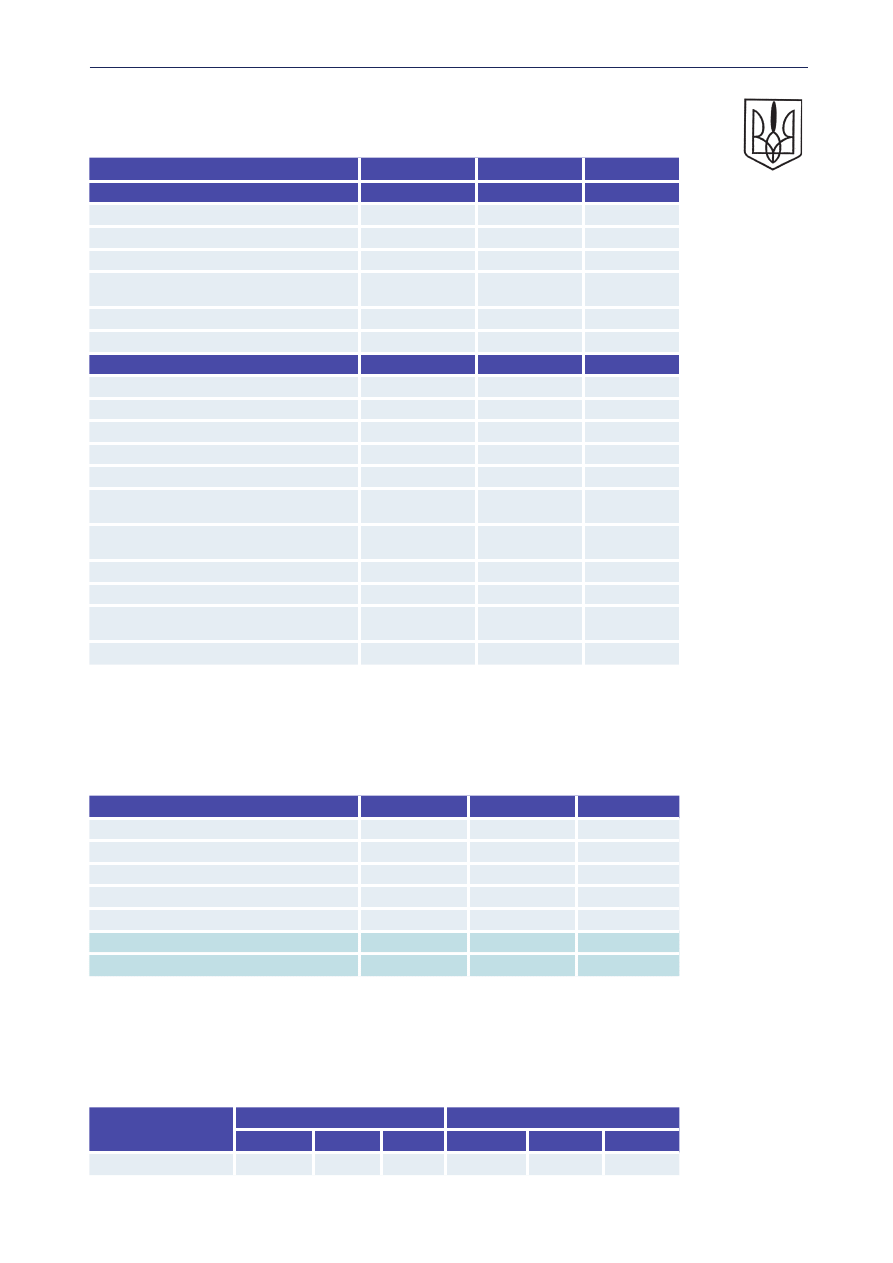
246
The structure of assets and liabilities of the banking system (%)
(at year-end)
2002
2003
2004
Assets
100.0
100.0
100.0
High liquidity assets
13.3
15.2
16.7
Credit portfolio
69.0
69.6
68.7
Investments in securities
6.5
662
5.8
Accounts receivable
Total
2.1
1.1
0.9
Fixed and intangible assets
7.3
6.2
6.3
Other assets
1.8
1.7
1.6
Liabilities
100.0
100.0
100.0
Funds of the NBU
2.4
2.7
3.5
Budgetary and off-budget funds
3.2
1.3
1.4
Inter-bank credits and deposits
11.9
12.4
11.3
Funds of economic entities
36.5
32.0
34.6
Funds of natural persons
35.4
36.8
35.5
Funds of non-banking financial
institutions
-
3.8
4.1
Credits from international and other
financial organizations
1.5
1.0
1.4
Own debt securities
1.4
0.9
0.5
Subordinated debt
1.6
1.3
1.2
Accounts payable on transactions with
banks and bank customers
1.6
1.9
1.0
Other liabilities
4.5
5.9
5.5
Asset portfolio quality of the banking system
credit portfolio (%)
Asset classification
2002
2003
2004
Standard loans
37.65
66.57
67.0
Watch list
40.49
5.15
2.9
Substandard
14.68
21.06
22.5
Doubtful
3.05
4.56
5.5
Bad
4.12
2.67
2.1
Classified Total
100.0
100.0
100.0
Specific Reserves (UAH mln)
3,574. 8
4,631.2
6,367.0
Proportion of foreign exchange assets and liabilities (%)
(at year-end)
Type of financial
Institution
FOREX assets / Total assets
FOREX liabilities / Total liabilities
2002
2003
2004
2002
2003
2004
Banks
37.3
37.5
38.8
38.9
40.0
43.4
2004 DEVELOPMENTS IN THE URKAINEN BANKING SYSTEM

247
The ownership structure of bank deposits and loans in 2004 (%)
(at year-end)
Deposits
Loans
Households
48.8
17.3
General government
0.0
0.03
Corporate
50.3
82.7
Other
0.9
0.02
Total
100.0
100.0
The structure of bank deposits and loans in 2004 (%) (by terms)
(at year-end)
Maturity of deposits
Loans
At sight
42.4
Long- term
52.0
Within one year
21.3
Medium-term
-
Over one year
36.3
Short-term
48.0
Total
100.0
Total
100.0
Structure of revenues and expenditures of the banking system
(at year-end)
2002
2003
2004
Revenues
100.0
100.0
100.0
Interest earned
65.9
68.1
67.5
Income from commissions
24.8
24.8
23.0
Performance of trade transactions
6.4
5.3
5.3
Other operating income
1.7
1.1
3.7
Other income
0.6
0.3
0.3
Recovery of written off assets
0.5
0.4
0.2
Unexpected income
0.0
0.01
0.004
Expenditures
100.0
100.0
100.0
Interest paid
37.4
37.5
41.2
Commission paid
3.1
2.9
2.7
Other operating costs
6.1
6.1
6.2
General administration expenditures
41.1
36.9
34.8
Allocation to reserves
9.5
13.1
12.9
Extraordinary expenditures
0.0
0.0
0.004
Income tax
2.8
3.4
2.2
Registered capital and own funds of financial institutions in 2004
Type of financial
institution
Registered capital
/Total
assets
Own funds
/Total
liabilities
Banks
1,677,677
Euro in thous.
9.0
2,552,341
Euro in thous.
13.7
2004 DEVELOPMENTS IN THE URKAINEN BANKING SYSTEM

248
MAIN GROUP EVENTS OF THE YEAR
2004
REPORT OF THE 17TH ANNUAL MEETING OF THE BSCEE
GROUP
26-29 MAY 2004. DUBROVNIK, CROATIA
The first day’s discussion of the two day conference was focused on forward
looking provisioning, the other day was devoted to the creation of an optimised
organisation framework for supervision. Furthermore, the annual report of the
BSCEE secretariat was presented and Montenegro – the 19
th
member – was
admitted to the organisation.
Forward looking provisioning
The moderator of the topic was Mr. Jason George, of the FSI in Basel. In his
keynote address he discussed the importance and basic principles of provision-
ing, the current accounting practice, stressing that reserving is, to a consider-
able extent, a matter of accounting. At the end of his presentation he discussed
the expected future provisioning methods, from the aspect of accountancy he
touched on booking at real value and from the aspect of economics he talked
about the method of dynamic provisioning. The following are considered to be
the main points of Mr. George’s presentation:
• Real valuation
The Basel Committee holds that this is suitable for stating trading posi-
tions but the valuation of the credits contained in the banking book is not
without problems if the current rules of the method are applied, therefore it
is not the time yet to prescribe overall booking of all instruments of banks
at real value, in their financial statements.
• The time horizon of provisioning may be divided into three
phases of development,
– Models based on actual losses
– Models based on expected losses – these already include forward
looking elements
– Dynamic or statistical provisioning
• Dynamic/statistical provisioning
– Instead of the estimate of the loss contained in the portfolio at the
time of the drafting of the current balance sheet report, provisioning
for a given receivable is based on the estimate of the loss that may be
expected in a long run, in the various accounting periods.
– Long term estimate is worked out in view of the pro-cyclic nature of
economy, the characteristics of the various portfolios and it produces
estimates on the basis of statistics available in a long run.

249
– It evens out the profit generation of the bank, stabilising thereby the
operation of the bank.
– It demands filling up reserves during a period of growth to be available
for use during hard times.
– Forecasting loss expected in a longer run is also necessary for the
purposes of pricing.
– It is to be generated from the profit after taxes so that its generation is
not biased by taxation related considerations.
Dynamic provisioning was introduced first by Spain, in 2000. Mr. George
brought up a number of arguments against the application of the method,
primarily from the aspect of the auditor:
• This method is contrary to 39 IAS provisions
• The balance sheet report pertains to a given period of time, however, at
a given point in time the bank does not state the real profit if it uses this
method
• A practice of evening profits out over time does not necessarily lead to
more stable financial management
• The application of this method complicates comparing and analysing costs
and revenues
The next presentation was delivered by Mr. Evan Kraft, head of the Research
Department of the National Bank of Croatia, who – unlike Mr. George –
approached the issue from the aspect of economics. In this aspect:
• The currently applied practice of provisioning is a backward looking one,
since it is based on events that have already occurred.
• This approach is supported by accounting standards because it reduces
the discretional elements and it provides an adequate picture of the state
of the bank in the given point in time.
• According to economists this approach prevents provisioning for losses
that we know are bound to occur but we do not know when (probably
during the next economic slump).
• It is not that easy to set aside provisions during an economic downturn.
Mr. Kraft went on to describe the Spanish system, how the practice of provi-
sioning affects the spreading of profits and showed the findings of the research
carried out on the applicability of the method in Croatia. The key lessons are
as follows:
• Dynamic provisioning may be a very attractive method for reducing
financial instability but it can be applied in stable economies on the basis
of long series of data (data on 16 years are used in Spain) but the unstable
market and provisioning practices of the emerging markets and the lack
of a sufficient quantity of data do not realistically permit its application.
During the remaining part of the day the representative of Slovenia delivered
a presentation on methods of provisioning, discussing how they are assess-
ing the possibility to introduce the practice of dynamic provisioning. Later on,
during the roundtable discussion, delegates of Hungary, the Czech Republic
and Bulgaria described their provisioning practices.
MAIN BSCEE GROUP EVENTS OF THE YEAR 2004

250
The final conclusion drawn on the theme of the day was that dynamic provi-
sioning is – owing the above mentioned factors – not considered to be a realis-
tic alternative in the countries of the group, and prior to its introduction there
are questions of accounting that need to be clarified, and the expected impacts
have to be analysed through in-depth research and simulations. Meanwhile, the
intended objective may be attained through other means, and it should not be
forgotten that banks’ management teams have always been and will always be
making efforts to even out the profits, through over-provisioning in ‘good times’,
which is also promoted by the tax-exemption granted to reserves.
At the end of the day Mr. Charles Freeland, deputy secretary general of the
Basel Committee described current issues relating to Basel II, including the
latest decisions published in the Press Release of 11 May. His presentation – like
the Press Release – mentioned the recommendation of the Basel Committee,
prompting the supervisory authorities of the host countries to turn with their
questions pertaining to the subsidiaries of global groups operating in their coun-
tries, to the supervisory authorities of the home countries (instead of turning
directly to the bank) during the period of preparations in relation to implemen-
tation, in order to reduce the regulatory pressure borne by banking groups that
have numerous subsidiaries.
László Balogh, Managing Director of the HFSA promptly responded to this,
showing that in countries with a 70-90 % presence of foreign banks in the bank
sector this principle does not function because in this way the supervisory au-
thorities would lose all control over the preparations of their banks and this
is contrary to their responsibility enshrined in law. Furthermore, in the case
of subsidiary banks registered as domestic credit institutions the supervisory
authority bears responsibility for the protection of the deposit holders, for the
stability of the system and, in case of need, for final performance, therefore, it is
not possible for anybody to limit the rights of the domestic supervisory author-
ity in monitoring and supervising the preparation process. He asked the deputy
secretary general of the Basel Committee to explain the problem to the member
states. The delegates of the Czech Republic, Slovakia and Poland also backed
up the request and the Group agreed that Hungary would produce a draft let-
ter drawing the attention of the Basel Committee to this impossible situation,
proposing that it should review its position in a way as will ensure that the Basel
Committee receives this letter before its meeting on 20 June.
The theme of the second day was the expected organisational development
of the banking and money market supervisory authorities in the near future. It
is a regularly recurring issue in this region as well, whether the high level in-
tegration of the financial markets and financial products does not necessitate
integration of the sectorally separated organisations of supervision as well. To
date, Estonia and Latvia have chosen the approach of complete integration – in
addition to Hungary – while Slovakia and the Czech Republic have started a
process of partial integration. The following main points were drawn from the
presentations delivered on this topic:
• Croatia
The current president of the BSCEE and at the same time the moderator
of the day, Mr. Cedo Maletic, Vice Governor of the CNB summed up (in-
stead of the representative of the World Bank who had been invited but
MAIN BSCEE GROUP EVENTS OF THE YEAR 2004

251
declined participation owing to some other programme) the pros and cons
of an integrated supervisory model, drawing largely on a former World
Bank study: the conclusion was that both systems of arguments are widely
applied, each country has to formulate the solution most appropriate to
its historical development, traditions, the level of development and the
requirements of the financial sector.
• Czech Republic
Mr. Pavel Racocha, member of the Board of Directors of the National
Bank of the Czech Republic, head of the board of directors of the Banking
Supervision, described the existing supervisory structure and a two-tier
plan for the integration of supervision. The financial sector is currently su-
pervised by three institutions: the National Bank is supervising the banks,
the Securities Supervision is supervising investment service providers,
the Ministry of Finance is supervising credit and savings cooperatives,
insurers and funds. In the first phase the supervision of credit and savings
cooperatives will be taken over by the National Bank, in the second phase
a single sectoral level supervisory organisation is planned to be created
but no decision has so far been made about the institution in which inte-
grated supervision will be performed. The fundamental organising prin-
ciple however, is that the regulatory and the supervisory power should
be exercised by a single institution. The arguments of the Czech delegate
for continued integration were more or less in line with those confirmed
by what Hungary has experienced: consolidated supervision, monitoring
of integration in the market, strong synergetic effects, economies of scale,
more comprehensive overview of the financial system.
• Slovakia
Peter Balázs, the representative of the National Bank of Slovakia, talked
about the plans of Slovakia. Two supervisory authorities are operating in
Slovakia at present: the National Bank is supervising credit institutions,
the money market supervision is supervising insurers, investment service
providers and funds. They are planning to introduce single sectoral su-
pervision within the framework of the national bank, by integrating the
money market supervision. The new regime is expected to be launched
on 1 January 2006.
• Hungary
Mr. László Balogh, Managing Director of the HFSA, described the already
completed organisational integration, summing up the experience and
lessons drawn from the past four years of operation.
• Poland
The representative of the National Bank of Poland, Mr. Piotr Bednarski,
said about the Polish supervisory system, that at present both banking
supervision and the supervision of insurers and funds as well as that of
investment service providers, is carried out by separate institutions. Since
there are no conglomerates in the Polish financial sector, the level of de-
velopment of the market does not strengthen interpenetration of differ-
ent financial institutions, some 80 % of the financial sector is made up of
banks, they do not see it necessary to create an integrated (consolidated)
supervisory authority. Owing to their roles in the sector they regard the
MAIN BSCEE GROUP EVENTS OF THE YEAR 2004

252
supervision of banks to be the most important task, which they are not
planning to release from the framework of the National Bank to organise
it in an independent organisation, for this is the way they see the preser-
vation of the material, financial, regulatory, institutional and operational
independence to be most reliably assured.
Roundtable discussion
The key elements o the roundtable discussion:
• The desirable supervisory structure is determined by the market
structure.
• The development of consolidated supervisory structures was a result of an
organic evolution process in Britain and Scandinavia, the transformation
of the system of supervision was triggered by shocks, bank failures and
crises while in Central and Eastern Europe decision makers are driven
primarily by logical planning and alignment to EU expectations.
• It is extremely important that the development of a separate supervisory
organisation should not result in the separation of the regulatory from the
supervisory authority.
• The strategic preparation of consolidation is crucial, the new organisation
needs to have clear cut goals and a well-defined mission statement.
During the same day the Polish delegation delivered a presentation on
the goals, the achievements and this year’s plans of the Banking Supervisory
Training launched by the Polish National Bank. This system of training is aimed
to strengthen the professional training of East-Central European banking su-
pervisors, by transferring practical experience accumulated in the region. They
are organising courses in Russian s well, to enable the widest possible access
to the training. Their programmes are built up in cooperation with FSI and
Toronto Centre.
Secretariat Report
Ms. Andrea Deák, Senior Coordinator of the Secretariat of the BSCEE Group,
summed up the year 2003 and 2004 activities of the BSCEE regional group,
along with its main tasks:
The key tasks of the Secretariat include facilitating the organisation of pro-
fessional seminars in cooperation with the Financial Stability Institute (FSI) of
Basel and the BSCEE Member States. The Group organises two seminars and
one annual conference each year, for the regional group comprising 19 countries.
The first one of the two seminars planned for 2004 has already taken place in
the city of Minsk between 11 and 13 May, on the topic ‘Building an IRB system’.
The next seminar will be organised by the National Bank of Poland in Warsaw,
between 28 and 30 September on ‘Credit Risk Transfer’.
The presidency of the BSCEE Group is changed in a system of annual rotation.
This year Mr. Cedo Maletic, vice-president of the Croatian National Bank – who
MAIN BSCEE GROUP EVENTS OF THE YEAR 2004

253
has organised the conference as well – is the president of the regional group.
The National Bank of the Ukraine has volunteered for presidency in 2005.
The BSCEE Group, which was founded in 1991, has been increased this year
by the joining of its 19
th
member, the National Bank of Montenegro. (In the
Yugoslav federation Serbia and Montenegro each have its separate central bank
and separate banking supervision.) The admission took place at the end of the
conference, in a solemn ceremony.
The Secretariat provided information on other issues involving the Group:
Mr. Radovan Jelasic, the President of the National Bank of Serbia has noted
that the National Bank of Serbia would also like to join the regional Group, as
its 20
th
member. After the submission of the official application the Secretariat
will carry out the formal process of admission and at the year 2005 the new
member may officially join the Group.
In the wake of preliminary consultations the Group has amended the
Agreement and the Operating Code of the BSCEE Group. The modified versions
were signed by 14 of the 16 countries present. The original specimens signed by
each member will be distributed as follows: 1 copy will be retained by the new
member (Montenegro), 1 copy will be retained by the Secretariat and 1 copy
will be kept, by the Chairman. The other members will receive second copies
of the documents.
The documents were modified for the following three reasons:
1) The earlier USD 1000 membership fee was, from 1 January 2004, replaced
by EUR 1000.
2) One new member has joined the Group.
3) Personal changes took place in a number of Member States during recent
years, so the contacts list and other addresses have also been modified.
The basic documents of the BSCEE Group were written by the then 6 members
14 years ago, therefore they need to be revised and perhaps even supplement-
ed and modified. The members of the Group agreed on this point. Mr. László
Balogh, Hungarian representative made a proposal for setting up a working
group to carry out the revision of the basic documents. Volunteers are expected
from among the members to carry out the revision, they should coordinate the
necessary modifications by e-mail, they should coordinate with the members
(producing the draft by February 2005) and submit the revised version of the
basic documents to the members at the year 2005 conference.
The International Monetary Fund (IMF) was represented at the meeting by
Mr. Thordur Olafsson, Senior Financial Sector Expert. This was the first annual
conference of the Group, which was attended by a representative of IMF. Since
when some 4-5 years ago IMF started to analyse international norms relating
to financial supervision and the application of such norms in its member states
as well as effective and reliable supervision in each of the countries, there has
been a need for IMF collecting information directly through the regional bank-
ing supervisory groups about practical problems as well.
MAIN BSCEE GROUP EVENTS OF THE YEAR 2004

254
NEW BASEL CAPITAL AGREEMENT, RULES,
IMPLEMENTATION, CREATION OF INTERNAL CREDIT
RISK MODEL
BSCEE – FSI Regional Seminar
Minsk, Byelorussia, 11-13 May 2004
The seminar aimed to focus on the introduction of internal credit risk models
by banks and the process of giving licences by supervisory authorities, but since
the programme also intended to process the whole of the agreement, there were
presentations on all themes, thus finally the seminar moved away to some extent
from the original focus. The contributors of FSI laid emphasis on describing the
disadvantages of forced introduction and the damage that may be caused by
the forced introduction of the new rules to economies that are not sufficiently
highly developed and prepared for the time being.
IRB model building
Pieter Keemink, head of Risk Management, ING
Mr. Keemink outlined the possibilities, the usually applied tools and approaches,
as well as the most frequent problems. The following is a list of the points he
made in addition to those contained in other similar comprehensive presenta-
tions.
• Banks’ risk managers and the supervisors depend on one another in build-
ing up and particularly in the appraisal of rating systems and models:
neither may succeed without the other’s opinion and knowledge.
• The real ‘test’ of a rating system is the extent to which it is integrated in
the day-to-day practices of the given bank.
• The typical problem of ready-made models and systems is that users do
not familiarise themselves with such models and systems sufficiently, or
that they only have superficial knowledge of their operation.
• When applying a statistical model, there usually remains some 6-8 more
or less independent factors after assessing the relationships between
factors. If one model is reviewed it is worth looking also at the factors that
are not involved.
• It is very difficult to properly handle high quality rating factors.
• In practice, usually hybrid rating systems are applied that are based partly
on statistical models, partly on experts’ opinions.
Supervisory audit process (the 2
nd
pillar)
Jean-Philippe Svoronos, FSI
We decline to provide a general overview again, summing up only the most
interesting points.
• It is not easy to standardise the supervisory audit process. Germany is
trying to apply a checklist-type solution, which ensures, at any rate, that
we do not forget any of the most important factors.
MAIN BSCEE GROUP EVENTS OF THE YEAR 2004

255
• In the course of an audit the emphasis is laid on the bank’s shareholders'
equity calculation (i.e. the supervisors do not carry out calculations), so
the review is practically an audit of this calculation.
• The implementation of the ‘higher than the supervisory minimum capital
requirement’ principle of the Basel Committee needs supervisory powers
provided by legislation. Incidentally, extra capital may be prescribed at
an individual or at a group level.
• There is no standard (one size fits all) solution or best practice for the
shareholders’ equity calculations of banks.
• In the course of an audit it is to be assessed whether the bank has taken
into account all of the relevant risks in calculating its shareholders' equity
and whether it has sufficient capital to cover such risks, whether all of these
are in line with the strategic goals and whether the risk management rules
and processes of the bank are adequate.
• Attention should also be paid among strategic goals to the rating that is
intended to be attained by the given bank.
• A checklist seems to be the best supervisory practice but attention needs
to be paid to ensuring concentration on the really important elements and
not to ‘get lost in detail’.
• One typical problem of supervisory audit is that the employees of the su-
pervisory authority do not know the bank as thoroughly as its employees.
This problem may be relieved partly by peer group analysis.
• The Dutch supervisory authority has set up a specific group (comprising
modelling and other experts) to audit calculations.
• A supervisory audit requires qualified supervisors who need to have more
and substantially different knowledge than before. Moreover, there is a
shortage of the required knowledge in the market, therefore the acquisi-
tion and retaining of highly qualified experts is expensive.
• The required special knowledge includes ability to assess risk models,
knowledge of new products and financial techniques, IT.
• Besides special knowledge there is a need for adequate headcounts: ‘cus-
tomised’ supervision requires more human resources than standardised
supervision.
• There is a wide variety of ways of prescribing (attaining) the extra capital,
in accordance with the different cultural traditions of the various coun-
tries. Brazil for instance, prescribes 11 % across the board, the Dutch rely
on the bank’s own capital calculations (models), Germany has no general
extra capital rule. The British practice which applies ‘trigger’ levels above
the minimum level where specific supervisory actions are applied upon
reaching those levels, may be recommended.
• Implementation is a major challenge for all supervisory authorities. From
among a number of tasks and aspects that can be mentioned here, in the
current phase perhaps communication with the sector may be the most
important area.
MAIN BSCEE GROUP EVENTS OF THE YEAR 2004

256
Supervisory approval process
Frank Thiem, Head of the Deutsche Bundesbank in
charge of onsite supervisory audits
The banking act assigns ongoing monitoring of credit institutions to the scope
of responsibilities of the Bundesbank. Accordingly, the Bundesbank carries out
onsite audits as part of the supervisory audit process. The measures of the Bafin
rely primarily on the Bundesbank audits, but they also carry out audits using
their own resources. On the basis of an agreement the IRB validation audits
are carried out by the Bundesbank, on the basis of which the administrative
measure is taken by Bafin, which may participate in these audits.
Since banks are scattered across Germany, the employees of the Bundesbank
engaged in onsite audits are working in regional headquarters. A total of 2394
financial institutions are operating in the banking sector, the four large banks
hold a 23 % market share, with 136 other large banks hold a total market
share of 56 %. Foreign banks have 114 subsidiary banks and 90 branch units
in Germany.
In year 2003 the Bundesbank assessed the number of banks that could be
expected to opt for IRB, in order to be able to schedule the validation process
and to ensure that it has sufficient time for the elaboration of the adequate
methodology and for making available the necessary resources. The policy
applied by the Bundesbank is to prompt its banks to adopt the IRB to facilitate
the development of the risk management systems, providing them all forms of
assistance – consultation, methodology – if they do adopt the IRB. In the course
of the preparations the Bundesbank maintained ongoing working relationship
with the banks, and the large banks started preparations last year. They discuss
their proposed solutions with Bundesbank on a regular basis.
According to the findings of the survey some 850 banks are planning to apply
the IRB, of which some 25-50 are planning to start using the advanced method.
This equals 44 % of the banks, involving 81 % of the total balance sheet of the
sector. This is a very high ratio by international comparison. The licensing of
the large number of banks takes substantial resources, owing to its time re-
quirement the methodology documents had to be produced in 2004 already.
The Bundesbank published the audit manual for the process of licensing the
IRB models and the operating risk models, in June 2004.
In the course of the preparation for Basel II they transformed their bank
rating system with the aim of creating a more objective risk rating system, which
is a tool for the planning of the audits of the banks. They have set up four risk
dimensions: assets, profitability, capital and liquidity structure and develop-
ment.
The presentation gave a detailed description of the minimum requirements
of the application of the IRB model and the process of validation/testing.
Supervisory validation was described as a puzzle, since a variety of elements
need to be assessed, such as:
• Components
– Data collection, registry, data quality
– Quantitative processes (data processing)
– Qualitative processes (subjective aspects of rating)
MAIN BSCEE GROUP EVENTS OF THE YEAR 2004

257
• Results: Rating, Testing
• Processes: in two dimensions: auditing the rating process and its connec-
tion to other internal processes of the bank
– the rating system needs to be understood
– the bank’s management need to pay sufficient attention to the rating
system
– the internal auditing processes need to be operating
– it has to be integrated in the management of the bank
and these details need to be made meaningful ‘whole’.
FSI Connect
Jean Philipp Svoronos, FSI
FSI Connect is an e-learning tool developed by FSI, an accessory to the FSI
program, available online. The programme is built up of training models sup-
porting effective supervision, at present the courses on the new capital agree-
ment, credit risk, market risk, operating risk are available, but the development
of training materials on other areas is also in progress. The next themes to be
made available on the Internet include accounting, prevention of money laun-
dering, corporate governance, supervision of financial conglomerates etc. The
courses fall into three categories – basic, intermediate and advanced – and the
time requirement of processing the materials is also specified. The knowledge
so acquired may be checked by a test. The program contains a dictionary with
the definition of all of the terms used. The program is not free of charge. To
promote actual use it may be used for a nominal subscription fee (of about EUR
200 per capita). The program will be launched on 1 July 2004.
CREDIT RISK TRANSFER
FSI – BSCEE – General Inspectorate of Banking
Supervision of the National Bank of Poland regional
seminar
Warsaw, Poland, 28-30 September 2004
The General Inspectorate of Banking Supervision of the National Bank of Poland
together with cooperation of the Secretariat of BSCEE and the Financial Stability
Institute organised a regional seminar for BSCEE member countries on “Credit
Risk Transfer”. The seminar was devoted to the techniques for transferring credit
risk, such as financial guarantees and other credit risk mitigation techniques
which have been a long-standing feature of the financial markets.
The agenda of the seminar focus on a description of the commonly used credit
risk transfer products and their associated challenges, accounting for deriva-
tives and hedges, and the treatment of credit risk mitigation techniques in the
New Capital Adequacy Framework (Basel II).
Additionally, during the seminar were discussed regional perspectives on CRT
from both the industry (banks) and BSCEE supervisors. During the roundtable
MAIN BSCEE GROUP EVENTS OF THE YEAR 2004

258
discussions, participants had an opportunity to exchange views and share their
countries’ experiences.
The seminar was intended for senior supervisors and other technical experts
responsible for the supervisory policy in their agencies. The following topics
were covered during the seminar:
• Credit Risk Transfer: Products/Structures
– Overview of Credit Risk Transfer: Asset Securitisation and Operational
Issues
– Credit Risk Transfer: A Commercial Bank Perspective
• Credit Risk Transfer: A Regional Perspective
• Credit Risk Transfer: Regulatory Approaches and Experience
• Accounting for Financial Instruments: Credit Derivatives, Hedges and
International Accounting Standards
– Financial Instruments Accounting: Overview of IAS 39
– Overview of Accounting for Derivatives and Hedges
– Overview of Derecognition and Securitisation
• Capital Allocation for Credit Risk in the New Basel Capital Adequacy
Framework
– The New Basel Capital Adequacy Framework
– Credit Risk Mitigation in the New Basel Capital Adequacy Frame-
work
– Credit Risk Mitigation in the New Basel Capital Adequacy Framework
(continued)
– The Treatment of Asset Securitisation under the New Basel Capital
Adequacy Framework
In the seminar take participation 26 representatives from 14 member
countries: Albania, Belarus, Bulgaria, Czech Republic, Croatia, Estonia, Hungary,
Montenegro, Latvia, Lithuania, Poland, Romania, Russia, Ukraine.
MAIN BSCEE GROUP EVENTS OF THE YEAR 2004
Document Outline
- Albania
- Belarus
- Bosnia and Herzegovina
- Bulgaria
- Croatia
- Czech Republic
- Estonia
- Hungary
- Latvia
- Lithuania
- Macedonia
- Moldova
- Montenegro
- Poland
- Romania
- Russia
- Slovakia
- Slovenia
- Ukraine
- Main Group Events 2004
- BSCEE Contact List
Wyszukiwarka
Podobne podstrony:
Aspden Physics without Einstein A Centenary Review (2005)
Gray R M Toeplitz and circulant matrices a review (web draft, 2005)(89s) MAl
AM1 2005 W1upg
Wytyczne ERC 2 2005
BYT 2005 Pomiar funkcjonalnosci oprogramowania
Wyklad3 2005
SWW epidem AIDS 2005
gemius 2005 zagrozenia
Świecie 14 05 2005
Walproiniany 2005
1 Podstawy diagnostyki w chorobach nerek 2005
N T 2005(fizjoterapia)
AM1 2005 W1
2005 t1
więcej podobnych podstron